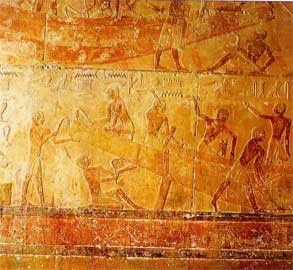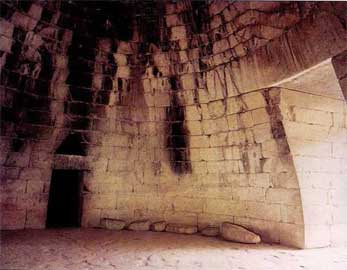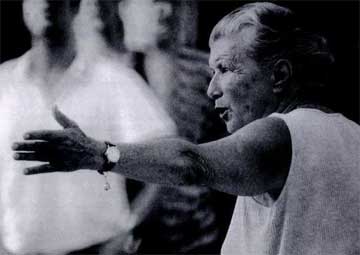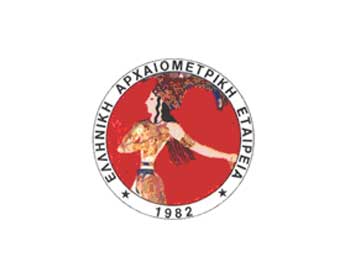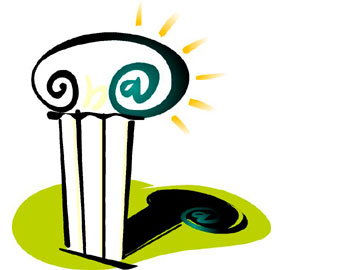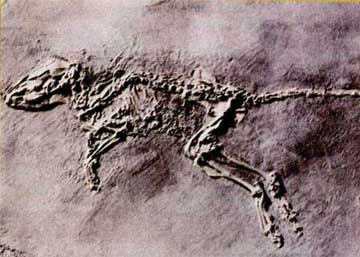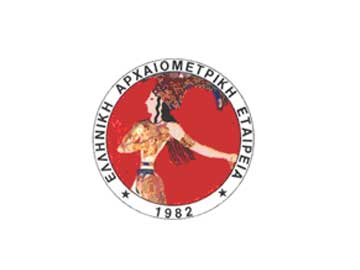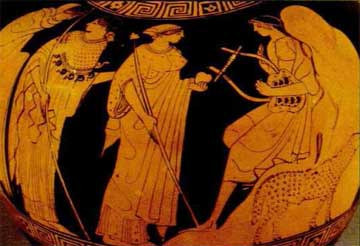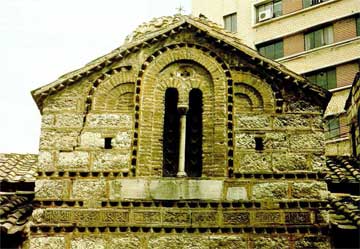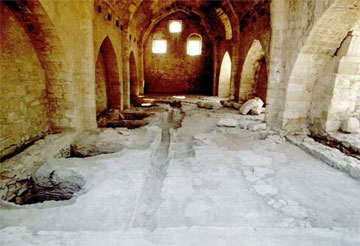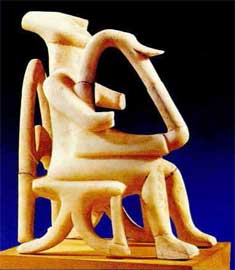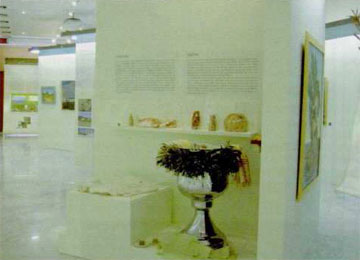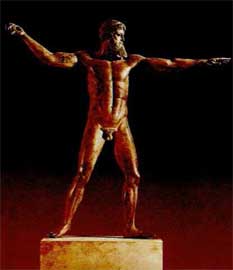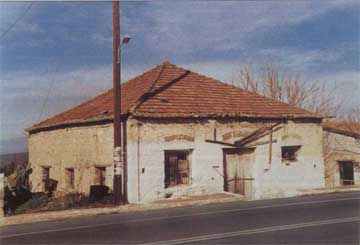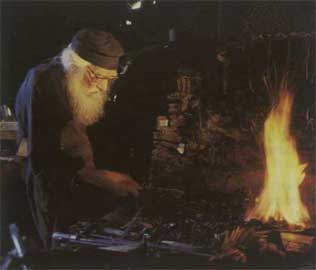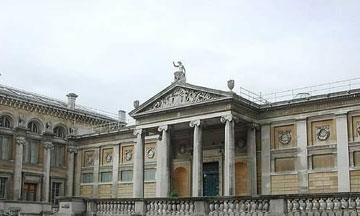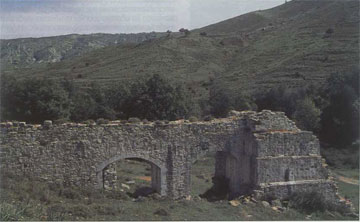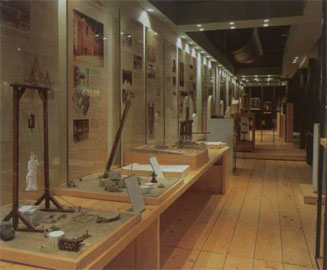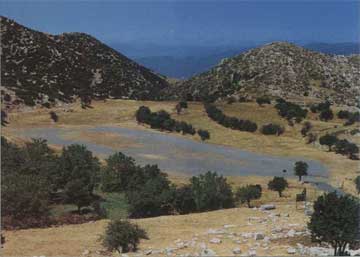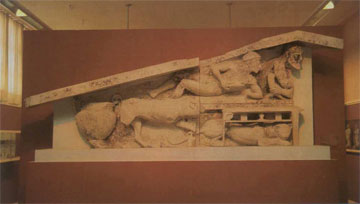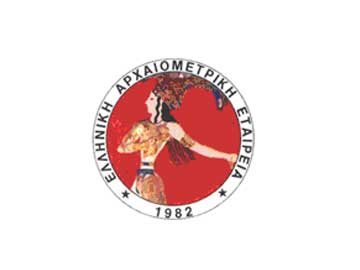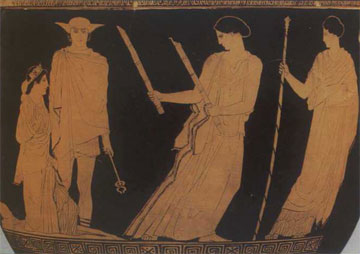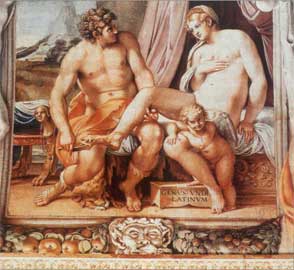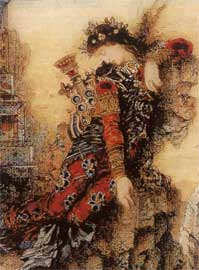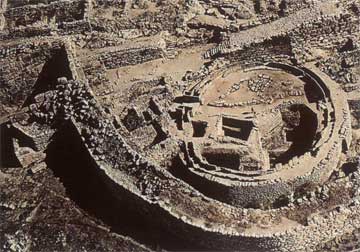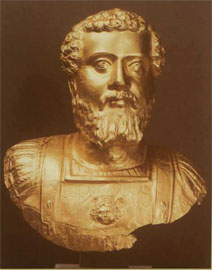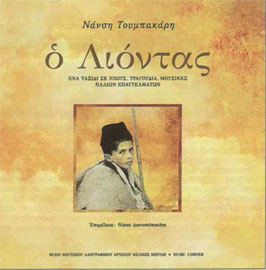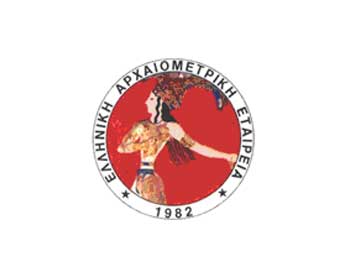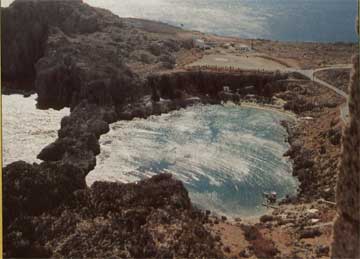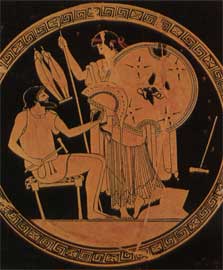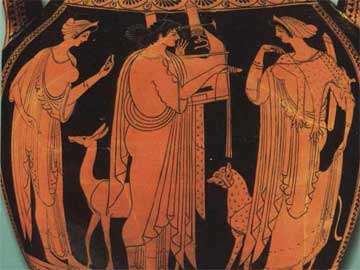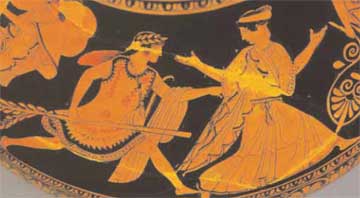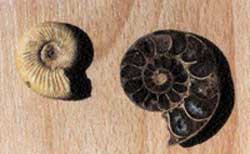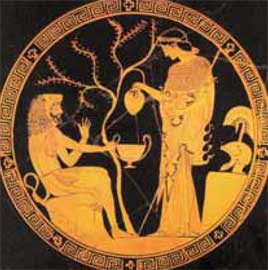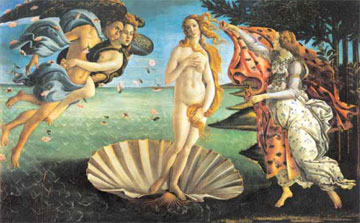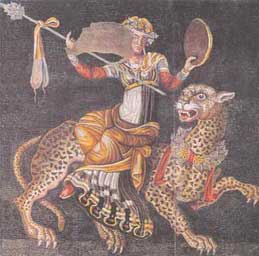~'83
~'86
~'89
~'92
~'95
~'98
~'01
~'04
~'07
~'10
~'17
~'20
~'23
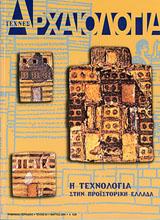
 Πλακίδια με λιοντάρι που επιτίθεται σε ταύρο, από τα Σπάτα.
Πλακίδια με λιοντάρι που επιτίθεται σε ταύρο, από τα Σπάτα.
 Κυκλώπειο τείχος παράλληλο με τα αναχώματα του μεγάλου αγωγού της Κωπαίδος.
Κυκλώπειο τείχος παράλληλο με τα αναχώματα του μεγάλου αγωγού της Κωπαίδος.
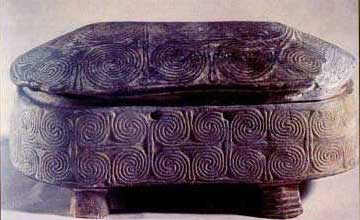 Πρωτοκυκλαδική ελλειπτική πυξίδα από χλωριτικό σχιστόλιθο, Εθνικό Αρχαιολογικό Μουσείο.
Πρωτοκυκλαδική ελλειπτική πυξίδα από χλωριτικό σχιστόλιθο, Εθνικό Αρχαιολογικό Μουσείο.
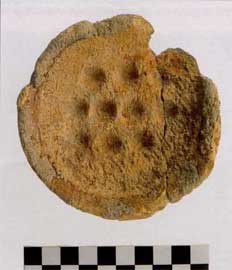 Ακέραιο αντικείμενο από λιθάργυρο.
Ακέραιο αντικείμενο από λιθάργυρο.
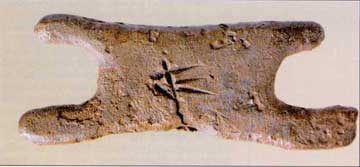 Ομοίωμα ταλάντου με επιγραφή από την Έγκωμη.
Ομοίωμα ταλάντου με επιγραφή από την Έγκωμη.
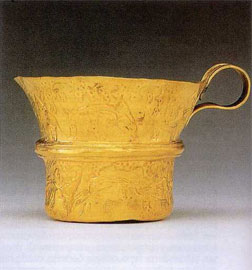 Χρυσό κύπελλο από λεπτό έλασμα με έκτυπη διακόσμηση δελφινιών. Εθνικό Αρχαιολογικό Μουσείο.
Χρυσό κύπελλο από λεπτό έλασμα με έκτυπη διακόσμηση δελφινιών. Εθνικό Αρχαιολογικό Μουσείο.
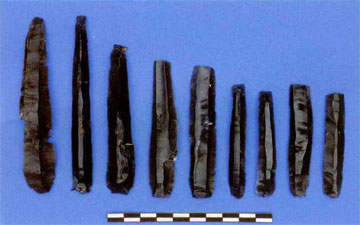 Σειρά πρισματικών λεπίδων από οψιανό της Μήλου. Ακρωτήρι Θήρας.
Σειρά πρισματικών λεπίδων από οψιανό της Μήλου. Ακρωτήρι Θήρας.
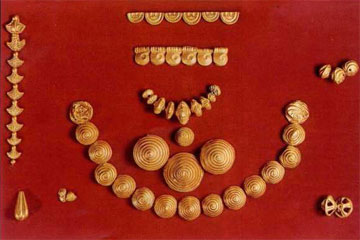 Χρυσές ψήφοι κατασκευασμένες σε μήτρα, 13ος αι. π.Χ. Από το Νέο Καδμείο της Θήβας.
Χρυσές ψήφοι κατασκευασμένες σε μήτρα, 13ος αι. π.Χ. Από το Νέο Καδμείο της Θήβας.
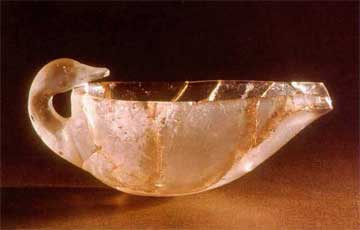 Κύμβη από ορεία κρύσταλλο, με λαβή σε σχήμα λαιμού και κεφαλής πάπιας. Αθήνα, Εθνικό Αρχαιολογικό Μουσείο.
Κύμβη από ορεία κρύσταλλο, με λαβή σε σχήμα λαιμού και κεφαλής πάπιας. Αθήνα, Εθνικό Αρχαιολογικό Μουσείο.
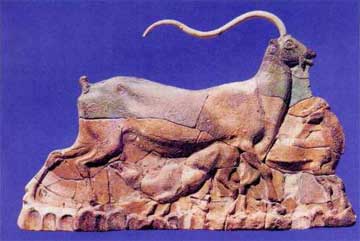 Ανάγλυφο πλακίδιο από φαγεντιανή. Ιερά Θησαυροφυλάκια του Ανακτόρου της Κνωσού, 17ος-15ος αι. π.Χ.
Ανάγλυφο πλακίδιο από φαγεντιανή. Ιερά Θησαυροφυλάκια του Ανακτόρου της Κνωσού, 17ος-15ος αι. π.Χ.
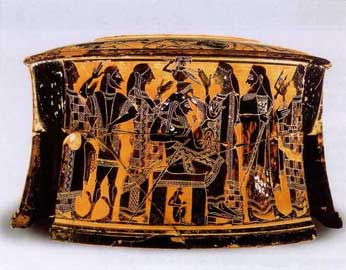 Η γέννηση της Αθηνάς. Αττικό μελανόμορφο τριποδικό εξάλειπτρο, 570-565 π.Χ. Λούβρο.
Η γέννηση της Αθηνάς. Αττικό μελανόμορφο τριποδικό εξάλειπτρο, 570-565 π.Χ. Λούβρο.
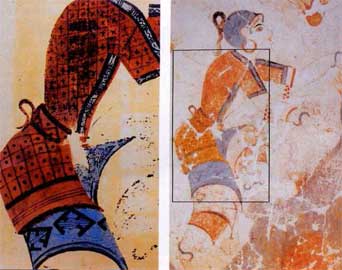 Λεπτομέρεια από την ύφανση του ενδύματος της Ιέρειας από τη Δυτική Οικία. Ακρωτήρι Θήρας.
Λεπτομέρεια από την ύφανση του ενδύματος της Ιέρειας από τη Δυτική Οικία. Ακρωτήρι Θήρας.
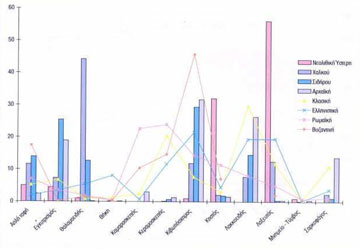 Ποσοστιαία κατανομή των διαφόρων τύπων τάφων ανά εποχή.
Ποσοστιαία κατανομή των διαφόρων τύπων τάφων ανά εποχή.
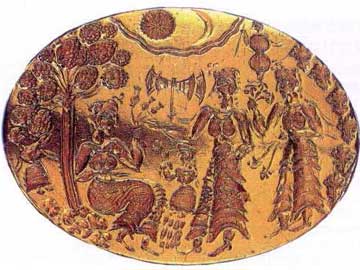 Ελλειψοειδής σφενδόνη χρυσού δαχτυλιδιού με λατρευτική παράσταση. Μυκήνες, Θησαυρός Δροσινού.
Ελλειψοειδής σφενδόνη χρυσού δαχτυλιδιού με λατρευτική παράσταση. Μυκήνες, Θησαυρός Δροσινού.
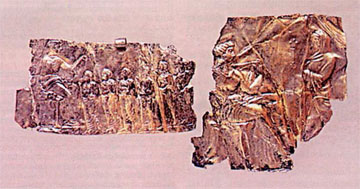 Ασημένια πλακίδια 4ου αι. π.Χ. από το ιερό της Δήμητρας στη Μεσημβρία-Ζώνη.
Ασημένια πλακίδια 4ου αι. π.Χ. από το ιερό της Δήμητρας στη Μεσημβρία-Ζώνη.
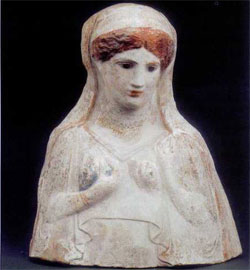 Πήλινη γυναικεία προτομή, πιθανότατα θεότητας του Κάτω Κόσμου από το κλασικό νεκροταφείο της Αμφίπολης.
Πήλινη γυναικεία προτομή, πιθανότατα θεότητας του Κάτω Κόσμου από το κλασικό νεκροταφείο της Αμφίπολης.
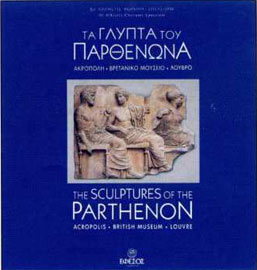 Το εξώφυλλο του βιβλίου.
Το εξώφυλλο του βιβλίου.
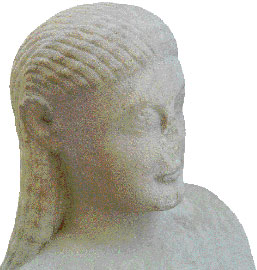 Εξαιρετικής τέχνης κεφαλή κούρου της αρχαϊκής εποχής που αποκαλύφθηκε στη νησίδα Δεσποτικό.
Εξαιρετικής τέχνης κεφαλή κούρου της αρχαϊκής εποχής που αποκαλύφθηκε στη νησίδα Δεσποτικό.
The definition of the ancient Greek word “Techne” (Art) was a skill needed in the making of some object, regardless of this object being functional (craft) or beautiful (art). In this special feature, technology is examined as a whole, without specifically focusing on technical achievements. The interest lies in the system in which a need is born, the human ingenuity to meet this need, and the repercussions on society as a whole when a certain technology prevails. Many references are made to the interaction between society, economy and technology as well as to the complex procedure of society absorbing an innovation which will, in turn, be incorporated into “tradition”.
It is beyond doubt today that the Greek tribes were distinguished, from the Mycenaean age to the Late Antiguity, for their persistent love of technology. Thus, it is reasonable to presume that such an attitude towards life would have been impressed on the mythological and religious beliefs of the Greeks. As a matter of fact, the role of technology in the mythology and religion of ancient Greece is a fundamental one: the Cyclopes/metal workers participate in the original triple deity (mans. Cyclopes, Hecatoncheires), Gaea hands to Cronus the "sharp" scythe, and the Cyclopes invent the ultimate weapon, the thunderbolt, for the sake of Zeus, which would enable him to emerge victorious in the struggle of the gods against the Titans. Even in the Olympian phase of the ancient Greek religion Zeus, by inviting Prometheus to participate in the creation of the World, has essentially consented to offering to mankind the technological Wisdom. Thus. the original fault of creation is restored and "men become affluent". So, it seems that technology for the Greeks was the blessed by the gods complement of the powers of nature.
The manner in which the basic building materials –stone, clay and wood- are combined to create the load bearing system of a building is of major significance in construction. The earlier structures (7th millennium B.C.) are built with wood, while clay as a building material has an equally long history. Timber is used in the reinforcement of clay or stone walls in the form of horizontal beams embedded In the wall. Vertical posts are also included in later times. There are indications that the participation of wood In wall construction was an antiseismic measure. The covering of a building -gabled or flat root- is not always easy to identify. The difference between the structure logic of an elongated narrow edifice of the "megaroid" type covered with a gabled roof (Thessaly, North Aegean) and that of a rectangular house with a flat roof (South Aegean, Crete) is striking and is reflected in the course of development of the two types, as for example in their potentials of horizontal and vertical expansion. It is not accidental that multi-storied houses appear very early in the South Aegean where flat roofs prevail. Roof tiles are the most undisputable evidence of gabled roofs (House of Tiles, Lerna, 3rd millennium B.C.). Their use throughout the Mycenaean era is widespread. Fortification walls represent the earliest technical works on a large scale dating back to the 5th millennium B.C. (Strophilas, Andros), with most renown the walls of the Mycenean era. The stone vaulted tombs of the same era are also monumental works of a large scale, reaching 14 m in height and diameter. The relieving triangle and corbelling are true Inventions of the time. Linear B tablets refer to the to-ko-do (masonry builder) and the to-ko-to (carpenter) implying respective expertise.
Greece is an exceptionally mountainous country. Therefore the few areas that displays the appropriate relief for intense agricultural use have played an important role in its eνolutιon and haνe become centers of cultural development. The need for a more effective exploitation of plain land demanded the technical occupation of man with various natural phenomena, in order the menace of flood and drought to be dealt with electively. The peak of the technical achievements in Iand reclamation works both of the Mycenaeans in the Peloponnese and the Minyans in Boetia is dated from the fourteenth and thirteenth centurιes B.C. They are innovating and unique in Europe works, which secured the flowing ουt οf water from inhabited and cultivated districtsΙs in ρperiods of abundant water and, correspondingly, their supply with water in periods of drought. The main characteristic οf the Mycenaean waterworks was the basin technique that consisted ίn the construction of dens or locks that had a medium height but usuaIIy a substantial width and a length expanding of many kiIometers. The most sρectacular technical works of the Mycenaean era are the big piρeIines. mainly that of Kopais, but aIso those of the Pheneos valley and Tiryns. The great advantage of the waterworks was their automation, since after their construction they only needed maintenance without any technical back up. During the second half of the second millenium B.C. the Minyans created and exploited a magnificent and extensiveνe system of waterworks ίn order to control the creation of artificial lakes in Boeotia. The biggest and longest maιn, most of the earthworks of the ρeriod and the largest artificial lake of early Greece were created in the Minyan Kopais.
Although in the Homeric Epic there are many references to ships, the question is whether they describe the Mycenaean or simply the Geometric sea-going vessels. The aim of this article is to present the evidence, the methodology and the results of an interdisciplinary research project on the form and the shipbuilding tools, materials and techniques of Mycenaean ships. Unfortunately, no Mycenaean shipwreck has been excavated so far. In consequence, in order to draw safer conclusions, we had to undertake a comparative study of the written sources on nautical technology from the Linear B tablets, the Homeric epic and the later literary evidence as well as the available LHIIIC archaeological data. The study also took in account evidence on ships and shipbuilding techniques from earlier and contemporary Bronze Age civilizations in Northeastern Mediterranean. Finally, in order the above mentioned issues to be examined in the historical context of the LHIIIC period, the research had to deepen in various fields of Mycenaean civilization, such as technology (woodworking, metallurgy), economy, and even natural environment. Some of the results as well as the questions that remained unanswered after the completion of the archaeological study on the form of the Mycenaean oared vessels were approached through Experimental Archaeology. The analysis of the design and structure of an eikosoros (20- oared sailing vessels) was the subject of a complete technical study and of experiments using not only models – in a 1:10 scale-, but also full-scale sailing and steering samples.
This article refers to metal technology and particularly to its Impact on trade in the Bronze Age. After a theoretical introduction to the evolution of metallurgy and metal, working, it concentrates on the strategic role of metals for the production of weapons and on the necessity of alloying copper with tin. The sources supplying tin are examined as well as: the explosion of sophisticated metalworking techniques during the period of the "Shaft graves phenomenon", the interest of the central authorities in obtaining metals and producing export-oriented artifacts, and the various mechanisms used in the exchange networks. Then the article focuses on the standard mainly used In the circulation of raw metals, that is the ox-hide-shaped ingots traded in mostly coastal areas of the Central and Eastern Mediterranean, which were also found in abundance in two Bronze Age shipwrecks. Finally, specific information, which has been reinforced by archaeometric investigation, is given as regards the copper and tin ingots discovered in a ship that was sank off the southern coast of Asia Minor, near the present day Uluburun. while sailing from Syrian ports and Cyprus to a Mycenaean destination.
Copper and its alloys played an important role in the economic and technological development that is apparent in the Bronze Age. In order to obtain copper and tin, the two basic components of bronze, as well as other metals, the civilizations of the Mediterranean had to develop contacts and intricate exchange systems. Many factors led the island of Cyprus to the center of the commercial networks that developed in this period. First, Cyprus, even today is considered one of the richest countries in copper in the world, and already since the end of the Middle Bronze Age (1900-1600 B.C.) Cypriot copper was exported to neighboring countries. Second, the island. due to its geographic position in the Eastern Mediterranean, functioned throughout its history as a crossroad between the West and the East and as intersection of the commercial trade routes. The importance of Cyprus as a copper producer and exporter in the Late Bronze Age has been revealed by archaeological research carried out both on the island and in the neigh boring countries, while archaeo- metallurgical research on the island has shed light on issues concerning the technology of copper production from sulphide ores.
The remnants of a small workshop and hundreds of litharge fragments have been recovered during a rescue excavation in Lambrika, Attica (Koropi). The litharge finds have the shape 0f a small shallow bowl and most of them bear at their bottom ten small hemispherical depressions arranged in three series. These litharge items derive from a metallurgy workshop of silver/lead of the Early Helladic I period (3200- 2800 B.C.), the earlier one located in the Aegean region. Three circular pits dug in the ground have been found (1.5-1 m. diameter and 0.50 m. depth), and among them five small cavities (0.19 m. diameter and 0.10 m. depth) coated with a whitish clay have been scooped. The correspondence of dimensions of the litharge finds to the cavities leads to the conclusion that the latter were purposed for the manufacturing of the former. So far, only a few litharge samples of similar form, proving the application of the cupellation method, that can be dated from the EH I period or the preceding one, are known: One from the Earlyheladic settlement at Koropi, another one from the Final Neolithic building at Merenta. A similar litharge comes from the site Habuba Kabira in Syria and belongs to the second half of the fourth millennium B.C. The systematic typological and analytical study of these litharge fragments will elucidate a series of important issues relevant to the early metallurgy of silver in the Aegean.
The technology of chipped stone is related with the strategic choices that have been made in order the raw material used for the fashioning of stone implements to be obtained and shaped. The technology of chipped stone in the Bronze Age Aegean, which is examined as regards its obtainment, production and use or consumption, is a complex phenomenon that is connected to the new technical, economic and cultural parameters formed after the third millennium B.C.. Significant changes are observed as regards the way the raw material is obtained as well as the transport and use of obsidian in the Cyclads and its distribution from there to Eastern Greece and to the broader area of its dissemination. It has been ascertained an expansion of the transport network of this volcanic glass to Northern Greece and Eastern Aegean and to the Asia Minor coastal area. Concurrently, new networks of transporting obsidian from remote sources of this material appear, such as the Carpathians and Cappadocia, The production of obsidian blades is the result of the widely spread pressure technique used in the manufacture of elongated prismatic blades. As regards consumption, the Bronze Age retouched implements are few. Blades are mainly used for basic activities in the household or for more specialized ones in the workshop. The discovery of obsidian blades in a particular context, like that of a burial, implies the use of this artifact in areas having a symbolic meaning. In conclusion, the third and second millennium B.C. marks the end of this sophisticated chipped stone technology.
Undoubtedly stone vessels represent an important and distinguished creation. Although they do not belong to the objects necessary for the everyday life, nevertheless they are important, because they directly refer to the level of development and achievements, the aesthetics, the values and belief of the society that has produced and used them. They stand out thanks to the peculiarity of the material they are made from, which results from the natural colour, durability and difficulty in workmanship of stone. Our knowledge of the way the raw material could be transformed to a vessel is limited, because the available information is meager and fragmentary. Since a fully equipped workshop of a stone carver has not been found as yet, it is the vases themselves, mainly the unfinished ones and the waste. that supply the indications of their manufacturing. Therefore. the testimonies deriving from the broader area of Near East are valuable. Thus, we can conclude in general that the entire carving procedure -carving of the exterior, scooping out of the Interior- was carried out in the workshop; and that the tools of the early stone carving were gradually replaced by more advanced ones, made of bronze in particular. The first stage included the rough forming of the volumes through hammer-hewing. The smoothing out of the surfaces followed that was achieved using blades and chisels. The tools for the hollowing of the open and shallow forms and shapes were blades, solid grinding implements and, later, chisels. The use of chisels for the processing of soft stones continued throughout the Bronze Age, while the employment of drill represented a novelty in the hollowing of vessels. Rotating. originally. between the palms and later with the help of a bow and crank, it became the indispensable tool of the stone carver, while sand and ground abrasives, such as emery and quartz, were required additionally for hard stones. When the hollowing was completed. then the final elaboration of the vase exter or followed, which included the rendering of particular details of its form, the finishing and the polishing of the artifact.
The art of weaving in the Bronze Age is characterized as developed, particularly due to the representations of luxurious textiles depicted in wall paintings. The archaeological evidence is insufficient and consists in preserved parts of looms, which however are few, given that most of them are perishable. Traces of textiles have been recently located, as for example at Akrotiri on Thera island, which are astonishing finds not only for the variety of their weaving techniques, but also for the exquisite refinement of these artifacts. It is obvious that the main achievement is the technical human abilities through which these excellent works have been produced and not the technical properties of the weaving instruments in themselves.
Alongside metals iνory (hippopotamus and/or elephant) first appears in the Aegean as a luxury import into the Prepalatial Crete. During the period of the first Palaces the range and size of products increased there and the working techniques were perfected, leading to a heyday of the craft in the phase of the Second Palaces. Thenceforth, the Mycenaeans maintained the expertise in Crete and throughout the Aegean. Their output differs somewhat in style and diversity of objects produced. Elephant and hippopotamus iνοries are different in their manner of growth and thus to a degree in how they are worked and resist time and decay. The craftsmen employed a varying toolkit (blades, points, saws, chisels and drills), mostly of copper/bronze and sometimes probably of reed/cane lor drίll-heads; they relied much on abrasiνes to cut, shape and polish their artifacts. Confirmed working areas are not common; we can guess that the social position of these craftsmen depended on those elite clients who made use of their products. The manufacture of three sets of maΙeria is reviewed in some more detaίl: the Palaikastro "kouros", the inlays from the House of lvories at Knossos and sundry pieces from Mainland Greece (1rom Athens and Mycenae).
Vitreous materials manufacture was a "high teen" technology which first started in the Near East and Egypt and later spread to the Aegean. Vitreous materials were appreciated for their resemblance to precious stones which were considered to have special properties: they were imbued with beneficial magic. With time, however, they became even more appreciated for the very magic that was involved in their manufacture: the dull, colourless raw materials were transformed in the kiln into a brilliant artefact. The manufacture of first faience and blue frit and later glass meant that precious objects could become available not only to the elite but to almost all social classes. The royal courts remained the centres of production since it was they who could afford the first class technicians and the best raw materials as well as high aesthetic standards. Faience could be made anywhere, while blue frit and glass were made in specific countries in the Near East and Egypt from whence they could be exported to other countries - thus widening Bronze Age trade/exchange networks.
The mold is undoubtedly the oldest "machine" in the history of the material civilization, which changed drastically the rhythm of production through the standardization and mass production of all sorts of artifacts. Its impact on the field of metalwork has been appreciated for the manufacturing of bronze implements and weapons in particular already since the early third millennium B.C. The role of mold is intensified and increased in the framework of the palatial societies of Minoan Crete and Mycenaean Greece, especially through the production of various gold, faience and glass paste prestige goods. In this way, through the standardization and the multiplication of "images", it also contributed to the creation and dissemination of an artistic koine during the Late Bronze Age. The culmination of the use and performance of mold coincides with the fourteenth and thirteenth centuries B.C. It becomes obvious from the production of jewellery -mainly embossed glass paste or more seldom gold foil beads- that it responds to and meets the new ornament orientations and needs of the Mycenaean world. The relevantly numerous molds and the countless jewels dating from these two centuries prove beyond doubt the predominance of a galloping fashion which, due to the use of the inexpensive glass paste, was spread throughout all social strata. Mycenae is probably the major center of jewellery production and the provenance of most of the available until today molds. The Linear B tablets from this site testify for the local activity of a group of craftsmen, the so-called kuwanowokoi, who must be conceived as artisans working glass paste, a low-priced substitute for lapis lazuli. Needless to say that the importance of a mold depended on the number of carved matrices it bore - up to 23(!) on an example from Mycenae. However, the carving of the various matrices should have been the responsibility of a skilled expert, who must be sought among the ranks of the seal engravers of the period, recorded, as we believe, on the Linear B tablets by the term kowirowoko.
Herodotus, the father of History, already stresses in the fifth century B.C. the particular historical and cultural importance of ancient Thrace, when he remarks that "the nation of the Thracians is greatest", which today has become obvious thanks to the relevant archaeological discoveries in the area. The great number of archaeological finds that Makri and Mesimvria-Zoni, two distinguished sites in this area, have yielded made possible the reconstruction of everyday life in the Prehistoric age and in the classical and Hellenistic periods in such sectors as the building of houses, the organization of space and town- planning, cult and religion, the various occupations of the inhabitants, the burial practices etc.
The glyptic of the Early Mycenaean period of mainland Greece initially follows the artistic tradition of Neopalatial Minoan Crete. Lentoid and almond-shaped seals are extensively used for sealing purposes well through the Mycenean era, while Mycenaean seals and gold signet rings -especially those found in the Shaft Graves at Mycenae - are exclusively used for their own artistic merit as jewellery and not for bureaucratic purposes. The thorough examination of the iconography used on this artistic production has led to the conclusion that a distinct, purely "mainland" glyptic style was gradually been developed around the Late Helladic period, which exhibits the following characteristics: a. The overall treatment of human figure and its position both in space and in intaglio representations show the stylistic weakness and the technical inconsistency of the Mycenaean engravers. b. The development of a genuine "Mycenaean" epic tradition and religious ideology that are reflected in scenes depicting battles, duels and religious rites. c. The use of motifs that symbolize the Mycenaean idea of the celebration of death by means of war and hunting scenes in which the military and hunting equipment is stressed. d. The appearance of a female, military in character, deity who adorns a number of seals, signet rings and fresco fragments as well. e. The number of collections and accumulations of Late Helladic -and Mlnoan- seals from excavated graves (Mycenae, Vapheio) and cemeteries (Medeon) proves that the Mycenaean elite regarded many glyptic items as valuable objects, "heirlooms" so to speak, and exceptional artistic creations.
This article presents a preliminary analysis of a sample of 40.393 ancient Greek graves that are correlated to the data of geographic distribution, palaeodemography and burial customs from the Mesolithic epoch up to the Byzantine era. The sample can be considered statistically large for most of the scientific topics presented here and thus it results to a satisfactory approach to the general picture. The interrelation between the different chronological periods and the various burial traditions, such as the grave types, the degree of kterisis and the grave orientation, cannot be accidental. The various interpretations given to related issues are open to further debate, considering also that a more extensive analysis is required in order to be clarified specific and general conjectures, in relation to their chronological settings.
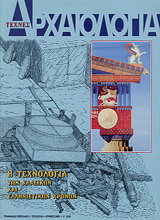
 Το εκκλησάκι του Αϊ-Γιάννη στο χωριό Αγιάδες. Στο βάθος, το βουνό με την ακρόπολη, μέσα από το οποίο σκάφτηκε το όρυγμα.
Το εκκλησάκι του Αϊ-Γιάννη στο χωριό Αγιάδες. Στο βάθος, το βουνό με την ακρόπολη, μέσα από το οποίο σκάφτηκε το όρυγμα.
 Μηχανισμός των Αντικυθήρων, τεμάχιο Α, πρόσθια όψη.
Μηχανισμός των Αντικυθήρων, τεμάχιο Α, πρόσθια όψη.
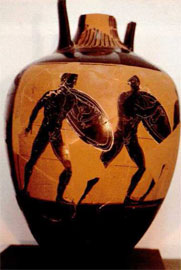 Παναθηναϊκός αμφορέας του 344/3 π.Χ. με παράσταση άφεσης οπλιτοδρομίας και απεικόνιση της ύσπληγος.
Παναθηναϊκός αμφορέας του 344/3 π.Χ. με παράσταση άφεσης οπλιτοδρομίας και απεικόνιση της ύσπληγος.
 Σπασμένη ενεπίγραφη στήλη, που περιέχει έναν πολύ αυστηρό νόμο για το ξύδι και το κρασί, 480 π.Χ. Μουσείο Θάσου.
Σπασμένη ενεπίγραφη στήλη, που περιέχει έναν πολύ αυστηρό νόμο για το ξύδι και το κρασί, 480 π.Χ. Μουσείο Θάσου.
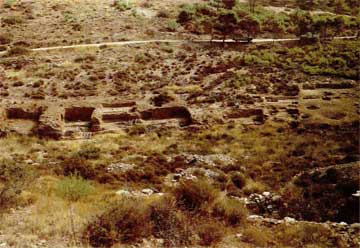 Παρακείμενα πλυντήρια μεταλλεύματος λαξευμένα στον βράχο της ανατολικής όχθης της κοιλάδας Μπερτσέκου.
Παρακείμενα πλυντήρια μεταλλεύματος λαξευμένα στον βράχο της ανατολικής όχθης της κοιλάδας Μπερτσέκου.
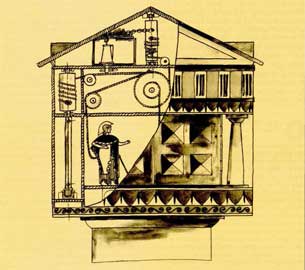 Εσωτερική διάταξη των μηχανισμών του σταθερού αυτομάτου του Ήρωνος.
Εσωτερική διάταξη των μηχανισμών του σταθερού αυτομάτου του Ήρωνος.
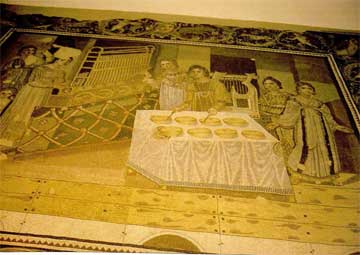 Μωσαϊκό από το Μιριαμίν της Συρίας (4ος αι. μ.Χ.). Απεικονίζει ορχήστρα γυναικών και πνευματικό όργανο.
Μωσαϊκό από το Μιριαμίν της Συρίας (4ος αι. μ.Χ.). Απεικονίζει ορχήστρα γυναικών και πνευματικό όργανο.
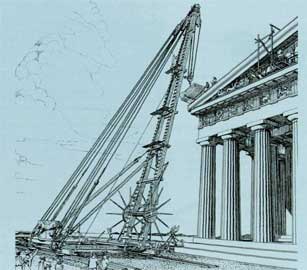 Παρθενών, αναπαράσταση της τοποθέτησης του βάθρου του ακρωτηρίου της ΝΑ γωνίας του κτηρίου με γερανό.
Παρθενών, αναπαράσταση της τοποθέτησης του βάθρου του ακρωτηρίου της ΝΑ γωνίας του κτηρίου με γερανό.
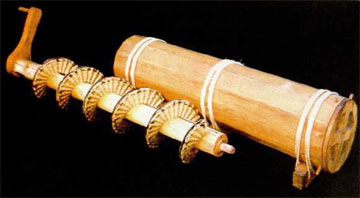 Ομοίωμα του κοχλία του Αρχιμήδους. Κέντρο Διάδοσης Επιστημών και Μουσείο Τεχνολογίας.
Ομοίωμα του κοχλία του Αρχιμήδους. Κέντρο Διάδοσης Επιστημών και Μουσείο Τεχνολογίας.
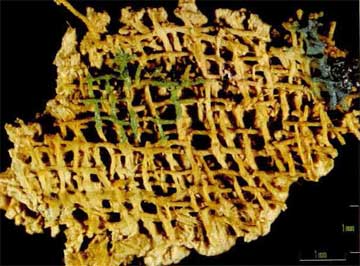 Μικροφωτογραφία από στεροσκόπιο τμήματος των υφασμάτων από το Μοσχάτο.
Μικροφωτογραφία από στεροσκόπιο τμήματος των υφασμάτων από το Μοσχάτο.
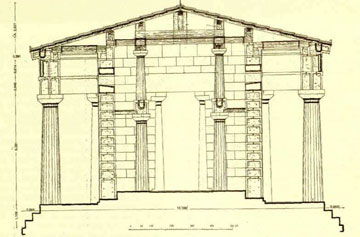 Τομή κατά το πλάτος του ναού της Αφαίας στην Αίγινα. Περί το 500 π.Χ.
Τομή κατά το πλάτος του ναού της Αφαίας στην Αίγινα. Περί το 500 π.Χ.
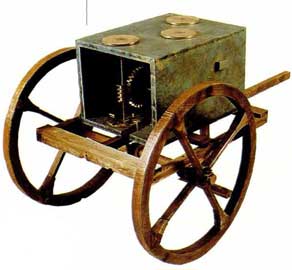 Ομοίωμα ΕΜΑΕΤ του οδομέτρου του Ήρωνος του Αλεξανδρέως (γύρω στον 1ο αι. π.Χ.).
Ομοίωμα ΕΜΑΕΤ του οδομέτρου του Ήρωνος του Αλεξανδρέως (γύρω στον 1ο αι. π.Χ.).
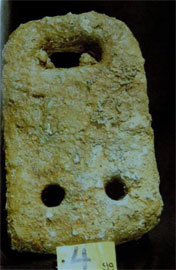 Χαρακτηριστική άγκυρα που βρέθηκε στην Αλεξάνδρεια, με την άνω οπή σε σχήμα ταχυδρομικής θυρίδας.
Χαρακτηριστική άγκυρα που βρέθηκε στην Αλεξάνδρεια, με την άνω οπή σε σχήμα ταχυδρομικής θυρίδας.
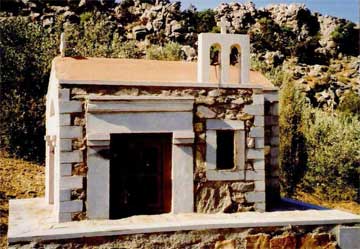 Αξιοσημείωτη είναι η μικρογλυπτική απόδοση στα ναόσχημα προσκυνητάρια δομικών, μορφολογικών στοιχείων της ναοδομικής παράδοσης.
Αξιοσημείωτη είναι η μικρογλυπτική απόδοση στα ναόσχημα προσκυνητάρια δομικών, μορφολογικών στοιχείων της ναοδομικής παράδοσης.
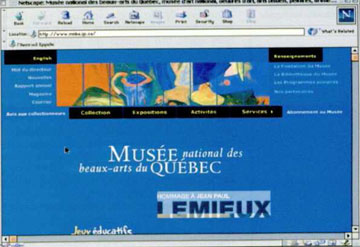 Αρχική σελίδα του Μουσείου του Κεμπέκ.
Αρχική σελίδα του Μουσείου του Κεμπέκ.
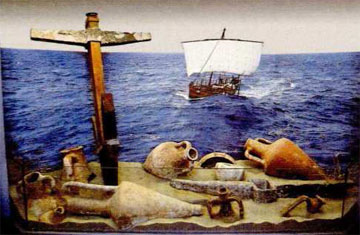 Προθήκη με αμφορείς και άγκυρες από τις ελληνικές αποικίες της Βόρειας Μαύρης Θάλασσας.
Προθήκη με αμφορείς και άγκυρες από τις ελληνικές αποικίες της Βόρειας Μαύρης Θάλασσας.
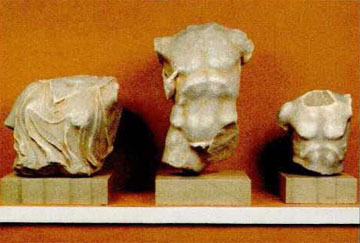 Τρεις κορμοί από αέτωμα ναού του τέλους του 5ου αι. π.Χ. από την περιοχή του Βελβιτσιάνικου ποταμού.
Τρεις κορμοί από αέτωμα ναού του τέλους του 5ου αι. π.Χ. από την περιοχή του Βελβιτσιάνικου ποταμού.
 Journal of Mediterranean Archaeology, λογότυπο
Journal of Mediterranean Archaeology, λογότυπο
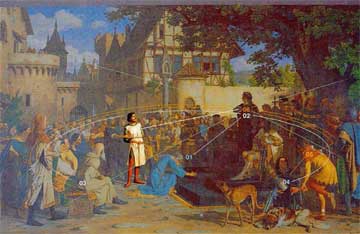 Οθόνη από τη διαδραστική ανάλυση του πίνακα "Η Gertrud von Wart εκλιπαρεί να δοθεί χάρη στο σύζυγό της".
Οθόνη από τη διαδραστική ανάλυση του πίνακα "Η Gertrud von Wart εκλιπαρεί να δοθεί χάρη στο σύζυγό της".
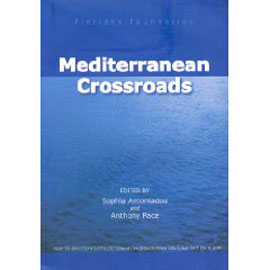 Το εξώφυλλο των πρακτικών του συνεδρίου.
Το εξώφυλλο των πρακτικών του συνεδρίου.
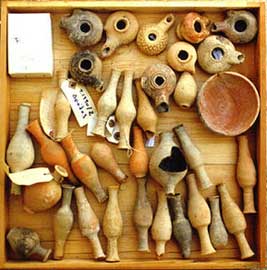 Άθικτα μυροδοχεία τα οποία συγκεντρώθηκαν από την ανασκαφή στον Πύργο της Κύπρου.
Άθικτα μυροδοχεία τα οποία συγκεντρώθηκαν από την ανασκαφή στον Πύργο της Κύπρου.
The upheavals that accompanied the “Dark Ages” had a strong effect on technology, which soon, however, reached its peak. The development of emancipated cities, colonialism and its interaction with cultures of the new colonies all acted as a boost to quick development. Rational thought, the correlation between cause and outcome joined the paths of science and technology. Inventors and creators take on an identity. The historical era is known for the shift of interest from Experience to Theory and from the concept of “Almost” to that of “Exactly”. The technology which stands out is that of the famous mechanism of Antekythera of the 1st century BC.
Empiral Technology has always existed in Greece as in many order countries. It seems, however, that from the time Science is born in the land of Ionia, the insemination and development of ancient Greek Technology is faster and wider. Needless to say that such a fertilisation of Technology by Science was bound to happen one way or another. The particular evidences which verify this happy hymenaeus of Technology and Science in ancient Greece are pin-pointed in this article: they range from the years of Thales and Eupalinus (surveys for the materialization of important technical works) to the Alexandrian culmination of Greek Technology (the mathematic helix as base for Archimedes’ helical pump, the sound numeration by the Pythagoreans that facilitated the manufacturing of musical instruments, etc). As a matter of fact it also occurred a cross-insemination’’: Technology payed back its debt to Science, as a gift in return, by building measuring scientific instruments-protractor, chorobates (levelling device), hodometer, astrolabe, hydraulic clock, astronomical simulator of Antikythera and others-which have contributed to the progress of Greek Science of that age.
The structural elements of ancient Greek temples have been systematically presented in a restricted number of monographs which appear at the end of this article. Initially, the technology applied for the construction of temples was similar to the one applied for the construction of houses. In time, the original mud brick or rubble stone masonry of the cella and the wooden elements of the colonnades were translated into more abstract forms, especially when they were rendered with mortar or were sheathed in terracotta. These forms became even more abstract when they were translated into hard limestone or marble, acquiring, in the end, high plastic values. The post and lintel principle has always been essential for the Greek masons who never used vaults and trusses for ceilings or roofs. Another important characteristic of the monumental temples in the classical era is their being built with blocks carved on all their sides in a way that secured perfectly tight joints and smooth surfaces for the architectural parts of the building. The bonding of the blocks was entrusted primarily to friction, and secondarily to iron clamps and dowels embedded in lead. Mathematics were very much involved in designing Greek temples. The construction of models of buildings were not uncommon, and it is certain that models or drawings of particular architectural forms were indispensable. The first step for the construction was finding the stone in the quarries, extracting it, trimming it roughly and transporting it to the building site. When a block was put up at its final place in the building, only its lower face and the surfaces abutting the neighbouring blocks in the same course were finished. The upper surface was finished later, when the whole horizontal course of blocks was set, while the exposed surfaces retained some elements which protected them against damages during construction; these elements were removed in the end of the building was done in the end activity in the site. As regards the columns, the fluting was done in the end, following the guides carved at the bottom of the lowest column drum and at the bottom of the column capital, before they were put in place. The Greeks built preferably their foundations straight on the natural rock, which they dressed horizontally, usually forming steps according to the natural shape of the rock. If this was not possible, they founded on encased earth, sand or rubble stone. As far as it concerns the roofs of Greek temples, they were made of wood. They consisted of vertical posts standing on tops of walls or on horizontal beams (wooden or marble ones) bearing ridge beams and slopping rafters which, in their turn, supported the terracotta or marble roof tiles. The shape of the roof tiles was always adapted to the needs of the roof of each individual building.
The main and independent ways for surmounting weights have always been transporting and hoisting, while the characteristics of the weights to be surmounted, the nature of means and the relation between the original and the final position of the transported or hoisted weights have been critical factors for the achievement of this task. While the ancient and present norms of bodily labor do not differ (force 18-25 kilos per person), rope and discipline were accordingly the most important mean and the most essential human virtue for this accomplishment. The first great achievements in this field, the megalithic monuments of Western Europe, belong to the category of weight transporting along with the unrivalled works of the Egyptians who managed to transport monoliths weighing even 1000 tons! The hoisting of building members by ropes and pulleys, a technology probably inspired by ship hoisting devices, is introduced much later than transporting and becomes particularly popular in ancient Greece. Although the weights surmounted by hoisting can be amazing (up to 50 T), still they do not approach the extreme Egyptian weight magnitudes. In spite of the fact that the technology of hoisting is faster, less expensive and more flexible than that of transporting, it does not manage to replace it fully. In many Greek, Roman or modern works, the age-old Egyptian technology of transporting, using various systems of traction and slide, has remained in use being less expensive or, when the magnitudes are extreme, the only feasible. Examined in particular are the Stonehenge, the “Treasure of Atreus”, the “Treasure of Minyas”, the pulley blocks and winches, the scaffoldings and cranes as well as the petasos of the Colosseum, while reference is made to a great number of Greek monuments of the Archaic, Classical and Hellenistic period and also to some excellent Roman achievements (temples at Baalbek, monolithic dome of Theodoric’s Mausoleum).
Eupalinus’ aqueduct in Samos island is one of the greatest technical works of antiquity. Since its surface remnants disappeared when it ceased functioning, Herodotus’ reference to it offered scholars the incentive to look for and discover the tunnel in the nineteenth century. In 1881 attempts were made for the refunctioning of the main and for the research and documentation of the relevant installations. Eupalinus’ tunnel and especially its construction under a mountain soon became renowned and raised at the same time a number of questions and issues as regards its construction and building.
Among the various ores of the Lavreotiki subsoil more important are galenite (PbS) and cerussite (PB.C.O3), because they contain argentiferous lead. Occasionally these ores, which are usually composite and include non-argentiferous elements, from pure deposits that, however, are rare and limited. The mineral wealth of the region mainly consists of composite deposits. The exploitation of the argentiferous deposits in Lavreotiki seems to have commenced during the Protohelledic II period, that is around 2,500 B.C.. Until the end of the sixth century B.C. the miners used to extract only the purely argentiferous deposits and those rich in argentiferous lead, while all the rest deposits were not mined, due to the technical problems in their smelting. Around the late sixth or the early fifth century B.C., the metallurgists of Lavreotiki discovered-or learned from others- that the composite argentiferous ores could be turned to recoverable ones, if they were granulated, then mill grinded and finally washed with running water, so that all their non-argentiferous components to be removed. This method was indeed very effective, however it stumbed at the fact that Lavreotiki was a dry land. Thus, to handle the shortage of water, the metallurgists invented the ore washing-table: a device in which the water would drift away the lightweight non-argentiferous granules of the grinded ore and would leave clean the heavier argentiferous lead particles. Then, through a circulation system of canals and basins, the water would be self-cleaned, due to the subsidence, from all the components it had drifted along during its course and would return to its starting point pure and appropriate for use for the next cleansing route. The adoption of the washing-table solved the problem of water shortage and in fact multiplied the exploitable mineral wealth of Lavreotiki. Soon after it led to the maximization of the mining works and as a result to the provision of the Athenian State with an important and steady income from the exploitation of the Lavreotic silver. This considerable financial support contributed to the establishment of the newly born Democracy and the repellence of the Persians and fertilized as well the earth of Athens for its great political and intellectual flourishing, fruit of which was the so-called Golden Age of Greek civilization.
A large number of small, stone anchors were discovered at the Alexandrian coast during the underwater archaeological research carried out by the Hellenic Institute of Ancient and Medieval Alexandrian Studies. The upper hole in most of these anchors has a letterbox shaped perforation that shows the intense wear caused by rope friction. The wear is located at the two extremities of the hole and not at its centre as is usually the case with stone anchors. Judging from the location where they were found it is assumed that these anchors belonged to small fishing vessels. This assumption, coupled with their light weight, leads us to the conclusion that for practical reasons these anchors must have been cast in a row, successively, the one next to the other.
The Automata hold a special position in the history of Technology and particularly in the history of Technology of ancient Greece. The mythic anthropocentric conception that envisages engines-works of gods- with human shape and motion is gradually realized and becomes an applied, instructive science, which comprises all the branches of Mechanics in the Hellenistic age. The main representatives of this new science, the Automatopoetiki (art, science and technology of making Automata), are the Alexandrian engineers Ctesibius, Philon of Byzantium and Heron of Alexandria. Heads of the famous Bibliotheca of Alexandria and teachers at the Museum of the same city, they have collected the most important examples from the history of Automata, connected Mathematics with Mechanics, studied the problems of automotion and programming and programming and disseminated the art of Automata making. They have manufactured not only self-regulated lamps and automatic slot-machines, but also automatic fountains and theatres “in order to facilitate the human’s life and to cause surprise and admiration” to quote Heron.
The Antikythera Mechanism, that dates from the first century B.C., is the only elaborate mechanical instrument to survive from antiquity. Unique and fragmentary as it is, it has, however, provided us with incontrovertible evidence that such devices existed in Hellenistic times. It became widely known through the work of Professor D.J. de S. Price, whose definitive paper was published in 1974. Several later scholars have presented variants of Price’s reconstruction; none of them, however, based his work on new research, and more has addressed the central problem, that Price’s observations are flawed and that many of his deductions may be challenged. The author has made anew, detailed investigation of the original fragments, which has led him to propose a radically different reconstruction of the Mechanism. According to this, the principal display was probably a planetarium, a type of instrument which, as literary evidence shows, was well known at that time. The author has made a working model of his reconstruction, to demonstrate that it is practicable. It has become clear that the original instrument is even less complete than earlier scholars have supposed, and so it is to be expected that problems will remain. Nevertheless, the author is continuing to analyze his data, with the intention of presenting as full an understanding of this instrument as possible.
Hydraulis or Hydraulic organ is the first musical keys-bearing instrument in the world history and the predecessor of the later ecclesiastic organ. It consists of one or more sets of metallic pipes of various sizes. They are supplied with air of high and steady pressure through a hydraulic mechanism and they sound by means of special lever-keys. Hydraulis is a simple as well as a genius construction, which proves the high level of technological thought in antiquity. The inventor of hydraulis is the renowned engineer Ctesibius, an inhabitant of the third-century B.C. Alexandria. After its invention hydarulis is quickly disseminated in the Hellenistic world and later in the Roman Empire and becomes the favorite musical instrument of emperors, such as Nero. Blow devices replace progressively the hydraulic mechanism and thus the hydraulic instrument is transformed into a wine one. Hydraulis disappears from the west part of the old Roman Empire after the barbaric raids in Europe during the first Christian centuries, but is continues to survive in Byzantium as a wind musical instrument. The well-known ecclesiastical organ of the West is the evolution of the wind instrument, which was presented in 757 by the Byzantine Emperor Constantine the Copronymous to Pepine the Short, king of France and father of Charlemagne. In August 1992 the archaeologist and Professor at the University of Thessaloniki D. Pantermalis and his team discovered the upper part of a first century B.C. hydraulis during the excavations at ancient Dion. In the beginning of 1995 the European Cultural Center of Delphi, at which the author of this article presided, started a research project for the reconstruction of the Dion hydraulis with the support of the Greek Ministry of Culture and the scientific contribution of Professor Pantermalis. Head of the entire project was appointed the late Professor Marios Mavroidis and after his death the musicologist C. Stroux. Important participants in the project were P. Vlaggopoulos and G, Paraschos, the latter as builder of the reconstruction. The project was completed in June 1999 and the final result was an exact, as possible, replica of the ancient hydraulis of Dion. The reconstruction problems had to do with the hydraulic mechanism, the keys mechanism and the pipes. The solution of the fisrt two was based on the author’s interpretation of the text of Heron of Alexandria, which enabled the building of a plastically rendered model that served for the measuring of water and air pressure. Then two more models were built: the materials of the Dion hydraulis were used for the first one as well as the size, number and length of pipes of the find, while all the relevant ancient techniques were employed for making the second and final reconstruction of the ancient hydraulis.
The ancient Greek engineers had invented a special device, called hysplex (ύσπληξ), which was placed at the starting line of any race in order to prevent the untimely start of the competing athletes. The study of this device is based on its unique representation on a Panathenaic amphora of 344/343 B.C., the architectural remains of three stadia located in the Northeastern Peloponnese (Isthmia, Epidaurus, Nemea) and on the race track of the Corinthian Agora as well as on the reference to an hysplex in two Hellenistic inscriptions from Delos. This evidence coupled with the assumption that the function mechanism of such a device might have been influenced by the advanced technology of the late-Classical catapults led to the reconstruction of hysplex. The hysplex consisted of two horizontal ropes stretched in front of the waist and knees of the runners. The ends of each rope was tied up at the top of vertical wooden posts which were firmed by mechanisms laid at both ends of the starting line and controlled by the starter of the race. At the appropriate moment he would let all the ropes to fall down, thus permitting all the athletes to start the race simultaneously. The reconstruction of a full-size hysplex model was made possible thanks to the financial support of the University of California (Berkeley). The function of this 2,300 years old device is successfully tested every four years at its original site, the ancient stadium of Nemea, during the modern conduct of the ancient Nemean Games.
The study of archaeological textiles in Greece is still at its early stage because, due to the climate of the country, the finds preserved so far have usually small dimensions and have been mineralized. Nevertheless, their study proves that the inhabitants of this country had reached a high degree of technical knowledge since very early, an important precondition that enabled them to exercise control on all the stages of textile producing. Thus, in yarn making, purple dyeing, textile embellishing and/or embroidering the Greeks of antiquity can boast magnificent products.
The article is based on the study of ancient inscriptions, ancient Greek literature and the author’s case study in the field of ancient technology. The interesting conclusion of this research effort is that the ancient societies, even in the prehistoric age, had set standards with very strict specifications as regards the quality of a considerable range of goods either produced or for sale in the market: from metals and their alloys to foods and crops. There also existed a very small organized public quality control not only of products but also of construction works, of the public sector in particular. The various standards and mechanisms for the quality control of products as well as the sanctions imposed on whomever had violated the rules and standards formed an articulated state mechanism, capable of protection the consumer and safe guarding his interests.
New Museology tries to attract the interest of a broader public in museums. The dissemination of technology and computer science has changed considerably the way of thinking and working in museums. The high quality of digital photography has introduced virtual reality in the museum activities and the use of CD-ROMs or Web sites have become an everyday practice in them. As a result, the automatism and speed in research contribute considerably to the communication with and the information of a broader public. The conditions concerning the way of thinking and working of archaeologists-museologists change rapidly, therefore they must adjust themselves to the new reality in order to provide the necessary museum education framework for non-specialists.
The iconostases-shrines standing along provincial roads and highways and outside churches and houses represent a collective cultural expression of the veneration of the dead or are related to the customary rites for the protection of a settlement. This article focuses on the form and type of their miniature architectonical composition. The in situ survey in Attica, Crete, Epirus and in the Aegean islands identified a series of types (single-space ciborium, church-shaped shrine, stele-chapel, dedicatory, funerary post), which reveal “the directly and suB.C.onsciously materialized form of the culture, needs, values and wishes of a people”. For each type does not simply express the compositional ability of the traditional architecture to form artificial symbols, but also the transition to a distinct system of symbolic values. However, their modern counterparts have unfortunately been downgraded to ugly prefabricated structures.
Four years ago the A.G. Leventis Foundation sponsored the reexhibition of Greek and Cypriot antiquities in the Archaeological Museum of Odessa, following the proposal of Vasos Karaghiorgis, Professor Emeritus of Cypriot Archaeology and Director of the Foundation. This reexhibition in the Odessa Museum is particularly interesting not only for the sake of the exhibits in themselves, but also for the close connection of the history of Odessa and its museum with the history of Hellenism. The planning and realization of the project was entrusted to the author of this article, who presents here the necessary work carried out in the museum for the reexhibition.
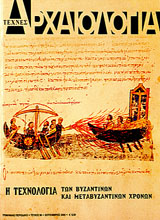
 Το Βυζαντινό Ηλιακό Ρολόι/Ημερολόγιο, Μουσείο Επιστημών, Λονδίνο, αρ. ευρ. 1983-1393.
Το Βυζαντινό Ηλιακό Ρολόι/Ημερολόγιο, Μουσείο Επιστημών, Λονδίνο, αρ. ευρ. 1983-1393.
 Εξάμιτο πορφυρό μεταξωτό (περίπου 1000 μ.Χ.) των αυτοκρατορικών εργαστηρίων, κοσμημένο με ελέφαντες.
Εξάμιτο πορφυρό μεταξωτό (περίπου 1000 μ.Χ.) των αυτοκρατορικών εργαστηρίων, κοσμημένο με ελέφαντες.
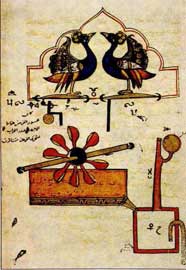 Λεπτομέρεια του 6ου υδραυλικού-μηχανικού ωρολογίου του αλ-Τζάζαρι.
Λεπτομέρεια του 6ου υδραυλικού-μηχανικού ωρολογίου του αλ-Τζάζαρι.
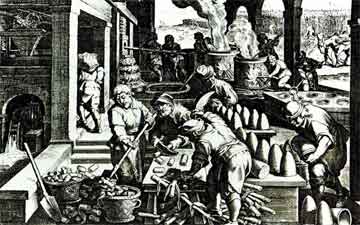 Η διαδικασία επεξεργασίας της ζάχαρης. Χαλκογραφία του 17ου αι.
Η διαδικασία επεξεργασίας της ζάχαρης. Χαλκογραφία του 17ου αι.
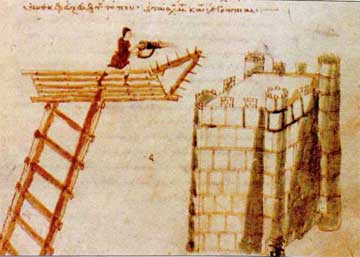 Χρήση του υγρού πυρός σε επίθεση κατά κάστρου. Βατικανός ελληνικός κώδικας 1605, του 11ου αι.
Χρήση του υγρού πυρός σε επίθεση κατά κάστρου. Βατικανός ελληνικός κώδικας 1605, του 11ου αι.
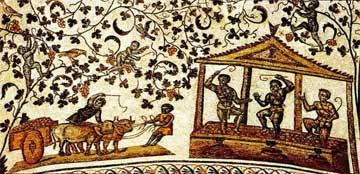 Παράσταση τρύγου των αρχών του 4ου αι. Ρώμη, Αγία Κωνσταντία.
Παράσταση τρύγου των αρχών του 4ου αι. Ρώμη, Αγία Κωνσταντία.
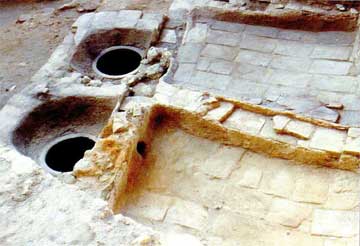 Βεριά, Ν. Σιλάτων Χαλκιδικής. Ζεύγος παλαιοχριστιανικών ληνών, αρχικώς για παραγωγή οίνου και ακολούθως αποκλειστικά ελαίου.
Βεριά, Ν. Σιλάτων Χαλκιδικής. Ζεύγος παλαιοχριστιανικών ληνών, αρχικώς για παραγωγή οίνου και ακολούθως αποκλειστικά ελαίου.
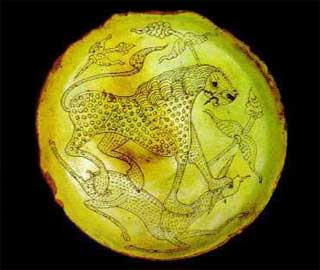 Πινάκιο με λεπτεγχάρακτη διακόσμηση: απεικόνιση θηριομαχίας, β' μισό 12ου αι.
Πινάκιο με λεπτεγχάρακτη διακόσμηση: απεικόνιση θηριομαχίας, β' μισό 12ου αι.
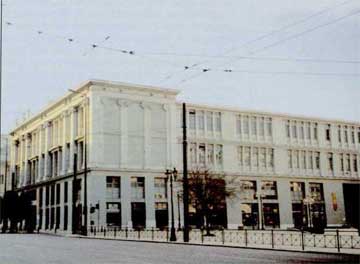 Τα Νέα Κτήρια, στη συμβολή των οδών Πανεπιστημίου και Αρσάκη.
Τα Νέα Κτήρια, στη συμβολή των οδών Πανεπιστημίου και Αρσάκη.
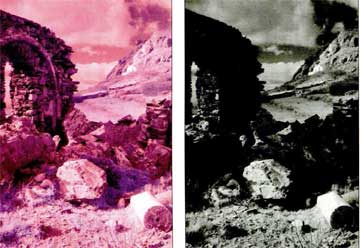 Τήνος. Αριστερά: φωτογραφία με φίλτρο 89Β. Δεξιά: η ίδια φωτογραφία ύστερα από αφαίρεση του κόκκινου χρώματος.
Τήνος. Αριστερά: φωτογραφία με φίλτρο 89Β. Δεξιά: η ίδια φωτογραφία ύστερα από αφαίρεση του κόκκινου χρώματος.
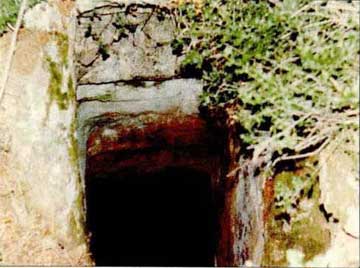 Είσοδος αρχαίας στοάς της Σκαπτής Ύλης. Διακρίνεται η τεχνική λάξευσης.
Είσοδος αρχαίας στοάς της Σκαπτής Ύλης. Διακρίνεται η τεχνική λάξευσης.
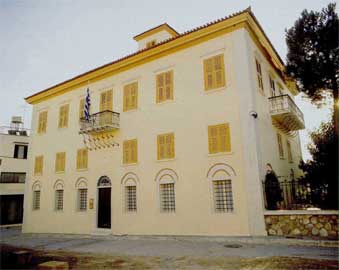 Πρόσοψη του Μπενάκειου Αρχαιολογικού Μουσείου Καλαμάτας.
Πρόσοψη του Μπενάκειου Αρχαιολογικού Μουσείου Καλαμάτας.
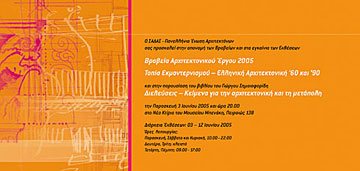 Η αφίσα της εκδήλωσης.
Η αφίσα της εκδήλωσης.
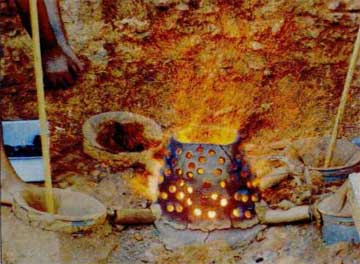 Η φρεατώδης μεταλλουργική κάμινος σε πλήρη λειτουργία κατά τη διάρκεια πειραματικής προσομοίωσης της παραγωγής πρώιμου χαλκού.
Η φρεατώδης μεταλλουργική κάμινος σε πλήρη λειτουργία κατά τη διάρκεια πειραματικής προσομοίωσης της παραγωγής πρώιμου χαλκού.
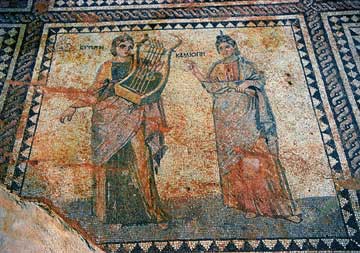 Ένα από τα περίφημα ψηφιδωτά της έπαυλης του Ηρώδη στη Λουκού Κυνουρίας.
Ένα από τα περίφημα ψηφιδωτά της έπαυλης του Ηρώδη στη Λουκού Κυνουρίας.
 Οθόνες από τον φορητό οδηγό ξενάγησης στις μόνιμες συλλογές της Tate με χρήση πολυμέσων.
Οθόνες από τον φορητό οδηγό ξενάγησης στις μόνιμες συλλογές της Tate με χρήση πολυμέσων.
The Church being singled out as a regulator of Public Life, gives a symbolic character to the architecture of the monumental Western Churches. Features of the period are castles that protect the cities, as are the famous Byzantine siege machines incorporating “Liquid Fire”. Pottery glazing (7th century), refined sugar and tsipouro (spirits) are introduced into daily life. The horizontal loom replaces the upright one. In the field of engineering, a Byzantine clock/calendar points at a continuity from antiquity, secured by the Arabs. Lastly, miraculous machines become part of applied technology. These are made to provoke the wonder of the Emperor’s guests.
Byzantine building technology is strongly differentiated in territorial and time groups as regards the materials used and the ways of construction. The numerous but unequally distributed surviving monuments, mainly churches and fortifications are in themselves the most important relevant source of information. The literary references to skariphos (preparatory drawing), the representations of building models and the varying information that the buildings themselves yield give evidence of the probable existence of architectural plans after which the monumental edifices were erected. As regards in Byzantium, there is, as it seems, a strong differentiation of status between the early and the late years of the empire. In the rare cases that architects are mentioned in connection with their work, they rather appear to be in change of traveling groups of masons and are occasionally monks. The earlier scholars have distinguished two traditions in buildings walls and vaults in the Early Byzantine architecture: the first one uses rubble or dressed stones combined with bricks, the second tradition is confined to dressed stones, according to the ancient Greco-Roman mode. The later Byzantine architecture has similarly been divided into local “schools” on the basis of differences in building and characteristic features of the monuments. Such divisions are not effective anymore and today we prefer to group the Byzantine monuments in territorial and time entities. Scaffolds were an indispensable mean for the erection of buildings, the foundations of which were made of stonework that in certain cases was reinforced with timber. The prevailing way of building walls in the so called “School of Constantinople” was the alternation of stonework and brick work bands or the use the plain brick work. Stone masonry was used only in modest buildings. The typical feature of the so-called “Helladic School”, the known as “cloisonné masonry”, was introduced during the Middle Byzantine period. The method of building arches and vaults was similar to that of walls, while the overall reinforcement of the structure of buildings was a common practice. The edifices were covered, depending on the case, by vaulted structures, timber gabled or float roofs.
Until the eleventh to twelfth century Byzantium commanded a particularly advanced war technology, compared to the standards of the medieval world. This article presents relevant evidences concerning fortification and siege technology and refers to the so-called Greek fire, to certain portable weapons, to the equipment of warriors and to the harness of their horses as well as to war ships. The capture of Constantinople by the crusaders in 1204 deprived the Byzantines of the distinguished position they had hold in war technology.
The study of Byzantine glazed pottery has made considerable progress of late. This short essay summarises recent archaeological data and links them with the findings of archaeometrical and ethnographical studies to give an introduction to the technology and decorative techniques of Byzantine glazed pottery. Byzantine glazed pottery belongs in the category of earthen ware. It was thrown on a foot-operated wheel and coated with lead glaze. The wares were fired twice, and coated with lead glaze. The wares were fired twice, first to convert the raw, soft clay into hard ceramic (the biscuit firing) and then to make the glaze adhere to the ceramic surface and become transparent and shiny (the glaze firing). In the early thirteenth century the Byzantine workshops changed their method of firing glazed wares and started to stack them on top of each other, separating them with tripod stilts, and thus making better use of the space inside the kiln and facilitating mass production. Another interesting technique was the use of clay rods inside the kiln. With one end embedded in the walls of the kiln, they formed shelves of a kind, on which the wares were placed for firing. It is method, very well known in the Islamic World, that also used in the pottery work-shops in Byzantine Serres in northern Greece. As far as its decorative techniques are concerned, Byzantine glazed pottery falls into three main categories: Sgraffito Ware (with the decoration engraved through layer of slip), Painted Ware, and Relief Ware. Further research into the technology of Byzantine pottery will improve our knowledge of a commodity that is important for our understanding of the Byzantines’ everyday lives.
The cultivation of vines and olives are among the oldest in the Greek land. During the age of Roman rule an extensive cultivation of these plants is observed, whereas the cultivation methods and the production technology both of wine and olive oil is improved. In the medieval period grapes continued to be crushed in grooved and trough like receptacles, a phase occasionally followed by a mechanical pressing of the grape rags. In the sixteenth century the earlier winepress was replaced in many regions by large wooden device, in which the grapes were crushed and their rags were stored until they would be fermented and become appropriate for distillation. In olive oil production the essential technological progress seems to have stopped after the few innovations in the olive oil technology introduced in the years of Roman occupation, when the olive oil production was boosted, in northern Greece in particular. During the Early Christian period the processing of olive crop followed the prevailing practice: a pair of rotating millstones of lentoid cross-section was crushing and pressing the olives, the rags of which were then mechanically compressed. The common terminology of olive oil and wine production used in the literary texts creates problems in the interpretation of the relevant archaeological finds. The barbaric invasions of the sixth and seventh centuries ad seem to have discontinued the olive oil producing activity at least in northern Greece. The reestablishment of systematic olive groves in southern Macedonia seems to be related with the reorganization of monasticism on Mount Athos in the tenth century. A water-driven olive mill of 1324/1325 has been located in Volvi, Thessaloniki, whereas a fully equipped olive oil mill in the Athonite Monastery of Zygos, dating from the sixteenth to seventeenth centuries, has been researched and recorded. It is a characteristic example of the olive oil technology and practice already prevailing in the middle period of Ottoman rule.
The homeland of sugarcane is India, where Nearchus, admiral of Alexander the Great, first saw it. Sugarcane and its product, sugar, are also mentioned by the great physicians of late antiquity, Galen, Archigenis of Apamia, Alexander of Aphrodisia and Orivasius, while later literary references to sugar are made by Theophanis, Constantine Porphyrogennetos, Eustathios of Thessaloniki and others. Sugarcane was transplanted from India to Khouizistan, north of the Persian Gulf, and was later transferred by the Arabs through their conquests to those Mediterranean countries that had a suitable climate for its cultivation, namely Syria, Palestine, Morocco, Spain and Egypt. Sugar probably arrived in Western Europe in the 9th century when the Arabs conquered Sicily and brought with them the cultivation of sugarcane. Western Europeans acquired sugarcane plantations after they had subdued Syria and Palestine during the Crusades. After their withdrawal from the Middle East they encouraged the cultivation of sugarcane in their own territories where the climatic conditions were favourable, as in Sicily, Rhodes and Cyprus. The first reference to Rhodian sugar dates from the second quarter of the fourteenth century and is made by Francesco Balducci Pegolotti. The toponyms Zacharomylos (sugar mill) and Masari (from the Arabic masera or massera, meaning sugar mill) on the eastern coast of Rhodes offered a vital lead for the location of the sugar workshop on the island. Excavations on the site Zacharomylos, brought to light rectangular workshop rooms, a millstone measuring 3.20 metres in diameter and a vast number of shards of conical vessels that were used for refining sugar.
Systematic archaeological research at the sugar mill of Colossi led to important conclusions regarding the sugar factories of medieval Cyprus. In 1210 the sugar mill of the feud of Colossi was assigned to the religious order of Saint John of Jerusalem, known as Knights Hospitalers, by the king of Cyprus Hugues I Lusignan. According to literary sources there was a sugar production at Colossi from 1343 on, although it is very probable that sugar had been produced there much earlier, even since 1210. The excavation finds and the inscription on the southern wall of the sugar refinery that mentions that the workshop was renovated in 1591 under the administration of Murat, pasha of Cyprus, prove that the Colossi factory continued to operate during the years of Turkish rule. The valuable archival material concerning the cultivation and processing of sugarcane, the sugarcane plantations and the sugarmills of Cyprus increases its importance when it is combined with archaeological research. The excavations at the sugar mill of Colossi represent the first stage in the study of medieval industrial archaeology in Cyprus and are very important, since no other Mediterranean country has so far undertaken a similar project in this field.
The Byzantine textiles that have survived to date as well as their representations on works of art of Byzantium yield valuable information about the existing at that time infrastructure of textile production, the applied weaving techniques, the manufacturing methods and thus about the interplay of technology and taste and the socio-economic phenomena. However, a variety of questions concerning the looms that were used during the Byzantine era remain unanswered. The textiles themselves indicate that initially both the vertical loom with weights or fixed horizontal bars and the horizontal loom with headless and treadles were in use. It seems that the draw loom was adopted later for weaving the elaborate, figured silk Byzantine cloths. Textiles decorated with the tapestry technique, plain textiles and silk figured cloths appear to coexist throughout the centuries of the long lived Byzantine Empire. The analysis of their individual technical characteristics suggests the type of loom used for their weaving. The development of loom and weaving technology follows a parallel course with the changes in the use of textiles for dressmaking and for clothing in general. Initially the articles woven to a finished form prevail, while in later periods the dissemination of figured cloths gradually reinforces the role of the tailor. He is expected to design and tailor costume units from the rolls of figured textiles, a process that demands not only specific skills but also the use of quite complicated croquis.
The famous Antikythera Mechanism, dateable to the first century B.C., demonstrates that intricate mechanical instruments were made in the Hellenistic period. While this instrument remained a unique survival, it was however possible to regard this type of artifact as highly unusual. More recently, a second Greek geared device has emerged. This instrument, known as the Byzantine Sundial Calendar, is of later date, from about 500 ad. It is very much simpler than the Antikythera Mechanism, but the existence of two instruments, using similar technology for comparable purposes, both in an astronomical context, encourages us to believe in a continuing tradition of making such devices in late antiquity. The author describes a “minimal” reconstruction of the Byzantine instrument, and shows that it must have been closely comparable to the arrangement of an instrument described in about 1000 ad by the polymath Al-Bīrūnī. This correspondence leads us on to suppose that the Hellenistic tradition of making geared instruments survived to be transferred to the world of Arabic learning. With the subsequent transfer of knowledge from Arabic culture to the Latin West, we have an unbroken chain of development from antiquity to modern technical achievements of the present day.
The medieval Byzantine and European history of technology is closely related to technological developments in the Islamic world. A crucial factor of these relations is the multi-layer antagonism between Arab Muslim states and Byzantium. The development of technologies of amazement and wonder was a strategy that apparently played an important role in this political and military rivalry. As a political weapon such devices were installed in reception halls of palaces. Although no archaeological evidence has survived so far, we do have Byzantine and Arabic reports concerning palace automata. Only Arabic sources mention automata in reception ceremonies in Baghdad, whereas the oldest ambassador reception in a Byzantine palace hall decorated with automata is reported in an Arabic source. This text, however, is not reliable, since it is rather a narrative influenced by Arabic imagery than a realistic description. There is more evidence and a lot of controversy as regards the Arabic origin of such devices. The Arabic technical term hiyal implied an ingenious or tricky structure often related to an artificial wonder. Most probably both Arabic hiyal and Byzantine automata originate from the Greek-Roman late antiquity. Famous Arab authors like the brothers Banu Musa (9h cent. ad) and Al Jazari (12th-13th cent. ad) present devices similar to those conceived by Heron (1st cent. ad) or refer to Greek scholars such as Archimedes (3rd cent. B.C.) and develop further ingenious devices. Some of them, like the water-raising machines, are explicitly related to large-scale use and can be still found operating in Arab countries. The effect of amazement has apparently entered the connotation of these mechanical constructions, since even in Arabic cosmographies of the fourteenth century they are most often mentioned as (technological) wonders.
According to the conclusions of the research on numbers in the Homeric epics, they have been mainly used in order to reinforce the poetic-literary aesthetics. This happens because numbers in these studies are approached individually and the theory of music as a comparative method has altogether been ignored, although it was crystallized in the classical period and its fundamental principles had appeared long before the Homeric poems. Therefore, if we examine numbers in the epics using the theory of music, we also find out the opposite: the poetic text functions as canvas embellished with “announcements” of mathematical content. On the basis of the information “On favorable and unfavorable numbers” that Greek Literature supplies, we establish in this article that the ratios of a series of individual numbers or their combinations seem to have a similar function in the epics. Thus, the numbers 11 and 17 are considered to have a disagreeable influence, as also in the classical age. The number 22 (2X11), one of the derived numbers, in relation with the number 7 appears as a “mathematical figuration”. In this way the ratio 22/7 is interpreted as circumference/diameter, which is considered as the Greek approach to π. It should be noted that all the historians of mathematics refer to this approach, but they do not know when it was invented. Finally, it should be also added that the ratio 222/7 (=3.1428……) is much superior to the other two approaches to π dating from the second millennium B.C., namely that of the Babylonians, 3 1/8 (=3.126), and that of the Egyptians, 256/81( =3.1605).
The ancient Greeks had an amazing way and ease in discovering veins of ore and excavating galleries that followed the various directions the veins could lead them. Although all the antique mines had already been exhausted in antiquity, the “hollow mountains” have remained. They cannot however be identified or located, since no exterior characteristic or indication has survived. The reason is that the ancient mines did not transport outside the mine the rubble and waste produced from the excavation of a new gallery, but filled with it already exhausted one. Relevant reference that confirms the application of this method is cited in Herodotus, who mentions that the mountain opposite to the island of Samothrace was a “hollow mountain” excavated in search for ore.
Infrared photography has been around for at least 70 years. For many years working with infrared film had been quite difficult, because it required: loading the camera in total darkness, extensive exposure bracketing, special developing, special ability in evaluating the photographic results before the pictures were printed etc. However, the last couple of years photography by infrared light has become much easier. CCD and CMCS chips used in digital cameras and camcorders are sensitive to near-infrared light, so with a digital camera, infrared filter that blocks out the visible light, and a tripod anyone can get infrared photos. The main advantage of digital cameras is that the have LCD screens, which can be used to preview the resulting image in real -time. Therefore, infrared photography has become a useful tool with many applications in archaeology and in the conservation of works of art.
A series of data from the period 1896-1901 concerning the erection of the Arsakeion New Buildings have resulted from the research carried out by the author of this article in the framework of his Ph. Dissertation entitled “The Athenian Monumental Edifices of the Nineteenth and Early Twentieth Century: Investigation of Construction and Static Methodology (1834-1901). In brief, the initial decision of the Philekpaideutiki Society Board was the Vouros mansion and parts of the Tositseion School and the Kindergarten edifice on Stadiou Street to be pulled down in order the Exoterikon Didaskaleion to be erected there, after the architectural plans by Eugene Troump, a project that, however, was never realized. In 1899 the military architect Anastasios Theophilas was entrusted to design the so-called Arsakeion New Buildings and in 1990 the Tositseion School and the neighboring buildings were demolished. On 26 April 1901 the foundations of the New Buildings were laid according to Theophilas’ designs, as they were modified by the supervisors of the project Nikolaos Balanos and Nikolaos Demadis and the expert suggestions of Wilhelm Doerpfeld. This article presents in detail the elements composing the crucial period of five years that was very important for the architectural and building development of Arsakeion.
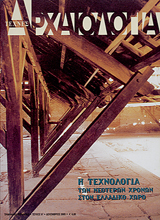
 Χαλκογραφία των ναυπηγείων της Κωνσταντινούπολης.
Χαλκογραφία των ναυπηγείων της Κωνσταντινούπολης.
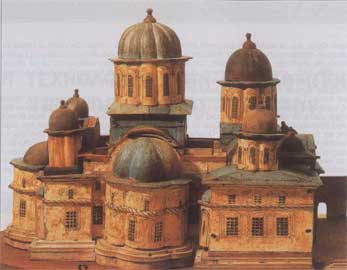 Το πρόπλασμα για το κτίσιμο του Καθολικού της Μονής Ξηροποτάμου, στον Άγιον Όρος, 1762.
Το πρόπλασμα για το κτίσιμο του Καθολικού της Μονής Ξηροποτάμου, στον Άγιον Όρος, 1762.
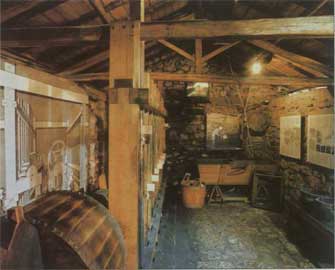 Υπαίθριο Μουσείο Υδροκίνησης στη Δημητσάνα.
Υπαίθριο Μουσείο Υδροκίνησης στη Δημητσάνα.
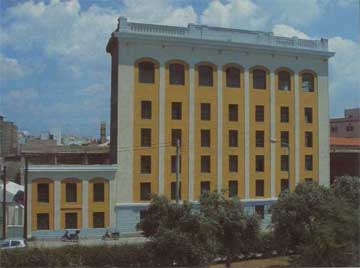 Ο κυλινδρόμυλος Γεωργή-Νικολετόπουλου στον Πειραιά. Ένα από τα πρώτα κτίρια μπετόν-αρμέ στην Ελλάδα.
Ο κυλινδρόμυλος Γεωργή-Νικολετόπουλου στον Πειραιά. Ένα από τα πρώτα κτίρια μπετόν-αρμέ στην Ελλάδα.
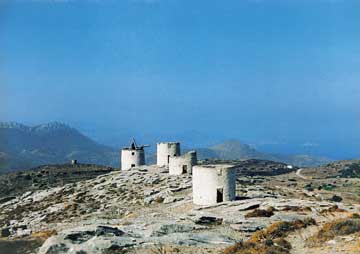 Αμοργός, Χώρα. Ερειπωμένο χαρακτηριστικό συγκρότημα ανεμόμυλων με κυλινδρικούς πέτρινους πύργους.
Αμοργός, Χώρα. Ερειπωμένο χαρακτηριστικό συγκρότημα ανεμόμυλων με κυλινδρικούς πέτρινους πύργους.
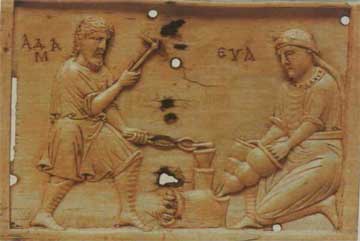 Η Εύα χειρίζεται διπλό φυσερό. Ελεφαντοστέινο πλακίδιο από βυζαντινό κιβωτίδιο. 10ος ή 11ος αιώνας.
Η Εύα χειρίζεται διπλό φυσερό. Ελεφαντοστέινο πλακίδιο από βυζαντινό κιβωτίδιο. 10ος ή 11ος αιώνας.
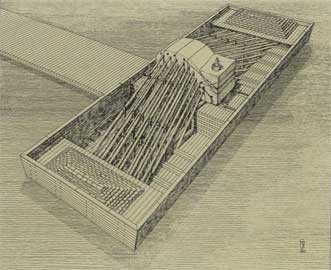 Έτσι μοίρασε ο Χαρμπούρης το φορτίο σε όλο το μήκος της φορτηγίδας, πριν να αντλήσει τα νερά και να την ανελκύσει στην επιφάνεια
Έτσι μοίρασε ο Χαρμπούρης το φορτίο σε όλο το μήκος της φορτηγίδας, πριν να αντλήσει τα νερά και να την ανελκύσει στην επιφάνεια
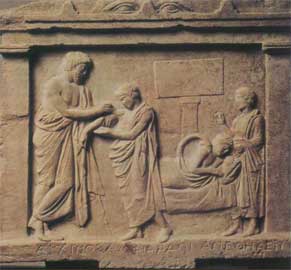 Ο Αμφιάραος πραγματοποιεί χειρουργική επέμβαση στον Αρχίνο. 4ος αι. π.Χ. Εθνικό Αρχαιολογικό Μουσείο.
Ο Αμφιάραος πραγματοποιεί χειρουργική επέμβαση στον Αρχίνο. 4ος αι. π.Χ. Εθνικό Αρχαιολογικό Μουσείο.
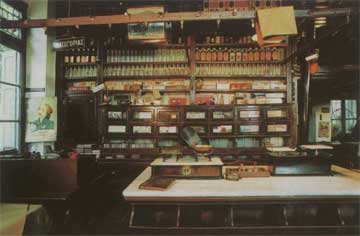 Λάρισα. Οινοπαντοπωλείον Νικ. Νικόδημου, εσωτερικό (φωτ. Α. Παυλίδη, 7.7.2005).
Λάρισα. Οινοπαντοπωλείον Νικ. Νικόδημου, εσωτερικό (φωτ. Α. Παυλίδη, 7.7.2005).
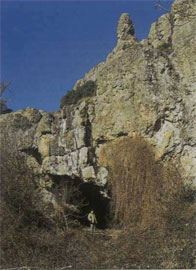 Δεξιά πλευρά της εισόδου του σπηλαίου Μεγάλη Βούβα.
Δεξιά πλευρά της εισόδου του σπηλαίου Μεγάλη Βούβα.
 Γελοιογραφία του Φ. Δημητριάδη με τον πρωθυπουργό να παρουσιάζει την Ακρόπολη ως έργο της κυβερνήσεώς του.
Γελοιογραφία του Φ. Δημητριάδη με τον πρωθυπουργό να παρουσιάζει την Ακρόπολη ως έργο της κυβερνήσεώς του.
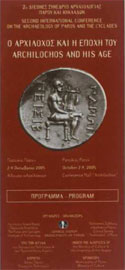 Το πρόγραμμα του συνεδρίου
Το πρόγραμμα του συνεδρίου
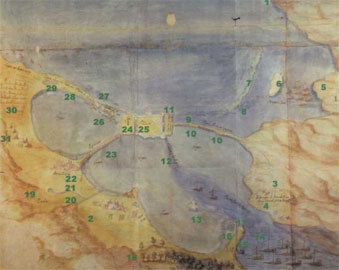 Σχέδιο σε ακουαρέλα του πορθμού της Λευκάδας, όπως αποδόθηκε από άγνωστο καλλιτέχνη.
Σχέδιο σε ακουαρέλα του πορθμού της Λευκάδας, όπως αποδόθηκε από άγνωστο καλλιτέχνη.
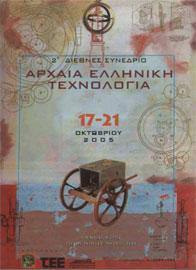 Η αφίσα του συνεδρίου.
Η αφίσα του συνεδρίου.
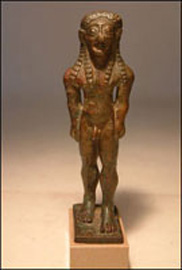 Ο κούρος από το Ηραίο της Σάμου που επαναπατρίστηκε.
Ο κούρος από το Ηραίο της Σάμου που επαναπατρίστηκε.
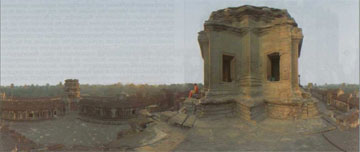 Πανοραμική εικόνα του ναού του Angkor Wat.
Πανοραμική εικόνα του ναού του Angkor Wat.
 Journal of Mediterranean Archaeology, λογότυπο
Journal of Mediterranean Archaeology, λογότυπο
A great change was brought about by movement becoming mechanized, by the use of steam, petroleum and electricity. In the pre-industrial period, Greece moved at a very slow pace. The Greeks of the diaspora were the pioneers and innovators. Greeks distinguished themselves in building and shipbuilding. Steel and concrete are predominant in the late 19th and early 20th century. Sweeping changes occur. Traditional ways of production are not recorded or published. Nevertheless, the triumph of technology led to the creation of museums of Science and Technology related to the field of Industrial Archaeology.
The evidence of the Greek commercial shipping and shipbuilding during the Turkish occupation are limited, while any references to shipbuilding until the middle of the eighteenth century are brief and sporadic. The technique applied in the Greek shipyards could be characterized as rather primitive, according to description in travelers accounts, although certain existing information can support the argument that Greek shipbuilders with expert knowledge and technical skills existed in that period. There fore, it is very important that Greek shipbuilders –whose names are occasionally mentioned- and craftsmen were employed in the state shipyards of both the Ottomans and the Venetians from the fifteenth to the nineteenth century, according to literary sources. From the eighteenth century on the information about shipping and shipbuilding in the islands and the coastal areas of Greece is increasing, as a result of the Greek trading activity that is rapidly developing in these years. In the late eighteenth and the early nineteenth century the islands Hydra, Spetses and Psara became the driving force of shipping. The techniques applied in the major Greek shipyards was by then modernized and included the thorough designing of the vessel, the use of imported raw materials when necessary, and the adoption of more secure launching and refloating methods. Furthermore, the effective division of labor among specialized craftsmen resulted to the increase of production and to the improvement of the quality of vessels. As regards the technical applications, the molding method, the variations of which have survived until today, probably represents the most interesting heritage of the Greek shipbuilding craft, at least since the time of Turkish occupation. Similar methods, usually known by the English term “whole-moulding” have been recorded in quite many historical and ethnological research projects dealing with the traditional shipbuilding of other countries and are counted even today among the important “secrets” of the trade of the wooden ship builder.
By the term “technology” in the pre-industrial building construction we mean: the means for architectural drawing, the degree of processing raw materials and the tool of equipment. Since architectural drawings from the Greek province have not survived, the model (maquette) of the katholikon of Xeropotamou Monastery on Mount Aths represents so far a unicum of its kind. However, drawings of impressive konak (Ottoman mansions), distinct in expression and structure, have been preserved in Constaninople. In the province the use of a wooden module for laying down the plan of a building, directly on the ground, is an evidenced practice. Thus, the vast technological divergence between center and periphery is more than obvious. Until the middle of the nineteenth century the building materials are limited to those available in the construction environment and are closely connected with the local architectural idiom. Due to favorable trade conditions, the local differences in building technology start decreasing with the Athonite monasteries and the merchants of the Greek Diaspora being the vanguards of every innovation. The new demands, however, did not lead to the technological development of the domestic sources of building materials, but to extensive imports exclusively from European industries. The sole use of hand tools and the general acceptance of naïve building practices lends to the works a picturesque character that fades away as nearing the centers, that is Mount Athos, the cities and the capital. Nevertheless, the craftsmen in later years start taking licenses and deviating from tradition even in the province: the development of technology since the mid-nineteenth century has not always contributed, as one would expect, to the quality and durability of buildings.
The historiography of modern Greek Technology, which conventionally coincides with the era from the fifteenth century until to date, is not so rich as the one dealing with the other aspects of nationality activity in these six centuries. This article on the one hand refers to this period and on the other contributes to the knowledge of its Technology by focusing exclusively on the personality of three engineers: Nikolaos Sorvolos (15th cent.), a native of Chandax (present Herakleion), Crete, Marinos Charbouris (18th cent.), a native of Argostoli, Kephallonia, and Michail Kokkinis 919th cent.), a native of the island of Chios. They shared the common characteristic of originating from the “periphery”, but they were educated and made a carrer mainly in the West, since the historical circumstances prevailing in their time did not favor “nativeness”. Nevertheless, given that these three “ pioneer engineers” returned sometime and realized important works inside the geographical boundaries of contemporary Greece, certain latent broader influence of their achievements could probably be traced. Here is a concise presentation of their major achievements: a. In 1439, N. Sorvolos “transported” a Venetian fleet, consisting of six galleys nd twenty-five brigs, through a massif of 1,000m height in Northern Italy. b. In 1770, M. Charbouris managed to hoist a huge rock weighing 2,000 tons and to transport it through swamps and rivers to Saint Petersburg, Russia. c. In 1824, M.Kokkinis achieved the gigantic task of planning and building the 2,000 m long stone fortification wall of the city of Mesolonghi in twenty months and in war conditions. The promotion of these pioneers of Greek Technology can probably contribute to the restoration of balance of our educational interests, so that they will be reoriented towards applied sciences as happened in 1810.
The use of reinforced concrete in Greece coincides with the intensive building activity in the country in the twentieth century, and its “secrets” are known to thousands of engineers as well as to craftsmen. Particularly in Greece of the early twenty-first century the use of reinforced concrete is considered the simplest way to erect a building, not to mention that the use of metal for the construction of big technical works (bridges, large roofs, stadiums), although much more difficult in application, is regarded as a matter of course. These two building materials, iron, from the end of the nineteenth century, and reinforced concrete, from the beginning of the twentieth have penetrated the building sector superseding stone and wood, the age long traditional building materials. Iron as building element was used for the construction of factories and Neoclassical mansions around the end of the 1870’s, while the technique of iron construction was continuously developing until about 1905, and can boast grand and bold applications mainly in industrial, harbor and rail works. Reinforced concrete was introduced in Greece in 1901, was essentially established in the 1920’s and was extensively used from then on until the World War II for the erection of hundreds of factories, hospitals, schools and urban blocks of flats of modernistic architecture. Some of the avant-garde reinforce concrete buildings had no followers as opposed t the urban blocks of flats of the 1930’s that became influential models. The basic typology of their architecture and particularly the in situ method of construction have remained unchanged since then. Meanwhile, reinforced concrete as building material transgressed the boundaries of specialized firms and came slowly at the disposal of every minor contractor or craftsman.
During the pre-industrial technological era the natural sources of energy were intensively exploited in Greece for the operation of water- and wind- powered installations, most of which were grinding mills. The watermills, which were mainly furnished with horizontal water wheels, were erected throughout the country, even on the islands, where there has always been a shortage of running water, while the windmills were primarily built in the Aegean, where suitable winds blow. In addition, water power was used for the operation of fulling-mills, water saws, oil mills and fulling-tabs, while wind power was employed not only for water pumping but mainly for the common Mediterranean tower mill and other types of mills, such as the horseshoe-shaped mill, which operated with a single wind direction, or the mill with a horizontally rotating propeller. In spite of the important cultural, historic, social and economic role these installations have played, it does not exist in Greece even to date, when they have been ruined by time, an articulated stet policy for their protection and preservation, although they are significant examples of pre-industrial technology and interesting monuments for archaeological and ethnological study.
This article is a brief review of the motive power of the pre-industrial mills of Cyprus, dating mainly from the eighteenth to the twentieth century. All the available forms of energy have been exploited on the island, the muscular (human and animal), the aeolian and the water power. To the first group are ascribed the hand mill, an integral part of the traditional household until the twentieth century, the cotn grinding mill driven by animals, and the olive mill. During the period of British administration (1878-1960), mills driven by animals are exclusively recorded in Ammochostos district until 1919. The few preserved remnants indicate that the motion was conveyed to the millstones through a large horizontal wooden wheel. The olive mill consists of a cylindrical millstone that rotates vertically in astone round basin. This type of mill, to which the majority of mills preserved on the island belongs, is diversified as regards the form of its vertical axis and its location, whether, that is, it stands in the open or it is sheltered. The few ruined windmills that have been located in areas with suitable winds belong to the Mediterranean type of mills, which consists of a cylindrical tower-like structure, a vertical wheel and canvas sails. Their operation stopped in the beginning of the twentieth century. Water power has been the major exploitable energy, and the watermills have been operating from the twelfth to the mid-twentieth century. They display a monumental stone-built water tower and aqueduct and, as a rule, a horizontal wheel rotating by waterpower. In the pre-industrial phase the millstones, of Melian origin, were installed on the floor of a space built just above the water-wheel, so that both the upper millstone and the water-wheel could rotate around the same vertical axis.
In the framework if the research project carried out in Messenia, the oil producing region of Greece par excellence, relevant machinery and installations have been located, the older ones dating from the mid-nineteenth century. These types of machinery have been identified: In the first type, the crushing device consists of a lower and an upper stone and the press displays a stone base and a wooden superstructure. In the second, the crushing device is enlarged and the press is made exclusively of metal. In the third type, that signals that industrialization of energy, the central system is hydraulic, the crushing device becomes even more bulky and elevated and the press is furnished with a piston. In this later phase of the oil mill evolution more modern and developed types of press are used. The last hydraulic press stopped to be used around 1980, while the oil mills operating to day are equipped with centrifugal apparatuses. Not only the machinery, but also the type of the oil mill buildings is also diversified forming three groups: a. The small, single-spaced oil mills that are located in the olive production areas, process a small amount of olives and serve the needs of a few families. b. The enlarged oil-mills that have the capacity to accommodate large quantities of olives and are located in populated areas. c. The oil mill complexes that can handle an immense olive production and reflect the industrialization of energy and the increase of product.
In Western Europe the break from the past as regards the conception of natural environment, the machine technology and the new labor approach has laid the foundations of the technological tradition, already since the early twelfth century. These principles are expressed by the Presbyter Theophilos, a German monk of the Benedictine order, in his work De Diversis Artibus, a manual in three books, the first of its kind treatise on painting, glass-making and metalwork, written between 1122 and 1123. The third book of this work of diachronic importance is dedicated to metalwork and supplies the basis on which the evolution over the centuries of gold-m and silversmithing techniques can be followed, particularly in our country, where the pre-industrial period has lasted until about the middle of the twentieth century. From the twelfth century to the recent past or even to date Theophilos’ descriptions, the relevant references to modern technical manuals and our oral tradition verify each other continuously. In this article the references to workshops, tool equipments and, indicatively, to certain techniques of manufacturing and decorating objects are aiming to locate the continuities and breaks and to stress any retardation observed in comparison to the technological tradition of the west. Finally, the review of the Greek literary sources concerning metalwork confirms that basic reference texts are lacking and that the gap between science and technology, theory and praxis has never been bridged.
The serious misunderstanding that the restoration of traditional workshops could contribute to the preservation of traditional techniques has resulted to a series of restored and renovated ateliers, however closed and inactive if not definitely abandoned, as well as to a big disillusionment. Concurrently, it has become obvious that traditional arts as a production method and therefore as a means of living have died. The preservation of traditional technology can be much more effectively realized through its recording, documenting and videotaping and also through the publishing of relevant scientific articles. Nevertheless, the creation of thematic technological museums, although it presupposes a high cost of construction, is the most appropriate and effective way for transmitting to the museum visitor traditional technology and its course. These museums fall in two categories: a. The museums of themselves, that is workshops in which the entity of apparatuses is preserved. b. The thematic technical museums housed in neutral building-shells. Both, however, must be primarily based on museological entities, resulting from the elaboration of complete research projects that have been realized through modern educational methods. The operation cost of these museums is a more serious problem than their construction, since the task to staff, maintain and renovate them is both expensive and difficult. The Piraeus Bank Group Cultural Foundation has elaborated a model for the operation and management of an ensemble of eight Thematic Thematic Technological Museums in Greece.
The history of the Sciences and Technology Museums begins at the late sixteenth century with the “galleries of curiosities” and continues in the seventeenth century with the institution of the Ashmolean Museum in Oxford, which presents the scientific and technological achievements in an encyclopedic way. Since the mid-twentieth century, the era of the skyrocketing development of mass media, the emphasis has been shifted and laid up on systematic education. The new approach to thematic exhibitions ascribes the displayed object to a program with a multidimensional meaning-message, such as artifact and society, process of scientific thought, need for protection and preservation. The fixed objective is the communication of knowledge and the means of achieving it are the new museographic applications, such as the advanced audiovisual media and the transeffective systems that help the museum visitor to undergo a personal experience and to form a critical opinion.
A meeting held in 1978 among educationists, technicians and businessmen gave the initiative for the institution of the Technical Museum of Thessaloniki. The purpose of its establishment and uninterrupted presence for a quarter of a century was to contribute to the acquaintance and familiarity with and the increase of interest in Science and Technology. In October 2001 the Science Center and Technology Museum was constituted, an institution that incorporated the activities of the former Technical Museum and conducted the construction, organization and operation of the new installations.
Cities possessing technological museums are cited below in alphabetical order. Information on the museums is also supplied (contact numbers, timetables, museum schedules etc). The cities are the following: Athens, Aigio, Andros, Volos, Galaxidi, Demetsana, Edessa, Thessaloniki, Ioannina, Kalamata, Komotini, Mykonos, Patra, Rhodos, Soufli, Sparti, Syros, Chania and Chios.
Today, when a critical approach to world archaeology is necessary, there are many scholars who ask philosophical questions about the nature and social contribution of archaeology in order to clarify its role. Such an essential question is dealing with the relationship of archaeology with nation. Do archaeologists discover an “objective” past or do they create on their own alternative histories, which then they project in the past? How the socio-political and cultural environment influences the archaeologist’s work? This article aims to explore such issues in the field of Greek archaeology and, by adopting the methodology of critical evaluation, to define the relationship of archaeology and nationalism. Scholars from all over the world have already underlined the mutual character of this relationship. On the one hand, archaeology seems to become valuable when its findings can define the identity of a nation; and on the other, nationalism seems to be enhanced by using the “glorious” past and its remnants; Greek archaeology is not an exception to this common practice.
Lycaea, dedicated to the gods Zeus and Pan, was the most important festival in Arcadia. It was established by Lycaon, the mythical king of Arcadia, and it included rites, performed on the top of the Lycaeon Mount at 1383m height, as well as athletic games and horse races that were conducted in a valley close to the mountain peak. Tradition considers it an age-long festival, but according to the Parian Marble it was established in the fourteenth century B.C.. The archaeological finds evidence rites that date from the archaic period, while the historical sources confirm the conduct of games from the early classical age. The archaeological excavations brought to light tablets inscribed with fourth-century programs of games and names of Lycaean victors. In the athletic games that were held every five years and had a pan-Arcadian range, could also participate distinguished athletes from all over Greece. The program of the games included foot races, wrestling, and horse and chariot races and was similar to that of the Olympic games.
The terminology used in architecture in the ancient world clearly shows that quite often its point of reference is the human body; thus, correspondences of human members to architectural ones are established which refer to the complete and intact as well as to the damaged architectural members. In the terminology concerning the building detriments, the damages are regarded as wounds, the restorations as medical treatments and the declined edifices as living organisms that suffer. Therefore, it becomes obvious that the terminology of architecture refers to man, either directly, when it specifies the architectural members, or indirectly, when it turns t medical terminology in order to describe their decay.
In the district of Leukimi village, at the depth of a small valley, we come in view of the impressive “Megali Vouva” cave that displays a carved phallumorphic stele on the upper right side of its entrance. The interior of the cave consists of two unequal in size chambers. An elevated shallow semi-circular conch (probably a burial place) with two hollows on its right side (probably purposed for offerings) has been carved on a lime stone protrusion almost at the center of the bigger chamber. It closely resembles the cock-cut tomb at Askites. The scattered Hellenistic and Byzantine shards and the fragments of hand made pottery dictate the urgent excavation of the site, which may yield significant finds for the history and culture of Thrace.
In spite of the first impression of an impersonal concrete city that Larissa gives, the patient itinerant finds out that it has preserved some tesserae from all the periods of its history: they represent islets of quality in the everyday life as well as a pole of attraction for the visitors of Larissa. Among them a wine shop of the early twentieth century still stands intact and operates as a restaurant thanks to the painstaking efforts of a local association. The Greek public opinion and our fellow citizens usually downgrade the very serious issue of respecting and preserving the cultural heritage of our country, and in particular that of the recent past. The case of Nikodemos’ wine shop in Larissa and its successful management for twenty years now by a local association presents an interesting model for the preservation of an historic monument of a city by its conscious of the past and appreciative citizens.
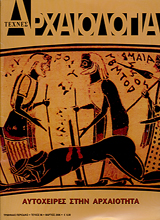
 Ο Αίας μπήγει το ξίφος στο έδαφος για να αυτοκτονήσει. Μελανόμορφος αττικός αμφορέας που αποδίδεται στον Εξηκία, περ. 540 π.Χ.
Ο Αίας μπήγει το ξίφος στο έδαφος για να αυτοκτονήσει. Μελανόμορφος αττικός αμφορέας που αποδίδεται στον Εξηκία, περ. 540 π.Χ.
 Η αυτοκτονία της Διδώς. Μικρογραφία από τον κώδικα Virgilius Vaticanus, Lat. 3225 φ. 40.
Η αυτοκτονία της Διδώς. Μικρογραφία από τον κώδικα Virgilius Vaticanus, Lat. 3225 φ. 40.
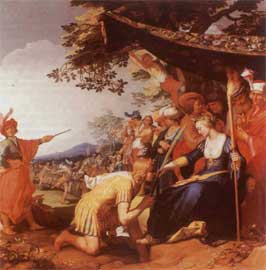 Ο Θεαγένης λαμβάνει τιμητικό βάιο από τη Χαρίκλεια. Άμπραχαμ Μπλούμαρτ, Mauritshuis, Χάγη.
Ο Θεαγένης λαμβάνει τιμητικό βάιο από τη Χαρίκλεια. Άμπραχαμ Μπλούμαρτ, Mauritshuis, Χάγη.
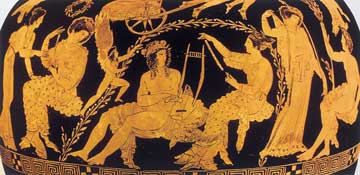 Η Αφροδίτη ξαναδίνει τη νιότη και χαρίζει ομορφιά στον Φάωνα. Λεπτομέρεια από ερυθρόμορφη υδρία, 410 π.Χ.
Η Αφροδίτη ξαναδίνει τη νιότη και χαρίζει ομορφιά στον Φάωνα. Λεπτομέρεια από ερυθρόμορφη υδρία, 410 π.Χ.
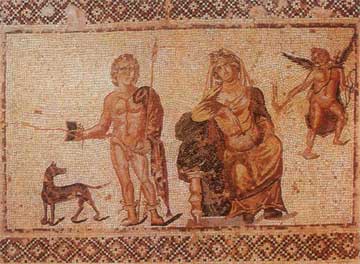 Η Φαίδρα, ο Ιππόλυτος και ο Έρως. Ψηφιδωτό από την "Οικία του Διονύσου", Νέα Πάφος, αρχές 3ου αι. μ.Χ.
Η Φαίδρα, ο Ιππόλυτος και ο Έρως. Ψηφιδωτό από την "Οικία του Διονύσου", Νέα Πάφος, αρχές 3ου αι. μ.Χ.
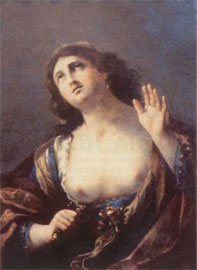 Η αυτοκτονία της Λουκρητίας. Μουσείο Καλών Τεχνών, Caen.
Η αυτοκτονία της Λουκρητίας. Μουσείο Καλών Τεχνών, Caen.
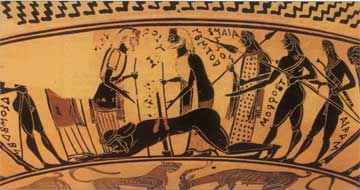 Οι Αχαιοί βρίσκουν τον Αίαντα νεκρό, πεσμένο στο γυμνό ξίφος.
Οι Αχαιοί βρίσκουν τον Αίαντα νεκρό, πεσμένο στο γυμνό ξίφος.
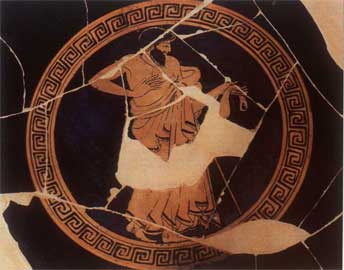 Ερυθρόμορφο αγγείο Δούριδος (500-460 π.Χ.), Φλωρεντία, Museo Archeologico Nazionale.
Ερυθρόμορφο αγγείο Δούριδος (500-460 π.Χ.), Φλωρεντία, Museo Archeologico Nazionale.
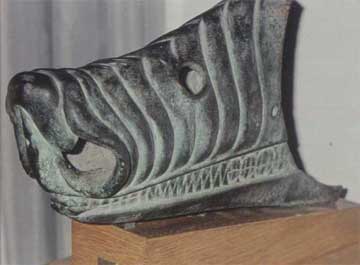 Έμβολο (Μουσείο Κανελλοπούλου)
Έμβολο (Μουσείο Κανελλοπούλου)
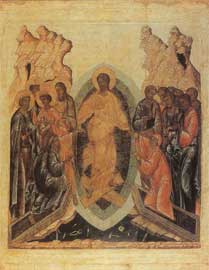 "Εις Άδου Κάθοδος", 16ος αι. Χρυσοκονδυλιές στις ακτίνες της δόξας του Ιησού με την τεχνική ίνακοπ.
"Εις Άδου Κάθοδος", 16ος αι. Χρυσοκονδυλιές στις ακτίνες της δόξας του Ιησού με την τεχνική ίνακοπ.
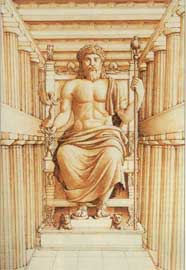 Αναπαράσταση του χρυσελεφάντινου αγάλματος του Ολυμπίου Διός.
Αναπαράσταση του χρυσελεφάντινου αγάλματος του Ολυμπίου Διός.
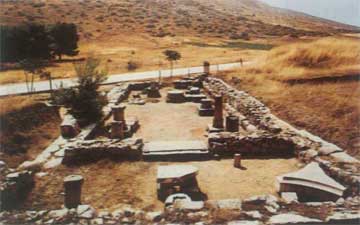 Γενική άποψη του ναού της Αρτέμιδος στην Αυλίδα. Σε πρώτο πλάνο το άδυτο του ναού.
Γενική άποψη του ναού της Αρτέμιδος στην Αυλίδα. Σε πρώτο πλάνο το άδυτο του ναού.
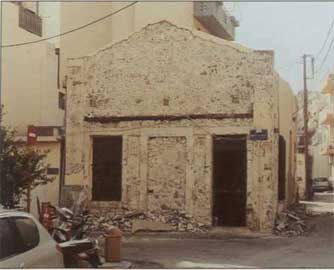 Η ιδιοκτησία Παπουτσάκη πριν από την καθαίρεση των κονιαμάτων.
Η ιδιοκτησία Παπουτσάκη πριν από την καθαίρεση των κονιαμάτων.
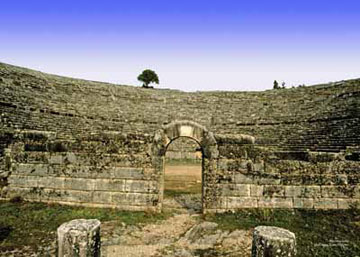 Το αρχαίο θέατρο της Δωδώνης.
Το αρχαίο θέατρο της Δωδώνης.
Although it is unknown as a term in ancient Greek, suicide is nevertheless present in Graecoroman antiquity. Ajax, an emblematic suicide, turned his deed into an act of bravery. However, suicide is approved of, when it protects male honour. What if, though, the hero’s suicide is due to a narcissistic trauma? From among the real or mythical women suicides, Sappho stands out for her “drowning”. What, however , is its symbolism? The five “Romantic” novels of late antiquity are haunted by despair in love, but intended suicide acts as an affirmative gesture to life. For the Romans, the suicide’s methods conceal all sorts of symbolisms. The stoic philosophers Seneca and Epictetus were in favour of a voluntary exit from the game of life.
Suicide is often denoted as the “Roman Death” in the Anglo-Saxon world. The expression stems from the conviction that self-killing was common in the ancient world. However, on the basis of the available data it is not possible to corroborate this belief. In my 1990 monograph entitled From Autothanasia to Suicide. Self Killing in Classical Antiquity 960 instances were processed. During the years the number of my ghastly collection has grown to 1317.. As an historian I am not qualified to assess the aesthetic meaning of an individual work of art nor its place in a specific genre. My questions are basic and global: which suicides were represented? Were specific methods favored or avoided by art? If so, why? What is the proportion of male versus female suicide in art? Are these distinct patterns for Greek and Roman iconography of self-killing? The answers to these questions may help to establish the significance of art for understanding the ancient paradigm of mors voluntaria. The way an individual puts an end to his or her life is the most objective method to group the representations. Therefore, this paper discusses the material to the method used.
The article focuses on the visual representations of suicide in antiquity and examines their literary background: Ajax’s suicide is thoroughly narrated in the cyclic poems, an epos that was disseminated in the entire Greek world through the popular representations of this episode, decorating in the archaic period pottery, shields and architectural sculpture. In the fifth century B.C. the tragedies of Aeschylus and particularly those of Sophocles presenting Ajax’s suicide probably inspired the celebrated painter and toreutics artist Parrausius to create a work with this subject and equally influenced the vase-painting repertoire in the decades that followed. The shift of interest towards representations of real events that occurres after Aristotle’s explains the success and popularity of a series of sculptures, ranging from the Pergamene to Roamn art, which portray the suicide of defeated barbarian leaders. Finally, suicides caused by love as well as their impact on Roman wall paintings are considered.
Sappho identifies herself with Aphrodite and Phaon with Phaethon. By diving from the White Rock of Leukas, she does what Aphrodite does in the form of the evening star, diving after the sunken sun in order, next morning, as the morning star, to bring him back from the dead in pursuit of her.
In his tragedy Ajax Sophocles outlines the psychological portrait of the tragic hero and stresses the internal procedures that lead him to take his own life. The character of Ajax is depicted rigorous and strict with a supercilious, excessive appreciation of his won heroism that reaches impudence and arrogance. Ajax identifies himself with the behavioral model of valor and heroism that the figure of his severe but glorified father represents. He will not dare to stand before his father before he himself would accomplish the heroic deeds of his model. The supercilious self-esteem of Ajax and his rigid and arrogant nature suggest a narcissistic pathology, which is connected with an equally pathological “ideal Ego” that displays unfeasible or excessive ambitions as well as compulsive feelings of disgrace and makes man unable to face the consequences of his actions and the criticism of others. Ajax’s reaction to the outcome of the “crisis of arms” will reveal the susceptibility of his character. The course of the play follows the route of the psychical clashes of Ajax. The shame, humiliation and insult he feels because of the outcome of the “crisis of arms” cause a strong narcissistic trauma that leads the hero to revenge in order to restore his haughty self-appreciation. Driven by his narcissistic furor (with the intervention of the goddess Athena, according to Sophocles), he switches to a situation of “madness” and dispatches the cattle of the Achaeans in an illusion that he slaughters his hateful enemies. Regaining the perspicacity of his conscious of his nature that he is unable to change and thus he commits suicide in a desperate effort to restore his pathological insolence. Ajax takes his own life, since disgrace has deprived him of honor, the major reason of his existence.
Although the ancient Greek language has no single term for “suicide”, our sources-particularly the myths, the historians, funerary epitaphs and dream-books- abound in revealing information on how the Greeks regarded the self-killing of a member of their society. The article examines two representative cases from the mid- fourth century B.C. First, the case of the Athenian politician Timarchus who was alleged to have prostituted himself to other men in his youth, having welcomed upon his body the “sins of a woman”. After being sentenced to atimia (in effect, a humiliating and lifelong public silence and withdrawal), Timarchus is reported to have hanged himself. The report, based on a literal reading of a passage in Demosthenes XIX, 2, is late (pseudo-Plutarch), yet seems plausible enough in the light of the social dynamics of the fourth-century B.C. Athens: atimia could have provoked suicide in a society in which social cohesion and the need to conform were extremely intense. Second, the flamboyant, pseudo-altruistic suicide of Pausanias, Phili II’s eromenos, as recounted in Diodorus Siculus (XVI. 93. 3-7). Both suicides were triggered by the invective that alleged violation of dikaios eros, that is properly managed homosexual relations. Both allegations “feminized” the accused and thereby cast a shadow on his competence and solidarity as a citizen-soldier. As we hope to show, these parallel suicides-a kind of diptych-shed light on one another and together confirm a number of ancient mentalities regarding not only suicide but also masculinity and “male honor”.
In the Hellenistic period when Stoicism flourished, suicide was “in fashion”. No matter how paradox it may seems, the Stoic, a rare human type, had the right to commit suicide for five different reasons. He was excused to take his own life, when his bliss, a state of euphoria similar to that of god, was threatened, since, according to Stoic philosophy, god, nature and the word were equivalent sizes, related to each other with sympathy. Zemo of Citium, the founder of Stoicism, committed suicide, when a heavenly “sign” announced to him that his time had come to depart from his world. The doctrines of the Cynics contributed in general to the philosophy of Stoics and particularly to their approach on suicide. The reasoning of J.M. Rist, an expert on Stoicism, that Plato and Aristotle consider suicide permissible under certain circumstances brings afore various persuasive arguments and interesting questions regarding this subject, which breaches the internal cohesion of the Stoic system of philosophy.
The young and beautiful lovers of the ancient Greek novels attempt escape from some stalemate situation which introduces uncertainty to the desired outcome of their love. In their quest for togetherness, they depart their normal environment, risking their lives, and passively submit themselves to ordeals in alien parts. They might thus be seen as fixed props on which are pinned a symbolic expression of a search for self-definition and social role. But it is while in the chaotic, alien world that the isolated protagonists find themselves most lacking in social identity; and it is also in this alien world that the individual protagonist attempts his or her own ultimate act of personal control:suicide. Typical of all suicide scenes in the novels is loss of hope, defeat and resignation. For purely personal reasons- always despair over the perceived loss of their loved one- all of the novels’ protagonists attempt, or threaten to kill themselves. Thus the protagonists’ risk-taking, which started their ordeals in the alien world, is an act born out of a feeling of uncertainty; in contrast, the protagonists’ suicide acts within their alien world ordeals arise from a sense of certainty. The protagonists’ constructed meanings for their suicide actions show that they know beyond all doubt that there is no hope of attaining their love (and social identity) in the future, that all is irretrievably lost. While the lovers, through their risk-taking departure from their homelands were communicating the question “Who am I?”, through their suicide acts they are communicating the answer “I know who I am, I am nobody”. At the determination of each suicide attempt, the individual protagonist possesses a certainty of his or her social identity as a nobody in the absence of order.
The article deals with four of the many cases of women in antiquity that intentionally took their own life: Sappho, Phaidra, Iocaste and Cleopatra. However, the circumstances prevailing in the time each one of them lived concealed the personal, social and political causes of their suicide.
The phenomenon of suicide in antiquity and in the Roman period in particular is a complex subject with many aspects that need to be studied. In most cases only the motive that drives a person to commit suicide is known, while his childhood. Experiences and mental balance are latent. The choice of method by which the individual intentionally takes his own life, such as starvation, setting himself on fire, taking poison or hanging himself, has a specific symbolism and a great importance. The motives driving a person to commit suicide, such as mania, physical pain, dedication, disgrace and others, must be approached through the way of thinking of those living in the Roman age, which is also relevant to their social up bringing. The Roman laws were referring only to specific cases of suicide, such as the suicide of soldiers, while the jurists of the period laid particular stress on such cases as the suicide of the defendant who would take his own life during his trial. Finally, we must note that there were no social or ethical limitations in representing suicide either in visual arts or theatrical plays, drama and comedy. Some of the surviving works of art, such as the wall painting of Pyramus and Thisbe or the sculpture of the Gaul who turns his sword to himself after having killed his wife, give us an adequate idea of how the suicidal act was represented.
The Mycenaean world undoubtedly displays a unique form of “burial” culture which in addition to its architectural expressions (shaft, chamber, vaulted graves) and artistic manifestations (funeral offerings), also reveals the structure of its society. Thus, the study of Mycenaean burials discloses the close relation of funerary practices and customs with Mycenaean society and how this society was organised. Furthermore, the social stratification and status as well as the political and economic level both of individuals and of the society they lived in are reflected in the funerary rituals and in the basic types of burial of the Late Helladic period.
This article focuses on three bronze battering rams from ancient warships of the Classical, Hellenistic and Roman periods, found in Greece. The first is exhibited at the Archaeological Museum of Piraeus, the second is on show at the Archaeological Museum of Ioannina in Northern Greece. The latter is in fact a mere fragment of a ram that was found on the site of the Nicopolis excavations. It is part of a group of battering rams decorating the monument of Octavian Augustus, built to commemorate his victory over the combined fleets of Queen Cleopatra of Egypt and Marcus Antonius in the naval battle of Aktion in 31 BC. The third is a very small, ram-like object with a peculiar shape-its identity will be discussed later- strikingly different from the other two. It is on show at the Kanellopoulos museum in Athens. The study of the three battering rams from the point of view of metallurgy has led to significant conclusions regarding their chemical composition, anti-corrosive behaviour in sea water, physical and mechanical properties and overall design.
The name of Pheidias is related to two exceptionally beautiful and sumptuous statues; that of Athena Parthenos and that of Zeus. Made of gold and ivory, the statue of Athena was housed in the nave of the Parthenon, while the other statue was housed in the temple of Zeus in Olympia. The iconography of these two statues and their pedestals is derived from mythology and is very interesting from a historical, sociological and political point of view. As the forerunner of philosophy and history, Mythology supplied artists with material for the creation of associations necessary to the spectator. The figures depicted on the shield of Athena and on the throne of Zeus, conveyed a message from the creator of the two statues to the visitors to the two ancient sanctuaries, that of the temple of Athena that stood on the Acropolis of the city that was the centre of the Athenian alliance, and the sanctuary of Zeus at the Panhellenic centre of Olympia. Both symbolised a world lost to us today, which left its traces and exerted an influence on Christianity, the new religion. Although these mythical works of art perished in the age of the Byzantine Empire, their fame has remained indelible.
Russian icons are painted with egg tempera on a wooden medium which is usually made of linden and is supported on its reverse by horizontal wooden bars. The obverse is generally dressed with linen on which the preparation for painting, a mixture of plaster or chalk with sturgeon or animal glue and linseed oil, is applied. The preliminary sketch is drawn according to the models or instructions of iconographic manuals; it is made with charcoal and is accentuated with ink. The finished painting is coated with a protective layer of “alifa”, a varnish consisting of progressively drying linseed oil and amber. Gold, mixed with egg white and occasionally combined with boll is used for gilding, while gold sheet is employed for gold striations, either plain, in which case it is applied according to the “inakop” technique, or dissolved in sour cherry-tree glue and mixed with egg white. Egg-yolk and “kvas” are the cohesive agents of pigments.
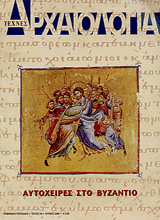
 Ο απαγχονισμός του Ιούδα και η Σταύρωση. Πλακίδιο από ελεφαντόδοντο (420-430), Λονδίνο, Βρετανικό Μουσείο.
Η ευαγγελική παράδοση περί του θανάτου του Ιούδα θα ασκήσει σημαντική επίδραση στη διαμόρφωση του εικονογραφικού θέματος ήδη από τους πρώτους χριστιανικούς αιώνες.
Η απεικόνιση του θέματος σε εικονογραφημένα χειρόγραφα της μεσοβυζαντινής περιόδου (Ψαλτήρια με εικονογράφηση στην ώα, Ευαγγελιστάρια Τετραευαγγέλια), θα διαμορφωθεί με βάση την ευαγγελική παράδοση και την πατερική γραμματεία στα πλαίσια της ερμηνείας του Ευαγγελίου του Ματθαίου και του ψαλμού 108.
Στην παλαιολόγεια εποχή η απεικόνιση του θέματος εμπλουτίζεται με νέα εικονογραφικά στοιχεία, τα οποία προκύπτουν από την εικαστική απόδοση αφενός των κειμένων που συνδυάζουν και τις δύο παραδόσεις και αφετέρου άλλων διηγήσεων περί του θανάτου του Ιούδα, των οποίων χαρακτηριστικό δείγμα αποτελεί εκείνη του Παπία Ιεραπόλεως. Η πτώση του Ιούδα από το δέντρο και η απεικόνιση της μορφής του στο σπηλαιώδες άνοιγμα αποτελούν τα στοιχεία που με βάση τα σωζόμενα μνημεία εισάγονται στην παλαιολόγεια εικονογραφία.
Στο εικονογραφικό πρόγραμμα αυτής της εποχής ο απαγχονισμός του Ιούδα αποτελεί τμήμα μιας ομάδας παραστάσεων, οι οποίες εικονίζουν με αφηγηματικότητα τα γεγονότα που συνδέονται με την προδοσία του Διδασκάλου επεκτείνοντας τον κύκλο των Παθών.
Ο απαγχονισμός του Ιούδα και η Σταύρωση. Πλακίδιο από ελεφαντόδοντο (420-430), Λονδίνο, Βρετανικό Μουσείο.
Η ευαγγελική παράδοση περί του θανάτου του Ιούδα θα ασκήσει σημαντική επίδραση στη διαμόρφωση του εικονογραφικού θέματος ήδη από τους πρώτους χριστιανικούς αιώνες.
Η απεικόνιση του θέματος σε εικονογραφημένα χειρόγραφα της μεσοβυζαντινής περιόδου (Ψαλτήρια με εικονογράφηση στην ώα, Ευαγγελιστάρια Τετραευαγγέλια), θα διαμορφωθεί με βάση την ευαγγελική παράδοση και την πατερική γραμματεία στα πλαίσια της ερμηνείας του Ευαγγελίου του Ματθαίου και του ψαλμού 108.
Στην παλαιολόγεια εποχή η απεικόνιση του θέματος εμπλουτίζεται με νέα εικονογραφικά στοιχεία, τα οποία προκύπτουν από την εικαστική απόδοση αφενός των κειμένων που συνδυάζουν και τις δύο παραδόσεις και αφετέρου άλλων διηγήσεων περί του θανάτου του Ιούδα, των οποίων χαρακτηριστικό δείγμα αποτελεί εκείνη του Παπία Ιεραπόλεως. Η πτώση του Ιούδα από το δέντρο και η απεικόνιση της μορφής του στο σπηλαιώδες άνοιγμα αποτελούν τα στοιχεία που με βάση τα σωζόμενα μνημεία εισάγονται στην παλαιολόγεια εικονογραφία.
Στο εικονογραφικό πρόγραμμα αυτής της εποχής ο απαγχονισμός του Ιούδα αποτελεί τμήμα μιας ομάδας παραστάσεων, οι οποίες εικονίζουν με αφηγηματικότητα τα γεγονότα που συνδέονται με την προδοσία του Διδασκάλου επεκτείνοντας τον κύκλο των Παθών.
 Ο Ιώβ απευθύνει τον λόγο στους τρεις φίλους του. Κώδ. Β 100, 13ος αι., Μονή Μεγίστης Λαύρας, Άγιον Όρος.
Τα στοιχεία που αντλούμε από τις πηγές σχετικά με το ζήτημα της αυτοκτονίας στο Βυζάντιο είναι πολύ περιορισμένα, γεγονός που εξηγεί για ποιο λόγο το θέμα δεν έχει διερευνηθεί. Τα περιστατικά αυτοχειρίας που έχουν καταγραφεί από τον 4ο αιώνα έως την ιουστινιάνεια περίοδο αφορούν σχεδόν αποκλειστικά ειδωλολάτρες και περιπτώσεις διαιώνισης μιας στρατιωτικής παράδοσης – ότι για έναν ηττημένο στρατιωτικό ηγέτη δεν υπήρχε άλλη επιλογή παρά να αυτοχειριαστεί, προκειμένου να γλιτώσει την ατίμωση και την ταπείνωση στα χέρια των νικητών. Σε μεταγενέστερες περιόδους, παρόμοια περιστατικά αντιμετωπίζονταν ίσως ως ταμπού και πιθανόν να αποσιωπούνταν. Τα δικαστικά αρχεία επιβεβαιώνουν το γεγονός ότι τα περιστατικά αυτοκτονίας γυναικών σε κατάσταση εξαιρετικής έντασης δεν ήταν ασυνήθιστα και περιέχουν αναφορές σε αυτοκτονίες ανθρώπων που είχαν καταστραφεί οικονομικά και βρίσκονταν σε απόγνωση.
Ο απαγχονισμός φαίνεται ότι ήταν η πιο κοινή μέθοδος αυτοκτονίας, με το μαχαίρωμα και τον πνιγμό να ακολουθούν. Επίσης, το να κόβει κανείς τις φλέβες του καταγράφεται σε μία και μόνο περίπτωση – παρόλο που το περιστατικό αποδείχτηκε ότι ήταν ψεύτικη αυτοκτονία. Δράστης ήταν ο εικονοκλάστης Πατριάρχης Ιωάννης Γραμματικός.
Ο Ιώβ απευθύνει τον λόγο στους τρεις φίλους του. Κώδ. Β 100, 13ος αι., Μονή Μεγίστης Λαύρας, Άγιον Όρος.
Τα στοιχεία που αντλούμε από τις πηγές σχετικά με το ζήτημα της αυτοκτονίας στο Βυζάντιο είναι πολύ περιορισμένα, γεγονός που εξηγεί για ποιο λόγο το θέμα δεν έχει διερευνηθεί. Τα περιστατικά αυτοχειρίας που έχουν καταγραφεί από τον 4ο αιώνα έως την ιουστινιάνεια περίοδο αφορούν σχεδόν αποκλειστικά ειδωλολάτρες και περιπτώσεις διαιώνισης μιας στρατιωτικής παράδοσης – ότι για έναν ηττημένο στρατιωτικό ηγέτη δεν υπήρχε άλλη επιλογή παρά να αυτοχειριαστεί, προκειμένου να γλιτώσει την ατίμωση και την ταπείνωση στα χέρια των νικητών. Σε μεταγενέστερες περιόδους, παρόμοια περιστατικά αντιμετωπίζονταν ίσως ως ταμπού και πιθανόν να αποσιωπούνταν. Τα δικαστικά αρχεία επιβεβαιώνουν το γεγονός ότι τα περιστατικά αυτοκτονίας γυναικών σε κατάσταση εξαιρετικής έντασης δεν ήταν ασυνήθιστα και περιέχουν αναφορές σε αυτοκτονίες ανθρώπων που είχαν καταστραφεί οικονομικά και βρίσκονταν σε απόγνωση.
Ο απαγχονισμός φαίνεται ότι ήταν η πιο κοινή μέθοδος αυτοκτονίας, με το μαχαίρωμα και τον πνιγμό να ακολουθούν. Επίσης, το να κόβει κανείς τις φλέβες του καταγράφεται σε μία και μόνο περίπτωση – παρόλο που το περιστατικό αποδείχτηκε ότι ήταν ψεύτικη αυτοκτονία. Δράστης ήταν ο εικονοκλάστης Πατριάρχης Ιωάννης Γραμματικός.
 Η Δημιουργία του Κόσμου. Τμήμα ψηφιδωτού της Γένεσης, 1180-1190. Σικελία, Μονρεάλε, Μητρόπολη (ναός).
Κάθε θρησκεία είναι ολιστική και βασίζεται στην θεμελιώδη παραδοχή ότι η πραγματικότητα είναι μια ενιαία οντότητα με επίκεντρο το θείο (θεϊκό) στοιχείο γύρω από το οποίο εξακτινώνονται όλα τα άλλα στοιχεία (ανθρώπινο και κοσμικό, έμψυχο ή άψυχο, έλλογο και άλογο). Η ζωή ανήκει στον θεϊκό παράγοντα της πραγματικότητας που καθορίζει τον ρυθμό των όντων σε όλη την κλίμακα της ύπαρξής τους. Καθένα εντάσσεται και υποτάσσεται στον κύκλο της ζωής και του θανάτου που καθορίζεται από το θείο στοιχείο. Ο άνθρωπος δεν δικαιούται να διαταράξει τον κύκλο της ζωής, γι’ αυτό απαγορεύεται ο φόνος («ου φονεύσεις») τόσο του άλλου ανθρώπου (δολοφονία) όσο και του ίδιου του εαυτού μας (αυτοκτονία). Η αυτοδιάθεση της ζωής (άρα και του θανάτου) φαντάζει ως ανταρσία του ανθρώπινου απέναντι στο θεϊκό στοιχείο, γι’ αυτό καταδικάζεται ως σοβαρή διατάραξη της ζωτικής αρμονίας του σύμπαντος.
Εξαιτίας του ολισμού της η θρησκεία αρνείται στον άνθρωπο το νεωτερικό δικαίωμα της αυτοδιάθεσης του σώματός του. Η ζωή είναι τόσο πολύτιμο αγαθό και σε τέτοιο βαθμό στενά συνδεδεμένη με το θεϊκό στοιχείο που παραμένει κατά την πιστεύουσα συνείδηση η πηγή της ζωής, ώστε κάθε ανθρώπινη παρέμβαση σε βάρος της ζωής εκλαμβάνεται αυτόματα και αυτόχρημα σαν προσβολή του θείου, αφού εξισώνονται το ζωτικό και το θεϊκό φαινόμενο. Η αφαίρεση ανθρώπινης ζωής με οποιοδήποτε τρόπο κι αν συμβεί καταδικάζεται απερίφραστα, γι’ αυτό η θρησκευτική παράδοση οριοθετεί αυτήν την κατηγορηματική κατάφαση της ζωής με σειρά απαγορευτικών μέτρων όπως καταφαίνεται στην περίπτωση του αυτόχειρα που εξαιρείται της εκκλησιαστικής κηδείας (ταφή, μνημόσυνα, τρισάγια).
Η Δημιουργία του Κόσμου. Τμήμα ψηφιδωτού της Γένεσης, 1180-1190. Σικελία, Μονρεάλε, Μητρόπολη (ναός).
Κάθε θρησκεία είναι ολιστική και βασίζεται στην θεμελιώδη παραδοχή ότι η πραγματικότητα είναι μια ενιαία οντότητα με επίκεντρο το θείο (θεϊκό) στοιχείο γύρω από το οποίο εξακτινώνονται όλα τα άλλα στοιχεία (ανθρώπινο και κοσμικό, έμψυχο ή άψυχο, έλλογο και άλογο). Η ζωή ανήκει στον θεϊκό παράγοντα της πραγματικότητας που καθορίζει τον ρυθμό των όντων σε όλη την κλίμακα της ύπαρξής τους. Καθένα εντάσσεται και υποτάσσεται στον κύκλο της ζωής και του θανάτου που καθορίζεται από το θείο στοιχείο. Ο άνθρωπος δεν δικαιούται να διαταράξει τον κύκλο της ζωής, γι’ αυτό απαγορεύεται ο φόνος («ου φονεύσεις») τόσο του άλλου ανθρώπου (δολοφονία) όσο και του ίδιου του εαυτού μας (αυτοκτονία). Η αυτοδιάθεση της ζωής (άρα και του θανάτου) φαντάζει ως ανταρσία του ανθρώπινου απέναντι στο θεϊκό στοιχείο, γι’ αυτό καταδικάζεται ως σοβαρή διατάραξη της ζωτικής αρμονίας του σύμπαντος.
Εξαιτίας του ολισμού της η θρησκεία αρνείται στον άνθρωπο το νεωτερικό δικαίωμα της αυτοδιάθεσης του σώματός του. Η ζωή είναι τόσο πολύτιμο αγαθό και σε τέτοιο βαθμό στενά συνδεδεμένη με το θεϊκό στοιχείο που παραμένει κατά την πιστεύουσα συνείδηση η πηγή της ζωής, ώστε κάθε ανθρώπινη παρέμβαση σε βάρος της ζωής εκλαμβάνεται αυτόματα και αυτόχρημα σαν προσβολή του θείου, αφού εξισώνονται το ζωτικό και το θεϊκό φαινόμενο. Η αφαίρεση ανθρώπινης ζωής με οποιοδήποτε τρόπο κι αν συμβεί καταδικάζεται απερίφραστα, γι’ αυτό η θρησκευτική παράδοση οριοθετεί αυτήν την κατηγορηματική κατάφαση της ζωής με σειρά απαγορευτικών μέτρων όπως καταφαίνεται στην περίπτωση του αυτόχειρα που εξαιρείται της εκκλησιαστικής κηδείας (ταφή, μνημόσυνα, τρισάγια).
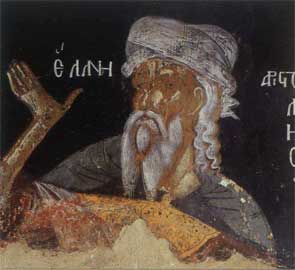 Ο Αριστοτέλης. Νησί Ιωαννίνων, Μονή Φιλανθρωπηνών (καθολικό), τοιχογραφία, 1560.
Όπως είδαμε στο προηγούμενο τεύχος της Aρχαιολογίας, μια μικρή μερίδα φιλοσόφων, όπως ο Πυθαγόρας και ο Πλάτων, καταδίκαζαν απερίφραστα την αυτοκτονία, χωρίς όμως να εξισώσουν την πράξη αυτή με φόνο. Tον 1ο αιώνα μ.X. ήταν ακόμη συνηθισμένο να συζητιέται σε φιλοσοφικές και ρητορικές σχολές το θέμα αν η αυτοκτονία ήταν και ανθρωποκτονία ή όχι. Mε την επικράτηση του Xριστιανισμού όμως, χάρη κυρίως στον Άγιο Aυγουστίνο και τον Tιμόθεο, Πατριάρχη Aλεξανδρείας, η αυτοκτονία ορίστηκε ως φονική πράξη και άρα καταδικαστέα. Στο δεύτερο τεύχος του αφιερώματος στους Αυτόχειρες, εξετάζεται η αυτοκτονία στη βυζαντινή περίοδο.
Ο Αριστοτέλης. Νησί Ιωαννίνων, Μονή Φιλανθρωπηνών (καθολικό), τοιχογραφία, 1560.
Όπως είδαμε στο προηγούμενο τεύχος της Aρχαιολογίας, μια μικρή μερίδα φιλοσόφων, όπως ο Πυθαγόρας και ο Πλάτων, καταδίκαζαν απερίφραστα την αυτοκτονία, χωρίς όμως να εξισώσουν την πράξη αυτή με φόνο. Tον 1ο αιώνα μ.X. ήταν ακόμη συνηθισμένο να συζητιέται σε φιλοσοφικές και ρητορικές σχολές το θέμα αν η αυτοκτονία ήταν και ανθρωποκτονία ή όχι. Mε την επικράτηση του Xριστιανισμού όμως, χάρη κυρίως στον Άγιο Aυγουστίνο και τον Tιμόθεο, Πατριάρχη Aλεξανδρείας, η αυτοκτονία ορίστηκε ως φονική πράξη και άρα καταδικαστέα. Στο δεύτερο τεύχος του αφιερώματος στους Αυτόχειρες, εξετάζεται η αυτοκτονία στη βυζαντινή περίοδο.
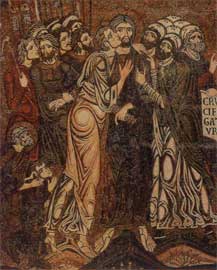 Ο Ιούδας προδίδει τον Χριστό. Ψηφιδωτό, 1180-1190, Βενετία, Άγιος Μάρκος (ναός).
Η Εκκλησία ενωρίτερα αντιμετώπισε την αυτοκτονία ως μείζον αμάρτημα και ως εκκλησιαστικό – «κανονικό» αδίκημα. Νωρίς επίσης, και στη χριστιανική Ανατολή και στη Δύση, καθιερώνεται ως η κατ’ εξοχήν ποινή για το αδίκημα αυτό η απαγόρευση της εκκλησιαστικής κήδευσης και ταφής, καθώς και της προσφοράς ευχών, και κυρίως της Ευχαριστίας υπέρ των αυτοχείρων. Η «ποινή» αυτή εισάγεται από την εκκλησιαστική πρακτική, και εν συνεχεία επισημοποιείται από κανονικό δίκαιο τόσο της Ανατολικής (κανόνας 14 Τιμοθέου Αλεξανδρείας) όσο και της Δυτικής Εκκλησίας. Ως δικαιολογητική βάση της ποινής αυτής, η οποία εν τούτοις, τουλάχιστον στο δίκαιο της Ανατολικής Εκκλησίας, δεν προβλέπεται για άλλα, πολύ σοβαρά, εκκλησιαστικά αδικήματα, προβάλλεται ότι ειδικά με την πράξη αυτή ο δράστης αμφισβητεί τον ίδιο τον Δημιουργό του, ως μόνον κύριο της ζωής και του θανάτου του – ή, άλλως, ότι στην περίπτωση αυτή η δυνατότης μετανοίας του δράστη εκ των πραγμάτων φαίνεται να αποκλείεται, αφού το αδίκημά του υλοποιείται με το ίδιο το γεγονός του θανάτου του. Το παράδειγμα του Ιούδα συχνά μνημονεύεται. Στην πραγματικότητα η σκληρή αυτή αντιμετώπιση αποβλέπει στο να εμπεδωθεί στην κοινή συνείδηση η εκκλησιαστική απαξία της πράξης αυτής, απαξία η οποία δεν είναι καθόλου δεδομένη στη γενική αντίληψη, αφού η πράξη δεν στρέφεται σε βάρος άλλου. Γίνεται, εν τούτοις, δεκτό ότι η στέρηση της χρήσης του λογικού από τον δράστη, αν αποδειχθεί, τον απαλλάσσει από τη μεταθανάτια αυτή ποινή. Έτσι, από την αρχαία Εκκλησία ως τις ημέρες μας, εισάγεται μία μακρά πρακτική όπου οι οικείοι του νεκρού επιδιώκουν, με επίκληση αληθών ή, το συνηθέστερο, ψευδών μαρτυριών και γνωματεύσεων, και με τη γενική «συνενοχή» ή συγκατάβαση, να επιτύχουν την εκκλησιαστική κήδευση. H κοινωνική ευαισθησία στις ημέρες μας επέβαλε τη, ρητή ή σιωπηρή, εγκατάλειψη της απαγόρευσης (έτσι και στους νέους κώδικες κανονικού δικαίου της Pωμαιοκαθολικής Eκκλησίας). Mε πολλούς δισταγμούς αυτή είναι και η πρακτική που τείνει να ακολουθεί τώρα και η Iερά Σύνοδος της Eκκλησίας της Eλλάδος.
Ο Ιούδας προδίδει τον Χριστό. Ψηφιδωτό, 1180-1190, Βενετία, Άγιος Μάρκος (ναός).
Η Εκκλησία ενωρίτερα αντιμετώπισε την αυτοκτονία ως μείζον αμάρτημα και ως εκκλησιαστικό – «κανονικό» αδίκημα. Νωρίς επίσης, και στη χριστιανική Ανατολή και στη Δύση, καθιερώνεται ως η κατ’ εξοχήν ποινή για το αδίκημα αυτό η απαγόρευση της εκκλησιαστικής κήδευσης και ταφής, καθώς και της προσφοράς ευχών, και κυρίως της Ευχαριστίας υπέρ των αυτοχείρων. Η «ποινή» αυτή εισάγεται από την εκκλησιαστική πρακτική, και εν συνεχεία επισημοποιείται από κανονικό δίκαιο τόσο της Ανατολικής (κανόνας 14 Τιμοθέου Αλεξανδρείας) όσο και της Δυτικής Εκκλησίας. Ως δικαιολογητική βάση της ποινής αυτής, η οποία εν τούτοις, τουλάχιστον στο δίκαιο της Ανατολικής Εκκλησίας, δεν προβλέπεται για άλλα, πολύ σοβαρά, εκκλησιαστικά αδικήματα, προβάλλεται ότι ειδικά με την πράξη αυτή ο δράστης αμφισβητεί τον ίδιο τον Δημιουργό του, ως μόνον κύριο της ζωής και του θανάτου του – ή, άλλως, ότι στην περίπτωση αυτή η δυνατότης μετανοίας του δράστη εκ των πραγμάτων φαίνεται να αποκλείεται, αφού το αδίκημά του υλοποιείται με το ίδιο το γεγονός του θανάτου του. Το παράδειγμα του Ιούδα συχνά μνημονεύεται. Στην πραγματικότητα η σκληρή αυτή αντιμετώπιση αποβλέπει στο να εμπεδωθεί στην κοινή συνείδηση η εκκλησιαστική απαξία της πράξης αυτής, απαξία η οποία δεν είναι καθόλου δεδομένη στη γενική αντίληψη, αφού η πράξη δεν στρέφεται σε βάρος άλλου. Γίνεται, εν τούτοις, δεκτό ότι η στέρηση της χρήσης του λογικού από τον δράστη, αν αποδειχθεί, τον απαλλάσσει από τη μεταθανάτια αυτή ποινή. Έτσι, από την αρχαία Εκκλησία ως τις ημέρες μας, εισάγεται μία μακρά πρακτική όπου οι οικείοι του νεκρού επιδιώκουν, με επίκληση αληθών ή, το συνηθέστερο, ψευδών μαρτυριών και γνωματεύσεων, και με τη γενική «συνενοχή» ή συγκατάβαση, να επιτύχουν την εκκλησιαστική κήδευση. H κοινωνική ευαισθησία στις ημέρες μας επέβαλε τη, ρητή ή σιωπηρή, εγκατάλειψη της απαγόρευσης (έτσι και στους νέους κώδικες κανονικού δικαίου της Pωμαιοκαθολικής Eκκλησίας). Mε πολλούς δισταγμούς αυτή είναι και η πρακτική που τείνει να ακολουθεί τώρα και η Iερά Σύνοδος της Eκκλησίας της Eλλάδος.
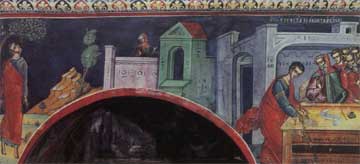 Η σκηνή του Απαγχονισμού. Άγιον Όρος, Μονή Διονυσίου.
Η αποτρόπαιη πράξη του Ιούδα απαντά σπάνια μεν στην τέχνη της βυζαντινής περιόδου, συχνά δε στη μεταβυζαντινή ζωγραφική.
Στη ζωγραφική της μεταβυζαντινής περιόδου το θέμα εντάσσεται στον εικονογραφικό κύκλο των Παθών και απεικονίζεται μαζί με την παράσταση της Μεταμέλειας και επιστροφής των τριάκοντα αργυρίων.
Στην εικονιστική απόδοση του θέματος του Απαγχονισμού του Ιούδα, στη ζωγραφική της περιόδου αυτής, ο Ισκαριώτης εικονίζεται κρεμασμένος σε δένδρο που λυγίζει από το βάρος του σώματος και από κάτω εικονίζεται σπηλιά μέσα στην οποία τοποθετείται πληγιασμένη και τυμπανισμένη μορφή, ο ίδιος ο αυτόχειρας. Είναι ενδιαφέρον ότι την περίοδο αυτή διακρίνονται δύο παραλλαγές που σχετίζονται με δύο διαδοχικές χρονικές φάσεις του γεγονότος.
Στην πρώτη παραλλαγή ο Ιούδας αποδίδεται με έντονη κίνηση να αντιδρά στην πράξη του, τινάζει πόδια, στρέφει το κεφάλι προς τα πίσω και φέρνει τα χέρια στο λαιμό, θέλοντας να αποφύγει τον πνιγμό. Η παραλλαγή αυτή απαντά στα μνημεία της λεγόμενης «σχολής της Αχρίδας», με χαλαρότητα στα μνημεία του «καστοριανού εργαστηρίου» και στα μνημεία της ΒΔ Ελλάδας.
Στη δεύτερη παραλλαγή ο Ισκαριώτης εικονίζεται να έχει παραδώσει το πνεύμα του, και το σώμα του είναι ακίνητο και ευθυτενές. Οι αφετηρίες της παραλλαγής αυτής εντοπίζονται σε μνημεία της ύστερης βυζαντινής περιόδου. Υιοθετείται από τους κρητικούς ζωγράφους του 16ου αιώνα στις εργασίες τους στο Άγιον Όρος, καθώς και σε μνημεία του 17ου και 18ου αιώνα.
Η σκηνή του Απαγχονισμού. Άγιον Όρος, Μονή Διονυσίου.
Η αποτρόπαιη πράξη του Ιούδα απαντά σπάνια μεν στην τέχνη της βυζαντινής περιόδου, συχνά δε στη μεταβυζαντινή ζωγραφική.
Στη ζωγραφική της μεταβυζαντινής περιόδου το θέμα εντάσσεται στον εικονογραφικό κύκλο των Παθών και απεικονίζεται μαζί με την παράσταση της Μεταμέλειας και επιστροφής των τριάκοντα αργυρίων.
Στην εικονιστική απόδοση του θέματος του Απαγχονισμού του Ιούδα, στη ζωγραφική της περιόδου αυτής, ο Ισκαριώτης εικονίζεται κρεμασμένος σε δένδρο που λυγίζει από το βάρος του σώματος και από κάτω εικονίζεται σπηλιά μέσα στην οποία τοποθετείται πληγιασμένη και τυμπανισμένη μορφή, ο ίδιος ο αυτόχειρας. Είναι ενδιαφέρον ότι την περίοδο αυτή διακρίνονται δύο παραλλαγές που σχετίζονται με δύο διαδοχικές χρονικές φάσεις του γεγονότος.
Στην πρώτη παραλλαγή ο Ιούδας αποδίδεται με έντονη κίνηση να αντιδρά στην πράξη του, τινάζει πόδια, στρέφει το κεφάλι προς τα πίσω και φέρνει τα χέρια στο λαιμό, θέλοντας να αποφύγει τον πνιγμό. Η παραλλαγή αυτή απαντά στα μνημεία της λεγόμενης «σχολής της Αχρίδας», με χαλαρότητα στα μνημεία του «καστοριανού εργαστηρίου» και στα μνημεία της ΒΔ Ελλάδας.
Στη δεύτερη παραλλαγή ο Ισκαριώτης εικονίζεται να έχει παραδώσει το πνεύμα του, και το σώμα του είναι ακίνητο και ευθυτενές. Οι αφετηρίες της παραλλαγής αυτής εντοπίζονται σε μνημεία της ύστερης βυζαντινής περιόδου. Υιοθετείται από τους κρητικούς ζωγράφους του 16ου αιώνα στις εργασίες τους στο Άγιον Όρος, καθώς και σε μνημεία του 17ου και 18ου αιώνα.
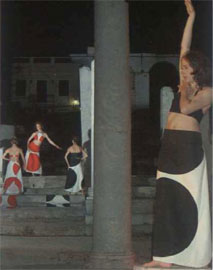 Η πρόταση της ελληνικής "Ομάδας Όραμα" με το φωτισμό από νέον αποτύπωσε μια νεωτερική θεώρηση της αισθητικής του ερειπίου.
Η θεατρική παράσταση Mindscape στη ρωμαϊκή αγορά ήταν μια δράση της Καλλιτεχνικής Σκηνής της Κεντρικής Ευρώπης (Platform Culture Central Europe) που φιλοξενήθηκε από την Ελληνική Προεδρία της Ευρωπαϊκής Ένωσης. Η βασική ιδέα ήταν να αποκατασταθεί η λειτουργική ταυτότητα της αγοράς ως τόπου συνάθροισης των πολιτών και ανταλλαγής αγαθών και ιδεών. Πηγή έμπνευσης το έργο του φημισμένου Πολωνού σκηνοθέτη Jerzy Grotowski και τα «έργα-γεγονότα» και θεματική τις «Βιογραφίες». Έτσι η ρωμαϊκή αγορά μέσα από τη θεατρική σύμβαση κατέστη μια εφήμερη αγορά θεάτρου. Τα εμπορεύματα που διακινήθηκαν δεν ήταν υλικά αλλά πνευματικά αναπτύγματα. Οι πολίτες που προσήλθαν αποκόμισαν ένα διαφορετικό αρχαιολογικό περίπατο. Το διακύβευμα της θεατρικής πράξης ήταν αφενός στο επίπεδο της αισθητικής πρόσληψης του μνημείου και αφετέρου στη λειτουργική χρήση του χώρου. Οι κίονες, η στοά, ο αναλημματικός τοίχος της αγοράς απέκτησαν ένα διαφορετικό, σχεδόν οντολογικό περιεχόμενο. Θα μπορούσαμε έτσι να μιλήσουμε για μια ανατρεπτική ερμηνεία- διαχείριση της αρχαιολογικής κληρονομιάς.
Η πρόταση της ελληνικής "Ομάδας Όραμα" με το φωτισμό από νέον αποτύπωσε μια νεωτερική θεώρηση της αισθητικής του ερειπίου.
Η θεατρική παράσταση Mindscape στη ρωμαϊκή αγορά ήταν μια δράση της Καλλιτεχνικής Σκηνής της Κεντρικής Ευρώπης (Platform Culture Central Europe) που φιλοξενήθηκε από την Ελληνική Προεδρία της Ευρωπαϊκής Ένωσης. Η βασική ιδέα ήταν να αποκατασταθεί η λειτουργική ταυτότητα της αγοράς ως τόπου συνάθροισης των πολιτών και ανταλλαγής αγαθών και ιδεών. Πηγή έμπνευσης το έργο του φημισμένου Πολωνού σκηνοθέτη Jerzy Grotowski και τα «έργα-γεγονότα» και θεματική τις «Βιογραφίες». Έτσι η ρωμαϊκή αγορά μέσα από τη θεατρική σύμβαση κατέστη μια εφήμερη αγορά θεάτρου. Τα εμπορεύματα που διακινήθηκαν δεν ήταν υλικά αλλά πνευματικά αναπτύγματα. Οι πολίτες που προσήλθαν αποκόμισαν ένα διαφορετικό αρχαιολογικό περίπατο. Το διακύβευμα της θεατρικής πράξης ήταν αφενός στο επίπεδο της αισθητικής πρόσληψης του μνημείου και αφετέρου στη λειτουργική χρήση του χώρου. Οι κίονες, η στοά, ο αναλημματικός τοίχος της αγοράς απέκτησαν ένα διαφορετικό, σχεδόν οντολογικό περιεχόμενο. Θα μπορούσαμε έτσι να μιλήσουμε για μια ανατρεπτική ερμηνεία- διαχείριση της αρχαιολογικής κληρονομιάς.
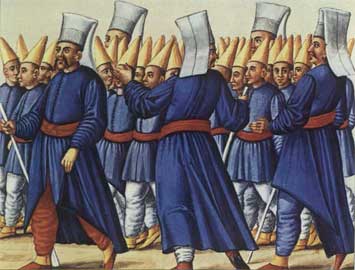 Βίαιη στρατολόγηση νεαρών χριστιανών. Βιέννη, Εθνική Βιβλιοθήκη.
Η λέξη γενίτσαρος ή γενίτσαροι είναι μία έννοια που, ουσιαστικά, δηλώνει ένα ξεκάθαρο ιδεολογικό και θρησκευτικό προφίλ ανθρώπου. Οι γενί-τσερί, νέοι στρατιώτες, είναι οι στρατιώτες υπεράσπισης της εξουσίας κυρίως θρησκευτικής.
Κατά την εγκυκλοπαίδεια Encarta οι janissary είναι τούρκοι (sic) στρατιώτες που αποτελούσαν την προσωπική φρουρά του σουλτάνου από τον 14ον έως το 1826. Οι Janissaries προήρχοντο κυρίως από τους χριστιανούς των Βαλκανίων.
Ακόμη είναι οι φανατικοί, οι αφοσιωμένοι οπαδοί και οι υποστηρικτές που αναφέρεται και σε μία άλλη (θρησκευτική) άποψη όπου γενίτσαρος (janizary) είναι ο οπαδός ή ο υποστηρικτής σύμφωνα με το Forthright’s Phrontistery.
Aκόμη, σύμφωνα με το Λεξικό της Οξφόρδης, οι γενίτσαροι αποτελούν την προσωπική φρουρά του σουλτάνου καθώς και μέρος του τακτικού στρατού. Το σώμα των γενιτσάρων οργανώθηκε τον 14ον αιώνα και είχε δυναμική μέχρι και τον 16ον αιώνα μέσα από το παιδομάζωμα των χριστιανών, ενώ στην συνέχεια από τους μουσουλμάνους της οθωμανικής αυτοκρατορίας. Διαλύθηκε το 1826 από τον τακτικό στρατό.
Βίαιη στρατολόγηση νεαρών χριστιανών. Βιέννη, Εθνική Βιβλιοθήκη.
Η λέξη γενίτσαρος ή γενίτσαροι είναι μία έννοια που, ουσιαστικά, δηλώνει ένα ξεκάθαρο ιδεολογικό και θρησκευτικό προφίλ ανθρώπου. Οι γενί-τσερί, νέοι στρατιώτες, είναι οι στρατιώτες υπεράσπισης της εξουσίας κυρίως θρησκευτικής.
Κατά την εγκυκλοπαίδεια Encarta οι janissary είναι τούρκοι (sic) στρατιώτες που αποτελούσαν την προσωπική φρουρά του σουλτάνου από τον 14ον έως το 1826. Οι Janissaries προήρχοντο κυρίως από τους χριστιανούς των Βαλκανίων.
Ακόμη είναι οι φανατικοί, οι αφοσιωμένοι οπαδοί και οι υποστηρικτές που αναφέρεται και σε μία άλλη (θρησκευτική) άποψη όπου γενίτσαρος (janizary) είναι ο οπαδός ή ο υποστηρικτής σύμφωνα με το Forthright’s Phrontistery.
Aκόμη, σύμφωνα με το Λεξικό της Οξφόρδης, οι γενίτσαροι αποτελούν την προσωπική φρουρά του σουλτάνου καθώς και μέρος του τακτικού στρατού. Το σώμα των γενιτσάρων οργανώθηκε τον 14ον αιώνα και είχε δυναμική μέχρι και τον 16ον αιώνα μέσα από το παιδομάζωμα των χριστιανών, ενώ στην συνέχεια από τους μουσουλμάνους της οθωμανικής αυτοκρατορίας. Διαλύθηκε το 1826 από τον τακτικό στρατό.
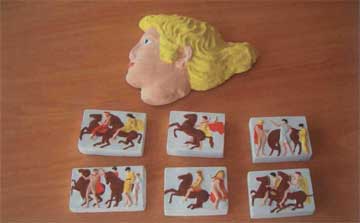 Ίριδα, κομμάτια της ζωφόρου από γύψο και χρωματισμένα από τους μαθητές της Α' τάξης του 6ου Ενιαίου Λυκείου Καλαμάτας.
Το άρθρο που ακολουθεί παρουσιάζει μια προσπάθεια διαθεματικής προσέγγισης που διενεργήθηκε στο 6o Ενιαίο Λύκειο Καλαμάτας, με την πρωτοβουλία δυο Σχολικών Βιβλιοθηκών, σε συνεργασία με την εκπαιδευτική κοινότητα των συγκεκριμένων σχολικών μονάδων.
Καθώς η εκπαιδευτική πράξη ανανεώνεται, αναζητεί νέους τρόπους προσέγγισης της γνώσης, ελκυστικούς για τους μαθητές, κύρια όμως δημιουργικούς κι ενισχυτικούς της πρωτοβουλίας τους, με στόχο την ενεργητική συμμετοχή και την ουσιαστική μάθηση στους κόλπους μιας πολυπολιτισμικής σχολικής τάξης.
Έτσι με άξονα το μάθημα της ιστορίας στην Α΄ τάξη του Ενιαίου Λυκείου επιχειρήθηκε διαθεματική διάχυση στη Λογοτεχνία, την Πληροφορική και την Αισθητική Αγωγή. Στόχος ήταν να ευαισθητοποιηθούν οι μαθητές σε θέματα Ιστορίας και Τέχνης, ώστε το μουσείο, ως ο κατεξοχήν χώρος αποτύπωσης αυτών να αποτελέσει πόλο έλξης των νεαρών εφήβων. Σημαντικό ρόλο άσκησαν σε αυτό τα εκπαιδευτικά προγράμματα: «Πάμε στην Ακρόπολη» και «Η ζωφόρος του Παρθενώνα» του Μουσείου Ακρόπολης.
Συγκεκριμένα οι μαθητές έχοντας διδαχτεί το κεφαλαίο Τέχνη, Κλασική περίοδος, σελ.111-120 του σχολικού βιβλίου, επιχείρησαν στο χώρο της σχολικής βιβλιοθήκης, μέσα από την παρακολούθηση βιντεοκασέτας, την ακρόαση μουσικής, την περιήγηση στο διαδικτυο να συνθέσουν ποιήματα, να συγγράψουν ιστορίες, να αφηγηθούν παραμύθια, να ζωγραφίσουν, να δημιουργήσουν με γύψο την Ίριδα και κομμάτια της ζωφόρου και στη συνέχεια να τα χρωματίσουν, ώστε να ανασυνθέσουν και να μυηθούν στην πολιτιστική παραγωγή της κλασικής περιόδου.
Ίριδα, κομμάτια της ζωφόρου από γύψο και χρωματισμένα από τους μαθητές της Α' τάξης του 6ου Ενιαίου Λυκείου Καλαμάτας.
Το άρθρο που ακολουθεί παρουσιάζει μια προσπάθεια διαθεματικής προσέγγισης που διενεργήθηκε στο 6o Ενιαίο Λύκειο Καλαμάτας, με την πρωτοβουλία δυο Σχολικών Βιβλιοθηκών, σε συνεργασία με την εκπαιδευτική κοινότητα των συγκεκριμένων σχολικών μονάδων.
Καθώς η εκπαιδευτική πράξη ανανεώνεται, αναζητεί νέους τρόπους προσέγγισης της γνώσης, ελκυστικούς για τους μαθητές, κύρια όμως δημιουργικούς κι ενισχυτικούς της πρωτοβουλίας τους, με στόχο την ενεργητική συμμετοχή και την ουσιαστική μάθηση στους κόλπους μιας πολυπολιτισμικής σχολικής τάξης.
Έτσι με άξονα το μάθημα της ιστορίας στην Α΄ τάξη του Ενιαίου Λυκείου επιχειρήθηκε διαθεματική διάχυση στη Λογοτεχνία, την Πληροφορική και την Αισθητική Αγωγή. Στόχος ήταν να ευαισθητοποιηθούν οι μαθητές σε θέματα Ιστορίας και Τέχνης, ώστε το μουσείο, ως ο κατεξοχήν χώρος αποτύπωσης αυτών να αποτελέσει πόλο έλξης των νεαρών εφήβων. Σημαντικό ρόλο άσκησαν σε αυτό τα εκπαιδευτικά προγράμματα: «Πάμε στην Ακρόπολη» και «Η ζωφόρος του Παρθενώνα» του Μουσείου Ακρόπολης.
Συγκεκριμένα οι μαθητές έχοντας διδαχτεί το κεφαλαίο Τέχνη, Κλασική περίοδος, σελ.111-120 του σχολικού βιβλίου, επιχείρησαν στο χώρο της σχολικής βιβλιοθήκης, μέσα από την παρακολούθηση βιντεοκασέτας, την ακρόαση μουσικής, την περιήγηση στο διαδικτυο να συνθέσουν ποιήματα, να συγγράψουν ιστορίες, να αφηγηθούν παραμύθια, να ζωγραφίσουν, να δημιουργήσουν με γύψο την Ίριδα και κομμάτια της ζωφόρου και στη συνέχεια να τα χρωματίσουν, ώστε να ανασυνθέσουν και να μυηθούν στην πολιτιστική παραγωγή της κλασικής περιόδου.
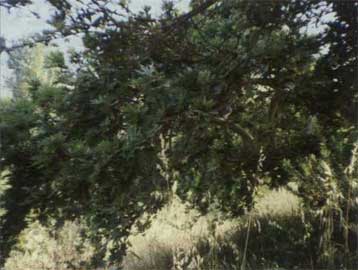 Πλατάνια (κοίτη Ιλισού, Αγ. Φωτεινή).
Μια μελέτη για την αυτοφυή χλωρίδα των παριλίσιων πεδίων από τα κλασικά χρόνια έως τα μέσα του 20ού αιώνα, που έγινε από τη Διεύθυνση Μελετών Μουσείων του Υπουργείου Πολιτισμού, με σκοπό την ανάπλαση και ανάδειξη του περιβάλλοντος χώρου του Βυζαντινού και Χριστιανικού Μουσείου Αθηνών, με δένδρα και άνθη που συνάδουν με τις κλιματολογικές συνθήκες, τη μορφολογία εδάφους και την ιστορική μνήμη της συγκεκριμένης περιοχής, η οποία περικλείεται από τις οδούς Βασ. Κωνσταντίνου – Αρδηττού – Λεωφ. Αμαλίας και Βασ. Σοφίας.
Η παρουσία των περισσότερων φυτών και δένδρων στο χώρο πιστοποιείται από φιλολογικές μαρτυρίες, περιγραφές περιηγητών, ατθιδογράφων. Άλλων, όμως, συμπεραίνεται, όπως της δάφνης, της μυρτιάς, αναγάγοντάς τες σε μυθικές αναφορές και συμβολισμούς.
Στο τέλος, παρατίθεται ένας συγκεντρωτικός κατάλογος δένδρων και ανθέων, τα οποία αναφέρονται στο κείμενο της μελέτης αυτής, αλλά και συμπληρωματικός κατάλογος που αφορά στη χλωρίδα του Εθνικού Κήπου και εκείνης του έργου του Θεοφράστου Περί φυτών ιστορίας, για να αποδειχθεί η συνέχεια της ελληνικής χλωρίδας από την κλασική εποχή έως και το δεύτερο τέταρτο του εικοστού αιώνα και εικάζεται ότι αυτά τα δέντρα και άνθη που αναφέρονται στο Περί φυτών ιστορίαςευδοκίμησαν στον κήπο του Θεοφράστου και αποτέλεσαν το έναυσμα της παρατήρησης και της μελέτης του αρχαίου φιλοσόφου, ο οποίος δικαίως θεωρείται πατέρας της βοτανικής.
Πλατάνια (κοίτη Ιλισού, Αγ. Φωτεινή).
Μια μελέτη για την αυτοφυή χλωρίδα των παριλίσιων πεδίων από τα κλασικά χρόνια έως τα μέσα του 20ού αιώνα, που έγινε από τη Διεύθυνση Μελετών Μουσείων του Υπουργείου Πολιτισμού, με σκοπό την ανάπλαση και ανάδειξη του περιβάλλοντος χώρου του Βυζαντινού και Χριστιανικού Μουσείου Αθηνών, με δένδρα και άνθη που συνάδουν με τις κλιματολογικές συνθήκες, τη μορφολογία εδάφους και την ιστορική μνήμη της συγκεκριμένης περιοχής, η οποία περικλείεται από τις οδούς Βασ. Κωνσταντίνου – Αρδηττού – Λεωφ. Αμαλίας και Βασ. Σοφίας.
Η παρουσία των περισσότερων φυτών και δένδρων στο χώρο πιστοποιείται από φιλολογικές μαρτυρίες, περιγραφές περιηγητών, ατθιδογράφων. Άλλων, όμως, συμπεραίνεται, όπως της δάφνης, της μυρτιάς, αναγάγοντάς τες σε μυθικές αναφορές και συμβολισμούς.
Στο τέλος, παρατίθεται ένας συγκεντρωτικός κατάλογος δένδρων και ανθέων, τα οποία αναφέρονται στο κείμενο της μελέτης αυτής, αλλά και συμπληρωματικός κατάλογος που αφορά στη χλωρίδα του Εθνικού Κήπου και εκείνης του έργου του Θεοφράστου Περί φυτών ιστορίας, για να αποδειχθεί η συνέχεια της ελληνικής χλωρίδας από την κλασική εποχή έως και το δεύτερο τέταρτο του εικοστού αιώνα και εικάζεται ότι αυτά τα δέντρα και άνθη που αναφέρονται στο Περί φυτών ιστορίαςευδοκίμησαν στον κήπο του Θεοφράστου και αποτέλεσαν το έναυσμα της παρατήρησης και της μελέτης του αρχαίου φιλοσόφου, ο οποίος δικαίως θεωρείται πατέρας της βοτανικής.
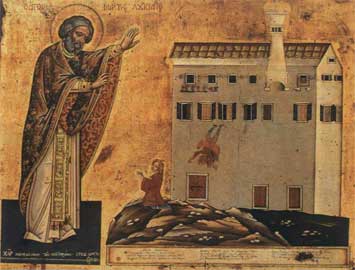 Θαύμα του αγίου Λουκιανού, Κωνσταντίνος Κονταρίνης, 1708. Κέρκυρα, Ναός Θεοτόκου Σπηλαιώτισσας.
Το άρθρο αυτό πραγματεύεται την αλλοίωση του είδους της λατρευτικής εικόνας, που συντελείται στα Επτάνησα, κατά το δεύτερο μισό του 17ου και καθ’ όλη τη διάρκεια του 18ου αιώνα. Η αύξηση των αναθηματικών εικόνων, η έμφαση στο αφηγηματικό στοιχείο και στη δραματικότητα, ο διδακτικός χαρακτήρας, καθώς και ο εμπλουτισμός της θεματολογίας από τη λατρευτική πρακτική μετουσιώνουν το λατρευτικό περιεχόμενο της εικόνας. Οι απαρχές της εξέλιξης αυτής θα πρέπει να αναζητηθούν στη μετανάστευση των ζωγράφων της Κρητικής Σχολής στο χώρο των Ιονίων νήσων κατά τη διάρκεια του Κρητικού πολέμου και μετά την πτώση του Χάνδακα. Η μεταβυζαντινή ζωγραφική των Επτανήσων απομακρύνεται σταδιακά από τα μορφολογικά και ιδεολογικά χαρακτηριστικά της παραδοσιακής εικόνας, καθιστώντας το είδος αυτό παρωχημένο και προφανώς ασύμβατο με τη θρησκευτικότητα μιας κοινωνίας εν εξελίξει. Έτσι, στα Ιόνια νησιά η επερχόμενη Επτανησιακή Σχολή θα αφήσει πίσω της και τα τελευταία κατάλοιπα της βυζαντινής παράδοσης υιοθετώντας τρόπους ζωγραφικής που στηρίζονται εξ ολοκλήρου σε δυτικά πρότυπα.
Θαύμα του αγίου Λουκιανού, Κωνσταντίνος Κονταρίνης, 1708. Κέρκυρα, Ναός Θεοτόκου Σπηλαιώτισσας.
Το άρθρο αυτό πραγματεύεται την αλλοίωση του είδους της λατρευτικής εικόνας, που συντελείται στα Επτάνησα, κατά το δεύτερο μισό του 17ου και καθ’ όλη τη διάρκεια του 18ου αιώνα. Η αύξηση των αναθηματικών εικόνων, η έμφαση στο αφηγηματικό στοιχείο και στη δραματικότητα, ο διδακτικός χαρακτήρας, καθώς και ο εμπλουτισμός της θεματολογίας από τη λατρευτική πρακτική μετουσιώνουν το λατρευτικό περιεχόμενο της εικόνας. Οι απαρχές της εξέλιξης αυτής θα πρέπει να αναζητηθούν στη μετανάστευση των ζωγράφων της Κρητικής Σχολής στο χώρο των Ιονίων νήσων κατά τη διάρκεια του Κρητικού πολέμου και μετά την πτώση του Χάνδακα. Η μεταβυζαντινή ζωγραφική των Επτανήσων απομακρύνεται σταδιακά από τα μορφολογικά και ιδεολογικά χαρακτηριστικά της παραδοσιακής εικόνας, καθιστώντας το είδος αυτό παρωχημένο και προφανώς ασύμβατο με τη θρησκευτικότητα μιας κοινωνίας εν εξελίξει. Έτσι, στα Ιόνια νησιά η επερχόμενη Επτανησιακή Σχολή θα αφήσει πίσω της και τα τελευταία κατάλοιπα της βυζαντινής παράδοσης υιοθετώντας τρόπους ζωγραφικής που στηρίζονται εξ ολοκλήρου σε δυτικά πρότυπα.
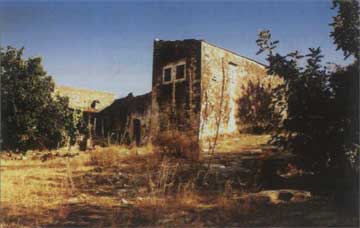 Δαμάβολος.
Τα παραδοσιακά σύνολα που διατηρούνται στην ορεινή περιοχή του Ρεθύμνου παρουσιάζουν μια αξιοθαύμαστη, διαχρονική αρχιτεκτονική, της οποίας η προέλευση είναι αδύνατον να ερμηνευθεί με τον καθιερωμένο τρόπο σκέψης. Στην παρούσα προσπάθεια επιδιώκουμε να διανοίξουμε έναν κόσμο απρόσιτο στο μύθο, στο λόγο και στην επιστήμη, στον οποίο επικρατεί το συναίσθημα ως καθαρό στοιχείο του εαυτού μας. Το τοπίο, αποτελώντας καθοριστικό παράγοντα του συναισθήματος, είναι σε θέση διαμέσου της φαινομενολογικής σκέψης να συμβάλει στην κατανόηση των αρχιτεκτονικών μορφών αλλά και στην καθοδήγηση οποιασδήποτε επέμβασης του ανθρώπου στο περιβάλλον του.
Δαμάβολος.
Τα παραδοσιακά σύνολα που διατηρούνται στην ορεινή περιοχή του Ρεθύμνου παρουσιάζουν μια αξιοθαύμαστη, διαχρονική αρχιτεκτονική, της οποίας η προέλευση είναι αδύνατον να ερμηνευθεί με τον καθιερωμένο τρόπο σκέψης. Στην παρούσα προσπάθεια επιδιώκουμε να διανοίξουμε έναν κόσμο απρόσιτο στο μύθο, στο λόγο και στην επιστήμη, στον οποίο επικρατεί το συναίσθημα ως καθαρό στοιχείο του εαυτού μας. Το τοπίο, αποτελώντας καθοριστικό παράγοντα του συναισθήματος, είναι σε θέση διαμέσου της φαινομενολογικής σκέψης να συμβάλει στην κατανόηση των αρχιτεκτονικών μορφών αλλά και στην καθοδήγηση οποιασδήποτε επέμβασης του ανθρώπου στο περιβάλλον του.
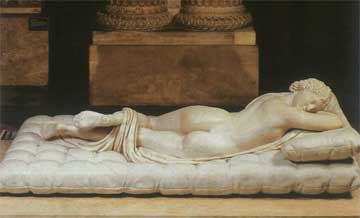 Κοιμώμενος Ερμαφρόδιτος, γνωστός ως "Ερμαφρόδιτος Borghese". Αντίγραφο έργου της ελληνιστικής εποχής. Παρίσι, Μουσείο Λούβρου.
Με τη φροϋδική θεωρία των ονείρων, η ψυχανάλυση διευρύνθηκε από ψυχοθεραπευτική μέθοδος σε μια ψυχολογία της ανθρώπινης φύσης. Ο Φρόυντ έδειξε ότι τα όνειρα έχουν ψυχολογική σημασία και νόημα και πως καθένα τους αντιπροσωπεύει την έκφραση μιας απόπειρας εκπλήρωσης επιθυμιών και πόθων.
Είκοσι πέντε αιώνες νωρίτερα, οι αρχαίοι Έλληνες, όπως ο Πλάτωνας, είχαν κατανοήσει πλήρως τον μηχανισμό των ονείρων.
Κοιμώμενος Ερμαφρόδιτος, γνωστός ως "Ερμαφρόδιτος Borghese". Αντίγραφο έργου της ελληνιστικής εποχής. Παρίσι, Μουσείο Λούβρου.
Με τη φροϋδική θεωρία των ονείρων, η ψυχανάλυση διευρύνθηκε από ψυχοθεραπευτική μέθοδος σε μια ψυχολογία της ανθρώπινης φύσης. Ο Φρόυντ έδειξε ότι τα όνειρα έχουν ψυχολογική σημασία και νόημα και πως καθένα τους αντιπροσωπεύει την έκφραση μιας απόπειρας εκπλήρωσης επιθυμιών και πόθων.
Είκοσι πέντε αιώνες νωρίτερα, οι αρχαίοι Έλληνες, όπως ο Πλάτωνας, είχαν κατανοήσει πλήρως τον μηχανισμό των ονείρων.
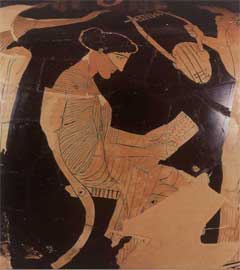 Απεικόνιση της Σαπφούς σε αττική ερυθρόμορφη υδρία (5ος αι. π.Χ.).
Θέμα του άρθρου είναι η μελέτη του τρόπου με τον οποίο η ποίηση της Σαπφούς μπορεί να χρησιμοποιηθεί ως πηγή κοινωνικής και πολιτικής ιστορίας: γνωρίζουμε ότι λυρικοί ποιητές εκτός από εκφραστές της ατομικότητας, ήταν και φορείς των πολιτικών ιδεωδών της αρχαϊκής εποχής.
Συνήθως η Σαπφώ, ως γυναίκα, θεωρούνταν ότι εξέφραζε μόνο συναισθήματα και την ατμόσφαιρα του οίκου: Όμως, τις δύο τελευταίες δεκαετίες η άποψη αυτή αναθεωρήθηκε με επιτυχία. Κάποιοι περιορισμοί στη θεματική ανάπτυξη οφείλονται στο ότι το άρθρο εντάχθηκε μέσα στο πλαίσιο ενός εκπαιδευτικού προγράμματος για την προώθηση της ισότητας των δύο φύλων στη μέση εκπαίδευση
Απεικόνιση της Σαπφούς σε αττική ερυθρόμορφη υδρία (5ος αι. π.Χ.).
Θέμα του άρθρου είναι η μελέτη του τρόπου με τον οποίο η ποίηση της Σαπφούς μπορεί να χρησιμοποιηθεί ως πηγή κοινωνικής και πολιτικής ιστορίας: γνωρίζουμε ότι λυρικοί ποιητές εκτός από εκφραστές της ατομικότητας, ήταν και φορείς των πολιτικών ιδεωδών της αρχαϊκής εποχής.
Συνήθως η Σαπφώ, ως γυναίκα, θεωρούνταν ότι εξέφραζε μόνο συναισθήματα και την ατμόσφαιρα του οίκου: Όμως, τις δύο τελευταίες δεκαετίες η άποψη αυτή αναθεωρήθηκε με επιτυχία. Κάποιοι περιορισμοί στη θεματική ανάπτυξη οφείλονται στο ότι το άρθρο εντάχθηκε μέσα στο πλαίσιο ενός εκπαιδευτικού προγράμματος για την προώθηση της ισότητας των δύο φύλων στη μέση εκπαίδευση
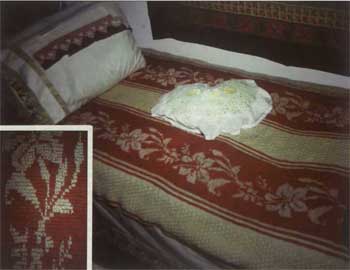 Χειροποίητη μάλλινη κουβέρτα με κόκκινες ίνες βαμμένες με ριζάρι. Λαογραφικό Ιστορικό Μουσείο Αμπελακίων Θεσσαλίας.
Tο ριζάρι [madder] θεωρείται από τις αρχαιότερες και σημαντικότερες φυσικές βαφές και έχει περιγραφεί από όλους τους αρχαίους συγγραφείς. Eίναι γνωστό από τα προϊστορικά χρόνια τόσο στη Mικρά Aσία όσο και στη μητροπολιτική Eλλάδα. Για την παρασκευή του χρησιμοποιούνταν οι ρίζες ενός θάμνου που περιείχαν περισσότερα από είκοσι βαφικά συστατικά, παρέχοντας πολλές αποχρώσεις του κόκκινου.
Στο παρόν άρθρο περιγράφεται η αρχαία και νεότερη τεχνολογία, ιδιαίτερα του τούρκικου κόκκινου, με έμφαση τις πολύπλοκες και με παραλλαγές διεργασίες πρόστυψης. Eρευνήθηκε η φυσικοχημεία της βαφής και έγινε προσπάθεια ανίχνευσης πρότυπων και άγνωστων δειγμάτων με χρήση φασματοσκοπίας ορατού-περιώδους, φθορισμομετρίας και χρωματογραφίας λεπτής στοιβάδας (TLC) [Thin-Layer Chromatography]. Διαπιστώθηκε ότι για την πλήρη ταυτοποίηση της βαφής από ιστορικά υφάσματα απαιτούνται διάφορες αναλυτικές χημικές μέθοδοι.
Χειροποίητη μάλλινη κουβέρτα με κόκκινες ίνες βαμμένες με ριζάρι. Λαογραφικό Ιστορικό Μουσείο Αμπελακίων Θεσσαλίας.
Tο ριζάρι [madder] θεωρείται από τις αρχαιότερες και σημαντικότερες φυσικές βαφές και έχει περιγραφεί από όλους τους αρχαίους συγγραφείς. Eίναι γνωστό από τα προϊστορικά χρόνια τόσο στη Mικρά Aσία όσο και στη μητροπολιτική Eλλάδα. Για την παρασκευή του χρησιμοποιούνταν οι ρίζες ενός θάμνου που περιείχαν περισσότερα από είκοσι βαφικά συστατικά, παρέχοντας πολλές αποχρώσεις του κόκκινου.
Στο παρόν άρθρο περιγράφεται η αρχαία και νεότερη τεχνολογία, ιδιαίτερα του τούρκικου κόκκινου, με έμφαση τις πολύπλοκες και με παραλλαγές διεργασίες πρόστυψης. Eρευνήθηκε η φυσικοχημεία της βαφής και έγινε προσπάθεια ανίχνευσης πρότυπων και άγνωστων δειγμάτων με χρήση φασματοσκοπίας ορατού-περιώδους, φθορισμομετρίας και χρωματογραφίας λεπτής στοιβάδας (TLC) [Thin-Layer Chromatography]. Διαπιστώθηκε ότι για την πλήρη ταυτοποίηση της βαφής από ιστορικά υφάσματα απαιτούνται διάφορες αναλυτικές χημικές μέθοδοι.
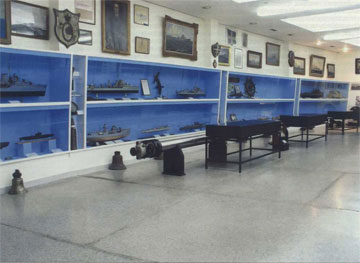 Η αίθουσα Ζ του Ναυτικού Μουσείου της Ελλάδος.
Το Ναυτικό Μουσείο της Ελλάδος είναι το μεγαλύτερο και σημαντικότερο Ναυτικό Μουσείο της χώρας μας, το οποίο με περισσότερα από 4.000 κειμήλια, έργα τέχνης, ιστορικά αντικείμενα, ναυτικά όργανα, διοράματα, αναπαραστάσεις, τμήματα και μοντέλα πλοίων, εκτιθέμενα χρονολογικά και θεματικά, παρουσιάζει το μεγάλο ναυτικό ταξίδι του θαλασσινού λαού μας και μας ταξιδεύει στις ελληνικές θάλασσες και στα μεγάλα ναυτικά επιτεύγματα του Έλληνα Ναυτικού επί του υγρού στοιχείου όλου του πλανήτη.
Η αίθουσα Ζ του Ναυτικού Μουσείου της Ελλάδος.
Το Ναυτικό Μουσείο της Ελλάδος είναι το μεγαλύτερο και σημαντικότερο Ναυτικό Μουσείο της χώρας μας, το οποίο με περισσότερα από 4.000 κειμήλια, έργα τέχνης, ιστορικά αντικείμενα, ναυτικά όργανα, διοράματα, αναπαραστάσεις, τμήματα και μοντέλα πλοίων, εκτιθέμενα χρονολογικά και θεματικά, παρουσιάζει το μεγάλο ναυτικό ταξίδι του θαλασσινού λαού μας και μας ταξιδεύει στις ελληνικές θάλασσες και στα μεγάλα ναυτικά επιτεύγματα του Έλληνα Ναυτικού επί του υγρού στοιχείου όλου του πλανήτη.
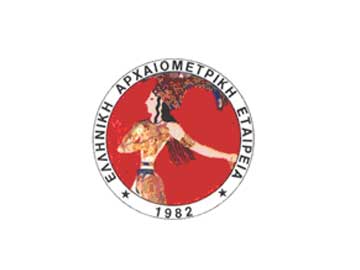 Το λογότυπο της Ελληνικής Αρχαιομετρικής Εταιρείας
Στα Αρχαιομετρικά Νέα αυτού του τεύχους μπορείτε να διαβάσετε:
-Το 36ο Διεθνές Συμπόσιο Αρχαιομετρίας (ISA 2006)
-Έκθεση κεραμικών της Μεσογείου
-Νέα βιβλία: U. Yalcin κ.ά., Das Schiff von Uluburun-Welthandel vor 3000 Jahren, Αδ. Σαμψών, Προϊστορία του Αιγαίου. Παλαιολιθική-Μεσολιθική-Νεολιθική
-Συντήρηση μετάλλων σε Εργαστήριο Πλάσματος
-Η επιστημονική συζήτηση για την ομηρική Ιθάκη
-...και για την προϊστορική ηφαιστειακή έκρηξη στη Θήρα
-Νέα περιφερειακά συνέδρια στα Μέθανα και στη Σίφνο
Το λογότυπο της Ελληνικής Αρχαιομετρικής Εταιρείας
Στα Αρχαιομετρικά Νέα αυτού του τεύχους μπορείτε να διαβάσετε:
-Το 36ο Διεθνές Συμπόσιο Αρχαιομετρίας (ISA 2006)
-Έκθεση κεραμικών της Μεσογείου
-Νέα βιβλία: U. Yalcin κ.ά., Das Schiff von Uluburun-Welthandel vor 3000 Jahren, Αδ. Σαμψών, Προϊστορία του Αιγαίου. Παλαιολιθική-Μεσολιθική-Νεολιθική
-Συντήρηση μετάλλων σε Εργαστήριο Πλάσματος
-Η επιστημονική συζήτηση για την ομηρική Ιθάκη
-...και για την προϊστορική ηφαιστειακή έκρηξη στη Θήρα
-Νέα περιφερειακά συνέδρια στα Μέθανα και στη Σίφνο
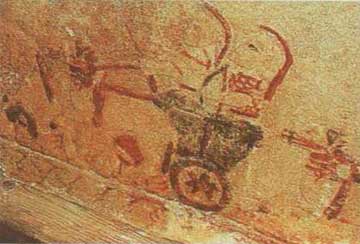 Η σαρκοφάγος που αποκαλύφθηκε σε περιοχή της Πάφου.
Ειδήσεις: Έρευνες στην Κέρο, Εντυπωσιακή σαρκοφάγος, Η έκρηξη του ηφαιστείου της Σαντορίνης, Ιθάκης ευρήματα, Τοιχογραφία με τελετή ενθρόνισης.
Εκθέσεις: Η μορφή της αρχής, Η Κρήτη ταξιδεύει, Χάλκινα νομίσματα, Αυλίδα – τόπος μύθου και ιστορίας, τόπος οχυρός, Κειμήλια Πρωτάτου, Άθως: Η μοναστηριακή ζωή στο Άγιον Όρος.
Συνέδρια: Αρχαιολογικά πάρκα, 1ο Συνέδριο Αναστηλώσεων, Επιγραφές και Ιστορία της Θεσσαλίας, Προσωπογραφίες πόλεων.
Διαλέξεις: Αντιμετώπιση της αρχαιοκαπηλίας, Μνημειακοί τάφοι κοντά στην Τροία, Αρχαιολογικές έρευνες στην Αλβανία, Αντιγονεία της Χαονίας.
Βιβλία: Λ. Μέσκελ: Η αρχαιολογία στο στόχαστρο, M. Lefkowitz: Θνητοί και Αθάνατοι, Ε. Λαδιά: Τα ψυχομαντεία και ο υποχθόνιος κόσμος των Ελλήνων, J. de Romilly: Από το φλάουτο στην απολλώνια λύρα, Μ. Φιλίππου: Οι αρχαίες μουσικές της Αιγύπτου.
Επιστολές: Η σύγχρονη ιστορία του Δίολκου. Ένα μνημείο ζητά δικαίωση.
Η σαρκοφάγος που αποκαλύφθηκε σε περιοχή της Πάφου.
Ειδήσεις: Έρευνες στην Κέρο, Εντυπωσιακή σαρκοφάγος, Η έκρηξη του ηφαιστείου της Σαντορίνης, Ιθάκης ευρήματα, Τοιχογραφία με τελετή ενθρόνισης.
Εκθέσεις: Η μορφή της αρχής, Η Κρήτη ταξιδεύει, Χάλκινα νομίσματα, Αυλίδα – τόπος μύθου και ιστορίας, τόπος οχυρός, Κειμήλια Πρωτάτου, Άθως: Η μοναστηριακή ζωή στο Άγιον Όρος.
Συνέδρια: Αρχαιολογικά πάρκα, 1ο Συνέδριο Αναστηλώσεων, Επιγραφές και Ιστορία της Θεσσαλίας, Προσωπογραφίες πόλεων.
Διαλέξεις: Αντιμετώπιση της αρχαιοκαπηλίας, Μνημειακοί τάφοι κοντά στην Τροία, Αρχαιολογικές έρευνες στην Αλβανία, Αντιγονεία της Χαονίας.
Βιβλία: Λ. Μέσκελ: Η αρχαιολογία στο στόχαστρο, M. Lefkowitz: Θνητοί και Αθάνατοι, Ε. Λαδιά: Τα ψυχομαντεία και ο υποχθόνιος κόσμος των Ελλήνων, J. de Romilly: Από το φλάουτο στην απολλώνια λύρα, Μ. Φιλίππου: Οι αρχαίες μουσικές της Αιγύπτου.
Επιστολές: Η σύγχρονη ιστορία του Δίολκου. Ένα μνημείο ζητά δικαίωση.
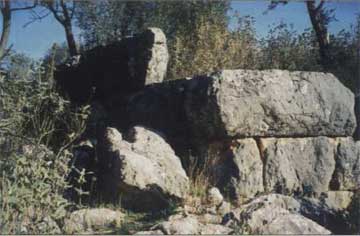 Η δυτική γωνία του κτίσματος.
Ήταν το έτος 1995, όταν το βιβλίο ενός συγγραφέα με τίτλο Πυραμίδες στην Ελλάδα , έδωσε το έναυσμα για να ανακινηθεί το θέμα της ύπαρξης πυραμιδικών
κτισμάτων στον ελλαδικό χώρο. Στο συγκεκριμένο βιβλίο , εκτός των πιστοποιημένων -και γνωστών στην επιστημονική κοινότητα- πυραμιδικών περιπτώσεων , παρουσιάζονταν και ορισμένα πρωτοεμφανιζόμενα κτίσματα , φερόμενα ως πυραμίδες, μεταξύ των οποίων και το μεγαλιθικό μνημείο που βρίσκεται στην περιοχή Καμπία της Νέας Επιδαύρου, του νομού Αργολίδος.
Στο παρόν άρθρο διαπιστώνεται το πρόβλημα στους λίθους της εισόδου του μνημείου αυτού, που οδήγησε -ακόμα και κάποιους αρχαιολόγους– σε λανθασμένα «πυραμιδικά» συμπεράσματα. Επίσης, τεκμηριώνεται η κάθετη διάταξη των λίθων, τόσο στο αριστερό όσο και στο δεξιό σημείο της πρόσοψης όπου στηρίζονταν τα βασικότερα επιχειρήματα περί «πυραμιδοειδούς» εξωτερικής επιφάνειας, και αποκαθίσταται, τέλος, η πραγματική λιθοδομή της εισόδου σε επίπεδο τριών δόμων, συμπληρώνοντας έτσι τη συνολική, μη πυραμιδική, φυσιογνωμία του μνημείου.
Η δυτική γωνία του κτίσματος.
Ήταν το έτος 1995, όταν το βιβλίο ενός συγγραφέα με τίτλο Πυραμίδες στην Ελλάδα , έδωσε το έναυσμα για να ανακινηθεί το θέμα της ύπαρξης πυραμιδικών
κτισμάτων στον ελλαδικό χώρο. Στο συγκεκριμένο βιβλίο , εκτός των πιστοποιημένων -και γνωστών στην επιστημονική κοινότητα- πυραμιδικών περιπτώσεων , παρουσιάζονταν και ορισμένα πρωτοεμφανιζόμενα κτίσματα , φερόμενα ως πυραμίδες, μεταξύ των οποίων και το μεγαλιθικό μνημείο που βρίσκεται στην περιοχή Καμπία της Νέας Επιδαύρου, του νομού Αργολίδος.
Στο παρόν άρθρο διαπιστώνεται το πρόβλημα στους λίθους της εισόδου του μνημείου αυτού, που οδήγησε -ακόμα και κάποιους αρχαιολόγους– σε λανθασμένα «πυραμιδικά» συμπεράσματα. Επίσης, τεκμηριώνεται η κάθετη διάταξη των λίθων, τόσο στο αριστερό όσο και στο δεξιό σημείο της πρόσοψης όπου στηρίζονταν τα βασικότερα επιχειρήματα περί «πυραμιδοειδούς» εξωτερικής επιφάνειας, και αποκαθίσταται, τέλος, η πραγματική λιθοδομή της εισόδου σε επίπεδο τριών δόμων, συμπληρώνοντας έτσι τη συνολική, μη πυραμιδική, φυσιογνωμία του μνημείου.
 Journal of Mediterranean Archaeology, λογότυπο
Η στήλη του JMA παρουσιάζει το άρθρο της Senta C. German "Photography and Fiction: The Publication of the Excavation at the Palace of Minos at Knossos" (18/2, 2005).
Journal of Mediterranean Archaeology, λογότυπο
Η στήλη του JMA παρουσιάζει το άρθρο της Senta C. German "Photography and Fiction: The Publication of the Excavation at the Palace of Minos at Knossos" (18/2, 2005).
Christianity condemns suicide and declares it to be an act of murder. The rules of Church Law state that the suicide is denied Christian burial and a memorial service. Literary sources reveal the deed’s satanic origins and attribute it mainly to functionaries. The satanic suicide par excellence is Judas Iscariot. In the 14th century depictions of his hanging complete the Betrayal scene, while more often in the post Byzantine period, they are linked to the depiction of Redemption. The gallows were used by the Church to support its official interpretation of suicide as the act of ultimate despair.
The literary evidence on suicide in Byzantium is rather limited and for this reason the subject has not been investigated as yet. The incidents of voluntary death from the fourth century to the Justinian period involve almost exclusively pagans, and cases that perpetuate a military tradition, according to which a defeated leader had no other choice but to kill himself, lest suffered disgrace and humiliation in the hands of the victor. In later periods such incidents were probably held as taboo and might have been suppressed. Judicial records attest to the fact that suicidal incidents of women under extreme stress as well as of desperate individuals who were financially ruined were not uncommon. The notion of mercy killing seems unknown in the Christian era and suicide cases resulting from madness or melancholy are hardly mentioned in medical hand-books of the period. Hanging is the most common suicidal method, followed by stabbing or drowing-to cite one or two other ways. The slicing of veins appears only once, in the case of the iconoclast Patriarch Ioannes Grammatikos, to be proved a fake suicide after all. The issue of suicide was not debated in philological discussions in Byzantium nor did it provoke the writing of thorough treatises. The last contribution in this topic is a series of commentaries on Prorphyry’s Isagoge and on Plotinus’ views on death as they were expounded in sixth-century Alexandria. The act of suicide was associated with superstitious beliefs, dispersed in dreams books and astrological texts such as Artemidoros’ Oneirokritikon and Ioannis Kamateros’ dream book, respectively. Finally, the com-mon people believed that the soul of the biothanatos would be transformed into a demon.
The Church has quite early encountered suicide as a major sin and an offense against canon law. In the Christian East and West the ban of the ecclesiastic funeral and burial as well as of relevant services is also early established as the penalty par excellence for this infraction. The “penalty” is introduced in the ecclesiastic practice and is later validated by the canon of the law both the Eastern (canon 14 of Timotheus of Alexandria) and the Western Church. The argument justifying this kind of penalty, which at least in the law of the Eastern Church is not imposed for even much graver ecclesiastic offences, is that the perpetrator through his act challenges his Creator himself, the only master of his life and death. To put it more explicitly, the suicide, being at the same time victim and victimizer, is in reality unable to repent his act, since his very death realizes his offense. Judas’ suicide is often mentioned as a typical example. The objective of this harsh approach is to consolidate in the common consciousness the demerit of the Church for this act, which after all is only turned against nobody else but the suicide himself. If, nevertheless, can be proved that the perpetrator had lost his reason in committing suicide, then he is dispensed from the after death “penalty”. Thus, from the time of ancient Church until today the same long practice is applied: the family of the deceased seeks to attain ecclesiastic funeral of its member by invoking true or usually false testimonies and expert opinions and by exploiting the general “complicity” or consent (cf. Shakespeare, Hamlet, act 5, scene 1). The sensitivity of our present society has imposed the expressed or silent abandonment of the aforementioned ban (this reality is also acknowledged in the new codes of canon law of the Roman Catholic Church), a practice that the Holy Synod of the Church of Greece seems inclined to follow quite hesitantly.
Every religion being holistic is based on the fundamental acknowledgement that reality is a whole entity whose focal point is God from whom all other elements are emitting: human and cosmic, animate and inanimate, rational and irrational. Life belongs to the divine element of reality that determines the rhythm of all begins in the scale of existence. Each of them is incorporated and subordinated in the cycle of life and death, which is ruled by God. Man has no right to upset the cycle of life, therefore murder, both assassination and suicide, is prohibited. The self-determination of life, therefore of death, seems as the rebellion of man against God, and for this reason it is condemned as a serious disturbance of the vital harmony of universe. By reason of its holism, religion deprives man of the right to self-determine his body. Life is the most valuable possession of man, which in the consciousness of the believer emanates from the divine element alone. Thus, the human intervention at the expense of life itself is automatically considered as an insult to God, because it levels life and divinity. The act of taking somebody’s life, regardless of the way, is flatly condemned; therefore the religious tradition reinforces the absolute affirmation of life with a series of banning measures, as in the case of the suicide who is altogether deprived of the ecclesiastic funeral (burial, memorial services).
The Gospel tradition concerning the death of Judas has exercised an important influence on the iconography of this subject already since the first centuries of the Christian age. The pictorial representation of Judas’ suicide by hanging in illustrated manuscripts of the Middle Byzantine period (Psalters with marginal illuminations, Lectionaries, Four Gospels) is based on the tradition of the Gospels and the pateric literature, in the framework of the interpretation of the Gospel of Matthew and the psalm 108. In the Palaeologan period the representation of this subject is enriched with new iconographic data. They originate from the visual tradition of the two aforementioned texts and from other accounts of Juda’s death, that of Papias of Hierapolis being the most characteristic and influential. The fall of Judas from the tree and the representation of his figure in a cavernous hollow are the new iconographic vocabulary that is introduced in the Palaeologan painting, judging from the monuments preserved so far. In the iconographic program of this era Judas’s suicide by hanging belongs to a group of scenes that thoroughly narrate the episodes related to the Betrayal, thus extending the Cycle of Christ’s Passion.
Judas’ suicide by hanging is represented rarely in the art of the Byzantine era as opposed to Post-Byzantine painting where his hideous deed is depicted quite often in the Cycle of Christ’s Passion accompanying the Repentance of the Iscariot and the Return of the thirty silver pieces to the high priest. The Post-Byzantine iconography shows Judas hanging from a tree that bows with the weight of his body and below this scene his blistered and swollen figure in the hollow of a cave. Two versions of this episode are distinguished in this period: In the first Judas is depicted as an agitated figure; he holts his feet, turns his head backwards and brings his hands to his throat, trying desperately to avoid throttling. This version characterizes the monumental painting of the so-called “School of Ochrid” and is more or less typical of the “Kastoria Workshop” to which a number of frescoes in northwestern Greece is ascribed. In the second version the Iscariot is represented dead, his body hanging motionless. The iconographic type originates from the late Byzantine monuments and is adopted by the Cretan painters in the Athonite wall paintings of the sixteenth century, as well as in other seventeenth- and eighteenth-century examples of monumental painting.
This article presents a research project carried out by the Ministry of Culture, which deals with the self-sown flora of the area adjacent to the river Ilissos. The objective of the project was the rehabilitation and promotion of the grounds surrounding the Byzantine Museum of Athens through planting trees and flowers compatible with the climate, earth and historical memory of the site. The flourishing of most of these vegetal species in these grounds is at-tested by literary sources, travelers’ accounts and Athenian journalists writings, while the existence of other plants, like laurel and myrtle, is presumed on the basis of their mythological role, meaning and symbolism. The comparable study of the inventory of trees and flowers at the end of the article, the additional list of the National Garden flora and the catalogue deriving from Theophrastos’ work On the History of Plants can prove the continuity of the Greek flora from the classical period until now and suggest that some of the plants included in Theophrastos’ History might have thrived in his garden and have sparked the ancient philosopher, the father of Botany, to study them.
This article focuses on the transformation of icons as means of religious expression that takes place in the Ionian Islands during the second half of the seventeenth and throughout the eighteenth century. The increasing number of ex-voto produced in that period, the emphasis on narration and pathos, the didactic character as well as the enrichment of iconography with elements deriving from the ritual practice radically alter the content of icons. The very beginning of this evolution must be sought in the immigration of artists of the Cretan School to the Ionian Islands, spanning from the years of the Cretan War to the period that followed the fall of Candia (present Herakleion). The Post-Byzantine painting of the Ionian Islands gradually departs from the morphological and ideological characteristics of the traditional icon, which thus becomes old fashioned and incompatible with the religious feelings of an evolving society. As a result the Ionian School of painting, leaving behind even the last hangover of the Byzantine tradition, adopts means and modes of painting entirely based on Western models.
Freud’s theory of dreams has broadened and transformed psychoanalysis from a psychotherapeutic method to a psychology of the depth of human nature. He showed that dreams were meaningful and that each one represented the disguised expression of a wish fulfillment attempt. Some twenty-five centuries earlier the ancient Greeks had already fully understood (Plato, The Republic IX) this mechanism of psyche, whom they expressed in a more poetical way.
The meaning of the term janissary or janissaries clearly pictures an ideological and religious human profile. The “yeni-çeri”, the new militia, is the soldier defending mainly a religious power. According to the Encyclopedia Encarta the janissaries are the Turkish elite soldiers, recruited from Christians from the Balkans, who formed the personal guard if the Sultan from the fourteenth century until 1826. The Forthrights’s Phrontistery describes them as the fanatic loyal followers of a certain religion, while the entry of the Oxford Dictionary defines them as regular soldiers who formed the personal guard of the Sultan. The janissaries’ corps was organized in the fourteenth century, was manned through the mass kidnapping of Christian children until the sixteenth century and by Muslims of the Ottoman Empire thereafter and it was abolished in 1826 by the regular army, when the janissaries revolted against the Sultan.
It was in 1995, when a book entitled Pyramids in Greece introduced the question of the existence of pyramids in Greece. Besides the already identified and known to the scientific community pyramidal examples, certain recently located structures, reputed as pyramids, were presented in this particular book, in which the megalithic monument in the Kampia district of Nea Epidauros in Argolis was also included. The present article deals with the problem of the stones at the entrance to this monument, which has led even some archaeologists to erroneous “pyramidal” conclusions. It also documents the vertical arrangement of stones on the left and right side of the façade, a lay out on which the more serious arguments for the “pyramid-like” exterior of the monument are based. Finally, it reconstructs three layers above the ground the actual stone masonry of the entrance, thus completing the overall non-pyramidal physiognomy of the edifice.
This article deals with the means through which Sappho’s poetry can be used as a source of the social and political history of her time. We very well know that the lyric poets do not only convey individuality in their work, but they also reveal the political ideals prevailing in the archaic period. Sappho, being a woman, was until recently regarded as having expressed only feelings and sentiments as well as home atmosphere in her verses. However, this judgment has successfully been revised in the last two decades.
This article presents an attempt of interdisciplinary approach that was hold in the 6th Luceum Kalamata, Peloponnese. The staff of two school libraries took the initiative and the project was carried out in collaboration with the educational community of two related schools. As the practice of education should be constantly renewed, it must find out new attractive and creative ways of approaching knowledge that will primarily corroborate the students’ initiative and will aim at their active participation and substantial learning in the framework of a multicultural school. Therefore, having as a pivot the History course of the first grade of the Lyceum, it was attempted an interdisciplinary diffusion in and relation to Literature, Informatics and Aesthetics. The objective was the sensitization of students in History and Art issues, so that the museum, the space par excellence that houses their documentation, to become the attraction pole for the young ephebes. The educational programs “Let’s visit the Acropolis” and “The Parthenon frieze” greatly contributed to the achievement of this goal. Particularly, the students, after been instructed the chapter referring to the art of the classical period, were exposed to a variety of experiences relevant to this same subject (videotapes, music, Internet surfing). Been thus prepared, they undertook the task to compose poems, to write stories, to narrate tales, to paint and to cast in plaster the goddess Iris in order not only to become familiar with but also to reconstruct the cultural product of the classical age. The two philologists, authors of this article, worked out the analytical scheme of the aforementioned course.
The traditional settlements that have been preserved in the mountainous district of Rethymnon, Crete, present an admirable age-long continuity, the origin of which is impossible to be interpreted through the common, established way of thinking. In this article we pursue to reveal a world dominated by sentiment, which is a pure component of our existence, a world that remains inaccessible to myth, reason and science. Through the phenomenological thought, landscape, being a decisive factor of sentiment, can contribute to our understanding of the forms of architecture and guide any human intervention in environment.
Madder is considered one of the oldest and most important natural dying stuff and has been described by all writers of antiquity. It has been known in Asia Minor as well as in the metropolitan Greece since the prehistoric age. It is made from the roots of a climbing herb, which yields more than twenty dying components and a variety of red tints. The ancient and modern technology of madder is described in this article, particularly that of the Turkish red madder; moreover emphasis is given to the various intricate procedures of mordant. A number of methods has been employed for the investigation of the physics and chemistry of dying and for the detection of both the standard and the unknown so far specimens of madder: Phasmatoscopy (visible and ultra violet), Phthorismometry and Thin-Layer Chromatography (TLC). It is thus ascertained that the eye used in historic textiles can be identified through analytical chemical methods.
The theatrical performance Mindscape in the Roman Agora of Athens was an activity of the Platform Cultural Central Europe hosted by the Greek Presidency of the European Union. The basic idea was the restoration of the functional identity of the Agora as a place where citizens are assembled and goods and ideas are exchanged. Source of inspiration were the work of the famous Polish theatrical director Jerzy Grotowski and the “plays-happenings” and thematic was the play Biographies. Through the theatrical convention the Roman Agora thus became an ephemeral theatrical agora. The commodities traded were not material but spiritual off springs, the citizens that attained experienced a different archaeological itinerary. The real objective of the theatrical performance laid on the one hand on the aesthetic perception of the monument and on the other on the functional value of the space. The columns, the stoa and the buttress wall of the Agora obtained a different, almost ontological content. Thus, we could claim a subversive interpretation-conduct of the archaeological heritage.
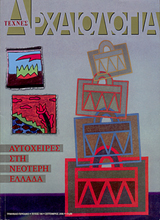
 Μποστ, από τον πίνακα "Μπουζουκσής ψάλων...".
Τα ρεμπέτικα συνήθως αφηγούνται μελαγχολικές, λυπητερές ιστορίες από το περιθώριο της ελληνικής κοινωνίας. Ωστόσο, σε ένα πολύ μικρό ποσοστό τους αναφέρονται ρητά στην αυτοκτονία. Οι λόγοι γι’ αυτό πιθανότατα σχετίζονται με το ήθος των ρεμπετών –πρωταγωνιστών και ερμηνευτών των τραγουδιών αυτών- και την τάση τους να βιαιοπραγούν προθυμότερα εις βάρος των άλλων παρά του εαυτού τους. Από την άλλη μεριά, ο τρόπος ζωής που προβάλλεται ως ηρωικός στα ρεμπέτικα περιλαμβάνει μια πιστή αφοσίωση σε δραστηριότητες επικίνδυνες για την ίδια τη ζωή, όπως η κατάχρηση ναρκωτικών και ποτών. Επομένως, εάν θεωρήσει κανείς ως μορφή εκούσιας αυτοθανάτωσης την εξάρτηση από τα ναρκωτικά και τον αλκοολισμό, θα μπορούσε να ισχυριστεί ότι τα πολυάριθμα ρεμπέτικα που αναφέρονται στα ναρκωτικά και το ποτό είναι τραγούδια αυτοκτονίας και οι ρεμπέτες που πέθαναν από την κατάχρηση αυτών των ουσιών, όπως ο πολυθρύλητος Ανέστης Δελιάς, είναι αυτόχειρες.
Αφήνοντας στην άκρη το θέμα αυτό, πρέπει να πούμε ότι δεν υπάρχει καμία γνωστή περίπτωση χρήσης ρεμπέτικων στίχων σε σημειώματα αυτοχείρων, ούτε ηρωική πράξη αυτοθυσίας, ηρωική ή άλλη, που να συνοδεύτηκε από ρεμπέτικο τραγούδι. Ούτε, τέλος, κατηγορήθηκε το ρεμπέτικο για υποβολιμαία παρακίνηση των ακροατών του προς την αυτοκτονία. Κατά συνέπεια, η ρεμπετολογία δεν έχει ενδιαφερθεί παρά ελάχιστα μέχρι στιγμής για την αυτοκτονία. Εξαίρεση αποτελεί ο Ηλίας Πετρόπουλος, στον οποίο φαίνεται πως ασκούσαν μια επίμονη γοητεία τόσο η αυτοχειρία όσο και οι αυτοκακώσεις.
Προπολεμικά, η αυτοκτονία ως θέμα φαίνεται πως ανήκε αποκλειστικά στους αμανέδες. Ενδεικτικό είναι το γεγονός ότι φημισμένοι συνθέτες του ρεμπέτικου φωνογράφησαν πεισιθάνατους στίχους σε σχήμα αμανέ κατά το μεσοπόλεμο. Τη χαριστική βολή έδωσε στους αμανέδες η «γενοκτόνα» λογοκρισία που επέβαλε το φθινόπωρο του 1937 το καθεστώς Μεταξά. Η θεματολογία της αυτοκτονίας πέρασε έτσι στα πειραιώτικα ρεμπέτικα της μεταπολεμικής περιόδου. Παρ’ όλα αυτά, φαίνεται πως υπάρχει κάποια απροθυμία από την πλευρά των στιχουργών να αναφερθούν απροκάλυπτα στην αυτοκτονία. Το άρθρο παρουσιάζει και εξετάζει παραδείγματα ρεμπέτικων, όπου εκφράζεται η τάση προς την αυτοκτονία, κυρίως εκείνων που συνέθεσαν ο Βαμβακάρης και ο Τσιτσάνης, και εξετάζει την έμμεση σύνδεση του γνωστού τραγουδιού του τελευταίου «Συννεφιασμένη Κυριακή» με τον περιβόητο ουγγρικό ύμνο της αυτοκτονίας «Gloomy Sunday».
Μποστ, από τον πίνακα "Μπουζουκσής ψάλων...".
Τα ρεμπέτικα συνήθως αφηγούνται μελαγχολικές, λυπητερές ιστορίες από το περιθώριο της ελληνικής κοινωνίας. Ωστόσο, σε ένα πολύ μικρό ποσοστό τους αναφέρονται ρητά στην αυτοκτονία. Οι λόγοι γι’ αυτό πιθανότατα σχετίζονται με το ήθος των ρεμπετών –πρωταγωνιστών και ερμηνευτών των τραγουδιών αυτών- και την τάση τους να βιαιοπραγούν προθυμότερα εις βάρος των άλλων παρά του εαυτού τους. Από την άλλη μεριά, ο τρόπος ζωής που προβάλλεται ως ηρωικός στα ρεμπέτικα περιλαμβάνει μια πιστή αφοσίωση σε δραστηριότητες επικίνδυνες για την ίδια τη ζωή, όπως η κατάχρηση ναρκωτικών και ποτών. Επομένως, εάν θεωρήσει κανείς ως μορφή εκούσιας αυτοθανάτωσης την εξάρτηση από τα ναρκωτικά και τον αλκοολισμό, θα μπορούσε να ισχυριστεί ότι τα πολυάριθμα ρεμπέτικα που αναφέρονται στα ναρκωτικά και το ποτό είναι τραγούδια αυτοκτονίας και οι ρεμπέτες που πέθαναν από την κατάχρηση αυτών των ουσιών, όπως ο πολυθρύλητος Ανέστης Δελιάς, είναι αυτόχειρες.
Αφήνοντας στην άκρη το θέμα αυτό, πρέπει να πούμε ότι δεν υπάρχει καμία γνωστή περίπτωση χρήσης ρεμπέτικων στίχων σε σημειώματα αυτοχείρων, ούτε ηρωική πράξη αυτοθυσίας, ηρωική ή άλλη, που να συνοδεύτηκε από ρεμπέτικο τραγούδι. Ούτε, τέλος, κατηγορήθηκε το ρεμπέτικο για υποβολιμαία παρακίνηση των ακροατών του προς την αυτοκτονία. Κατά συνέπεια, η ρεμπετολογία δεν έχει ενδιαφερθεί παρά ελάχιστα μέχρι στιγμής για την αυτοκτονία. Εξαίρεση αποτελεί ο Ηλίας Πετρόπουλος, στον οποίο φαίνεται πως ασκούσαν μια επίμονη γοητεία τόσο η αυτοχειρία όσο και οι αυτοκακώσεις.
Προπολεμικά, η αυτοκτονία ως θέμα φαίνεται πως ανήκε αποκλειστικά στους αμανέδες. Ενδεικτικό είναι το γεγονός ότι φημισμένοι συνθέτες του ρεμπέτικου φωνογράφησαν πεισιθάνατους στίχους σε σχήμα αμανέ κατά το μεσοπόλεμο. Τη χαριστική βολή έδωσε στους αμανέδες η «γενοκτόνα» λογοκρισία που επέβαλε το φθινόπωρο του 1937 το καθεστώς Μεταξά. Η θεματολογία της αυτοκτονίας πέρασε έτσι στα πειραιώτικα ρεμπέτικα της μεταπολεμικής περιόδου. Παρ’ όλα αυτά, φαίνεται πως υπάρχει κάποια απροθυμία από την πλευρά των στιχουργών να αναφερθούν απροκάλυπτα στην αυτοκτονία. Το άρθρο παρουσιάζει και εξετάζει παραδείγματα ρεμπέτικων, όπου εκφράζεται η τάση προς την αυτοκτονία, κυρίως εκείνων που συνέθεσαν ο Βαμβακάρης και ο Τσιτσάνης, και εξετάζει την έμμεση σύνδεση του γνωστού τραγουδιού του τελευταίου «Συννεφιασμένη Κυριακή» με τον περιβόητο ουγγρικό ύμνο της αυτοκτονίας «Gloomy Sunday».
 Salvador Dali, Πορτρέτο της κυρίας Isabel Styler-Tas (Μελαγχολία), 1945, Staatliche Museen zu Berlin, Nationalgalerie, Βερολίνο.
Από τα βάθη των αιώνων συναντώνται κρούσματα αυτοκτονίας, τα οποία μας μεταφέρουν πρώτοι οι τραγικοί ποιητές. Η έρευνα που επιχειρούμε στο άρθρο αυτό μέσα από τα φύλλα των εφημερίδων, τόσο για τα περιστατικά όσο και για τον προβληματισμό προς αντιμετώπιση του φαινομένου, μας οδήγησε στο σκεπτικό ότι όσο δύσκολο είναι να εντοπίσει κανείς επακριβώς τα αίτια –τα οποία διαφέρουν από άτομο σε άτομο– άλλο τόσο είναι αδύνατο να δοθούν συμβουλές επί συνόλου. Πώς να εξηγηθούν οι αυτοκτονίες του Περικλή Γιαννόπουλου, του Κώστα Καρυωτάκη, της Πηνελόπης Δέλτα, του Ιωάννη Συκουτρή; Και παρά τις διευκρινίσεις που έδωσαν ορισμένοι, άφησαν και πολλά ερωτηματικά. Η κοινωνία αντιμετώπισε πάντα με επιφυλακτικότητα την αυτοκτονία και πολλές φορές με ειρωνεία! Αν και από τα τέλη του 19ου αιώνα, ο Emile Durkheim με το βιβλίο του Κοινωνικές αιτίες της αυτοκτονίας έδωσε το στίγμα του φαινομένου, προσπαθώντας να ανακαλύψει τις αιτίες και να θέσει υπόλογη την κοινωνία, παραδέχεται ωστόσο ότι κάτι βαθύτερο και εντελώς προσωπικό συμβαίνει. Οι σύγχρονες κοινωνίες οργάνωσαν συνέδρια, κέντρα για τόνωση του ηθικού, ανέλυσαν τα ψυχολογικά και ψυχοσωματικά αίτια, οι στατιστικές όμως δείχνουν πάντα ανοδική τάση στα ποσοστά, μέχρι και 260% από το 1950. Το μόνο που συστήνουν οι ψυχολόγοι είναι η παλαιά καλή συνταγή: αγάπη και φροντίδα για τα ευαίσθητα αυτά άτομα.
Salvador Dali, Πορτρέτο της κυρίας Isabel Styler-Tas (Μελαγχολία), 1945, Staatliche Museen zu Berlin, Nationalgalerie, Βερολίνο.
Από τα βάθη των αιώνων συναντώνται κρούσματα αυτοκτονίας, τα οποία μας μεταφέρουν πρώτοι οι τραγικοί ποιητές. Η έρευνα που επιχειρούμε στο άρθρο αυτό μέσα από τα φύλλα των εφημερίδων, τόσο για τα περιστατικά όσο και για τον προβληματισμό προς αντιμετώπιση του φαινομένου, μας οδήγησε στο σκεπτικό ότι όσο δύσκολο είναι να εντοπίσει κανείς επακριβώς τα αίτια –τα οποία διαφέρουν από άτομο σε άτομο– άλλο τόσο είναι αδύνατο να δοθούν συμβουλές επί συνόλου. Πώς να εξηγηθούν οι αυτοκτονίες του Περικλή Γιαννόπουλου, του Κώστα Καρυωτάκη, της Πηνελόπης Δέλτα, του Ιωάννη Συκουτρή; Και παρά τις διευκρινίσεις που έδωσαν ορισμένοι, άφησαν και πολλά ερωτηματικά. Η κοινωνία αντιμετώπισε πάντα με επιφυλακτικότητα την αυτοκτονία και πολλές φορές με ειρωνεία! Αν και από τα τέλη του 19ου αιώνα, ο Emile Durkheim με το βιβλίο του Κοινωνικές αιτίες της αυτοκτονίας έδωσε το στίγμα του φαινομένου, προσπαθώντας να ανακαλύψει τις αιτίες και να θέσει υπόλογη την κοινωνία, παραδέχεται ωστόσο ότι κάτι βαθύτερο και εντελώς προσωπικό συμβαίνει. Οι σύγχρονες κοινωνίες οργάνωσαν συνέδρια, κέντρα για τόνωση του ηθικού, ανέλυσαν τα ψυχολογικά και ψυχοσωματικά αίτια, οι στατιστικές όμως δείχνουν πάντα ανοδική τάση στα ποσοστά, μέχρι και 260% από το 1950. Το μόνο που συστήνουν οι ψυχολόγοι είναι η παλαιά καλή συνταγή: αγάπη και φροντίδα για τα ευαίσθητα αυτά άτομα.
 Ο Βούδας πεθαίνει γαλήνια ανάμεσα στους μαθητές του. Κολοσσικό άγαλμα του Βούδα (5ος-6ος αι. μ.Χ.).
Την εικονοποιία του ποιήματος «Η αυτοκτονία του Ατζεσιβάνο» συγκροτούν στοιχεία από την ελληνική λαϊκή παράδοση, από τη νεοελληνική ποίηση, από την ορολογία της τελετουργίας των Ελευσίνιων Μυστηρίων και από την Υψιπύλη του Ευριπίδη. Ο Άγγελος Σικελιανός δεν είναι μόνο ο εμπνευσμένος «υποφήτης των Μουσών», αλλά και ο πολυμαθής λόγιος ποιητής που αντλεί από τα απύθμενα διαβάσματά του.
Ο Βούδας πεθαίνει γαλήνια ανάμεσα στους μαθητές του. Κολοσσικό άγαλμα του Βούδα (5ος-6ος αι. μ.Χ.).
Την εικονοποιία του ποιήματος «Η αυτοκτονία του Ατζεσιβάνο» συγκροτούν στοιχεία από την ελληνική λαϊκή παράδοση, από τη νεοελληνική ποίηση, από την ορολογία της τελετουργίας των Ελευσίνιων Μυστηρίων και από την Υψιπύλη του Ευριπίδη. Ο Άγγελος Σικελιανός δεν είναι μόνο ο εμπνευσμένος «υποφήτης των Μουσών», αλλά και ο πολυμαθής λόγιος ποιητής που αντλεί από τα απύθμενα διαβάσματά του.
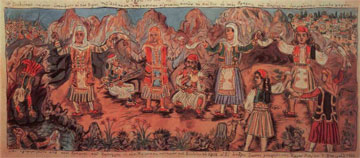 Ο χορός του Ζαλόγγου. Έργο του Θεόφιλου, 1929.
Το άρθρο έχει ως επίκεντρο τις γυναίκες του Σουλίου που, όπως εικάζεται, «εν χοροίς και ασμάσι» οδηγήθηκαν στον γκρεμό με δική τους απόφαση, προτιμώντας για τις ίδιες και τα παιδιά τους το θάνατο παρά μια οδυνηρή αιματοχυσία και αιχμαλωσία. Το γεγονός αυτό έχει μείνει στην ιστορία ως «ο Χορός του Ζαλόγγου».
Σκοπός του άρθρου είναι να διερευνήσει τις δύο όψεις αυτού του φαινομένου, το περιεχόμενό του και ως τη σκηνική παρουσίασή του. Έτσι, εξετάζονται τρεις δραματοποιημένες εκδοχές του μύθου, η σχολική εκδοχή, η θεατρική παράσταση του Σπυρίδωνα Περεσιάδη και η κινηματογραφική ταινία του Στέλιου Τατασόπουλου, τις οποίες η συγγραφέας του άρθρου εντάσσει στο χωροχρονικό τους πλαίσιο, έτσι ώστε να αναδειχθεί και να προσδιορισθεί η επίδραση του μύθου στη νεότερη ελληνική κοινωνία.
Ο χορός του Ζαλόγγου. Έργο του Θεόφιλου, 1929.
Το άρθρο έχει ως επίκεντρο τις γυναίκες του Σουλίου που, όπως εικάζεται, «εν χοροίς και ασμάσι» οδηγήθηκαν στον γκρεμό με δική τους απόφαση, προτιμώντας για τις ίδιες και τα παιδιά τους το θάνατο παρά μια οδυνηρή αιματοχυσία και αιχμαλωσία. Το γεγονός αυτό έχει μείνει στην ιστορία ως «ο Χορός του Ζαλόγγου».
Σκοπός του άρθρου είναι να διερευνήσει τις δύο όψεις αυτού του φαινομένου, το περιεχόμενό του και ως τη σκηνική παρουσίασή του. Έτσι, εξετάζονται τρεις δραματοποιημένες εκδοχές του μύθου, η σχολική εκδοχή, η θεατρική παράσταση του Σπυρίδωνα Περεσιάδη και η κινηματογραφική ταινία του Στέλιου Τατασόπουλου, τις οποίες η συγγραφέας του άρθρου εντάσσει στο χωροχρονικό τους πλαίσιο, έτσι ώστε να αναδειχθεί και να προσδιορισθεί η επίδραση του μύθου στη νεότερη ελληνική κοινωνία.
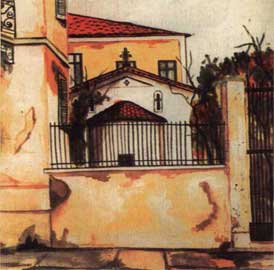 Σχέδιο του ναού του Αγίου Ελισαίου στην Πλάκα, προτού κατεδαφιστεί το 1943.
«Ήτο λοιπόν άστεγος; Είχε δωμάτιον, αλλά που ετόλμα ο πτωχός να εισέλθη από την σπιτονοικοκυράν του. Εχρεώστει τρία ενοίκια. Επί τρεις εβδομάδας;, μετά το μεσονύκτιον, πλησιάζων με παλμούς εις την αυλόπορταν, ανοικτήν μένουσα όλην την νύκτα, καθώς όλαι αι αυλόπορται των οικιών της συνοικίας, εχουσών ενοικήτορας πολλούς, αφήρει τα χαλασμένα και σχισμένα πέδιλά του και κρατών αυτά με την αριστεράν, επάτει με τες κάλτσες, ενέβαλλε το κλείθρον με απείρους προφυλάξεις και με τόσον ολίγον κρότον, ώστε οι παλμοί της καρδίας έκαμνον κρότον μεγαλείτερον (…).»
Αλεξάνδρου Παπαδιαμάντη, «Ο Αυτοκτόνος», Άπαντα του Αλεξάνδρου Παπαδιαμάντη, επιμ. Γ. Βαλέτα, τόμ. 5, εκδ. Γιοβάνης, 1954.
Σχέδιο του ναού του Αγίου Ελισαίου στην Πλάκα, προτού κατεδαφιστεί το 1943.
«Ήτο λοιπόν άστεγος; Είχε δωμάτιον, αλλά που ετόλμα ο πτωχός να εισέλθη από την σπιτονοικοκυράν του. Εχρεώστει τρία ενοίκια. Επί τρεις εβδομάδας;, μετά το μεσονύκτιον, πλησιάζων με παλμούς εις την αυλόπορταν, ανοικτήν μένουσα όλην την νύκτα, καθώς όλαι αι αυλόπορται των οικιών της συνοικίας, εχουσών ενοικήτορας πολλούς, αφήρει τα χαλασμένα και σχισμένα πέδιλά του και κρατών αυτά με την αριστεράν, επάτει με τες κάλτσες, ενέβαλλε το κλείθρον με απείρους προφυλάξεις και με τόσον ολίγον κρότον, ώστε οι παλμοί της καρδίας έκαμνον κρότον μεγαλείτερον (…).»
Αλεξάνδρου Παπαδιαμάντη, «Ο Αυτοκτόνος», Άπαντα του Αλεξάνδρου Παπαδιαμάντη, επιμ. Γ. Βαλέτα, τόμ. 5, εκδ. Γιοβάνης, 1954.
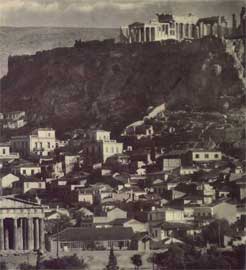 Fred Boissonas, Άποψη της Ακρόπολης από το Θησείο το 1920.
Στο τεύχος αυτό, το τρίτο μέρος του αφιερώματος στους Αυτόχειρες, η αυτοκτονία προσεγγίζεται ως σύνθετο κοινωνικό, λογοτεχνικό και ακόμη και χορολογικό φαινόμενο στην Ελλάδα των νεότερων χρόνων. Σε αντίθεση με τη μεσαιωνική περίοδο, τα δεδομένα του φαινομένου πληθαίνουν για τον ιστορικό της νεοελληνικής κοινωνίας.
Fred Boissonas, Άποψη της Ακρόπολης από το Θησείο το 1920.
Στο τεύχος αυτό, το τρίτο μέρος του αφιερώματος στους Αυτόχειρες, η αυτοκτονία προσεγγίζεται ως σύνθετο κοινωνικό, λογοτεχνικό και ακόμη και χορολογικό φαινόμενο στην Ελλάδα των νεότερων χρόνων. Σε αντίθεση με τη μεσαιωνική περίοδο, τα δεδομένα του φαινομένου πληθαίνουν για τον ιστορικό της νεοελληνικής κοινωνίας.
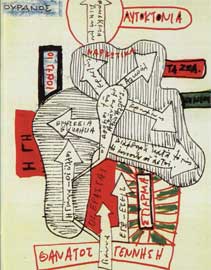 Σχεδιάγραμμα "ΥΠΑΡΞΕΩΣ", 7 Ιουνίου 1966. Έργο του Α. Ακριθάκη.
Ο Αλέξης Ακριθάκης ήταν ο πλέον ανατρεπτικός, ευάλωτος και απρόβλεπτος καλλιτέχνης που γνώρισα ποτέ. Η τέχνη ήταν η ζωή του και η ζωή του η ίδια ήταν η τέχνη του. Πάντοτε τον θυμάμαι να κινείται στην οριακή γραμμή του παιχνιδιού, «…γιατί μόνο τότε το έργο γίνεται πληθωρικό και παρουσιάζει μια εσωτερικότητα».
Για τον ίδιο τόσο η τέχνη όσο και η ζωή έχουν μια εγκληματικότητα. Γιατί το έγκλημα για τον ίδιο είναι μια τρυφερή ιστορία: «Η τέχνη είναι ένα πολύ επικίνδυνο και ανθυγιεινό επάγγελμα. Τέχνη είναι η τραγική σου ζωή και η ασχήμια του κόσμου που κυκλοφορεί γύρω σου… οι καλλιτέχνες έχουνε μέσα τους τη φθορά. Ο ρόλος του καλλιτέχνη και όχι του ζωγράφου είναι να ανατρέπει τα πράγματα. Σήμερα δε σέβονται την τέχνη. Σέβονται μόνο τους ζωγράφους τους κοσμικούς… τους έχω χεσμένους».
Ο Αλέξης Ακριθάκης πέρασε τη ζωή του βλέποντας τους φίλους του να αυτοκτονούν. Ο ίδιος είχε επιλέξει έναν αυτοκτονικό τρόπο ζωής γιατί πίστευε πως αυτή πρέπει να είναι η συνεχής διαμαρτυρία στη ζωή του καλλιτέχνη. «… Η ζωγραφική είναι ένα επάγγελμα σαν τον ψιλικατζή. Η τέχνη έχει τα προβλήματα των ανθρώπων που πεθαίνουν μόνοι τους στο δρόμο».
Από το σπίτι του στην Αθήνα το έσκασε 16 χρονών. Οικογένεια Στάντζου-Φιξ. Η μητέρα του Γερμανίδα. Τελείωσε τη Λεόντειο. Το εργοστάσιο υφασμάτων της μητέρας του ήταν στο Γκάζι. Πίσω από το Πιλοποιείο του Πουλόπουλου. Διέρρηξε το χρηματοκιβώτιο και πήγε στη Θεσσαλονίκη όπου έκανε τις δραχμές μάρκα. Με μια μηχανή τετράχρονη έφυγε για το Παρίσι. Από τότε δεν ξαναείδε τους γονείς του. Στο Παρίσι σπούδασε στην Ακαδημία Grand Chaumiere. Έκανε διδακτορικό με τον Γ. Κανδύλη στο θέμα «Η ζωγραφική και η πολεοδομία». Για να ζήσει δούλεψε ως δοκιμαστής αυτοκινήτων της Peugeot στην Αφρική. Ταξίδεψε στις περισσότερες πόλεις της Ευρώπης. Ο Τσίγκος ήταν φίλος του. Ακόμη και ο Keith Haring τον αναγνώρισε ως πρωτοπόρο και «δανείστηκε» μερικά από τα σύμβολά του.
Το σεργιάνι του στον κόσμο θα το κάνει με τη στήριξη της γυναίκας του Φώφης και του μαικήνα της τέχνης τον οποίο λάτρευε, Αλέξανδρο Ιόλα. Η ζωή του ήταν ένας κραδασμός. Ένα σπιντάρισμα. Ήταν ένας πρωτόγονος άγριος λύκος και ταυτόχρονα τόσο τρυφερός…
Σχεδιάγραμμα "ΥΠΑΡΞΕΩΣ", 7 Ιουνίου 1966. Έργο του Α. Ακριθάκη.
Ο Αλέξης Ακριθάκης ήταν ο πλέον ανατρεπτικός, ευάλωτος και απρόβλεπτος καλλιτέχνης που γνώρισα ποτέ. Η τέχνη ήταν η ζωή του και η ζωή του η ίδια ήταν η τέχνη του. Πάντοτε τον θυμάμαι να κινείται στην οριακή γραμμή του παιχνιδιού, «…γιατί μόνο τότε το έργο γίνεται πληθωρικό και παρουσιάζει μια εσωτερικότητα».
Για τον ίδιο τόσο η τέχνη όσο και η ζωή έχουν μια εγκληματικότητα. Γιατί το έγκλημα για τον ίδιο είναι μια τρυφερή ιστορία: «Η τέχνη είναι ένα πολύ επικίνδυνο και ανθυγιεινό επάγγελμα. Τέχνη είναι η τραγική σου ζωή και η ασχήμια του κόσμου που κυκλοφορεί γύρω σου… οι καλλιτέχνες έχουνε μέσα τους τη φθορά. Ο ρόλος του καλλιτέχνη και όχι του ζωγράφου είναι να ανατρέπει τα πράγματα. Σήμερα δε σέβονται την τέχνη. Σέβονται μόνο τους ζωγράφους τους κοσμικούς… τους έχω χεσμένους».
Ο Αλέξης Ακριθάκης πέρασε τη ζωή του βλέποντας τους φίλους του να αυτοκτονούν. Ο ίδιος είχε επιλέξει έναν αυτοκτονικό τρόπο ζωής γιατί πίστευε πως αυτή πρέπει να είναι η συνεχής διαμαρτυρία στη ζωή του καλλιτέχνη. «… Η ζωγραφική είναι ένα επάγγελμα σαν τον ψιλικατζή. Η τέχνη έχει τα προβλήματα των ανθρώπων που πεθαίνουν μόνοι τους στο δρόμο».
Από το σπίτι του στην Αθήνα το έσκασε 16 χρονών. Οικογένεια Στάντζου-Φιξ. Η μητέρα του Γερμανίδα. Τελείωσε τη Λεόντειο. Το εργοστάσιο υφασμάτων της μητέρας του ήταν στο Γκάζι. Πίσω από το Πιλοποιείο του Πουλόπουλου. Διέρρηξε το χρηματοκιβώτιο και πήγε στη Θεσσαλονίκη όπου έκανε τις δραχμές μάρκα. Με μια μηχανή τετράχρονη έφυγε για το Παρίσι. Από τότε δεν ξαναείδε τους γονείς του. Στο Παρίσι σπούδασε στην Ακαδημία Grand Chaumiere. Έκανε διδακτορικό με τον Γ. Κανδύλη στο θέμα «Η ζωγραφική και η πολεοδομία». Για να ζήσει δούλεψε ως δοκιμαστής αυτοκινήτων της Peugeot στην Αφρική. Ταξίδεψε στις περισσότερες πόλεις της Ευρώπης. Ο Τσίγκος ήταν φίλος του. Ακόμη και ο Keith Haring τον αναγνώρισε ως πρωτοπόρο και «δανείστηκε» μερικά από τα σύμβολά του.
Το σεργιάνι του στον κόσμο θα το κάνει με τη στήριξη της γυναίκας του Φώφης και του μαικήνα της τέχνης τον οποίο λάτρευε, Αλέξανδρο Ιόλα. Η ζωή του ήταν ένας κραδασμός. Ένα σπιντάρισμα. Ήταν ένας πρωτόγονος άγριος λύκος και ταυτόχρονα τόσο τρυφερός…
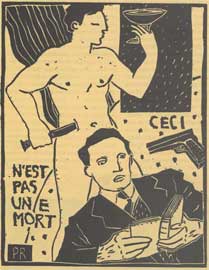 Το ξίφος, το πιστόλι, το δηλητήριο: οι συνηθέστεροι "αυτοκτονολογικοί τρόποι" στα λογοτεχνικά κείμενα. Σχέδιο της P. Reznikov.
Επιχειρώντας να προσδιορίσουμε μια παράδοση περί αυτοκτονίας στη νεότερη λογοτεχνία μας, πέρα από τη συνηγορία του Κάλβου και του Σολωμού, και τη συμβολή του «νοσηρού ρομαντισμού» της αθηναϊκής σχολής, παραδόξως ανιχνεύουμε ένα ισχυρό στίγμα αυτοκαταστροφής στα κείμενα της τριανδρίας του νεοελληνικού διηγήματος (Βιζυηνός, Παπαδιαμάντης, Μητσάκης), της περιλάλητης «γενιάς του 1880», της γενιάς της «ηθογραφικής υγείας».
Ο Αυτόχειρας (1895) του Μιχαήλ Μητσάκη φωτίζει την αυτοκτονία σε αντίστιξη προς την περιηγητική διάθεση του κειμένου: ο αφηγητής περιπλανιέται στην Πάτρα, δίνοντας εξαντλητικές περιγραφές από καθετί που καταβροχθίζει το αχόρταγο βλέμμα του, ενώ τη σκέψη του τριβελίζει ακατάπαυστα το αίνιγμα της αυτοχειρίας που συνέβη στο ξενοδοχείο όπου διαμένει. Το σφυροκόπημα των τελευταίων λέξεων του αυτόχειρα στο μυαλό του αφηγητή γίνεται ολοένα πιο δυνατό ώσπου επιβάλλει το ρυθμό του στο κείμενο. Μερικά χρόνια νωρίτερα, το 1891, ο Αλέξανδρος Παπαδιαμάντης, αναγγέλλει τον Αυτοκτόνο, ένα από τα διηγήματά του, το οποίο, ωστόσο, δεν δημοσιεύθηκε παρά πολύ αργότερα. Αυτολογοκρινόμενος ή για άλλους λόγους; Πάντως, η παρουσία μετέπειτα κειμένων στο έργο του τα οποία ασχολούνται με την αυτοχειρία μάς επιτρέπουν να υποθέσουμε ότι και ο συγγραφέας από τη Σκιάθο (και αριστοτεχνικός μεταφραστής του Ντοστογιέφσκι) υπέκυψε στη γοητεία του θέματος. Νωρίτερα ακόμη, στις αρχές της δεκαετίας του 1880, ο Γεώργιος Βιζυηνός πραγματεύεται το αυτοκαταστροφικό τέλος ενός άτυχου ερωτικού ζεύγους στο έργο τουΑι συνέπειαι της παλαιάς ιστορίας: εδώ παρακολουθούμε πώς η αδράνεια και η μελαγχολία οδηγούν αργά, μεθοδικά και αναπόδραστα στο κατώφλι του (λυτρωτικού) θανάτου.
Κατά συνέπεια, το φάσμα της αυτοχειρίας πλανάται καθοριστικά πάνω από το νεοελληνικό διήγημα, το οποίο, ήδη στις αρχές του 19ου αιώνα, θα αλλάξει ριζικά το τοπίο της νεοελληνικής πεζογραφίας, δημιουργώντας τις τεχνικές, ρητορικές και θεματικές προϋποθέσεις για έναν λογοτεχνικό μοντερνισμό.
Το ξίφος, το πιστόλι, το δηλητήριο: οι συνηθέστεροι "αυτοκτονολογικοί τρόποι" στα λογοτεχνικά κείμενα. Σχέδιο της P. Reznikov.
Επιχειρώντας να προσδιορίσουμε μια παράδοση περί αυτοκτονίας στη νεότερη λογοτεχνία μας, πέρα από τη συνηγορία του Κάλβου και του Σολωμού, και τη συμβολή του «νοσηρού ρομαντισμού» της αθηναϊκής σχολής, παραδόξως ανιχνεύουμε ένα ισχυρό στίγμα αυτοκαταστροφής στα κείμενα της τριανδρίας του νεοελληνικού διηγήματος (Βιζυηνός, Παπαδιαμάντης, Μητσάκης), της περιλάλητης «γενιάς του 1880», της γενιάς της «ηθογραφικής υγείας».
Ο Αυτόχειρας (1895) του Μιχαήλ Μητσάκη φωτίζει την αυτοκτονία σε αντίστιξη προς την περιηγητική διάθεση του κειμένου: ο αφηγητής περιπλανιέται στην Πάτρα, δίνοντας εξαντλητικές περιγραφές από καθετί που καταβροχθίζει το αχόρταγο βλέμμα του, ενώ τη σκέψη του τριβελίζει ακατάπαυστα το αίνιγμα της αυτοχειρίας που συνέβη στο ξενοδοχείο όπου διαμένει. Το σφυροκόπημα των τελευταίων λέξεων του αυτόχειρα στο μυαλό του αφηγητή γίνεται ολοένα πιο δυνατό ώσπου επιβάλλει το ρυθμό του στο κείμενο. Μερικά χρόνια νωρίτερα, το 1891, ο Αλέξανδρος Παπαδιαμάντης, αναγγέλλει τον Αυτοκτόνο, ένα από τα διηγήματά του, το οποίο, ωστόσο, δεν δημοσιεύθηκε παρά πολύ αργότερα. Αυτολογοκρινόμενος ή για άλλους λόγους; Πάντως, η παρουσία μετέπειτα κειμένων στο έργο του τα οποία ασχολούνται με την αυτοχειρία μάς επιτρέπουν να υποθέσουμε ότι και ο συγγραφέας από τη Σκιάθο (και αριστοτεχνικός μεταφραστής του Ντοστογιέφσκι) υπέκυψε στη γοητεία του θέματος. Νωρίτερα ακόμη, στις αρχές της δεκαετίας του 1880, ο Γεώργιος Βιζυηνός πραγματεύεται το αυτοκαταστροφικό τέλος ενός άτυχου ερωτικού ζεύγους στο έργο τουΑι συνέπειαι της παλαιάς ιστορίας: εδώ παρακολουθούμε πώς η αδράνεια και η μελαγχολία οδηγούν αργά, μεθοδικά και αναπόδραστα στο κατώφλι του (λυτρωτικού) θανάτου.
Κατά συνέπεια, το φάσμα της αυτοχειρίας πλανάται καθοριστικά πάνω από το νεοελληνικό διήγημα, το οποίο, ήδη στις αρχές του 19ου αιώνα, θα αλλάξει ριζικά το τοπίο της νεοελληνικής πεζογραφίας, δημιουργώντας τις τεχνικές, ρητορικές και θεματικές προϋποθέσεις για έναν λογοτεχνικό μοντερνισμό.
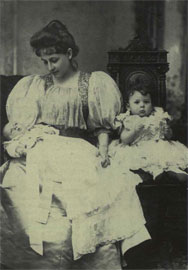 Η συγγραφέας Πηνελόπη Δέλτα (Αλεξάνδρεια, 1874 - Αθήνα, 1941).
Το παρόν άρθρο είναι η τελευταία πράξη ενός θεατρικού έργου που βασίζεται στο βιβλίο του Π. Χαρτοκόλλη Ιδανικοί Αυτόχειρες και αφορά τους πέντε πιο σημαντικούς αυτόχειρες λογοτέχνες της νεοελληνικής γραμματείας, τον Κώστα Καρυωτάκη, τον Περικλή Γιαννόπουλου, τον Ναπολέοντα Λαπαθιώτη, τον Ιωάννη Συκουτρή και την Πηνελόπη Δέλτα. Είναι ουσιαστικά μια συζήτηση μεταξύ πέντε διάσημων ψυχαναλυτών μιας άλλης εποχής πάνω στο θέμα της αυτοκτονίας με βάση τις πληροφορίες που παρουσιάζονται στα προηγούμενα κεφάλαια του βιβλίου και δικές μου αντιλήψεις για το θέμα της αυτοκτονίας.
Η συγγραφέας Πηνελόπη Δέλτα (Αλεξάνδρεια, 1874 - Αθήνα, 1941).
Το παρόν άρθρο είναι η τελευταία πράξη ενός θεατρικού έργου που βασίζεται στο βιβλίο του Π. Χαρτοκόλλη Ιδανικοί Αυτόχειρες και αφορά τους πέντε πιο σημαντικούς αυτόχειρες λογοτέχνες της νεοελληνικής γραμματείας, τον Κώστα Καρυωτάκη, τον Περικλή Γιαννόπουλου, τον Ναπολέοντα Λαπαθιώτη, τον Ιωάννη Συκουτρή και την Πηνελόπη Δέλτα. Είναι ουσιαστικά μια συζήτηση μεταξύ πέντε διάσημων ψυχαναλυτών μιας άλλης εποχής πάνω στο θέμα της αυτοκτονίας με βάση τις πληροφορίες που παρουσιάζονται στα προηγούμενα κεφάλαια του βιβλίου και δικές μου αντιλήψεις για το θέμα της αυτοκτονίας.
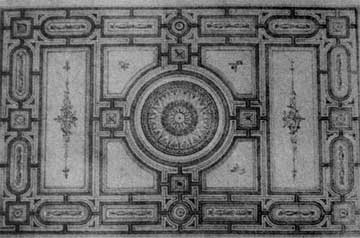 Ερνέστος Τσίλερ, σχέδιο για οροφή στην Οικία Ψύχα, 1875.
Οι σχεδιασμένες από τον Γερμανό αρχιτέκτονα Ernst Ziller γραπτές διακοσμήσεις για το εσωτερικό και εξωτερικό οικοδομημάτων της Αθήνας φανερώνουν τις επιρροές του από την ελληνική αρχαιότητα (ιδιαιτέρως την αρχιτεκτονική πολυχρωμία), τη ρωμαϊκή αρχαιότητα (ιδιαιτέρως της πομπηιανές συνθέσεις), την Αναγέννηση και τις δημιουργίες του Theophil Hansen. Οι τακτικές επισκέψεις του Ziller στη Βιέννη, τόπο δράσης του Hansen μετά την αποχώρησή του από την Αθήνα το 1846, του παρείχαν τη δυνατότητα να ενημερώνεται για το έργο του στενού φίλου και συνεργάτη του, και να αναπτύξει δεσμούς γενικότερα με τους ζωγράφους του λεγόμενου «κύκλου Rahl», π.χ. τον Eduard Bitterlich. O Ziller μετέφερε στην Αθήνα διακοσμητικά συστήματα στο πλαίσιο των ιστορικιστικών τάσεων, που άκμαζαν την εποχή εκείνη στη Βιέννη. Οι επιρροές του Hansen στο διακοσμητικό έργο του γίνονται προφανείς μέσα από ποικίλες συγκρίσεις, π.χ. οροφές της οικίας Ψύχα με οροφές των Palais Todesco και Epstein, οροφές της οικίας Καλλιγά με οροφές για το μέγαρο του αρχιδούκα Γουλιέλμου, διάφορα αταύτιστα σχέδια του Ziller με σχέδια για το Palais Todesco και το μέγαρο του αρχιδούκα Γουλιέλμου. Με ανάλογο τρόπο αντιμετωπίζεται, επίσης, από τους δύο αρχιτέκτονες το θέμα των Μουσών εντός ανεξάρτητων πλαισίων. Μέσα από το σωζόμενο έργο του Ziller διαπιστώνεται η πρόθεσή του να λειτουργεί ως φορέας του Gesamtkunstwerk, δηλαδή θεωρούσε τη ζωγραφική και τη γλυπτική ως αλληλένδετες και αλληλοσυμπληρούμενες τέχνες σε σχέση με την αρχιτεκτονική, μία έννοια της οποίας ο Theophil Hansen υπήρξε θερμός υποστηρικτής.
Ερνέστος Τσίλερ, σχέδιο για οροφή στην Οικία Ψύχα, 1875.
Οι σχεδιασμένες από τον Γερμανό αρχιτέκτονα Ernst Ziller γραπτές διακοσμήσεις για το εσωτερικό και εξωτερικό οικοδομημάτων της Αθήνας φανερώνουν τις επιρροές του από την ελληνική αρχαιότητα (ιδιαιτέρως την αρχιτεκτονική πολυχρωμία), τη ρωμαϊκή αρχαιότητα (ιδιαιτέρως της πομπηιανές συνθέσεις), την Αναγέννηση και τις δημιουργίες του Theophil Hansen. Οι τακτικές επισκέψεις του Ziller στη Βιέννη, τόπο δράσης του Hansen μετά την αποχώρησή του από την Αθήνα το 1846, του παρείχαν τη δυνατότητα να ενημερώνεται για το έργο του στενού φίλου και συνεργάτη του, και να αναπτύξει δεσμούς γενικότερα με τους ζωγράφους του λεγόμενου «κύκλου Rahl», π.χ. τον Eduard Bitterlich. O Ziller μετέφερε στην Αθήνα διακοσμητικά συστήματα στο πλαίσιο των ιστορικιστικών τάσεων, που άκμαζαν την εποχή εκείνη στη Βιέννη. Οι επιρροές του Hansen στο διακοσμητικό έργο του γίνονται προφανείς μέσα από ποικίλες συγκρίσεις, π.χ. οροφές της οικίας Ψύχα με οροφές των Palais Todesco και Epstein, οροφές της οικίας Καλλιγά με οροφές για το μέγαρο του αρχιδούκα Γουλιέλμου, διάφορα αταύτιστα σχέδια του Ziller με σχέδια για το Palais Todesco και το μέγαρο του αρχιδούκα Γουλιέλμου. Με ανάλογο τρόπο αντιμετωπίζεται, επίσης, από τους δύο αρχιτέκτονες το θέμα των Μουσών εντός ανεξάρτητων πλαισίων. Μέσα από το σωζόμενο έργο του Ziller διαπιστώνεται η πρόθεσή του να λειτουργεί ως φορέας του Gesamtkunstwerk, δηλαδή θεωρούσε τη ζωγραφική και τη γλυπτική ως αλληλένδετες και αλληλοσυμπληρούμενες τέχνες σε σχέση με την αρχιτεκτονική, μία έννοια της οποίας ο Theophil Hansen υπήρξε θερμός υποστηρικτής.
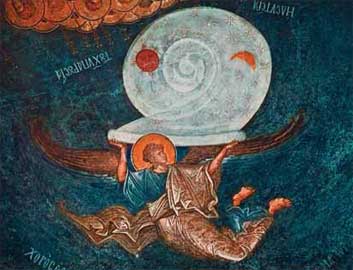 Η Δευτέρα Παρουσία: Άγγελος με το στερέωμα του ουρανού (Μονή της Χώρας).
Στο άρθρο αυτό επιχειρείται μια σύγκριση μεταξύ δύο σημαντικών έργων διαφορετικών περιόδων, αλλά με κοινό θέμα: τη ζωγραφική απεικόνιση της Δεύτερης Παρουσίας. Tο πρώτο βρίσκεται στο παρεκκλήσι της Mονής της Xώρας στην Πόλη, που είναι πιο γνωστή σαν Kαχριέ Tζαμί. Eίναι έργο ανώνυμου ζωγράφου του 14ου αιώνα (π. 1320). Ωστόσο η ανωνυμία του ζωγράφου ήτανε συνήθεια της εποχής, χωρίς να σημαίνει αναγκαστικά, όπως θα συνέβαινε σήμερα, πως ο ζωγράφος ήτανε ασήμαντος. Tο δεύτερο έργο είναι πασίγνωστο, είναι η Δεύτερη Παρουσία του Mιχαηλάγγελου στην Kαπέλλα Σιξτίνα της Pώμης, καμωμένο τον 16ο αιώνα (περί το 1540).
Mέσα από την εκτενή περιγραφή των δύο έργων ο συγγραφέας προβάλλει τις ομοιότητες και τις διαφορές τους. Kαι στα δύο, για παράδειγμα, ακολουθούνται οι ίδιες περίπου συνθετικές αρχές. Mια διάταξη σε σειρές παράλληλες, με το ενδιαφέρον επικεντρωμένο στην κεντρική μορφή του Xριστού. Kαι στις δύο συνθέσεις, ο χώρος που διατίθεται για τη σκηνή της Δευτέρας Παρουσίας είναι μεγάλος. Στην Kαπέλλα Σιξτίνα, καταλαμβάνεται ολόκληρος ο ανατολικός τοίχος. Στο παρεκκλήσι της Mονής της Xώρας ολόκληρος ο τρουλοειδής θόλος προς τ’ ανατολικά του τρούλου, τα τέσσερα λοφία του, το βορινό τύμπανο και το μισό νότιο τύμπανο. Ωστόσο ενώ στο Kαχριέ Tζαμί έχουμε να κάνουμε με σύμβολα και με τον ιδεαλισμό που χαρακτηρίζουν ολόκληρη την ελληνική Tέχνη, στην Kαπέλλα Σιξτίνα βρισκόμαστε στην περιοχή της χειροπιαστής καταγραφής των ανθρωπίνων και των γήινων συναισθημάτων.
Η Δευτέρα Παρουσία: Άγγελος με το στερέωμα του ουρανού (Μονή της Χώρας).
Στο άρθρο αυτό επιχειρείται μια σύγκριση μεταξύ δύο σημαντικών έργων διαφορετικών περιόδων, αλλά με κοινό θέμα: τη ζωγραφική απεικόνιση της Δεύτερης Παρουσίας. Tο πρώτο βρίσκεται στο παρεκκλήσι της Mονής της Xώρας στην Πόλη, που είναι πιο γνωστή σαν Kαχριέ Tζαμί. Eίναι έργο ανώνυμου ζωγράφου του 14ου αιώνα (π. 1320). Ωστόσο η ανωνυμία του ζωγράφου ήτανε συνήθεια της εποχής, χωρίς να σημαίνει αναγκαστικά, όπως θα συνέβαινε σήμερα, πως ο ζωγράφος ήτανε ασήμαντος. Tο δεύτερο έργο είναι πασίγνωστο, είναι η Δεύτερη Παρουσία του Mιχαηλάγγελου στην Kαπέλλα Σιξτίνα της Pώμης, καμωμένο τον 16ο αιώνα (περί το 1540).
Mέσα από την εκτενή περιγραφή των δύο έργων ο συγγραφέας προβάλλει τις ομοιότητες και τις διαφορές τους. Kαι στα δύο, για παράδειγμα, ακολουθούνται οι ίδιες περίπου συνθετικές αρχές. Mια διάταξη σε σειρές παράλληλες, με το ενδιαφέρον επικεντρωμένο στην κεντρική μορφή του Xριστού. Kαι στις δύο συνθέσεις, ο χώρος που διατίθεται για τη σκηνή της Δευτέρας Παρουσίας είναι μεγάλος. Στην Kαπέλλα Σιξτίνα, καταλαμβάνεται ολόκληρος ο ανατολικός τοίχος. Στο παρεκκλήσι της Mονής της Xώρας ολόκληρος ο τρουλοειδής θόλος προς τ’ ανατολικά του τρούλου, τα τέσσερα λοφία του, το βορινό τύμπανο και το μισό νότιο τύμπανο. Ωστόσο ενώ στο Kαχριέ Tζαμί έχουμε να κάνουμε με σύμβολα και με τον ιδεαλισμό που χαρακτηρίζουν ολόκληρη την ελληνική Tέχνη, στην Kαπέλλα Σιξτίνα βρισκόμαστε στην περιοχή της χειροπιαστής καταγραφής των ανθρωπίνων και των γήινων συναισθημάτων.
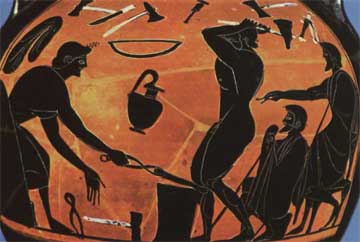 Δούλος που εργάζεται σε σιδηρουργείο.
Αν στην ομηρική εποχή θεωρείται φυσιολογικό οι βασιλείς να διεκπεραιώνουν πάσης φύσεως δουλειές, δεδομένου ότι η διαχωριστική γραμμή μεταξύ των έργων δούλων και ελεύθερων παραμένει ασαφής, δεν συμβαίνει το ίδιο στην κλασική αρχαιότητα. Την εποχή αυτή, η δουλεία θεωρείται πλέον φυσικό φαινόμενο σε όλο τον τότε γνωστό κόσμο. Ο πλούτος των αρχαίων πηγών ρίχνει αρκετό φως στο καθεστώς της δουλείας στην αρχαία Ελλάδα. Οι περισσότερες πληροφορίες αφορούν την Αθήνα, για την οποία είναι γνωστά, για παράδειγμα: ο τρόπος απόκτησης δούλων, κατηγορίες δούλων και ασχολίες τους, μεταχείριση, νομικό καθεστώς, δυνατότητες χειραφέτησης κτλ. Αν και τα στοιχεία για τη Σπάρτη και την Κρήτη είναι σαφώς λιγότερα και αποσπασματικά, εντούτοις βοηθούν ώστε να σχηματιστεί μια αρκετά καλή εικόνα για τους εκεί δούλους, δίνοντας έτσι τη δυνατότητα στο μελετητή να προβεί σε ενδιαφέρουσες συγκρίσεις μεταξύ των τριών μεγάλων πόλεων-κρατών της αρχαιότητας και να συνάγει αξιόλογα συμπεράσματα.
Δούλος που εργάζεται σε σιδηρουργείο.
Αν στην ομηρική εποχή θεωρείται φυσιολογικό οι βασιλείς να διεκπεραιώνουν πάσης φύσεως δουλειές, δεδομένου ότι η διαχωριστική γραμμή μεταξύ των έργων δούλων και ελεύθερων παραμένει ασαφής, δεν συμβαίνει το ίδιο στην κλασική αρχαιότητα. Την εποχή αυτή, η δουλεία θεωρείται πλέον φυσικό φαινόμενο σε όλο τον τότε γνωστό κόσμο. Ο πλούτος των αρχαίων πηγών ρίχνει αρκετό φως στο καθεστώς της δουλείας στην αρχαία Ελλάδα. Οι περισσότερες πληροφορίες αφορούν την Αθήνα, για την οποία είναι γνωστά, για παράδειγμα: ο τρόπος απόκτησης δούλων, κατηγορίες δούλων και ασχολίες τους, μεταχείριση, νομικό καθεστώς, δυνατότητες χειραφέτησης κτλ. Αν και τα στοιχεία για τη Σπάρτη και την Κρήτη είναι σαφώς λιγότερα και αποσπασματικά, εντούτοις βοηθούν ώστε να σχηματιστεί μια αρκετά καλή εικόνα για τους εκεί δούλους, δίνοντας έτσι τη δυνατότητα στο μελετητή να προβεί σε ενδιαφέρουσες συγκρίσεις μεταξύ των τριών μεγάλων πόλεων-κρατών της αρχαιότητας και να συνάγει αξιόλογα συμπεράσματα.
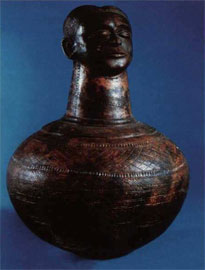 Μεγάλο αγγείο που κοσμείται με πλαστική ανθρώπινη κεφαλή και εγχαράξεις. Φυλή Αζάντε, Σουδάν.
Το άρθρο πραγματεύεται το θέμα των απαρχών της επινόησης της κεραμικής και διερευνά τους παράγοντες και τις συνθήκες που οδήγησαν στην εμφάνισή της στις ανθρώπινες κοινότητες καθώς και τα αίτια της ευρύτατης υιοθέτησής της.
Οι παράγοντες αυτοί πρέπει να αναζητηθούν στη μαγικο-θρησκευτική διάσταση της ανθρώπινης δραστηριότητας: υποστηρίζεται ότι το πρώτο ψημένο κεραμικό δεν εξυπηρετούσε πρακτικές ανάγκες, τις οποίες ικανοποιούσαν άλλωστε ποικίλα άλλα υλικά, αλλά χρησιμοποιήθηκε εξαιτίας της ίδιας της φύσης του πηλού και της συμβολικής της σχέσης ανάμεσα στο αγγείο και τη χρήση του και στο ανθρώπινο σώμα, ενώ την ίδια στιγμή το συγκεκριμένο μπορούσε να πάρει λεπτοδουλεμένα σχήματα, κατάλληλα για τελετουργική χρήση. Οι λόγοι υιοθέτησης της κεραμικής αναφέρονται στη σχετική βιβλιογραφία και αφορούν τα πλεονεκτήματα, τόσο πρακτικά όσο και οικονομικά, που παρείχε το κεραμικό αγγείο.
Τέλος, η γεωργία και η μόνιμη εγκατοίκηση ευνόησαν την υιοθέτηση αυτού του νεωτερισμού.
Μεγάλο αγγείο που κοσμείται με πλαστική ανθρώπινη κεφαλή και εγχαράξεις. Φυλή Αζάντε, Σουδάν.
Το άρθρο πραγματεύεται το θέμα των απαρχών της επινόησης της κεραμικής και διερευνά τους παράγοντες και τις συνθήκες που οδήγησαν στην εμφάνισή της στις ανθρώπινες κοινότητες καθώς και τα αίτια της ευρύτατης υιοθέτησής της.
Οι παράγοντες αυτοί πρέπει να αναζητηθούν στη μαγικο-θρησκευτική διάσταση της ανθρώπινης δραστηριότητας: υποστηρίζεται ότι το πρώτο ψημένο κεραμικό δεν εξυπηρετούσε πρακτικές ανάγκες, τις οποίες ικανοποιούσαν άλλωστε ποικίλα άλλα υλικά, αλλά χρησιμοποιήθηκε εξαιτίας της ίδιας της φύσης του πηλού και της συμβολικής της σχέσης ανάμεσα στο αγγείο και τη χρήση του και στο ανθρώπινο σώμα, ενώ την ίδια στιγμή το συγκεκριμένο μπορούσε να πάρει λεπτοδουλεμένα σχήματα, κατάλληλα για τελετουργική χρήση. Οι λόγοι υιοθέτησης της κεραμικής αναφέρονται στη σχετική βιβλιογραφία και αφορούν τα πλεονεκτήματα, τόσο πρακτικά όσο και οικονομικά, που παρείχε το κεραμικό αγγείο.
Τέλος, η γεωργία και η μόνιμη εγκατοίκηση ευνόησαν την υιοθέτηση αυτού του νεωτερισμού.
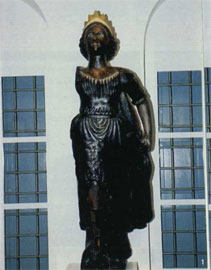 Γενική άποψη του ακρόπρωρου, στη θέση που τοποθετήθηκε μετά τη συντήρησή του, στο νέο Ναυτικό Μουσείο Γαλαξειδίου.
Τα ακρόπρωρα είναι ξύλινα γλυπτά τα οποία τοποθετούσαν στην πλώρη των πλοίων, στο ανώτερο τμήμα του ξύλου που αποτελεί τη συνέχεια της καρένας. Είναι έργα της ναυτικής λαϊκής ξυλογλυπτικής, με διάφορες αναπαραστάσεις και απεικόνιζαν συχνά ήρωες από την ελληνική ιστορία (όπως από την Ελληνική Επανάσταση) ή από τη μυθολογία (όπως τις γοργόνες), επηρεαζόμενοι από το φόβο των ανθρώπων για το άγνωστο και την προσπάθεια υπέρβασης του φόβου αυτού. Με τα ακρόπρωρα του 18ου και του 19ου αιώνα προσανατολιζόμαστε σε μεγέθη μιας μνημειώδους γλυπτικής, η οποία είναι ασυνήθιστη για την ελληνική λαϊκή τέχνη. Τα σωζόμενα ακρόπρωρα ανήκουν στις συλλογές των ιστορικών και ναυτικών μουσείων, ενώ ένας σημαντικός αριθμός βρίσκεται σε ιδιωτικές συλλογές.
Το ακρόπρωρο που μελετάμε βρίσκεται στο Ναυτικό Μουσείο Γαλαξειδίου, το αρχαιότερο ναυτικό μουσείο της Ελλάδας, και εικονίζει μια όρθια γυναικεία μορφή, χρωματισμένη με μαύρο χρώμα, που φοράει ολόσωμο μαύρο ένδυμα, φέρει κορόνα στο κεφάλι και στηρίζεται σε ξύλινη βάση με προβολή του δεξιού ποδιού εμπρός και του αριστερού πίσω.
Το θέμα της παρούσας μελέτης είναι η διαπίστωση υποκείμενων χρωματικών στρωμάτων και η καταγραφή τους μέσα από στρωματογραφική παρατήρηση. Αυτό κατέστη δυνατό με δημιουργία δειγμάτων που πραγματοποιήθηκε σε περιοχές που ήταν αντιπροσωπευτικές του συνόλου του γλυπτού από τις οποίες θα μπορούσε κανείς να αποκομίσει μια γενική εντύπωση για την όψη του κατά τις διάφορες χρωματικές επεμβάσεις. Αποτέλεσμα της έρευνας ήταν η διαπίστωση χρωματικών στρωμάτων κάτω από το μαύρο χρώμα που επιβεβαιώνει τη μαρτυρία ότι μετά το θάνατο του πλοιοκτήτη, λόγω πένθους, έβαψαν το ακρόπρωρο του πλοίου του και τα παραθυρόφυλλα του σπιτιού του με μαύρο χρώμα.
Γενική άποψη του ακρόπρωρου, στη θέση που τοποθετήθηκε μετά τη συντήρησή του, στο νέο Ναυτικό Μουσείο Γαλαξειδίου.
Τα ακρόπρωρα είναι ξύλινα γλυπτά τα οποία τοποθετούσαν στην πλώρη των πλοίων, στο ανώτερο τμήμα του ξύλου που αποτελεί τη συνέχεια της καρένας. Είναι έργα της ναυτικής λαϊκής ξυλογλυπτικής, με διάφορες αναπαραστάσεις και απεικόνιζαν συχνά ήρωες από την ελληνική ιστορία (όπως από την Ελληνική Επανάσταση) ή από τη μυθολογία (όπως τις γοργόνες), επηρεαζόμενοι από το φόβο των ανθρώπων για το άγνωστο και την προσπάθεια υπέρβασης του φόβου αυτού. Με τα ακρόπρωρα του 18ου και του 19ου αιώνα προσανατολιζόμαστε σε μεγέθη μιας μνημειώδους γλυπτικής, η οποία είναι ασυνήθιστη για την ελληνική λαϊκή τέχνη. Τα σωζόμενα ακρόπρωρα ανήκουν στις συλλογές των ιστορικών και ναυτικών μουσείων, ενώ ένας σημαντικός αριθμός βρίσκεται σε ιδιωτικές συλλογές.
Το ακρόπρωρο που μελετάμε βρίσκεται στο Ναυτικό Μουσείο Γαλαξειδίου, το αρχαιότερο ναυτικό μουσείο της Ελλάδας, και εικονίζει μια όρθια γυναικεία μορφή, χρωματισμένη με μαύρο χρώμα, που φοράει ολόσωμο μαύρο ένδυμα, φέρει κορόνα στο κεφάλι και στηρίζεται σε ξύλινη βάση με προβολή του δεξιού ποδιού εμπρός και του αριστερού πίσω.
Το θέμα της παρούσας μελέτης είναι η διαπίστωση υποκείμενων χρωματικών στρωμάτων και η καταγραφή τους μέσα από στρωματογραφική παρατήρηση. Αυτό κατέστη δυνατό με δημιουργία δειγμάτων που πραγματοποιήθηκε σε περιοχές που ήταν αντιπροσωπευτικές του συνόλου του γλυπτού από τις οποίες θα μπορούσε κανείς να αποκομίσει μια γενική εντύπωση για την όψη του κατά τις διάφορες χρωματικές επεμβάσεις. Αποτέλεσμα της έρευνας ήταν η διαπίστωση χρωματικών στρωμάτων κάτω από το μαύρο χρώμα που επιβεβαιώνει τη μαρτυρία ότι μετά το θάνατο του πλοιοκτήτη, λόγω πένθους, έβαψαν το ακρόπρωρο του πλοίου του και τα παραθυρόφυλλα του σπιτιού του με μαύρο χρώμα.
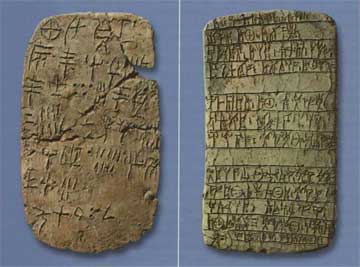 Πήλινες πινακίδες με σημεία της Γραμμικής Α (αριστερά) και της Γραμμικής Β (δεξιά).
Η παρούσα μελέτη για την ανακάλυψη, τη διατήρηση, την έρευνα και τη διάδοση αρχαίων κειμένων βασίζεται σε δεδομένα του 20ού αιώνα.
Το 1953, η είδηση πως ο Michael Ventris και ο John Chadwick αποκωδικοποίησαν τη γραφή των πήλινων πινακίδων που βρέθηκαν από το 1900 και ύστερα στην Κνωσσό, την Αργολίδα, τις Μυκήνες, την Τίρυνθα και την Πήλο, τάραξε τα νερά στους χώρους των αρχαιολόγων, των φιλόλογων και των γλωσσολόγων. Οι Ventris και Chadwick ανέτρεψαν τις ποικίλες θεωρίες για την ύπαρξη οκτώ διαφορετικών διαλέκτων και απέδειξαν ότι η επονομαζόμενη Γραμμική Β ήταν η «μυκηναϊκή», δηλαδή η πρώτη ελληνική διάλεκτος. Σε συνέπεια των συμπερασμάτων τους, η πρώτη εμφάνιση της ελληνικής γραφής τοποθετήθηκε χρονολογικά πολλούς αιώνες νωρίτερα. Οι χιλιάδες πινακίδες, ωστόσο, δεν περιλάμβαναν κείμενα της ελληνικής λογοτεχνίας, αλλά ήταν αρχειακού ενδιαφέροντος. Δυστυχώς, μικρό μόνο μέρος της αρχαίας ελληνικής λογοτεχνίας έφτασε ως εμάς. Για παράδειγμα, έχει σωθεί μόνο το 3% από τις 1200 κωμωδίες και τραγωδίες που παίχθηκαν στα θέατρα του πέμπτου και του τέταρτου αιώνα π.Χ. Τα αρχαία μνημεία –ναοί, στοές και θέατρα-, που φέρνουν στο φως οι ανασκαφές, παρ’ όλη τη φθορά που έχουν υποστεί, παραμένουν αυθεντικά, σε αντίθεση με τα κείμενα της αρχαίας γραμματείας τα οποία πέρασαν από αντιγραφή σε αντιγραφή προτού φτάσουν στα χέρια μας. Πολλά από αυτά τα αντίγραφα, που συχνά χρονολογούνται χιλιάδες χρόνια μετά το θάνατο των δημιουργών τους, ανακαλύφθηκαν σε μοναστικές βιβλιοθήκες της μεσαιωνικής περιόδου. Τα επτά από τα ενενήντα θεατρικά έργα του Αισχύλου τα γνωρίζουμε από τα βυζαντινά τους αντίγραφα, ενώ η αρχαιότερη πλήρης μαρτυρία που έχουμε για τον Όμηρο χρονολογείται στα μέσα του 10ου αιώνα.
Η ανακάλυψη, η διατήρηση και η μελέτη των κειμένων της αρχαίας ελληνικής γραμματείας επεφύλασσε πολλές εκπλήξεις, όπως οι πάπυροι που βρέθηκαν στην έρημο της Αιγύπτου, όπου σώζονταν κείμενα της αρχαϊκής, της κλασικής και της ελληνιστικής Ελλάδας, ή η επικούρεια βιβλιοθήκη που βρέθηκε στο Herculaneum, και η οποία είχε θαφτεί με την έκρηξη του Βεζούβιου το 79 μ.Χ.
Οι νέες τεχνολογίες στη φωτογραφία, όπως η πολυφασματική τεχνική, και στην πληροφορική αναμφισβήτητα διευκολύνουν την ανάγνωση και την αποκατάσταση κειμένων, είτε διορθώνοντας λάθη που παρεισέφρησαν κατά την αντιγραφή τους είτε απαλείφοντας πιθανές παρερμηνείες.
Πήλινες πινακίδες με σημεία της Γραμμικής Α (αριστερά) και της Γραμμικής Β (δεξιά).
Η παρούσα μελέτη για την ανακάλυψη, τη διατήρηση, την έρευνα και τη διάδοση αρχαίων κειμένων βασίζεται σε δεδομένα του 20ού αιώνα.
Το 1953, η είδηση πως ο Michael Ventris και ο John Chadwick αποκωδικοποίησαν τη γραφή των πήλινων πινακίδων που βρέθηκαν από το 1900 και ύστερα στην Κνωσσό, την Αργολίδα, τις Μυκήνες, την Τίρυνθα και την Πήλο, τάραξε τα νερά στους χώρους των αρχαιολόγων, των φιλόλογων και των γλωσσολόγων. Οι Ventris και Chadwick ανέτρεψαν τις ποικίλες θεωρίες για την ύπαρξη οκτώ διαφορετικών διαλέκτων και απέδειξαν ότι η επονομαζόμενη Γραμμική Β ήταν η «μυκηναϊκή», δηλαδή η πρώτη ελληνική διάλεκτος. Σε συνέπεια των συμπερασμάτων τους, η πρώτη εμφάνιση της ελληνικής γραφής τοποθετήθηκε χρονολογικά πολλούς αιώνες νωρίτερα. Οι χιλιάδες πινακίδες, ωστόσο, δεν περιλάμβαναν κείμενα της ελληνικής λογοτεχνίας, αλλά ήταν αρχειακού ενδιαφέροντος. Δυστυχώς, μικρό μόνο μέρος της αρχαίας ελληνικής λογοτεχνίας έφτασε ως εμάς. Για παράδειγμα, έχει σωθεί μόνο το 3% από τις 1200 κωμωδίες και τραγωδίες που παίχθηκαν στα θέατρα του πέμπτου και του τέταρτου αιώνα π.Χ. Τα αρχαία μνημεία –ναοί, στοές και θέατρα-, που φέρνουν στο φως οι ανασκαφές, παρ’ όλη τη φθορά που έχουν υποστεί, παραμένουν αυθεντικά, σε αντίθεση με τα κείμενα της αρχαίας γραμματείας τα οποία πέρασαν από αντιγραφή σε αντιγραφή προτού φτάσουν στα χέρια μας. Πολλά από αυτά τα αντίγραφα, που συχνά χρονολογούνται χιλιάδες χρόνια μετά το θάνατο των δημιουργών τους, ανακαλύφθηκαν σε μοναστικές βιβλιοθήκες της μεσαιωνικής περιόδου. Τα επτά από τα ενενήντα θεατρικά έργα του Αισχύλου τα γνωρίζουμε από τα βυζαντινά τους αντίγραφα, ενώ η αρχαιότερη πλήρης μαρτυρία που έχουμε για τον Όμηρο χρονολογείται στα μέσα του 10ου αιώνα.
Η ανακάλυψη, η διατήρηση και η μελέτη των κειμένων της αρχαίας ελληνικής γραμματείας επεφύλασσε πολλές εκπλήξεις, όπως οι πάπυροι που βρέθηκαν στην έρημο της Αιγύπτου, όπου σώζονταν κείμενα της αρχαϊκής, της κλασικής και της ελληνιστικής Ελλάδας, ή η επικούρεια βιβλιοθήκη που βρέθηκε στο Herculaneum, και η οποία είχε θαφτεί με την έκρηξη του Βεζούβιου το 79 μ.Χ.
Οι νέες τεχνολογίες στη φωτογραφία, όπως η πολυφασματική τεχνική, και στην πληροφορική αναμφισβήτητα διευκολύνουν την ανάγνωση και την αποκατάσταση κειμένων, είτε διορθώνοντας λάθη που παρεισέφρησαν κατά την αντιγραφή τους είτε απαλείφοντας πιθανές παρερμηνείες.
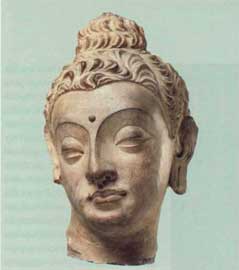 Κεφαλή του Βούδα από ασβεστοκονίαμα, χαρακτηριστικό δείγμα της τέχνης της Γκαντάρα, 4ος-5ος αι. μ.Χ.
Η τέχνη της Γκαντάρα –που στα σανσκριτικά σημαίνει ευωδιασμένη γη– παρουσιάζει πολλά δυτικά στοιχεία, αν και η ύπαρξη επαφών της περιοχής αυτής με τον δυτικό κόσμο υπήρξε πάντοτε ζήτημα περίπλοκο και αμφιλεγόμενο. H φύση και η έκταση της επιρροής της Δύσης στην τέχνη της Γκαντάρα αποτέλεσε μάλιστα θέμα διαμάχης, από την εποχή της αποκάλυψής της. Tα ερωτήματα που τέθηκαν πολλά: η επιρροή της Δύσης υπήρξε άμεση ή έμμεση; Περιορίστηκε σε μια μόνο, επεκτάθηκε σε μερικές, ή διείσδυσε σε όλες τις εκφάνσεις της τέχνης της Γκαντάρα; Εάν πάλι η δυτική επιρροή ήταν άμεση, πώς ακριβώς έδρασε; Και με ποιον τρόπο άλλοι σύγχρονοί της πολιτισμοί, όπως ο ρωμαϊκός, ο βυζαντινός, ο σκυθικός, ο παρθικός, ο σασσανιδικός κ.ά., επηρέασαν την εισροή των δυτικών επιδράσεων; Kαι τα ερωτήματα συνεχίζονται: η δυτική επίδραση στην τέχνη της Γκαντάρα υπήρξε καθαρά ελληνική, ελληνο-ρωμαϊκή, περσο-ελληνο-ρωμαϊκή ή ινδο-ελληνο-ρωμαϊκή; Kυρίως όμως, ποιο ήταν το ανώτερο και κατώτερο χρονικό όριο της αρχαίας Γκαντάρα και ποιο είναι το χρονολογικό πλαίσιο μέσα στο οποίο πρέπει να εξεταστεί η δυτική επιρροή πάνω στην τέχνη της; Οι απαντήσεις σε αυτές τις απορίες είναι πολύπλοκες και αμφίσημες· εξαρτώνται από την οπτική γωνία του ερευνητή, που καλείται να απαντήσει στο συγκεκριμένο ερώτημα από σκοπιά είτε «δυτική» (ελληνική ή ρωμαϊκή) είτε «ανατολική» (ινδική, περσική ή κεντρο-ασιατική). Eδώ γίνεται μια προσπάθεια να απαντηθούν όλες αυτές οι ερωτήσεις, τονίζουμε ωστόσο ότι σε τόσο περιορισμένο χώρο αυτό δεν είναι δυνατό παρά μόνο κατά γενικό τρόπο και κατά περίπτωση.
Κεφαλή του Βούδα από ασβεστοκονίαμα, χαρακτηριστικό δείγμα της τέχνης της Γκαντάρα, 4ος-5ος αι. μ.Χ.
Η τέχνη της Γκαντάρα –που στα σανσκριτικά σημαίνει ευωδιασμένη γη– παρουσιάζει πολλά δυτικά στοιχεία, αν και η ύπαρξη επαφών της περιοχής αυτής με τον δυτικό κόσμο υπήρξε πάντοτε ζήτημα περίπλοκο και αμφιλεγόμενο. H φύση και η έκταση της επιρροής της Δύσης στην τέχνη της Γκαντάρα αποτέλεσε μάλιστα θέμα διαμάχης, από την εποχή της αποκάλυψής της. Tα ερωτήματα που τέθηκαν πολλά: η επιρροή της Δύσης υπήρξε άμεση ή έμμεση; Περιορίστηκε σε μια μόνο, επεκτάθηκε σε μερικές, ή διείσδυσε σε όλες τις εκφάνσεις της τέχνης της Γκαντάρα; Εάν πάλι η δυτική επιρροή ήταν άμεση, πώς ακριβώς έδρασε; Και με ποιον τρόπο άλλοι σύγχρονοί της πολιτισμοί, όπως ο ρωμαϊκός, ο βυζαντινός, ο σκυθικός, ο παρθικός, ο σασσανιδικός κ.ά., επηρέασαν την εισροή των δυτικών επιδράσεων; Kαι τα ερωτήματα συνεχίζονται: η δυτική επίδραση στην τέχνη της Γκαντάρα υπήρξε καθαρά ελληνική, ελληνο-ρωμαϊκή, περσο-ελληνο-ρωμαϊκή ή ινδο-ελληνο-ρωμαϊκή; Kυρίως όμως, ποιο ήταν το ανώτερο και κατώτερο χρονικό όριο της αρχαίας Γκαντάρα και ποιο είναι το χρονολογικό πλαίσιο μέσα στο οποίο πρέπει να εξεταστεί η δυτική επιρροή πάνω στην τέχνη της; Οι απαντήσεις σε αυτές τις απορίες είναι πολύπλοκες και αμφίσημες· εξαρτώνται από την οπτική γωνία του ερευνητή, που καλείται να απαντήσει στο συγκεκριμένο ερώτημα από σκοπιά είτε «δυτική» (ελληνική ή ρωμαϊκή) είτε «ανατολική» (ινδική, περσική ή κεντρο-ασιατική). Eδώ γίνεται μια προσπάθεια να απαντηθούν όλες αυτές οι ερωτήσεις, τονίζουμε ωστόσο ότι σε τόσο περιορισμένο χώρο αυτό δεν είναι δυνατό παρά μόνο κατά γενικό τρόπο και κατά περίπτωση.
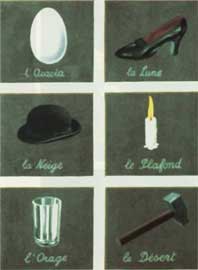 Ρενέ Μαγκρίτ, "Η ερμηνεία των ονείρων" (1930).
H «εκπαίδευση του βλέμματος» έχει αναδειχτεί τις τελευταίες δεκαετίες σε έναν από τους κύριους στόχους όλων των μουσειοπαιδαγωγικών δραστηριοτήτων στα μουσεία, τις πινακοθήκες, τους αρχαιολογικούς χώρους, αλλά και γενικότερα σε μέλημα όλων όσοι στις αίθουσες διδασκαλίας, από το νηπιαγωγείο ως την τριτοβάθμια εκπαίδευση, ενδιαφέρονται για τη διδακτική της τέχνης και του πολιτισμού.
To βιβλίο του ποιητή και ζωγράφου Ανρί Μισώ (Henri Michaux), En rêvant à partir des peintures énigmatiques, αποτελεί ένα πετυχημένο παράδειγμα εκπαίδευσης του βλέμματος στην πρόσληψη των οπτικών μορφών. Πέρα από την αναμφισβήτητη λογοτεχνική του αξία, το βιβλίο προσφέρει μια υποδειγματική περιγραφή έργων τέχνης –λογοτεχνικό είδος γνωστό από την αρχαιότητα-, αλλά και μια πρόταση δημιουργικής πρόσληψης εικαστικών μορφών γενικότερα. Η προσεκτική του ανάγνωση αποκαλύπτει ότι για τη διαδικασία της επικοινωνίας με ένα έργο, και μάλιστα όχι μόνο εικαστικό, δεν είναι απαραίτητες οι προϋπάρχουσες γνώσεις και πληροφορίες που το αφορούν, το ίδιο ή τον δημιουργό του, ούτε η εξειδικευμένη ορολογία, αλλά η δεκτικότητα και ασκημένες αισθήσεις.
Ρενέ Μαγκρίτ, "Η ερμηνεία των ονείρων" (1930).
H «εκπαίδευση του βλέμματος» έχει αναδειχτεί τις τελευταίες δεκαετίες σε έναν από τους κύριους στόχους όλων των μουσειοπαιδαγωγικών δραστηριοτήτων στα μουσεία, τις πινακοθήκες, τους αρχαιολογικούς χώρους, αλλά και γενικότερα σε μέλημα όλων όσοι στις αίθουσες διδασκαλίας, από το νηπιαγωγείο ως την τριτοβάθμια εκπαίδευση, ενδιαφέρονται για τη διδακτική της τέχνης και του πολιτισμού.
To βιβλίο του ποιητή και ζωγράφου Ανρί Μισώ (Henri Michaux), En rêvant à partir des peintures énigmatiques, αποτελεί ένα πετυχημένο παράδειγμα εκπαίδευσης του βλέμματος στην πρόσληψη των οπτικών μορφών. Πέρα από την αναμφισβήτητη λογοτεχνική του αξία, το βιβλίο προσφέρει μια υποδειγματική περιγραφή έργων τέχνης –λογοτεχνικό είδος γνωστό από την αρχαιότητα-, αλλά και μια πρόταση δημιουργικής πρόσληψης εικαστικών μορφών γενικότερα. Η προσεκτική του ανάγνωση αποκαλύπτει ότι για τη διαδικασία της επικοινωνίας με ένα έργο, και μάλιστα όχι μόνο εικαστικό, δεν είναι απαραίτητες οι προϋπάρχουσες γνώσεις και πληροφορίες που το αφορούν, το ίδιο ή τον δημιουργό του, ούτε η εξειδικευμένη ορολογία, αλλά η δεκτικότητα και ασκημένες αισθήσεις.
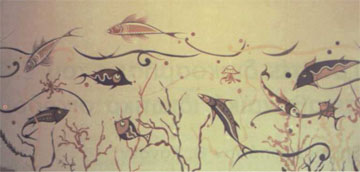 Θαλάσσιος ρυθμός, 1977. Χαμένη τοιχογραφία. Village Inn, Πόρτο Καρράς (φωτοθήκη Μουσείου Γιαλούρη).
Το Μουσείο του ζωγράφου και χαράκτη Νικολάου Γιαλούρη (1928-2003) στη χώρα της Χίου (Ελευθερίου Βενιζέλου 73) στεγάζεται στο νεοκλασσικίζον κτήριο της Παλαιάς Περιηγητικής από το προηγούμενο καλοκαίρι. Ογδόντα έργα του μεγάλου Χιώτη καλλιτέχνη εκτίθενται στον όροφο και στην εσωτερική κλίμακα του οικοδομήματος. Χαρακτικά, ακρυλικά, παστέλ και έργα σινικής μελάνης αντιπροσωπεύουν τους δημιουργικούς του κύκλους.
Θαλάσσιος ρυθμός, 1977. Χαμένη τοιχογραφία. Village Inn, Πόρτο Καρράς (φωτοθήκη Μουσείου Γιαλούρη).
Το Μουσείο του ζωγράφου και χαράκτη Νικολάου Γιαλούρη (1928-2003) στη χώρα της Χίου (Ελευθερίου Βενιζέλου 73) στεγάζεται στο νεοκλασσικίζον κτήριο της Παλαιάς Περιηγητικής από το προηγούμενο καλοκαίρι. Ογδόντα έργα του μεγάλου Χιώτη καλλιτέχνη εκτίθενται στον όροφο και στην εσωτερική κλίμακα του οικοδομήματος. Χαρακτικά, ακρυλικά, παστέλ και έργα σινικής μελάνης αντιπροσωπεύουν τους δημιουργικούς του κύκλους.
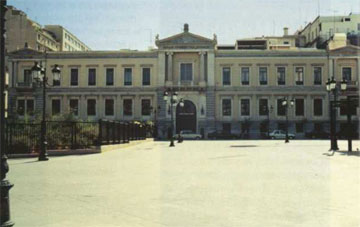 Το κτίριο της Εθνικής Τράπεζας, που προήλθε από τη συνένωση ιδιωτικών κατοικιών.
Tο παρόν άρθρο αποτελεί συνέχεια προηγούμενου, που είχε θέμα την προσωρινή στέγαση των δημόσιων λειτουργιών της Aθήνας από το 1834 ως το 1862. Eνώ λοιπόν κατά την πρώτη αυτή περίοδο οι δημόσιες λειτουργίες στεγάζονταν σε προεπαναστατικά κυρίως κτίρια, επί της βασιλείας του Γεωργίου A΄ χρησιμοποιούνται συχνά δημόσια κτίρια που είχαν οικοδομηθεί για άλλη χρήση. Aυτό συνέβη γιατί ο οικοδομικός προγραμματισμός της οθωνικής βασιλείας βασίστηκε κυρίως σε ιδεολογικά κριτήρια, αγνοώντας τις πραγματικές ανάγκες.
Το κτίριο της Εθνικής Τράπεζας, που προήλθε από τη συνένωση ιδιωτικών κατοικιών.
Tο παρόν άρθρο αποτελεί συνέχεια προηγούμενου, που είχε θέμα την προσωρινή στέγαση των δημόσιων λειτουργιών της Aθήνας από το 1834 ως το 1862. Eνώ λοιπόν κατά την πρώτη αυτή περίοδο οι δημόσιες λειτουργίες στεγάζονταν σε προεπαναστατικά κυρίως κτίρια, επί της βασιλείας του Γεωργίου A΄ χρησιμοποιούνται συχνά δημόσια κτίρια που είχαν οικοδομηθεί για άλλη χρήση. Aυτό συνέβη γιατί ο οικοδομικός προγραμματισμός της οθωνικής βασιλείας βασίστηκε κυρίως σε ιδεολογικά κριτήρια, αγνοώντας τις πραγματικές ανάγκες.
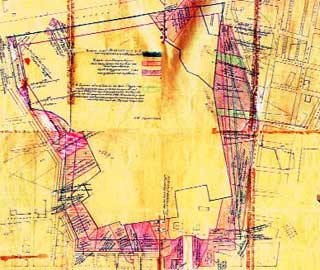 Σχέδιο του Α
Σχέδιο του Α
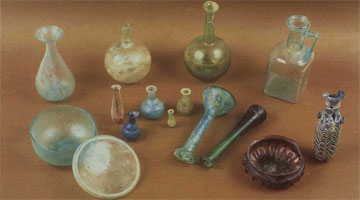 Γυάλινα αγγεία από το ρωμαϊκό νεκροταφείο της Σάμης.
Παρουσίαση του Αρχαιολογικού Μουσείου Αργοστολίου Κεφαλονιάς, της ιστορίας του, της ιστορίας του νησιού, των παλαιότερων και νεότερων ευρημάτων που εκτίθενται στις αίθουσες του Μουσείου.
Γυάλινα αγγεία από το ρωμαϊκό νεκροταφείο της Σάμης.
Παρουσίαση του Αρχαιολογικού Μουσείου Αργοστολίου Κεφαλονιάς, της ιστορίας του, της ιστορίας του νησιού, των παλαιότερων και νεότερων ευρημάτων που εκτίθενται στις αίθουσες του Μουσείου.
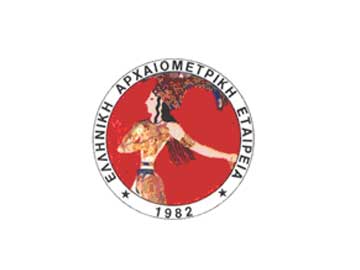 Το λογότυπο της Ελληνικής Αρχαιομετρικής Εταιρείας
Στα Αρχαιομετρικά Νέα αυτού του τεύχους μπορείτε να διαβάσετε:
-Νέο Δοικητικό Συμβούλιο της Ελληνικής Αρχαιομετρικής Εταιρείας
-Το Ι´ Διεθνές Κρητολογικό Συνέδριο
-Η ελαία στην προϊστορική Κρήτη
-Οι προοπτικές χρηματοδοτήσεων ερευνητικών προγραμμάτων
-Το περιοδικό Mediterranean Archaeology and Archaeometry
Το λογότυπο της Ελληνικής Αρχαιομετρικής Εταιρείας
Στα Αρχαιομετρικά Νέα αυτού του τεύχους μπορείτε να διαβάσετε:
-Νέο Δοικητικό Συμβούλιο της Ελληνικής Αρχαιομετρικής Εταιρείας
-Το Ι´ Διεθνές Κρητολογικό Συνέδριο
-Η ελαία στην προϊστορική Κρήτη
-Οι προοπτικές χρηματοδοτήσεων ερευνητικών προγραμμάτων
-Το περιοδικό Mediterranean Archaeology and Archaeometry
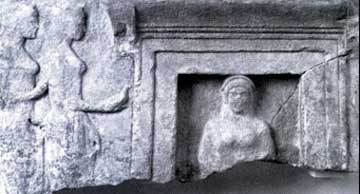 Το ανάγλυφο της Θάσου
Ειδήσεις: Οι ανασκαφές των Δανών, Ο μηχανισμός των Αντικυθήρων, Κεραμικό εργαστήριο στο Κιλκίς, Συνεχείς αποκαλύψεις στη Λάρισα, Δίον Πιερίας, Αποκρυπτογράφηση του DNA, Ανοιχτό το Αρχαιολογικό Μουσείο Θεσσαλονίκης, Οι βασιλικοί τάφοι της Βεργίνας κ.ά.
Εκθέσεις: Το Μουσείο και η Ανασκαφή, Η Κίνα των Tang, Περί αρχαιοκαπηλίας, Πολιτισμός 42 αιώνων από τον βυθό, Φωτογραφικό οδοιπορικό στο Άγιον Όρος, Λατρείας Τάματα κ.ά.
Συνέδρια: Για τα 100 χρόνια ανασκαφών στον Πρινιά, Το Κέντρον Ερεύνης Ελληνικής Λαογραφίας και η επιτόπια έρευνα, Οι ανασκαφές στην Αγορά από την Αμερικανική Σχολή.
Διαλέξεις: Τα έργα στην Ακρόπολη, Βελγική Σχολή, Η οικονομία των βυζαντινών πόλεων κ.ά.
Βιβλία: L’Architecture Grecque / 2. Architecture Religieuse et Funéraire, Marie-Christine Hellmann, Ο θάνατος και οι θρησκείες, John Bowker, Η πορνεία στην Ελλάδα και στη Ρώμη, Violaine Vanoyeke κ.ά.
Το ανάγλυφο της Θάσου
Ειδήσεις: Οι ανασκαφές των Δανών, Ο μηχανισμός των Αντικυθήρων, Κεραμικό εργαστήριο στο Κιλκίς, Συνεχείς αποκαλύψεις στη Λάρισα, Δίον Πιερίας, Αποκρυπτογράφηση του DNA, Ανοιχτό το Αρχαιολογικό Μουσείο Θεσσαλονίκης, Οι βασιλικοί τάφοι της Βεργίνας κ.ά.
Εκθέσεις: Το Μουσείο και η Ανασκαφή, Η Κίνα των Tang, Περί αρχαιοκαπηλίας, Πολιτισμός 42 αιώνων από τον βυθό, Φωτογραφικό οδοιπορικό στο Άγιον Όρος, Λατρείας Τάματα κ.ά.
Συνέδρια: Για τα 100 χρόνια ανασκαφών στον Πρινιά, Το Κέντρον Ερεύνης Ελληνικής Λαογραφίας και η επιτόπια έρευνα, Οι ανασκαφές στην Αγορά από την Αμερικανική Σχολή.
Διαλέξεις: Τα έργα στην Ακρόπολη, Βελγική Σχολή, Η οικονομία των βυζαντινών πόλεων κ.ά.
Βιβλία: L’Architecture Grecque / 2. Architecture Religieuse et Funéraire, Marie-Christine Hellmann, Ο θάνατος και οι θρησκείες, John Bowker, Η πορνεία στην Ελλάδα και στη Ρώμη, Violaine Vanoyeke κ.ά.
The first writers to justify suicide were Kalvos and Solomos. Vizyinos, Papadiamantis and Metsakes were pioneers in the “anthology of suicide”. The “Dance of Zalongos” proved to be an ideology and a national monument. Since the 1900s Greek newspapers have noted instances of suicide. Following their previous discussions on the suicides Karyotakis, Giannopoulos, Lapathiotes, Sikoutris and Penelope Delta, a group of psychoanalysts discusses the death wish as pathogenic, in the last act of the play “Ideal Suicides”. “Atzesivanus’ Suicide” a sonnet by Sikelianos. Rembetika songs and pre war amanedes, a composition by George Zambetas. The painter Akrithakes: How does he relate to the poet Karyotakis?
Attempting to define a suicidal tradition in our modern literature, apart from Kalvos’ and Solomos’ advocacy and the contribution of the “morbid Romanticism” of the school of Athens, we paradoxically trace a strong self-destructive stigma in the texts of the short –story triad of writers (Vizyinos, Papadiamantis, Mitsakis), the notorious “Generation of the 80’s”, the generation of healthy genre literature. Michail Mitsakis’ Suicide (1895) highlights suicide in counterpoint to the itinerant mood of the text: the narrator lingers about Patras and gives a precise description of whatever his greedy sight devours, while his thought is constantly pestered by the enigma of the suicide committed in the hotel he stays. The hammering of his mind by the last words of the perpetrator becomes continuously stronger and essentially imposes the rhythm in this evocative setting. A few years earlier (1891) Alexandros Papadiamantis announces the Suicide, one of his short-stories, which, however, was not published until much later. Self-censorship or other conjuctions? In any case, the presence of later textsin his oeuvre dealing with suicide allow us to consider that the writer from Skiathos island (and masterly translator of Dostoevsky) also fell under the spell of the subject. Even later, in the early 1880’s, Georgios Vizyinos deals with the self-destructive end of an ill-fated erotic couple in his work Consequences of an old story: we follow here how languish and melancholy lead slowly, methodically and inevitably to the threshold of the (redeeming) death. Thus, the phantasm of suicide hovers decisively over the young short-story writing, which, already in the early nine-teenth century, will change radically the landscape of Modern Greek prose, by creating the technical, rhetoric and thematic prerequisites of a literary modernism already in the nineteenth century.
A half-finished short story, in draft form, by Papadiamantis , has just been published. Originally, it was to have been published in the “Ephimeris” (Newspaper) of 1891. Two years earlier, the “Ephimeris” had published “Crime and Punishment” translated by Papadiamantis, thus “introducing” Dostoevsky to Greek letters. Was Papadiamantis drawn to the writing of his story by his constant proximity and familiarity with the Russian author who was so obsessed with suicide? As in the case of Metsakes’ story, Papadiamantis’ hero is a foreigner, an outsider to local society and its mentality who does not permit himself to disturb the world after his death. At the end of “The Suicide”, Papadiamantis links the act of suicide to madness.
The article focuses on the decision of the women of Souli who, as it is surmised, were led up to death “singing and dancing… either repelled to the edge of the precipice by the retreating fighters or by their own decision rather to die voluntarily along their children than to suffer a painful bloodshed and captivity”. This incident is historically known as “the dance of Zaloggon”. The objective of the article is to investigate the dual aspect of this dance phenomenon, both as content and performance. Therefore, it deals with three dramatized examples, the version of a school presentation, a theatrical performance directed by Spyridon Peresiadis and a respective film production by Stelios Tatasopoulos, and seeks to set them in a space/time framework, so that the impact of the dance of Zaloggon on modern Greek society to be revealed and defined.
This article is the last act of a play after my book Ideal Suicides and refers to the five most important suicides-literary men of modern Greek literature: Kostas Karyotakis, Periklis Giannopoulos, Napoleon Lapathiotis, Ioannis Sykoutris and Penelopi Delta. It is essentially a discussion among five famous psychoanalysts of another time on the issue of suicide, which is based on the information supplied by my book as well ason my views on this topic.
Tragic poetry is the first to record cases of suicide in antiquity. The research we have attempted through the newspaper issues, as regards both the actual incidents and the problematic on the handling of the phenomenon, has led us to the following conclusion: it is equally difficult the reasons leading to a suicide to be intentified, since they differ from individual, as it is impossible general advice or methods to be proposed for the prevention of committing suicide. How the suicide of Periklis Giannopoulos, Kostas Karyotakis, Penelopi Delta, Ioannis Sykoutris can be explained? In spite of the relevant elucidation furnished by some of them, many unanswered questions still remain. Society has always faced suicide with reserve, if not with irony! Already in the late nineteenth century Emile Durkheim, who has dealt thoroughly with the phenomenon in his book Social reasons of of suicide and has tried both to discover the reasons of suicide and to determine the share of responsibility belonging to society, admits that something deeper and entirely personal drives an individual to take his own life. Modern societies have organized congress and centers for uplifting the moral and have analyzed the psychological and psychosomatic reasons. Nevertheless, the statistics continue to record an increasing tendency for suicide, rocketing to a 260% in the last fifty years. Psychologists and other specialists recommend the old, good recipe, that is, love and care for individuals who have excessive sensitivity. The Line of Social Aid (phone number 197) is vigilant twenty-four hours a day.
Rebetika tend to relate melancholic hard-luck stories from the margins of Greek society and yet only a very small proportion of them allude explicitly to suicide. The reasons for this may be connected with the macho ethos of rebetes (the protagonists and exponents of these songs) and their tendency to direct their aggression against others rather than themselves. On the other hand, the life-style proclaimed as heroic in the songs includes an unswerving devotion to life-threatening such as the abuse of drugs and alcohol; so that if one defined drug-addiction and alcoholism as a form of suicide, one might also argue that the numerous rebetika about drugs and alcohol are suicide-songs and deem rebetes who have died from abuse of these substances, such as the legendary Anestis Dellias, to have been suicides. Putting that issue aside, there are no known cases of rebetika serving as suicide notes or as an accompaniment to self-destruction, whether heroic or otherwise. Nor have rebetika been accused of subliminally prompting suicide. Accordingly, commentators on rebetika have not been overly concerned with the suicide theme to date, except for the late Elias Petropoulos, who seems to have had an abiding fascination for suicide and self-mutation per se. In the pre-war era, the theme of suicide seems to have been the preserve of the genre known as amanedes (wailing oriental threnodies copiously interspersed with the expletive aman[mercy!]); witness the fact that famous exponents of rebetika recorded death- wish lyrics as amanedes in the pre-war era. Amanedes did not recover from the death-blow dealt to the recording of Greek Ottoman-style music in the autumn of 1937 by General Metexas’s “genodical” censorship. Exploitation of the theme of suicide therefore passed to Piraeus-style rebetika in the post-war era. But there seems to have been a reluctance on the part of rebetika lyricists to write overtly and explicitly of suicide. The article therefore proceeds by examining examples of rebetika expressing suicidal tendencies, notably those composed by Vamvakaris and Tsitsanis, and explores the tenuous link between the latter’s famous song “Cloudy Sunday” and the notorious Hungarian suicide-anthem “Gloomy Sunday”. Patterns of motivation, method and desired consequences do emerge from the analysis of these examples, but the identification of a peculiarly “rebetic” mode of suicide in the more dramatic texts needs to be tempered with a realisation that the broad generic designation “rebetika” also accommodates songs expressing a much more phlegmatic, almost clinical approach to death.
The elements composing the imagery of the poem "The Suicide of Atzesivano" derive from the Greek folk tradition, modern Greek poetry, ritual terminology of the Eleusinian Mysteries and from Euripides' Hypsipyle. Angelos Sikelianos is not only the inspired "prophet of the Muses", but also the erudite, literatus poet who draws from his abysmal, profound readings.
Alexis Akrithakis was the most subversive, susceptible and surprising artist I ever met. His art was his life and his life itself was his art. I always remember him moving at the extreme limits of the game, “because only then the work becomes excessive and gain inwardness”. Criminality was for Akrithakis a component of life, since for him crime is a tender story: “ Art is a very dangerous and unhealthy craft. Art is your tragic life and the world’s ugliness that surrounds you…artists carry impairment in them. The role of the artist, not of the painter, is to overthrow every kind of establishment. There is no veneration of art today, but only respect for the painters who socialize … fuck of them off”. Akrithakis passed his life seeing his friends taking their own lives. He himself had chosen a suicidal way of living, because he believed that an artist’s life should be a continuous protest; “painting is an occupation like that of a haberdasher. Art embodies the problems of people who die alone in the streets…”. An offspring of the prominent Stantzou-Fix family and a student of the “aristocratic” Leonteios high school, he run away from his Athenian home in the age of sixteen. He had cracked beforehand the safe of the textile industry of his German mother, located at Gazi behind the Poulopoulos Hat Factory, and fled to Thessaloniki. From there, having exchanged drachmas to Deutsche marks, he drove to Paris on a four stroke motorcycle. He never saw his parents again. In Paris he studied painting in the Grand Chaumiere Academy; the subject of his Ph.D. thesis, supervised by G. Kandylis, was “Painting and Town Planning”. In order to earn his living he became a Peugeot test driver in Africa. He traveled a lot in Europe and visited most of its cities. Tsingos was his friend, while even Keith Haring acknowledged Akrithakis as the pioneer of his own style from whom he “borrowed” some of his symbols. In his stroll in the world he relied on his wife Fofi and on his patron Alexandros Iolas whom he adored. His life was a continuous shock and an accelerating whirling. He was at the same time a primitive wild wolf and a most tender human being….
The article deals with the question of the outset of making earthernware and investigates the factors/circumstances that led to the introduction of pottery in human communities as well as the reason of their extensive adoption. These factors are sought in the magic-symbolic-ritual field: it is argued that the first earthenware of baked clay was made not for any practical necessity, been already served by various other materials, but because of the very nature of clay; it could function as a vehicle of symbolisms relating the vessel and its use with the human body and at the same time could be shaped in refined forms most appropriate for ritual use. The reason can be found in the relevant bibliography that refers to the advantages, both practical (cooking utensils and storing vessels) and economic, the earthenware has given to communities. Finally, it is suggested that agriculture and permanent settlement have favored the adoption of this new technique.
In spite of the progress the Modern Greek State made in the reign of King Otto, the needs to be satisfied in the years of his successor King George I were still many and imperative. Such were, among others, the housing of the public services in Athens – the Voulefterion (Parliament) being an urgent case, since its building had been destroyed by fire- and the exhibition of the Olympia, whose housing proved to be quite problematic. Private mansions continued to shelter public services, such as the National Bank, or to house temporary royalties, like Constantine, the heir to the throne, and Princess Sophia, not to mention that the sessions of the courts of law were also held in private buildings or churches. However, it is quite indicative that most of the spacious public edifices originally erected for other purposes, such as the University, the Academy and the Polytechnic of Athens, finally housed antiquities, thus meeting other needs. Finally, even hospitals occupied occasionally public buildings of different function. The study of the housing of public services in Athens reveals that the practical choices of the officials of the Modern Greek state were mainly affected by the conviction that the establishment of continuity between ancient and modern Greece was the major priority. This continuity demanded the erection of edifices-monuments of reference to the glorious past, regardless of their practical usefulness. It is interesting to note that the majority of citizens were more than willing to make the necessary sacrifices for the fulfillment of this “vision”.
In the Homeric age the phenomenon of kings transacting all sorts of business is considered natural, the borderline between works exclusively carried out by slaves and those accomplished by free men being ambiguous. In classical antiquity, however, this situation has changed drastically, since slavery in the then known world is regarded a mere natural state. The wealth of ancient sources sheds ample light on the state of slavery in ancient Greece. Most information refers to Athens, for which are known, for example, the way of obtaining slaves, the categories of slaves and their occupations, their treatment and legal status, the possibilities of their emancipation etc. Although the available data on Sparta and Crete are fewer and fragmentary, they nevertheless picture quite clearly the state of slavery there; as a result, interesting comparisons can been made among the three major cities- states of antiquity and remarkable conclusions can be reached.
Figureheads are carved wooden full-length figures mounted at the upper tip of the hull, where the keel terminates. The iconography of these artifacts of naval folk woodcarving is mainly influenced by the humans’ primeval fear of the unknown and their attempt to overcome it. Greek figureheads in particular often portray heroes from the Greek history and mythology. The huge eighteenth – and nineteenth – century figureheads can be ascribed to monumental sculpture and are quite unusual in the repertoire of the Greek folk art. The surviving figureheads belong to historical and nautical museums, while private collectors have acquired a considerable number of them. The figurehead presented here is exhibited in the Nautical Historical Museum of Galaxeidi, the oldest naval museum in Greece. It portrays a female figure, painted in black, who wears a long dress and a crown on her head and stands, projecting the right foot, on a pedestal. This article deals with the discovery of successive layers of pigment under the black coating and their documentation and study through stromatographic observation. The conclusion of this research was the location and identification of layers of different colors under the concealing black pigment, which verified the oral account that following the death of the captain and owner of the vessel, the figurehead of this ship and the shutters of his house were painted black as a mark of mourning.
The Museum of the painter and engraver Nikolaos Gialouris (1928-2003) in the Chora of Chios island has been housed since last summer in the Neoclassicizing building of the Old Touring Club of the town, on 73, Eleftheriou Venizelou Street. Eighty works of the great Chian artist are exhibited in the storey and in the space if the interior staircase of the edifice. Engravings and works in acrylic, pastel and Indian ink represent and define the creative inspirations, trends and expressions of Gialouris.
The drawings of the German architect Ernst Ziller for the painted decoration of Athenian mansions reveal the influence exercised on him by the Greek and Roman antiquity, the Renaissance and Theophil Hansen’s creation. Ziller’s regular visits to Vienna, where Hansen was active since he had left Athens in 1846, gave him the opportunity to become informed of the work of his close friend and colleague and to be acquainted with the painters of the so-called “Rahl cycle”, such as Eduard Bitterlich. A follower of Historism flourishing at that time in Vienna, Ziller introduced to Athens its decorative vocabulary. Hansen’s affect on Ziller’s decorative work is obvious when comparing, for example, the ceilings of Psycha’s mansion with those by Palais Todesco and Epstein or various unidentified Ziller’s drawings with Hansen’s relevant work in Archduke Wilhelm’s mansion. The two architects have also similarly treated the subject of the Muses, both in layout and representation. Ziller’s surviving oeuvre verifies his choice to act as a representative of the “Gesamtkunstwerk” concept: when related to architecture, painting and sculpture should be considered interrelated and complementary arts, an approach also consistently followed and fervently supported by Theophil Hansen.
The First Cemetery of Athens is the first organized burial ground of the city, which was set up in the early years of the Moden Greek state. Its original nucleus, visible until today, was formed in the beginning of King Otto’s reign and was gradually expanded into its present extent. It is the official cemetery of Athens, it is situated at the center of the capital and is considered very important for its historic and artistic merit. Its central part comprises many remarkable pieces of sculpture, being essentially an outdoors collection representative of the nineteenth-century Greek sculpture. Distinct among its religious architecture are the churches of Hagioi Apostoloi (1899-1901) and Hagioi Theodoroi (1899), after Armodios Vlachos’ plans, the Catholic church of St. Charles (1928), erected on the expense of the Fix family, the Ossuary (1928), after E. Lazaridis’ plans, and the monumental entrance to the cemetery, whose façade was concluded in 1939 according to A. Konstantinidis’ plans. In addition to the burial area of the Orthodox, it also includes the section of the Protestants, transferred there by law in 1914 from the Zappeion grounds, and that of the Israelites, which have existed since 1866, was expanded in 1910 over the area of the old deserted Turkish cemetery. Only few Catholic burials have been located around the church of the respective dogma.
In this article we attempt to compare two important works from different periods but with the same subject matter: the pictorial representation of the Last Judgment. The first, the work of an anonymous painter of the fourteenth century (about 1320), decorates the parecclession of the Chora Monastery in Constantinople, also known as Kariye Djami. The anonymity of the artist was customary in his time and by no way it implies that he was a mediocre painter. The second work is the celebrated last Judgment in the Sistine Chapel in Rome, executed by Michelangelo in the sixteenth century (about 1540). Through the detailed description of the two masterpieces we highlight their similarities and differences. For example, in both almost the same compositional principles are followed; a similar layout with parallel bands or tiers that enhance the central figure of Christ, the focus of interest, extends over a most spacious surface: in the Sistine Chapel the Last Judgment occupies the entire east wall, in the Chora Monastery it adorns the cupola to the east of the dome and extends over the pendetives, the northern and half of the southern drum of the dome. However, while in the Constantinopolitan work the spectator is imbued with the symbolism and the idealism that the entire Greek art radiates, in the Roman painting he experiences the almost tangible, animated representation of the entire spectrum of human and earthly feelings.
The art of Gandhara, the fragrant land in Sanscritic, includes many element that derive from the West, although the contacts of this Asiatic region with the western world have always been a complicated and controversial issue. As a matter of fact, the nature and extent of the western influence o the art of Gandara has arisen ever since it was discovered a fierce debate over a variety of questions: This influence was direct or indirect, it affected only a single art form, it expanded over more ones or did it penetrate all the expressions of the Gandhara art? If it was direct, how was it exercised? How other contemporary civilizations, like the Roman, Byzantine, Scythian, Parthian, Sassanian one, handled the flow of western influence ? What is the chronological framework in which the western affect on Gandhara art must be examined? The answers to these complex and ambiguous questions largely depend on the scholar’s standpoint, whether he is oriented towards the West (Greece and Rome) or the East (India, Persia or Central Asia). Therefore, in spite of the limitations imposed, we try by this article to give some answers, based on the finds brought to light during the excavations at the site Grangudher.
The current research on the discovery, preservation, study and dissemination of ancient Greek texts is based on twentieth century data. In 1953, the news came that Michael Ventris and John Chadwick had deciphered the script written on the clay tablets, successively discovered since 1900 in Knossos, Argolis, Mycenae, Tiryns and Pylos. Ventris and Chadwick succeeded in refuting theories on the existence of eight other dialects and proved that the so-called Linear B was the “Mycenaean”, that is to say, the first Greek dialect. As a result of their finding, the first appearance of a Greek script was antedated and placed many centuries earlier. The thousands of tablets, were not, however, comprised of Greek literature but were mere inventories, that is to say, accounting records. Unfortunately only a small part of Greek literature has come down to us. Only a meagre 3% of the 1200 comedies and tragedies staged during the fifth and fourth centuries BC has been preserved. The intact or ruined monuments of antiquity, temples, arcades and theatres, have, on the other hand, remained tangible and authentic as opposed to the works of ancient literature that we only have in copies and not in the original. Many such copies, often dating from over a thousand years after the death of their creators ,have been discovered in monastic libraries of the medieval period. Seven out of the ninety tragedies by Aeschylus are known to us from their Byzantine copies, while the earliest complete testimony on Homer dates from the tenth century AD. The discovery, preservation and study of ancient Greek literature in the twentieth century has been both adventurous and impressive. One only has to think of the papyri found in the Egyptian desert, in which texts of archaic, Classical and Hellenistic Greece have been preserved, or the Epicurean library discovered in ancient Herculaneum under lava from the eruption of Vesuvius in 79 AD, or the two Greek philosophical treatises regenerated from the dried mud of Ai-Chanum in Afghanistan. New techniques in photography such as the multispectral, and new technologies in information, undoubtedly facilitate the reading and restoration of texts, whether through the correction of mistakes made in successive copying or through the deletion of possible word variations and misunderstandings of content.
In the last decades the training of the eye has been promoted to a major objective of all educational activities that take place in museum, galleries and archaeological sites; it has also becomes a serious concern of all professionals who are interested in the effective instruction of art and civilization in every grade of education from kindergarten to university. The book of the poet and painter Henri Michaux En rêvant à partir des peintures énigmatiques offers a successful paradigm of the initiation of this eye to the perception of visual arts. Apart from its undeniable literary merit, the book offers an exemplary description of works of art, a literary category known even since Antiquity, as well as a proposal of creative perception of various visual forms. Its careful reading reveals that neither previous relevant knowledge of or information on the work of art nor specific terminology are the crucial prerequisites for communicating with it, but mainly receptivity and trained senses. In this article we analyze the main components of Henri Michaux’s approach that enhance his book and make it a suitable model for museum, school and even personal education.
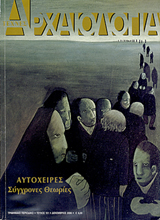
 Παύλος Τάσιος, "Νοκ-άουτ", 1986.
Η αυτοκτονία δεν κάνει συχνά την εμφάνισή της στη θεματολογία του ελληνικού κινηματογράφου. Αυτό, μάλλον, οφείλεται στο σκεπτικισμό ή και στο διχασμό της νεοελληνικής στάσης απέναντι στο φαινόμενο. Έτσι, η αυτοκτονία, στο βαθμό που παρουσιάζεται στην οθόνη, έχει «ηρωικό» χαρακτήρα και μόνο τα τελευταία χρόνια παίρνει μια πιο σαφή μορφή: έχει τα χαρακτηριστικά ενός αποτελέσματος μιας πιο υπαρξιακής, εσωτερικής συνομιλίας με την πραγματικότητα.
Ο Νέος Ελληνικός Κινηματογράφος, που εμφανίστηκε το 1968, βοήθησε στη βαθμιαία υποδοχή του θέματος αυτού, επηρεασμένος από ξένα αισθητικά ρεύματα.
Στο άρθρο, γίνεται προσπάθεια να ερευνηθεί το θέμα σύμφωνα με τον τρόπο που λειτουργεί σεναριακά ως δραματουργικό στοιχείο (ως στοιχείο πλοκής) και ως αφηγηματικό τέχνασμα.
Παύλος Τάσιος, "Νοκ-άουτ", 1986.
Η αυτοκτονία δεν κάνει συχνά την εμφάνισή της στη θεματολογία του ελληνικού κινηματογράφου. Αυτό, μάλλον, οφείλεται στο σκεπτικισμό ή και στο διχασμό της νεοελληνικής στάσης απέναντι στο φαινόμενο. Έτσι, η αυτοκτονία, στο βαθμό που παρουσιάζεται στην οθόνη, έχει «ηρωικό» χαρακτήρα και μόνο τα τελευταία χρόνια παίρνει μια πιο σαφή μορφή: έχει τα χαρακτηριστικά ενός αποτελέσματος μιας πιο υπαρξιακής, εσωτερικής συνομιλίας με την πραγματικότητα.
Ο Νέος Ελληνικός Κινηματογράφος, που εμφανίστηκε το 1968, βοήθησε στη βαθμιαία υποδοχή του θέματος αυτού, επηρεασμένος από ξένα αισθητικά ρεύματα.
Στο άρθρο, γίνεται προσπάθεια να ερευνηθεί το θέμα σύμφωνα με τον τρόπο που λειτουργεί σεναριακά ως δραματουργικό στοιχείο (ως στοιχείο πλοκής) και ως αφηγηματικό τέχνασμα.
 Η Μαρία Κάλλας ως Νόρμα στην ομώνυμη όπερα του Μπελίνι.
Ως είδος τέχνης, η όπερα, ή «μελόδραμα», αν θέλουμε να χρησιμοποιήσουμε την ελληνική ονομασία της, είναι πληθωρική, ξεπερνά τη ζωή. Η υπερβολή είναι η δεύτερη φύση της και στις πλοκές της τα ανθρώπινα πάθη και τα συναισθήματα μεγεθύνονται, ως ακραίες αντιδράσεις που σπάνια συναντάμε στην πραγματική ζωή. Οι εντυπωσιακοί θάνατοι, συνήθως η αυτοκτονία και οι δολοφονίες, είναι συνώνυμοι με την όπερα, αποτελούν αναπόσπαστο μέρος της γοητείας της. Το άρθρο αυτό εξετάζει ορισμένες από τις πιο εντυπωσιακές αυτοκτονίες στις δημοφιλέστατες όπερες του Βέρντι, του Πουτσίνι και κάποιων συνθετών που εκπροσωπούν τις σχολές του μπελκάντο και του βερισμού. Αναλύονται τα κίνητρα και οι συνθήκες των επί σκηνής αυτοκτονιών και συγκρίνονται με τις αντίστοιχες αυτοκτονίες των ηρώων και ηρωίδων του γερμανικού ρεπερτορίου, ιδιαίτερα στον Βάγκνερ.
Η Μαρία Κάλλας ως Νόρμα στην ομώνυμη όπερα του Μπελίνι.
Ως είδος τέχνης, η όπερα, ή «μελόδραμα», αν θέλουμε να χρησιμοποιήσουμε την ελληνική ονομασία της, είναι πληθωρική, ξεπερνά τη ζωή. Η υπερβολή είναι η δεύτερη φύση της και στις πλοκές της τα ανθρώπινα πάθη και τα συναισθήματα μεγεθύνονται, ως ακραίες αντιδράσεις που σπάνια συναντάμε στην πραγματική ζωή. Οι εντυπωσιακοί θάνατοι, συνήθως η αυτοκτονία και οι δολοφονίες, είναι συνώνυμοι με την όπερα, αποτελούν αναπόσπαστο μέρος της γοητείας της. Το άρθρο αυτό εξετάζει ορισμένες από τις πιο εντυπωσιακές αυτοκτονίες στις δημοφιλέστατες όπερες του Βέρντι, του Πουτσίνι και κάποιων συνθετών που εκπροσωπούν τις σχολές του μπελκάντο και του βερισμού. Αναλύονται τα κίνητρα και οι συνθήκες των επί σκηνής αυτοκτονιών και συγκρίνονται με τις αντίστοιχες αυτοκτονίες των ηρώων και ηρωίδων του γερμανικού ρεπερτορίου, ιδιαίτερα στον Βάγκνερ.
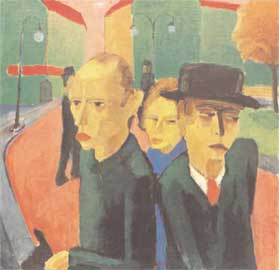 "Άνθρωποι στο δρόμο", Μαξ Κάους, 1920, Συλλογή Μπούχαϊμ, Μόναχο.
Η αυτοκτονία, παρ’ όλο τον αυστηρά ατομικό χαρακτήρα της, αποτελεί ένα παγκόσμιο φαινόμενο που συναντάται σε όλες τις περιόδους της ανθρώπινης ιστορίας, σ’ όλες τις χώρες και σ’ όλους τους πολιτισμούς. Το ερώτημα που τίθεται είναι εάν οι απόπειρες αυτοκτονίας και οι αυτοκτονίες αποτελούν εκφράσεις του ίδιου φαινομένου. Οι περισσότερες μελέτες καταλήγουν στο συμπέρασμα ότι αυτοκτονίες και σοβαρές απόπειρες αυτοκτονίας ταυτίζονται στα περισσότερα χαρακτηριστικά τους και θα πρέπει να δεχθούμε την ύπαρξη ενός συνεχούς φάσματος αυτοκτονικής συμπεριφοράς το οποίο ξεκινά από τον αυτοκτονικό ιδεασμό, ακολουθείται από την χειριστική απόπειρα, την μέτριας σοβαρότητας απόπειρα και φτάνει στην σοβαρή απόπειρα με κατάληξη την αυτοκτονία.
Η μελέτη της αυτοκτονικής συμπεριφοράς έχει προσφέρει σημαντικά στοιχεία για τους παράγοντες που οδηγούν στην εκδήλωσή της (παράγοντες κινδύνου). Τα χαρακτηριστικά του ατόμου που αυτοκτονεί είναι άνδρας μεγάλης ηλικίας (άνω των 45 ετών), χήρος, διαζευγμένος ή ανύπαντρος, ζει μόνος ή είναι κοινωνικά απομονωμένος και είναι άνεργος, μη απασχολούμενος ή συνταξιούχος. Στα πρόσφατα γεγονότα ζωής διαπιστώνεται πρόσφατος χωρισμός, απώλεια ή δυσάρεστα γεγονότα ζωής με παρουσία κατάθλιψης. Πάσχει από ψυχική διαταραχή κυρίως κατάθλιψη, σχιζοφρένεια, αλκοολισμό ή χρήση ουσιών, ενώ συχνά πάσχει από σοβαρή ή χρόνια σωματική νόσο (π.χ. καρκίνος, AIDS, επιληψία κ.λπ.). Κατά κανόνα, έχει ιστορικό προηγούμενων αποπειρών συνήθως με βίαιες ή επικίνδυνες μεθόδους που εκφράζουν ισχυρή θέληση για θάνατο. Τέλος, στο οικογενειακό του ιστορικό διαπιστώνεται ιστορικό αυτοκτονίας, κατάθλιψης ή αλκοολισμού.
Η αναζήτηση παραγόντων κινδύνου για αυτοκτονία μπορεί να συμβάλει στην δυνατή πρόληψη αυτοκτονικής συμπεριφοράς, χωρίς βεβαίως να είναι δυνατή η πρόληψη όλων των αυτοκτονιών.
"Άνθρωποι στο δρόμο", Μαξ Κάους, 1920, Συλλογή Μπούχαϊμ, Μόναχο.
Η αυτοκτονία, παρ’ όλο τον αυστηρά ατομικό χαρακτήρα της, αποτελεί ένα παγκόσμιο φαινόμενο που συναντάται σε όλες τις περιόδους της ανθρώπινης ιστορίας, σ’ όλες τις χώρες και σ’ όλους τους πολιτισμούς. Το ερώτημα που τίθεται είναι εάν οι απόπειρες αυτοκτονίας και οι αυτοκτονίες αποτελούν εκφράσεις του ίδιου φαινομένου. Οι περισσότερες μελέτες καταλήγουν στο συμπέρασμα ότι αυτοκτονίες και σοβαρές απόπειρες αυτοκτονίας ταυτίζονται στα περισσότερα χαρακτηριστικά τους και θα πρέπει να δεχθούμε την ύπαρξη ενός συνεχούς φάσματος αυτοκτονικής συμπεριφοράς το οποίο ξεκινά από τον αυτοκτονικό ιδεασμό, ακολουθείται από την χειριστική απόπειρα, την μέτριας σοβαρότητας απόπειρα και φτάνει στην σοβαρή απόπειρα με κατάληξη την αυτοκτονία.
Η μελέτη της αυτοκτονικής συμπεριφοράς έχει προσφέρει σημαντικά στοιχεία για τους παράγοντες που οδηγούν στην εκδήλωσή της (παράγοντες κινδύνου). Τα χαρακτηριστικά του ατόμου που αυτοκτονεί είναι άνδρας μεγάλης ηλικίας (άνω των 45 ετών), χήρος, διαζευγμένος ή ανύπαντρος, ζει μόνος ή είναι κοινωνικά απομονωμένος και είναι άνεργος, μη απασχολούμενος ή συνταξιούχος. Στα πρόσφατα γεγονότα ζωής διαπιστώνεται πρόσφατος χωρισμός, απώλεια ή δυσάρεστα γεγονότα ζωής με παρουσία κατάθλιψης. Πάσχει από ψυχική διαταραχή κυρίως κατάθλιψη, σχιζοφρένεια, αλκοολισμό ή χρήση ουσιών, ενώ συχνά πάσχει από σοβαρή ή χρόνια σωματική νόσο (π.χ. καρκίνος, AIDS, επιληψία κ.λπ.). Κατά κανόνα, έχει ιστορικό προηγούμενων αποπειρών συνήθως με βίαιες ή επικίνδυνες μεθόδους που εκφράζουν ισχυρή θέληση για θάνατο. Τέλος, στο οικογενειακό του ιστορικό διαπιστώνεται ιστορικό αυτοκτονίας, κατάθλιψης ή αλκοολισμού.
Η αναζήτηση παραγόντων κινδύνου για αυτοκτονία μπορεί να συμβάλει στην δυνατή πρόληψη αυτοκτονικής συμπεριφοράς, χωρίς βεβαίως να είναι δυνατή η πρόληψη όλων των αυτοκτονιών.
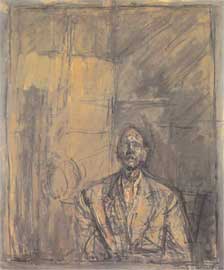 "Jean Genet", Αλμπέρτο Τζακομέττι, 1955, 65x54 εκ.
Το τελευταίο μέρος του αφιερώματος στους Αυτόχειρες εξετάζει τις επιστημονικές «θεωρίες για την αυτοκτονία», και το πώς αυτές επιβεβαιώνονται ή ανατρέπονται στην τέχνη. Έτσι, στα άρθρα «Παράγοντες κινδύνου για αυτοκτονία και απόπειρα αυτοκτονίας» του Ι. Νηματούδη και «Η αυτοκτονία στην εφηβεία» του Π. Σικυώτη εξετάζονται οι ψυχιατρικές και ψυχολογικές πτυχές του φαινομένου, ενώ η Ε. Ματθαιοπούλου και ο Τ. Γουδέλης πραγματεύονται το ακανθώδες αυτό θέμα, όπως εμφανίζεται στην όπερα και στον ελληνικό κινηματογράφο αντίστοιχα.
"Jean Genet", Αλμπέρτο Τζακομέττι, 1955, 65x54 εκ.
Το τελευταίο μέρος του αφιερώματος στους Αυτόχειρες εξετάζει τις επιστημονικές «θεωρίες για την αυτοκτονία», και το πώς αυτές επιβεβαιώνονται ή ανατρέπονται στην τέχνη. Έτσι, στα άρθρα «Παράγοντες κινδύνου για αυτοκτονία και απόπειρα αυτοκτονίας» του Ι. Νηματούδη και «Η αυτοκτονία στην εφηβεία» του Π. Σικυώτη εξετάζονται οι ψυχιατρικές και ψυχολογικές πτυχές του φαινομένου, ενώ η Ε. Ματθαιοπούλου και ο Τ. Γουδέλης πραγματεύονται το ακανθώδες αυτό θέμα, όπως εμφανίζεται στην όπερα και στον ελληνικό κινηματογράφο αντίστοιχα.
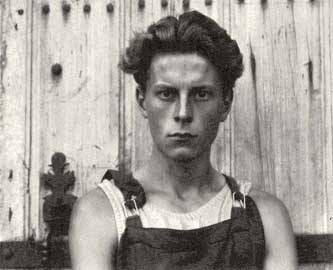 "Έφηβος", Paul Strand, 1951, Γαλλία.
Η αυτοκτονική συμπεριφορά στην εφηβεία είναι ένα πρόβλημα το οποίο παρουσιάζει εντυπωσιακή αύξηση τα τελευταία χρόνια. Πιο συχνά κάνουν απόπειρα αυτοκτονίας τα κορίτσια, οι απόπειρες όμως των αγοριών είναι πιο σοβαρές και έχουν μεγαλύτερη πιθανότητα να καταλήξουν σε θάνατο.
Οι έφηβοι παρουσιάζουν σε μεγάλη αναλογία αυτοκτονική συμπεριφορά, ένεκα διαφόρων ειδικών ψυχολογικών χαρακτηριστικών τα οποία εμφανίζουν.
Η εφηβεία είναι μια περίοδος της ζωής του ατόμου κατά την οποία παρατηρείται σημαντική και απότομη αύξηση των επιθυμιών, ενορμήσεων και φαντασιώσεων, οι οποίες, ενώ σε άλλες φάσεις της ψυχοσεξουαλικής ανάπτυξης περνούν απαρατήρητες ή περιορίζονται στο ασυνείδητο, κατά την εφηβεία αναδύονται στη συνείδηση, οπότε έρχονται σε σύγκρουση με την πραγματικότητα. Ο έφηβος προσπαθώντας να ελέγξει την ένταση των ενορμήσεών του, χρησιμοποιεί διάφορους μηχανισμούς αμύνης, όχι όμως πάντοτε με επιτυχία, με αποτέλεσμα να εμφανίζει ψυχοπαθολογικές καταστάσεις.
Ένας έφηβος πρέπει να θεωρείται ύποπτος για απόπειρα αυτοκτονίας: 1) Εάν έχει κάνει προηγούμενες απόπειρες, 2) Εάν έχει κάνει προσφάτως απόπειρα ένα φιλικό του πρόσωπο, 3) Εάν έχει αυτοκτονικό ιδεασμό, 4) Εάν έχει χαμηλή αυτοεκτίμηση, 5) Εάν έχει κατάθλιψη.
Η κατάθλιψη στους εφήβους είναι ένα πολύ σοβαρό ψυχολογικό πρόβλημα και ο κυριότερος παράγων πρόκλησης αυτοκτονικής συμπεριφοράς. Παρ’ όλα αυτά δεν διαγιγνώσκεται εύκολα, γιατί στην εφηβεία δεν εμφανίζεται με την κλασική μορφή των ενηλίκων.
Επειδή στο μέλλον προβλέπεται μεγάλη αύξηση των ψυχολογικών προβλημάτων στους νέους, πρέπει να δώσουμε μεγάλη σημασία στο θέμα Πρόληψη στην Ψυχική Υγεία.
Η πρόληψη γίνεται με τη σωστή ενημέρωση των γονέων και με τη σωστή εκπαίδευση των ζευγαριών και μελλοντικών γονέων γύρω από τα διάφορα ψυχοκοινωνικά και ιατρο-κοινωνικά θέματα. Ελπίζουμε ότι στην πατρίδα μας μελλοντικώς θα δημιουργηθούν οι κατάλληλοι θεσμοί πρόληψης της ψυχικής υγείας.
"Έφηβος", Paul Strand, 1951, Γαλλία.
Η αυτοκτονική συμπεριφορά στην εφηβεία είναι ένα πρόβλημα το οποίο παρουσιάζει εντυπωσιακή αύξηση τα τελευταία χρόνια. Πιο συχνά κάνουν απόπειρα αυτοκτονίας τα κορίτσια, οι απόπειρες όμως των αγοριών είναι πιο σοβαρές και έχουν μεγαλύτερη πιθανότητα να καταλήξουν σε θάνατο.
Οι έφηβοι παρουσιάζουν σε μεγάλη αναλογία αυτοκτονική συμπεριφορά, ένεκα διαφόρων ειδικών ψυχολογικών χαρακτηριστικών τα οποία εμφανίζουν.
Η εφηβεία είναι μια περίοδος της ζωής του ατόμου κατά την οποία παρατηρείται σημαντική και απότομη αύξηση των επιθυμιών, ενορμήσεων και φαντασιώσεων, οι οποίες, ενώ σε άλλες φάσεις της ψυχοσεξουαλικής ανάπτυξης περνούν απαρατήρητες ή περιορίζονται στο ασυνείδητο, κατά την εφηβεία αναδύονται στη συνείδηση, οπότε έρχονται σε σύγκρουση με την πραγματικότητα. Ο έφηβος προσπαθώντας να ελέγξει την ένταση των ενορμήσεών του, χρησιμοποιεί διάφορους μηχανισμούς αμύνης, όχι όμως πάντοτε με επιτυχία, με αποτέλεσμα να εμφανίζει ψυχοπαθολογικές καταστάσεις.
Ένας έφηβος πρέπει να θεωρείται ύποπτος για απόπειρα αυτοκτονίας: 1) Εάν έχει κάνει προηγούμενες απόπειρες, 2) Εάν έχει κάνει προσφάτως απόπειρα ένα φιλικό του πρόσωπο, 3) Εάν έχει αυτοκτονικό ιδεασμό, 4) Εάν έχει χαμηλή αυτοεκτίμηση, 5) Εάν έχει κατάθλιψη.
Η κατάθλιψη στους εφήβους είναι ένα πολύ σοβαρό ψυχολογικό πρόβλημα και ο κυριότερος παράγων πρόκλησης αυτοκτονικής συμπεριφοράς. Παρ’ όλα αυτά δεν διαγιγνώσκεται εύκολα, γιατί στην εφηβεία δεν εμφανίζεται με την κλασική μορφή των ενηλίκων.
Επειδή στο μέλλον προβλέπεται μεγάλη αύξηση των ψυχολογικών προβλημάτων στους νέους, πρέπει να δώσουμε μεγάλη σημασία στο θέμα Πρόληψη στην Ψυχική Υγεία.
Η πρόληψη γίνεται με τη σωστή ενημέρωση των γονέων και με τη σωστή εκπαίδευση των ζευγαριών και μελλοντικών γονέων γύρω από τα διάφορα ψυχοκοινωνικά και ιατρο-κοινωνικά θέματα. Ελπίζουμε ότι στην πατρίδα μας μελλοντικώς θα δημιουργηθούν οι κατάλληλοι θεσμοί πρόληψης της ψυχικής υγείας.
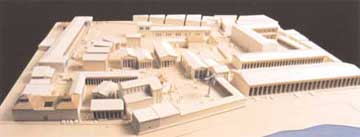 Μακέτα του Ιερού του Απόλλωνα και της Αγοράς των Δηλίων. Κάτω δεξιά διακρίνεται η Στοά του Φιλίππου.
Mε αφορμή ενός άρθρου που δημοσιεύτηκε στην Kαθημερινή και αφορά το πρόγραμμα της αναστήλωσης της Στοάς του Φιλίππου στη Δήλο, ο συγγραφέας θέτει ορισμένα ερωτήματα επιχειρώντας να φωτίσει τη θεωρητική διάσταση της προβληματικής της αναστήλωσης του εν λόγω μνημείου. Έτσι λοιπόν εξετάζει το νόημα που θα είχε σήμερα η προγραμματιζόμενη αυτή αναστήλωση, το κόστος της, το σκοπό και το όφελος του έργου και, τέλος, τον οπτικό αντίκτυπο που θα είχε στο περιβάλλον τοπίο. Ως εναλλακτική λύση, ο συγγραφέας προτείνει τη συγκρότηση ενός σχεδίου διαχείρισης του συνόλου της Δήλου μέσα από την εκτίμηση των ιδιαιτεροτήτων αυτού του τόσο εύθραυστου τόπου, ούτως ώστε να αναχαιτιστούν οι καταστροφές που είναι συνυφασμένες με τις κλιματικές συνθήκες και την τουριστική κίνηση. Tο πρόγραμμα αυτό θα πρέπει να ανταποκρίνεται αυστηρά στις απαιτήσεις της Xάρτας της Bενετίας. Eπίσης απαραίτητο θεωρεί ο συγγραφέας να περιληφθεί το σύνολο της νήσου σε αυτό το πρόγραμμα, για να αντιμετωπιστεί η καταστροφική εγκατάλειψη στην οποία έχουν αφεθεί η ύπαιθρος και η αγροικίες στο νότιο τμήμα του νησιού, παρότι συμβάλλουν καθοριστικά στην ταυτότητα του χώρου.
Μακέτα του Ιερού του Απόλλωνα και της Αγοράς των Δηλίων. Κάτω δεξιά διακρίνεται η Στοά του Φιλίππου.
Mε αφορμή ενός άρθρου που δημοσιεύτηκε στην Kαθημερινή και αφορά το πρόγραμμα της αναστήλωσης της Στοάς του Φιλίππου στη Δήλο, ο συγγραφέας θέτει ορισμένα ερωτήματα επιχειρώντας να φωτίσει τη θεωρητική διάσταση της προβληματικής της αναστήλωσης του εν λόγω μνημείου. Έτσι λοιπόν εξετάζει το νόημα που θα είχε σήμερα η προγραμματιζόμενη αυτή αναστήλωση, το κόστος της, το σκοπό και το όφελος του έργου και, τέλος, τον οπτικό αντίκτυπο που θα είχε στο περιβάλλον τοπίο. Ως εναλλακτική λύση, ο συγγραφέας προτείνει τη συγκρότηση ενός σχεδίου διαχείρισης του συνόλου της Δήλου μέσα από την εκτίμηση των ιδιαιτεροτήτων αυτού του τόσο εύθραυστου τόπου, ούτως ώστε να αναχαιτιστούν οι καταστροφές που είναι συνυφασμένες με τις κλιματικές συνθήκες και την τουριστική κίνηση. Tο πρόγραμμα αυτό θα πρέπει να ανταποκρίνεται αυστηρά στις απαιτήσεις της Xάρτας της Bενετίας. Eπίσης απαραίτητο θεωρεί ο συγγραφέας να περιληφθεί το σύνολο της νήσου σε αυτό το πρόγραμμα, για να αντιμετωπιστεί η καταστροφική εγκατάλειψη στην οποία έχουν αφεθεί η ύπαιθρος και η αγροικίες στο νότιο τμήμα του νησιού, παρότι συμβάλλουν καθοριστικά στην ταυτότητα του χώρου.
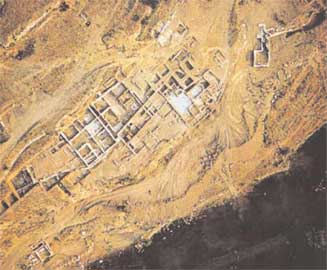 Καλλίπολις (Κάλλιον): Συνολική άποψη των οικοδομικών λειψάνων του αρχαίου Καλλίου, που αποκάλυψαν οι ανασκαφές του Π. Θέμελη.
Μυθικές ενδείξεις, αλλά και αρχαιολογικό δείγμα του ιερού γάμου, της ιερογαμίας, της συμβολικής δηλαδή ένωσης ανάμεσα στο θεό και στον άνθρωπο, έχουμε και στο χώρο της προϊστορικής και της ιστορικής Αιτωλίας.
Οι ενδείξεις αυτές για την τελετουργία της ιερογαμίας στην αρχαία Αιτωλία έχουν να κάνουν:
-Με τη μυθολογούμενη ένωση της συζύγου του Οινέως, βασίλισσας Αλθαίας με το θεό Διόνυσο στην πόλη Καλυδώνα της Αιτωλίας.
-Με το φυλετικό σύμβολο των Αιτωλών, τον κάπρο.
-Με τη μονοσανδαλία των Αιτωλών, που ήταν δική τους μυστηριακή πίστη και μυθική έκφραση του ιερού γάμου στην Αιτωλία. Μονοσάνδαλος του αιτωλικού μύθου υπήρξε ο ίδιος ο Αιτωλός.
-Με την ιεροδουλεία ή «ιερή πορνεία των ναών», την ασκούμενη σε ιερό της Αφροδίτης, στην αιτωλική πόλη Καλυδώνα.
Την αρχαιολογική μαρτυρία μάς τη δίνει μία από τις σωζόμενες μετόπες του αρχαϊκού ναού του Λυσείου Απόλλωνος (ή ίσως της Αρτέμιδος), που βρίσκεται εντός του ιερού του Θερμίου Απόλλωνος, στον Θέρμο Αιτωλίας: σώζεται ένα απόσπασμα «ερωτικού συμπλέγματος»: δύο φιγούρες, αρσενική και θηλυκή ενώνονται ερωτικά.
Καλλίπολις (Κάλλιον): Συνολική άποψη των οικοδομικών λειψάνων του αρχαίου Καλλίου, που αποκάλυψαν οι ανασκαφές του Π. Θέμελη.
Μυθικές ενδείξεις, αλλά και αρχαιολογικό δείγμα του ιερού γάμου, της ιερογαμίας, της συμβολικής δηλαδή ένωσης ανάμεσα στο θεό και στον άνθρωπο, έχουμε και στο χώρο της προϊστορικής και της ιστορικής Αιτωλίας.
Οι ενδείξεις αυτές για την τελετουργία της ιερογαμίας στην αρχαία Αιτωλία έχουν να κάνουν:
-Με τη μυθολογούμενη ένωση της συζύγου του Οινέως, βασίλισσας Αλθαίας με το θεό Διόνυσο στην πόλη Καλυδώνα της Αιτωλίας.
-Με το φυλετικό σύμβολο των Αιτωλών, τον κάπρο.
-Με τη μονοσανδαλία των Αιτωλών, που ήταν δική τους μυστηριακή πίστη και μυθική έκφραση του ιερού γάμου στην Αιτωλία. Μονοσάνδαλος του αιτωλικού μύθου υπήρξε ο ίδιος ο Αιτωλός.
-Με την ιεροδουλεία ή «ιερή πορνεία των ναών», την ασκούμενη σε ιερό της Αφροδίτης, στην αιτωλική πόλη Καλυδώνα.
Την αρχαιολογική μαρτυρία μάς τη δίνει μία από τις σωζόμενες μετόπες του αρχαϊκού ναού του Λυσείου Απόλλωνος (ή ίσως της Αρτέμιδος), που βρίσκεται εντός του ιερού του Θερμίου Απόλλωνος, στον Θέρμο Αιτωλίας: σώζεται ένα απόσπασμα «ερωτικού συμπλέγματος»: δύο φιγούρες, αρσενική και θηλυκή ενώνονται ερωτικά.
 Nestor, με βιβλιογραφική ενημέρωση άνω των 300.000 τίτλων.
Tο παρόν άρθρο έχει σκοπό να βοηθήσει αρχαιολόγους, φοιτητές ή ανθρώπους με αρχαιολογικά ενδιαφέροντα να μπορέσουν να κινηθούν εύκολα μέσα στον αχανή κόσμο του διαδικτύου και να μπορέσουν να αντλήσουν όσο πιο πολλές πληροφορίες μπορούν. Το άρθρο, αν και αναφέρεται κατά βάση στην αιγαιακή προϊστορική αρχαιολογία, μπορεί να φανεί χρήσιμο και σε όσους έχουν κλασικά ή και βυζαντινά ενδιαφέροντα, αφού πολλά sites αναφέρονται σε όλες τις ειδικότητες.
Nestor, με βιβλιογραφική ενημέρωση άνω των 300.000 τίτλων.
Tο παρόν άρθρο έχει σκοπό να βοηθήσει αρχαιολόγους, φοιτητές ή ανθρώπους με αρχαιολογικά ενδιαφέροντα να μπορέσουν να κινηθούν εύκολα μέσα στον αχανή κόσμο του διαδικτύου και να μπορέσουν να αντλήσουν όσο πιο πολλές πληροφορίες μπορούν. Το άρθρο, αν και αναφέρεται κατά βάση στην αιγαιακή προϊστορική αρχαιολογία, μπορεί να φανεί χρήσιμο και σε όσους έχουν κλασικά ή και βυζαντινά ενδιαφέροντα, αφού πολλά sites αναφέρονται σε όλες τις ειδικότητες.
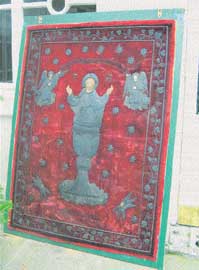 Το αντικείμενο πριν από την αφαίρεσή του από την ξύλινη Πύλη.
Τα βήλα, παραπετάσματα ή καταπετάσματα, χρησιμοποιούνται ήδη από τους παλαιοχριστιανικούς χρόνους ως λειτουργικά υφάσματα, αρχικά ως καλύμματα της Αγίας Τραπέζης και αργότερα, με την εξέλιξη της κατασκευής του τέμπλου, ως παραπετάσματα, ώστε να διαχωρίζεται το ιερό βήμα από τον κυρίως ναό. Το λειτουργικό ύφασμα που πραγματεύεται το παρόν άρθρο, και το οποίο δημοσιεύεται για πρώτη φορά, μεταφέρθηκε για λόγους ασφάλειας, από το ναό του Αγίου Φωκά (χωριό Ortakoy) στο Οικουμενικό Πατριαρχείο Κωνσταντινουπόλεως όπου φυλάσσεται μέχρι σήμερα.
Το αντικείμενο πριν από την αφαίρεσή του από την ξύλινη Πύλη.
Τα βήλα, παραπετάσματα ή καταπετάσματα, χρησιμοποιούνται ήδη από τους παλαιοχριστιανικούς χρόνους ως λειτουργικά υφάσματα, αρχικά ως καλύμματα της Αγίας Τραπέζης και αργότερα, με την εξέλιξη της κατασκευής του τέμπλου, ως παραπετάσματα, ώστε να διαχωρίζεται το ιερό βήμα από τον κυρίως ναό. Το λειτουργικό ύφασμα που πραγματεύεται το παρόν άρθρο, και το οποίο δημοσιεύεται για πρώτη φορά, μεταφέρθηκε για λόγους ασφάλειας, από το ναό του Αγίου Φωκά (χωριό Ortakoy) στο Οικουμενικό Πατριαρχείο Κωνσταντινουπόλεως όπου φυλάσσεται μέχρι σήμερα.
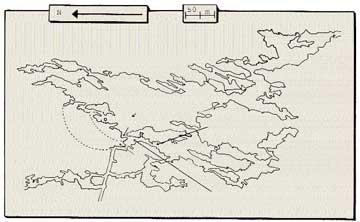 Σχεδιάγραμμα κάτοψης σπηλαίου Πετραλώνων.
Μια μακρά συζήτηση για τη χρονολόγηση των ευρημάτων του σπηλαίου Πετραλώνων Χαλκιδικής (απολιθωμάτων ζώων και φυτών, τέχνεργων, ανθρώπινων καταλοίπων κ.λπ.) συνεχίζεται εδώ και 46 χρόνια, από τη στιγμή που ανακαλύφθηκε εκεί ένα κρανίο προϊστορικού ανθρώπου. Τόσο οι σχετικές όσο και οι απόλυτες χρονολογήσεις, ποικίλλουν έντονα ανάμεσα στις διάφορες επιστημονικές δημοσιεύσεις. Οι σχετικές ηλικίες έχουν οπωσδήποτε αποδώσει μια πιο ξεκάθαρη εικόνα, αυτή του Κάτω-Μέσου Πλειστόκαινου (περίπου 500.000-800.000 Π.Σ.) Οι απόλυτες χρονολογήσεις, με τις μεθόδους του ουρανίου/θορίου (U/Th), του Συντονισμού Ηλεκτρονικής Στροφορμής (ESR), της θερμοφωταύγειας (TL), των αμινοξέων, του παλαιομαγνητισμού κ.λπ., έχουν οδηγήσει σε μετρήσιμα αποτελέσματα, τα οποία δεν συμφωνούν πάντα μεταξύ τους. Στο άρθρο επιχειρείται μια σύνθεση των έως τώρα ερευνών και μια προσπάθεια ερμηνείας των αντιφατικών αποτελεσμάτων.
Σχεδιάγραμμα κάτοψης σπηλαίου Πετραλώνων.
Μια μακρά συζήτηση για τη χρονολόγηση των ευρημάτων του σπηλαίου Πετραλώνων Χαλκιδικής (απολιθωμάτων ζώων και φυτών, τέχνεργων, ανθρώπινων καταλοίπων κ.λπ.) συνεχίζεται εδώ και 46 χρόνια, από τη στιγμή που ανακαλύφθηκε εκεί ένα κρανίο προϊστορικού ανθρώπου. Τόσο οι σχετικές όσο και οι απόλυτες χρονολογήσεις, ποικίλλουν έντονα ανάμεσα στις διάφορες επιστημονικές δημοσιεύσεις. Οι σχετικές ηλικίες έχουν οπωσδήποτε αποδώσει μια πιο ξεκάθαρη εικόνα, αυτή του Κάτω-Μέσου Πλειστόκαινου (περίπου 500.000-800.000 Π.Σ.) Οι απόλυτες χρονολογήσεις, με τις μεθόδους του ουρανίου/θορίου (U/Th), του Συντονισμού Ηλεκτρονικής Στροφορμής (ESR), της θερμοφωταύγειας (TL), των αμινοξέων, του παλαιομαγνητισμού κ.λπ., έχουν οδηγήσει σε μετρήσιμα αποτελέσματα, τα οποία δεν συμφωνούν πάντα μεταξύ τους. Στο άρθρο επιχειρείται μια σύνθεση των έως τώρα ερευνών και μια προσπάθεια ερμηνείας των αντιφατικών αποτελεσμάτων.
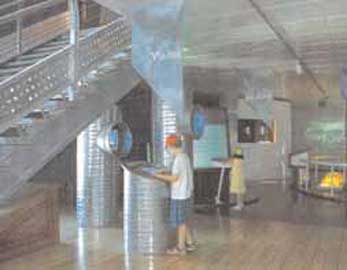 Η αίθουσα διάδρασης του Κέντρου Τεχνολογίας και Επιστημών του Μπορντώ.
Είναι ζητούμενο για την Ελλάδα να εναρμονιστεί με το ευρωπαϊκό τεχνολογικό περιβάλλον της, όσον αφορά στο δίπολο πολιτισμού και νέων τεχνολογιών. Ειδικότερα για τα ελληνικά μουσεία είναι απαραίτητα σημαντικά βήματα. Μεταξύ άλλων, απαιτείται η χρήση προηγμένων εκθεσιακών υπηρεσιών πληροφόρησης και μάθησης μέσω προϊόντων που βασίζονται στην διάδραση, η συντονισμένη και συστηματική ηλεκτρονική επιστημονική τεκμηρίωση του πολιτιστικού τους αποθέματος, η περαιτέρω ανάπτυξη προϊόντων και υπηρεσιών (cd-rom, δικτυακών ηλεκτρονικών εκδόσεων), η δημιουργία ενός συστήματος διαχείρισης των πνευματικών δικαιωμάτων τους, η αναβάθμιση και επέκταση των υπαρχόντων μουσειακών δικτυακών τόπων κ. ά. Τα παραπάνω προϋποθέτουν παρακολούθηση των νέων κάθε φορά προβλημάτων που ανακύπτουν λόγω της ραγδαίας εξέλιξης του τομέα των νέων τεχνολογιών αλλά και ανάπτυξη στρατηγικών, αρχών και πρακτικών που θα σχετίζονται με την ίδια τη φυσιογνωμία και το μέλλον των μουσείων.
Η αίθουσα διάδρασης του Κέντρου Τεχνολογίας και Επιστημών του Μπορντώ.
Είναι ζητούμενο για την Ελλάδα να εναρμονιστεί με το ευρωπαϊκό τεχνολογικό περιβάλλον της, όσον αφορά στο δίπολο πολιτισμού και νέων τεχνολογιών. Ειδικότερα για τα ελληνικά μουσεία είναι απαραίτητα σημαντικά βήματα. Μεταξύ άλλων, απαιτείται η χρήση προηγμένων εκθεσιακών υπηρεσιών πληροφόρησης και μάθησης μέσω προϊόντων που βασίζονται στην διάδραση, η συντονισμένη και συστηματική ηλεκτρονική επιστημονική τεκμηρίωση του πολιτιστικού τους αποθέματος, η περαιτέρω ανάπτυξη προϊόντων και υπηρεσιών (cd-rom, δικτυακών ηλεκτρονικών εκδόσεων), η δημιουργία ενός συστήματος διαχείρισης των πνευματικών δικαιωμάτων τους, η αναβάθμιση και επέκταση των υπαρχόντων μουσειακών δικτυακών τόπων κ. ά. Τα παραπάνω προϋποθέτουν παρακολούθηση των νέων κάθε φορά προβλημάτων που ανακύπτουν λόγω της ραγδαίας εξέλιξης του τομέα των νέων τεχνολογιών αλλά και ανάπτυξη στρατηγικών, αρχών και πρακτικών που θα σχετίζονται με την ίδια τη φυσιογνωμία και το μέλλον των μουσείων.
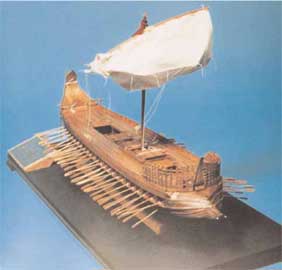 Μοντέλο αναπαράστασης της Σάμαινας, κατασκευασμένο από τον Ηλ. Καρδίμη.
Η Σάμαινα υπήρξε ένας ιδιαίτερος τύπος πλοίου, ο οποίος δημιουργήθηκε από τον τύραννο της Σάμου Πολυκράτη (539-522 π.Χ.). Η Σάμαινα, όπως δείχνει και το χαρακτηριστικό στοιχείο του μεγάλου πλάτους του σκάφους, εξυπηρετούσε πολεμικούς αλλά και εμπορικούς σκοπούς. Θα είχε κατασκευαστεί για κάποιες ιδιαίτερες επιχειρήσεις, όπως ήταν η πειρατεία, η μεταφορά φορτίων αλλά και στρατιωτών και γενικά για χρήσεις για τις οποίες απαιτούνταν μεγάλη χωρητικότητα.
Οι πληροφορίες που μας προσφέρουν οι πηγές για τη Σάμαινα είναι: 1) ήταν πλοίο δίκροτο = διήρης, δηλαδή με δύο επίπεδα κωπηλατών, 2) είχε έμβολο μορφής κεφαλής αγριόχοιρου, 3) είχε σκάφος πλατύ σε σχέση με άλλα πλοία της εποχής, και 4) είχε κατάστρωμα σε όλο το μήκος του. Επίσης σημαντική πηγή είναι η εικονογραφία των νομισμάτων της Ζάγκλης-Μεσσήνης των αρχών του 5ου αι. π.Χ., τα οποία παριστάνουν την πλώρη πλοίου με βεβαιωμένη την απόδοσή τους στη Σάμαινα.
Συμπληρωματικά στοιχεία για την αναπαράσταση της Σάμαινας αποτελούν οι παραστάσεις διήρεων πλοίων της εποχής και ιδιαίτερα αυτά σε ένα αττικό μελανόμορφο δίνο του Εξηκία, γύρω στα 550-530 π.Χ., πεντηκόντορος-διήρης (εκατόντορος) στο μουσείο της Villa Giulia της Ρώμης.
Για την αναπαράσταση του πλοίου δεχόμεθα 25 κωπηλάτες σε κάθε πλευρά σε δύο ορόφους = 100 κωπηλάτες. Κατά τα άλλα, ακολουθούμε τις κοινές για τα πλοία της εποχής προδιαγραφές.
Το σχέδιο της αναπαραστάσεως του πλοίου καλείται «Προσπάθεια αναπαραστάσεως της Σάμαινας», λόγω των δυσκολιών που παρουσιάζονται στις λεπτομέρειες και αυτό είναι φυσικό για κάθε τύπο πλοίου του οποίου δεν έχει βρεθεί ένα ναυάγιο.
Μοντέλο αναπαράστασης της Σάμαινας, κατασκευασμένο από τον Ηλ. Καρδίμη.
Η Σάμαινα υπήρξε ένας ιδιαίτερος τύπος πλοίου, ο οποίος δημιουργήθηκε από τον τύραννο της Σάμου Πολυκράτη (539-522 π.Χ.). Η Σάμαινα, όπως δείχνει και το χαρακτηριστικό στοιχείο του μεγάλου πλάτους του σκάφους, εξυπηρετούσε πολεμικούς αλλά και εμπορικούς σκοπούς. Θα είχε κατασκευαστεί για κάποιες ιδιαίτερες επιχειρήσεις, όπως ήταν η πειρατεία, η μεταφορά φορτίων αλλά και στρατιωτών και γενικά για χρήσεις για τις οποίες απαιτούνταν μεγάλη χωρητικότητα.
Οι πληροφορίες που μας προσφέρουν οι πηγές για τη Σάμαινα είναι: 1) ήταν πλοίο δίκροτο = διήρης, δηλαδή με δύο επίπεδα κωπηλατών, 2) είχε έμβολο μορφής κεφαλής αγριόχοιρου, 3) είχε σκάφος πλατύ σε σχέση με άλλα πλοία της εποχής, και 4) είχε κατάστρωμα σε όλο το μήκος του. Επίσης σημαντική πηγή είναι η εικονογραφία των νομισμάτων της Ζάγκλης-Μεσσήνης των αρχών του 5ου αι. π.Χ., τα οποία παριστάνουν την πλώρη πλοίου με βεβαιωμένη την απόδοσή τους στη Σάμαινα.
Συμπληρωματικά στοιχεία για την αναπαράσταση της Σάμαινας αποτελούν οι παραστάσεις διήρεων πλοίων της εποχής και ιδιαίτερα αυτά σε ένα αττικό μελανόμορφο δίνο του Εξηκία, γύρω στα 550-530 π.Χ., πεντηκόντορος-διήρης (εκατόντορος) στο μουσείο της Villa Giulia της Ρώμης.
Για την αναπαράσταση του πλοίου δεχόμεθα 25 κωπηλάτες σε κάθε πλευρά σε δύο ορόφους = 100 κωπηλάτες. Κατά τα άλλα, ακολουθούμε τις κοινές για τα πλοία της εποχής προδιαγραφές.
Το σχέδιο της αναπαραστάσεως του πλοίου καλείται «Προσπάθεια αναπαραστάσεως της Σάμαινας», λόγω των δυσκολιών που παρουσιάζονται στις λεπτομέρειες και αυτό είναι φυσικό για κάθε τύπο πλοίου του οποίου δεν έχει βρεθεί ένα ναυάγιο.
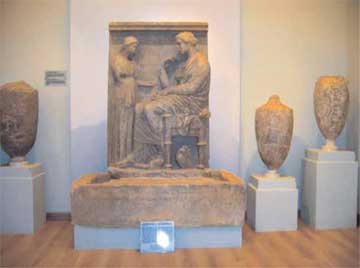 Μαρμάρινη στήλη και λήκυθοι σε αίθουσα του μουσείου. Ευρήματα από ταφικό μνημείο του 4ου αι. π.Χ. στην Παλλήνη.
Παρουσίαση της Αρχαιολογικής Συλλογής Κηφισιάς, του μουσείου που εγκαινιάστηκε το 2004, και των εκθεμάτων του, που προέρχονται κατά κύριο λόγο από τους αρχαίους δήμους Κηφισιάς, Αθμόνου (Μαρούσι), Φλύας (Χαλάνδρι) και Παλλήνης.
Μαρμάρινη στήλη και λήκυθοι σε αίθουσα του μουσείου. Ευρήματα από ταφικό μνημείο του 4ου αι. π.Χ. στην Παλλήνη.
Παρουσίαση της Αρχαιολογικής Συλλογής Κηφισιάς, του μουσείου που εγκαινιάστηκε το 2004, και των εκθεμάτων του, που προέρχονται κατά κύριο λόγο από τους αρχαίους δήμους Κηφισιάς, Αθμόνου (Μαρούσι), Φλύας (Χαλάνδρι) και Παλλήνης.
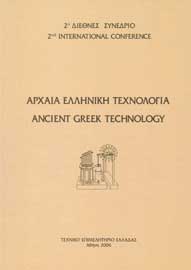 Το εξώφυλλο του τόμου των Πρακτικών του 2ου Διεθνούς Συνεδρίου Αρχαίας Ελληνικής Τεχνολογίας.
Στα Αρχαιομετρικά Νέα αυτού του τεύχους μπορείτε να διαβάσετε:
-Το ελαιόλαδο ως καύσιμο για την παραγωγή κυπριακού χαλκού
-Αρχαία Ελληνική Τεχνολογία: Πρακτικά Διεθνούς Συνεδρίου
-Το Αρχαιολογικό Έργο στη Μακεδονία και στη Θράκη
-Νέα διατριβή στη μελέτη διαγένεσης-απολίθωσης οστών
-Οι υποτροφίες της Βρετανικής Σχολής Αθηνών
Το εξώφυλλο του τόμου των Πρακτικών του 2ου Διεθνούς Συνεδρίου Αρχαίας Ελληνικής Τεχνολογίας.
Στα Αρχαιομετρικά Νέα αυτού του τεύχους μπορείτε να διαβάσετε:
-Το ελαιόλαδο ως καύσιμο για την παραγωγή κυπριακού χαλκού
-Αρχαία Ελληνική Τεχνολογία: Πρακτικά Διεθνούς Συνεδρίου
-Το Αρχαιολογικό Έργο στη Μακεδονία και στη Θράκη
-Νέα διατριβή στη μελέτη διαγένεσης-απολίθωσης οστών
-Οι υποτροφίες της Βρετανικής Σχολής Αθηνών
 Journal of Mediterranean Archaeology, λογότυπο
Η στήλη του JMA παρουσιάζει το άρθρο των Quentin Letesson και Klaas Vansteenhuyse «Towards an Archaeology of Perception: ‘Looking’ at the Minoan Palaces».
Journal of Mediterranean Archaeology, λογότυπο
Η στήλη του JMA παρουσιάζει το άρθρο των Quentin Letesson και Klaas Vansteenhuyse «Towards an Archaeology of Perception: ‘Looking’ at the Minoan Palaces».
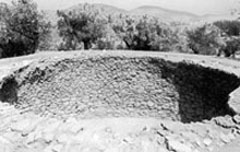 Ο μεγάλος μυκηναϊκός τάφος που βρέθηκε στη Μεγάλη Μαγούλα Γαλατά.
Ειδήσεις: Αρχαίοι καταυλισμοί στην Κύπρο, Το λιμάνι της Κνωσού, Ταφές νεογέννητων, Αρχαία νεκρόπολη στο Βατικανό κ.ά.
Εκθέσεις: Ο Piet de Jong, η Αρχαία Αγορά και η τέχνη της αρχαιότητας, Τα χρώματα στα αρχαία αγάλματα, Από την Αφροδίτη στη Μελουζίνη, Βούλα Παπαϊωάννου κ.ά.
Συνέδρια: Αρχαιολογία και ελληνικότητα, Συνέδριο της Βρετανικής Σχολής, Επιστήμη και τεχνολογία στα ομηρικά έπη κ.ά./
Διαλέξεις: Αρχαιοκαπηλία, Φίλοι Μουσείου Μάνης, Ενάλιες αρχαιολογικές έρευνες στον Ευβοϊκό Κόλπο, Τα έργα αναστήλωσης στην Ακρόπολη, Τρίττοια στη Θάσο κ.ά.
Βιβλία: Τρεις ομιλίες και ένα σημείωμα για τον Μανόλη Ανδρόνικο, συλλογικό έργο, The Derveni Papyrus, Th. Kuremenos κ.ά. (επιμ.), Οι αρχές της αιγαιακής προϊστορίας, Ι. Τζαχίλη, Ο έρωτας στην ελληνική αρχαιότητα, C. Calame κ.ά.
Ο μεγάλος μυκηναϊκός τάφος που βρέθηκε στη Μεγάλη Μαγούλα Γαλατά.
Ειδήσεις: Αρχαίοι καταυλισμοί στην Κύπρο, Το λιμάνι της Κνωσού, Ταφές νεογέννητων, Αρχαία νεκρόπολη στο Βατικανό κ.ά.
Εκθέσεις: Ο Piet de Jong, η Αρχαία Αγορά και η τέχνη της αρχαιότητας, Τα χρώματα στα αρχαία αγάλματα, Από την Αφροδίτη στη Μελουζίνη, Βούλα Παπαϊωάννου κ.ά.
Συνέδρια: Αρχαιολογία και ελληνικότητα, Συνέδριο της Βρετανικής Σχολής, Επιστήμη και τεχνολογία στα ομηρικά έπη κ.ά./
Διαλέξεις: Αρχαιοκαπηλία, Φίλοι Μουσείου Μάνης, Ενάλιες αρχαιολογικές έρευνες στον Ευβοϊκό Κόλπο, Τα έργα αναστήλωσης στην Ακρόπολη, Τρίττοια στη Θάσο κ.ά.
Βιβλία: Τρεις ομιλίες και ένα σημείωμα για τον Μανόλη Ανδρόνικο, συλλογικό έργο, The Derveni Papyrus, Th. Kuremenos κ.ά. (επιμ.), Οι αρχές της αιγαιακής προϊστορίας, Ι. Τζαχίλη, Ο έρωτας στην ελληνική αρχαιότητα, C. Calame κ.ά.
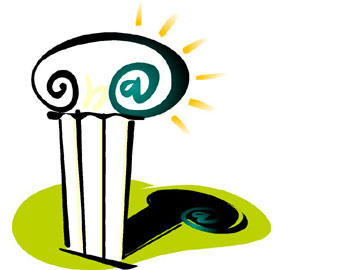 Το λογότυπο της στήλης
Η στήλη της Πληροφορικής παρουσιάζει νέους, και λιγότερο νέους, δικτυακούς τόπους που δίνουν μια εικόνα των εξελίξεων οι οποίες συμβάλλουν στην προώθηση της αρχαιολογικής έρευνας και διδασκαλίας. Στο τεύχος αυτό, οι αναγνώστες μπορούν να ενημερωθούν α) για τις δυνατότητες που προσφέρει το παγκόσμιο γεωγραφικό σύστημα Google Earth τόσο σε επαγγελματίες όσο και σε ερασιτέχνες αρχαιολόγους, β) για τη διάθεση επιστημονικών αρχείων στον Παγκόσμιο Ιστό, γ) για τα εκπαιδευτικά προγράμματα του Βρετανικού Μουσείου, με θέμα τους αρχαίους πολιτισμούς, και, τέλος, δ) για τα blogs αρχαιολογικού ενδιαφέροντος.
Το λογότυπο της στήλης
Η στήλη της Πληροφορικής παρουσιάζει νέους, και λιγότερο νέους, δικτυακούς τόπους που δίνουν μια εικόνα των εξελίξεων οι οποίες συμβάλλουν στην προώθηση της αρχαιολογικής έρευνας και διδασκαλίας. Στο τεύχος αυτό, οι αναγνώστες μπορούν να ενημερωθούν α) για τις δυνατότητες που προσφέρει το παγκόσμιο γεωγραφικό σύστημα Google Earth τόσο σε επαγγελματίες όσο και σε ερασιτέχνες αρχαιολόγους, β) για τη διάθεση επιστημονικών αρχείων στον Παγκόσμιο Ιστό, γ) για τα εκπαιδευτικά προγράμματα του Βρετανικού Μουσείου, με θέμα τους αρχαίους πολιτισμούς, και, τέλος, δ) για τα blogs αρχαιολογικού ενδιαφέροντος.
In spite of its strictly personal character, suicide is a universal phenomenon observed in all periods of human history in every country and civilization. The issue is whether the attempted and committed suicides are expressions of one and the same phenomenon. Most studies reach the conclusion that most of the characteristics of attempted and committed suicides are identical. Therefore, we must accept the existence of a continuous spectrum of suicidal behavior, which starts from the suicidal ideation, is followed by a thought of manipulating the social environment and an attempt of relative gravity and terminates to a serious suisidal attempt that might be fatal. The study of suicidal behavior has contributed significant information on the risk factors leading to suicide. The typical characteristics of the individual who commits suicide are: male, over 45 years of age, widowed, divorcee or single, who lives alone or is socially withdrawn and who is also unemployed, idle or pensioner. Included in the late events of his life is a recent separation, a loss or unpleasant, depressing situations. He is mentally disordered, depressed, schizophrenic, alcoholic or a drug addict and often suffers from a chronic body disease (e.g. cancer, AIDS, epilepsy etc). As a rule he has a history of previous attempts, the violent or dangerous methods of which reveal a strong death desire. Finally, his family background is liable to suicide, depression or alcoholism. The timely identification of risk factors leading to suicide might contribute to the possible prevention of suicidal behavior, but not to the elimination of suicide.
In spite of its strictly personal character, suicide is a universal phenomenon observed in all periods of human history in every country and civilization. The issue is whether the attempted and committed suicides are expressions of one and the same phenomenon. Most studies reach the conclusion that most of the characteristics of attempted and committed suicides are identical. Therefore, we must accept the existence of a continuous spectrum of suicidal behavior, which starts from the suicidal ideation, is followed by a thought of manipulating the social environment and an attempt of relative gravity and terminates to a serious suisidal attempt that might be fatal. The study of suicidal behavior has contributed significant information on the risk factors leading to suicide. The typical characteristics of the individual who commits suicide are: male, over 45 years of age, widowed, divorcee or single, who lives alone or is socially withdrawn and who is also unemployed, idle or pensioner. Included in the late events of his life is a recent separation, a loss or unpleasant, depressing situations. He is mentally disordered, depressed, schizophrenic, alcoholic or a drug addict and often suffers from a chronic body disease (e.g. cancer, AIDS, epilepsy etc). As a rule he has a history of previous attempts, the violent or dangerous methods of which reveal a strong death desire. Finally, his family background is liable to suicide, depression or alcoholism. The timely identification of risk factors leading to suicide might contribute to the possible prevention of suicidal behavior, but not to the elimination of suicide.
The repertoire of Greek cinema does not often include the topic of suicide. This fact is rather due to the scepticism or even to the discord of the modern Greek attitude towards the phenomenon. Thus, suicide whenever presented on the screen had been of a “heroic” nature and only recently it has obtained a more distinct character that comprises all the features of an existential, inner dialogue with reality and its fatal outcome. Since 1968 the New Greek Cinema, under the influence of foreign aesthetic trends, has contributed to the gradual acceptance of suicide by the public as a film topic. In this article we attempt to investigate how suicide functions in a script as focal subject, fiction parameter and narrative artifice.
Opera, or “melodrama” in its original term, is an art form more extensive than life. Hyperbole is its second nature and in its plots human passions and emotions are exaggerated and stretched to such extremes that are seldom encountered in real life. Dramatic deaths, usually suicides and murders, constitute the bread and butter of opera and the part and parcel of its appeal. This article examines some of the most dramatic suicides in the famous operas of Verdi, Puccini and of representative composers of the “belcanto” and the “verismo” schools; it also analyses the obvious motives and latent circumstances that led to suicide; finally, it compares these suicides with those committed by the heroes and heroines of the German repertoire and especially Wagner.
The suicidal behavior in adolescence is a problem presenting impressive increase in recent years. Girls tend to commit suicide more often than boys, the attempts of the later, however, are more serious and have more possibilities to lead up to death. A large percentage of youths have a suicidal behavior, due to the various psychological characteristics they present. adolescence is a period in a person’s life that desires, impulses and fantasies are considerably and abruptly increased; while in other phases of the psycho-sexual development they may pass unnoticed or can be confined in the unconscious, during the years of adolescence they emerge in the conscience and clash with reality. The youth uses various defense mechanisms in order to control the intensity of his impulses, but when his efforts are not successful, then he presents psychopathological symptoms. A youth must be considered as a candidate of suicidal attempt: a. if he already has a relevant history, b. if somebody close to him has made such an attempt, c. if he himself has suicidal thoughts, d. if he is depressed. Depression in adolescence is a very grave psychological problem and the major factor responsible for a suicidal behavior, which, unfortunately, cannot be easily diagnosed, because in adolescence the classical adult symptoms remain latent. Since a large increase of psychological problems in youths is expected in the future, we must give priority and focus on the prevention of mental illness. Prevention can be achieved through the proper information of parents and the appropriate education of young couples and parents to be on the various relevant and interrelated psychological, medical and social issues. We hope that the appropriate institutes for the prevention of mental illness will be soon created in our country.
Samaina, a particular type of vessel, is believed to have been invented by Polycrates, the tyrant of Samos (539- 522 B.C.). As it becomes apparent from its great width, the typical feature of the ship, Samaina could serve both naval and trade purposes, particular operations, such as piracy, cargo and troops transportation, and have various other uses demanding a large tonnage. According to the available sources Samaina was a bireme, that is a galley with two banks of oars, with a ram in the form of a boar’s head, a hull wider than its contemporary vessels and a long deck extending from bow to stern. It is illustrated on the early fifthcentury B.C. coins of Zancle-Messena that show the bow of a ship, which has been identified as that of Samaina. additional evidence for representing Samaina is supplied by relevant depictions of contemporary biremes and particularly by the pentekonter-bireme painted by Exekias on a black-figured Attic dinos in Villa Giulia, Rome, dated around 550- 530 B.C. The reconstructed model of the ship has twenty-five oarsmen in two successive levels on each side, altogether one hundred rowers, and follows the standards typical for the sea vessels of the period. The title of the graphic representation of the ship, “An attempt to reconstruct Samaina”, has been dictated by the difficulty in determining its details that cannot be verified, since a bireme wreck has not been discovered as yet.
Mythical indications as well as archaeological evidence related to the Sacred Wedding or hierogamy, that is, the symbolic union of gods and humans, have been located in the area of prehistoric and historic Aetolia. The mythical indications of the rite of hierogamy in ancient Aetolia refer to the coupling of Queen Althaea, Oineas’ consort, with the god Dionysos in the town of Calydon in Aetolia; to the savage boar, the tribal symbol of the Aetolians; to the monosandalia (wearing a single sandal), typical habit of the Aetolians and their mythical patriarch Aitolos which symbolized their own mystic faith in and expression of the Sacred Wedding; to the Hieroduleia or Sacred Prostitution of the Temples, exercised in Aphrodite’s temple in Calydon. The archaeological evidence is supplied by one of the decorated metopes of the Archaic temple dedicated to Apollo Lyseios or to Artemis at Thermo in Aetolia that survives in fragments and shows the “erotic union” of a male and a female figure.
The objective of this article is to assist effectively not only graduates and students of Archaeology but everyone interested in this field in finding easily their way in the vast world of the Internet, so that every possible information on Aegean archaeology can be drawn. The article can also be most helpful to both students and scholars of Classical and Byzantine archaeology, since the Internet can supply a great number of interdisciplinary sites.
Greece has to be harmonized with the technological environment of Europe as regards the bipole of culture and new technologies. The demand is urgent, particularly for the Greek museums, which must make considerable strides. Therefore, they must develop advanced information and education services by adopting appropriate tools based on interaction; coordinated and systematic scientific digitalization of their cultural reserves/deposits; more technologically updated products and services (cd-rom, web publications); managerial system of their copyrights, upgrading and expansion of their web sites, etc. Vital prerequisites for the realization of these objectives are the handling of problems generated by the rapid evolution of new technologies as well as the introduction and development of strategies, principles and practices that will be closely related to the physiognomy and future of each museum.
This article presents the documentation and conservation of a pyle in the collection of the Ecumenical Patriarchate in Constantinople. This liturgical cloth is a veil that hangs the Royal Door of the iconostasis and conceals, when needed, certain rites of the Liturgy enacted in the bema. The pyle we are dealing with is made of red velvet and embroidered with semi-precious threads in a variety of stitches, bakladota, kotsakia, kavaliki, orthi riza, all typical of the ornamental needlework of Orthodox vestments. The conservation of the hanging was mainly focused on its cleaning: stains and leftovers from previous interventions as well as the oxidized varnish from its painted parts have been removed and thus the pyle is now ready for display.
A long discussion regarding the chronology of the Petralona cave findings (fauna and flora fossils, artefacts, human remains etc.) is ongoing, since the skull of a prehistoric man was found there 46 years ago. Both relative and absolute datings have being controversial amongst the various scientific publications. The relative chronologies however provided a clearer picture, that of Early-Middle Pleistocene (0,50-0,8 m.y.a.). The absolute datings, such as palaeomag, aminoacids, ESR, U/Th, TL etc, led to several measurable results, which are not always concordant. A synthesis of the up today efforts and an attempt of interpreting the contradictory results are presented in this article.
On the occasion of a publication in the newspaper "Kathimerini" on the reconstruction of Philip’s Stoa on Delos Island, the author of this article raises certain questions trying to elucidate the theoretical dimension of the problems related to this project. Therefore, he queries the rational of such an enterprise today and examines the cost, purpose and benefit of the work, as well as its visual impact on the environment. He further suggests as an alternative scheme a management plan for the entire island, fully compatible with the Chart of Venice, that would evaluate and incorporate all the peculiarities this exceptionally fragile site presents, so that the damage and destruction caused by the climatic conditions and tourism could be controlled. The author also considers essential the incorporation of the entire island in the project, so that the abandonment and devastation of land and houses of the southern countryside, a part of the island that decisively contributes to the unique identity of Delos, could be dealt.
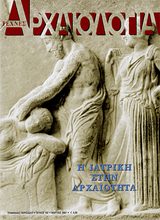
 Ανάγλυφο αφιερωμένο στον Ασκληπιό και την Υγίεια. Ασκληπιείο Πειραιά, περ. 400 π.Χ., Αρχαιολογικό Μουσείο Πειραιά.
Η ιστορία της ιατρικής ως «Μεγάλη Παράδοση», ως χρονικά της επίσημης, κυρίαρχης γνώσης, έχει την τάση να αποσιωπά τη φωνή των «μικρών παραδόσεων», μιας και η ιατρική του απλού κόσμου υποβαθμίζεται στον επιστημονικό λόγο, θεωρούμενη ως πρωτόγονη, λαϊκή, μη-εμπειρική. Το αφιέρωμα του περιοδικού στην Ιστορία της ιατρικής στην Ελλάδα, ενώ ξεκίνησε αρχικά με επίκεντρο τις μεγάλες παραδόσεις, σύντομα έγινε φανερό ότι μια τέτοια πραγμάτευση θα κατέληγε σε πενιχρή αντιγραφή πιο φιλόδοξων και ολοκληρωμένων ήδη έργων. Μέσα από την πρωτοβουλία των συγγραφέων των άρθρων οι ορίζοντες του εγχειρήματος διευρύνονται, ώστε να περιλαμβάνουν και τις μικρές παραδόσεις, αλλά και διερευνήσεις πεδίων με απρόσμενα τελικά αποτελέσματα, πέρα από το σύνολο των ορθόδοξων καταγραφών των περισσότερων ιστοριών της ιατρικής.
Ανάγλυφο αφιερωμένο στον Ασκληπιό και την Υγίεια. Ασκληπιείο Πειραιά, περ. 400 π.Χ., Αρχαιολογικό Μουσείο Πειραιά.
Η ιστορία της ιατρικής ως «Μεγάλη Παράδοση», ως χρονικά της επίσημης, κυρίαρχης γνώσης, έχει την τάση να αποσιωπά τη φωνή των «μικρών παραδόσεων», μιας και η ιατρική του απλού κόσμου υποβαθμίζεται στον επιστημονικό λόγο, θεωρούμενη ως πρωτόγονη, λαϊκή, μη-εμπειρική. Το αφιέρωμα του περιοδικού στην Ιστορία της ιατρικής στην Ελλάδα, ενώ ξεκίνησε αρχικά με επίκεντρο τις μεγάλες παραδόσεις, σύντομα έγινε φανερό ότι μια τέτοια πραγμάτευση θα κατέληγε σε πενιχρή αντιγραφή πιο φιλόδοξων και ολοκληρωμένων ήδη έργων. Μέσα από την πρωτοβουλία των συγγραφέων των άρθρων οι ορίζοντες του εγχειρήματος διευρύνονται, ώστε να περιλαμβάνουν και τις μικρές παραδόσεις, αλλά και διερευνήσεις πεδίων με απρόσμενα τελικά αποτελέσματα, πέρα από το σύνολο των ορθόδοξων καταγραφών των περισσότερων ιστοριών της ιατρικής.
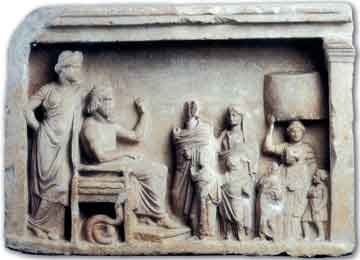 Αναθηματικό ανάγλυφο, οικογένεια με προσφορές προς τον Ασκληπιό και την Υγίεια, 350-300 π.Χ., Βερολίνο, Antikensammlung
Η φροντίδα της υγείας είναι τόσο παλιά όσο ο άνθρωπος. Στους παλαιότερους χρόνους η αποκατάσταση της υγείας, η θεραπεία, θεωρήθηκε ότι επιτυγχάνεται με την επίκληση της θείας δύναμης και, σε πρακτικό επίπεδο, επιδιώχθηκε με ενέργειες που μιμήθηκαν μαγικά την ανανέωση των δυνάμεων της γης, της κατεξοχήν ζωοδότειρας δύναμης στις αγροτοποιμενικές κοινωνίες. Πρακτική υποβοήθηση του ασθενούς δεν έλειψε φυσικά, είτε με φυσικά φάρμακα είτε και με επεμβάσεις. Όμως η διάγνωση και η θεραπεία, η ιατρική, έγινε επιστήμη στην Ελλάδα με τον Ιπποκράτη από την Κω τον 5ο π.Χ. αιώνα, ο οποίος πρώτος εισήγαγε την επιστημονική παρατήρηση, την ανάλυσή της και τη βασισμένη σ’ αυτήν διάγνωση και θεραπεία. Παράλληλα όμως, κατά την κλασική ακόμη εποχή, η θρησκευτική θεραπεία ήταν η περισσότερο διαδεδομένη, με κύριο κέντρο το Ασκληπιείο της Επιδαύρου και τα διακόσια περίπου αφιδρύματά του στη Μεσόγειο, όπου το όνειρο και η αυθυποβολή έπαιζαν τον κύριο ρόλο. Όμως και μέσα από αυτή την πρακτική των ιερών και την καταγραφή και μελέτη των περιπτώσεων αποκτήθηκε πολύτιμη εμπειρία για την επικράτηση της επιστημονικής ιατρικής. Προς το τέλος της αρχαιότητας είχαν ήδη διαμορφωθεί όλες οι πλευρές της παραδοσιακής επιστημονικής ιατρικής, από τις ειδικότητες, τα φάρμακα και τα εργαλεία των επεμβάσεων μέχρι την κοινωνική θέση των γιατρών.
Αναθηματικό ανάγλυφο, οικογένεια με προσφορές προς τον Ασκληπιό και την Υγίεια, 350-300 π.Χ., Βερολίνο, Antikensammlung
Η φροντίδα της υγείας είναι τόσο παλιά όσο ο άνθρωπος. Στους παλαιότερους χρόνους η αποκατάσταση της υγείας, η θεραπεία, θεωρήθηκε ότι επιτυγχάνεται με την επίκληση της θείας δύναμης και, σε πρακτικό επίπεδο, επιδιώχθηκε με ενέργειες που μιμήθηκαν μαγικά την ανανέωση των δυνάμεων της γης, της κατεξοχήν ζωοδότειρας δύναμης στις αγροτοποιμενικές κοινωνίες. Πρακτική υποβοήθηση του ασθενούς δεν έλειψε φυσικά, είτε με φυσικά φάρμακα είτε και με επεμβάσεις. Όμως η διάγνωση και η θεραπεία, η ιατρική, έγινε επιστήμη στην Ελλάδα με τον Ιπποκράτη από την Κω τον 5ο π.Χ. αιώνα, ο οποίος πρώτος εισήγαγε την επιστημονική παρατήρηση, την ανάλυσή της και τη βασισμένη σ’ αυτήν διάγνωση και θεραπεία. Παράλληλα όμως, κατά την κλασική ακόμη εποχή, η θρησκευτική θεραπεία ήταν η περισσότερο διαδεδομένη, με κύριο κέντρο το Ασκληπιείο της Επιδαύρου και τα διακόσια περίπου αφιδρύματά του στη Μεσόγειο, όπου το όνειρο και η αυθυποβολή έπαιζαν τον κύριο ρόλο. Όμως και μέσα από αυτή την πρακτική των ιερών και την καταγραφή και μελέτη των περιπτώσεων αποκτήθηκε πολύτιμη εμπειρία για την επικράτηση της επιστημονικής ιατρικής. Προς το τέλος της αρχαιότητας είχαν ήδη διαμορφωθεί όλες οι πλευρές της παραδοσιακής επιστημονικής ιατρικής, από τις ειδικότητες, τα φάρμακα και τα εργαλεία των επεμβάσεων μέχρι την κοινωνική θέση των γιατρών.
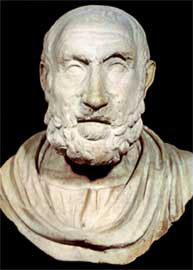 Ρωμαϊκό αντίγραφο προτομής του Ιπποκράτη του 4ου αι. π.Χ., Νεάπολη, Εθνικό Αρχ. Μουσείο
Σε όλα τα βιβλία της ιπποκρατικής συλλογής περιλαμβάνονται σημεία που αναφέρονται στην ιατρική ηθική και δεοντολογία. Η ηθική τοποθετείται στα μεγάλα διλήμματα της ιατρικής, ενώ η δεοντολογία ρυθμίζει τις μεταξύ των γιατρών σχέσεις. Ορισμένα όμως από τα βιβλία ασχολούνται κατά κύριο λόγο με τα πιο πάνω αντικείμενα. Πρόκειται για τα έργα Όρκος, Περί Ιητρού, Περί Ευσχημοσύνης. Στα κείμενα αυτά ο Ιπποκράτης και οι επίγονοί του αναφέρονται στις υποχρεώσεις προς τους ιατροδιδασκάλους, τη διδασκαλία της ιατρικής, το σεβασμό προς τη ζωή, την προστασία των ασθενών και τη διαφύλαξη του ιατρικού κύρους. Ρητά απαγορεύονται η ευθανασία και η άμβλωση, επιβάλλεται ο σεβασμός στο ιατρικό απόρρητο και ο έντιμος βίος. Παρέχονται οδηγίες για την πρέπουσα εμφάνιση, την καλλιέργεια ορισμένων ψυχικών ιδιοτήτων και την ανάπτυξη ήθους. Η επαγγελματική επάρκεια, η διαρκής ενημέρωση, ακόμα και η μετεκπαίδευση σε ξένους τόπους, η δημιουργία στον τόπο νοσηλείας άριστων συνθηκών για τον ασθενή, είναι τα σταθερά ζητούμενα για τον ιπποκρατικό γιατρό. Έμφαση δίνεται στην εκπαίδευση του γιατρού στη φιλοσοφία, που κορυφώνεται με το απόφθεγμα «ιητρός γαρ φιλόσοφος ισόθεος». Η διαχρονική αξία των συναφών αντιλήψεων και το κύρος του Ιπποκράτη συντέλεσαν ώστε οι αρχές αυτές να γίνονται σεβαστές σε μεγάλο μέρος τους ως σήμερα.
Ρωμαϊκό αντίγραφο προτομής του Ιπποκράτη του 4ου αι. π.Χ., Νεάπολη, Εθνικό Αρχ. Μουσείο
Σε όλα τα βιβλία της ιπποκρατικής συλλογής περιλαμβάνονται σημεία που αναφέρονται στην ιατρική ηθική και δεοντολογία. Η ηθική τοποθετείται στα μεγάλα διλήμματα της ιατρικής, ενώ η δεοντολογία ρυθμίζει τις μεταξύ των γιατρών σχέσεις. Ορισμένα όμως από τα βιβλία ασχολούνται κατά κύριο λόγο με τα πιο πάνω αντικείμενα. Πρόκειται για τα έργα Όρκος, Περί Ιητρού, Περί Ευσχημοσύνης. Στα κείμενα αυτά ο Ιπποκράτης και οι επίγονοί του αναφέρονται στις υποχρεώσεις προς τους ιατροδιδασκάλους, τη διδασκαλία της ιατρικής, το σεβασμό προς τη ζωή, την προστασία των ασθενών και τη διαφύλαξη του ιατρικού κύρους. Ρητά απαγορεύονται η ευθανασία και η άμβλωση, επιβάλλεται ο σεβασμός στο ιατρικό απόρρητο και ο έντιμος βίος. Παρέχονται οδηγίες για την πρέπουσα εμφάνιση, την καλλιέργεια ορισμένων ψυχικών ιδιοτήτων και την ανάπτυξη ήθους. Η επαγγελματική επάρκεια, η διαρκής ενημέρωση, ακόμα και η μετεκπαίδευση σε ξένους τόπους, η δημιουργία στον τόπο νοσηλείας άριστων συνθηκών για τον ασθενή, είναι τα σταθερά ζητούμενα για τον ιπποκρατικό γιατρό. Έμφαση δίνεται στην εκπαίδευση του γιατρού στη φιλοσοφία, που κορυφώνεται με το απόφθεγμα «ιητρός γαρ φιλόσοφος ισόθεος». Η διαχρονική αξία των συναφών αντιλήψεων και το κύρος του Ιπποκράτη συντέλεσαν ώστε οι αρχές αυτές να γίνονται σεβαστές σε μεγάλο μέρος τους ως σήμερα.
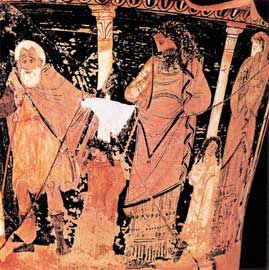 Σκηνή από την τραγωδία "Οιδίπους Τύραννος" του Σοφοκλή ο οποίος χρησιμοποιεί την έννοια του μιάσματος για τη δήλωση ηθικών ρύπων
Οι συγγραφείς του ιπποκρατικού Corpus δεν αγνοούσαν τις κλινικές εκδηλώσεις της μόλυνσης των πληγών και των τραυμάτων και δεν παρέλειπαν να περιγράφουν ασθένειες που σήμερα θεωρούνται μολυσματικές, αλλά δεν έφταναν να συλλάβουν την ιδέα της διάδοσης τέτοιων ασθενειών από ένα πρόσωπο που νοσεί σε ένα άλλο υγιές. Το αίτιο των λοιμικών ασθενειών είναι, κατά τη γνώμη τους, ένας παράγοντας που πλήττει όλα τα προσβεβλημένα πρόσωπα την ίδια στιγμή: o αέρας που αναπνέει ο άνθρωπος. Ο Γαληνός παραδέχεται την παραπάνω αρχή, αλλά αποφαίνεται ότι ο αέρας δεν είναι η μόνη αιτία, ενισχύοντας πάντως την κλασική επιχειρηματολογία, που δεν αναγνωρίζει την έννοια της μετάδοσης. Ο Θουκυδίδης είναι ο πρώτος που μνημονεύει τη μετάδοση ασθένειας από έναν άνθρωπο σε έναν άλλο ή από μια χώρα σε μια άλλη – η ιστορία, στην περίπτωσή του, καθίσταται μέσο απήχησης της κοινής γνώμης. Ο Διόδωρος υπογραμμίζει επίσης τον μεταδοτικό χαρακτήρα του λοιμού του 396 π.Χ., ενώ γι’ αυτόν του 212 π.Χ. μαρτυρία δίνει ο Τίτος Λίβιος, που πίστευε στη μετάδοση εν γένει. Στα λατινικά, καθαρά λογοτεχνικά (και όχι ιατρικά) κείμενα, γίνεται με μεγαλύτερη ευκολία παραδεκτή η έννοια της μετάδοσης, ενώ και τα αφιερωμένα στη ζωοτεχνία και την κτηνιατρική έργα περιέχουν ανάλογους υπαινιγμούς. Ο Αρεταίος πρέπει να είναι ο πρώτος από τους ομοτέχνους του που εκφράστηκε υπέρ της μεταδοτικότητας κάποιων ασθενειών. Από τα παραπάνω γίνεται εμφανές ότι ιστορικοί, φιλόσοφοι, ζωολόγοι και γεωπόνοι αναφέρονται στη μεταδοτικότητα των νόσων, όχι όμως και οι ιατροί, γιατί θεωρούν ότι θέτει σε κίνδυνο τις ορθολογικές θεωρίες που βασίζονται σε μια αυστηρή ερμηνεία της αιτιοκρατίας στην ατομική νοσογραφία.
Σκηνή από την τραγωδία "Οιδίπους Τύραννος" του Σοφοκλή ο οποίος χρησιμοποιεί την έννοια του μιάσματος για τη δήλωση ηθικών ρύπων
Οι συγγραφείς του ιπποκρατικού Corpus δεν αγνοούσαν τις κλινικές εκδηλώσεις της μόλυνσης των πληγών και των τραυμάτων και δεν παρέλειπαν να περιγράφουν ασθένειες που σήμερα θεωρούνται μολυσματικές, αλλά δεν έφταναν να συλλάβουν την ιδέα της διάδοσης τέτοιων ασθενειών από ένα πρόσωπο που νοσεί σε ένα άλλο υγιές. Το αίτιο των λοιμικών ασθενειών είναι, κατά τη γνώμη τους, ένας παράγοντας που πλήττει όλα τα προσβεβλημένα πρόσωπα την ίδια στιγμή: o αέρας που αναπνέει ο άνθρωπος. Ο Γαληνός παραδέχεται την παραπάνω αρχή, αλλά αποφαίνεται ότι ο αέρας δεν είναι η μόνη αιτία, ενισχύοντας πάντως την κλασική επιχειρηματολογία, που δεν αναγνωρίζει την έννοια της μετάδοσης. Ο Θουκυδίδης είναι ο πρώτος που μνημονεύει τη μετάδοση ασθένειας από έναν άνθρωπο σε έναν άλλο ή από μια χώρα σε μια άλλη – η ιστορία, στην περίπτωσή του, καθίσταται μέσο απήχησης της κοινής γνώμης. Ο Διόδωρος υπογραμμίζει επίσης τον μεταδοτικό χαρακτήρα του λοιμού του 396 π.Χ., ενώ γι’ αυτόν του 212 π.Χ. μαρτυρία δίνει ο Τίτος Λίβιος, που πίστευε στη μετάδοση εν γένει. Στα λατινικά, καθαρά λογοτεχνικά (και όχι ιατρικά) κείμενα, γίνεται με μεγαλύτερη ευκολία παραδεκτή η έννοια της μετάδοσης, ενώ και τα αφιερωμένα στη ζωοτεχνία και την κτηνιατρική έργα περιέχουν ανάλογους υπαινιγμούς. Ο Αρεταίος πρέπει να είναι ο πρώτος από τους ομοτέχνους του που εκφράστηκε υπέρ της μεταδοτικότητας κάποιων ασθενειών. Από τα παραπάνω γίνεται εμφανές ότι ιστορικοί, φιλόσοφοι, ζωολόγοι και γεωπόνοι αναφέρονται στη μεταδοτικότητα των νόσων, όχι όμως και οι ιατροί, γιατί θεωρούν ότι θέτει σε κίνδυνο τις ορθολογικές θεωρίες που βασίζονται σε μια αυστηρή ερμηνεία της αιτιοκρατίας στην ατομική νοσογραφία.
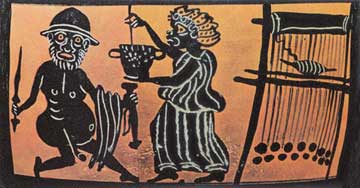 Η μάγισσα Κίρκη ενώ προσπαθεί να πείσει τον Οδυσσέα να πιει το μαγικό της ποτό.
Οι γνώσεις για τα φάρμακα (κυρίως φαρμακευτικά φυτά, αλλά και ζωικά και ορυκτά προϊόντα) στην αρχαία Ελλάδα ξεκινούν από τα βάθη των αιώνων, διατηρούνται στο πλαίσιο της λαϊκής ιατρικής και αργότερα ενσωματώνονται, διαμορφώνονται και αποκτούν θεωρητικές βάσεις με την «επιστημονική ιατρική», κυρίως από την εποχή των ιπποκρατικών κειμένων. Κεντρική σημασία για τη συστηματοποίηση και διάδοση αυτών των γνώσεων και αντιλήψεων έχουν τα έργα του Διοσκουρίδη και του Γαληνού. Σύμφωνα με τις επιστημονικές αντιλήψεις της εποχής, τα φάρμακα δρουν θεραπευτικά αποκαθιστώντας την «ισορροπία» των χυμών και των ποιοτήτων, καθώς και μέσω των πολυποίκιλων «δυνάμεών» τους. Τα φάρμακα χρησιμοποιούνταν θεραπευτικά παράλληλα με τη δίαιτα (ρύθμιση του τρόπου ζωής), η οποία, τουλάχιστον στο πλαίσιο της ιπποκρατικής ιατρικής, αποτελούσε το κύριο μέσο θεραπείας και πρόληψης. Οι θεραπευτικές αυτές αντιλήψεις επηρέασαν σημαντικά την ιατρική της Δύσης μέχρι και τους νεότερους χρόνους.
Η μάγισσα Κίρκη ενώ προσπαθεί να πείσει τον Οδυσσέα να πιει το μαγικό της ποτό.
Οι γνώσεις για τα φάρμακα (κυρίως φαρμακευτικά φυτά, αλλά και ζωικά και ορυκτά προϊόντα) στην αρχαία Ελλάδα ξεκινούν από τα βάθη των αιώνων, διατηρούνται στο πλαίσιο της λαϊκής ιατρικής και αργότερα ενσωματώνονται, διαμορφώνονται και αποκτούν θεωρητικές βάσεις με την «επιστημονική ιατρική», κυρίως από την εποχή των ιπποκρατικών κειμένων. Κεντρική σημασία για τη συστηματοποίηση και διάδοση αυτών των γνώσεων και αντιλήψεων έχουν τα έργα του Διοσκουρίδη και του Γαληνού. Σύμφωνα με τις επιστημονικές αντιλήψεις της εποχής, τα φάρμακα δρουν θεραπευτικά αποκαθιστώντας την «ισορροπία» των χυμών και των ποιοτήτων, καθώς και μέσω των πολυποίκιλων «δυνάμεών» τους. Τα φάρμακα χρησιμοποιούνταν θεραπευτικά παράλληλα με τη δίαιτα (ρύθμιση του τρόπου ζωής), η οποία, τουλάχιστον στο πλαίσιο της ιπποκρατικής ιατρικής, αποτελούσε το κύριο μέσο θεραπείας και πρόληψης. Οι θεραπευτικές αυτές αντιλήψεις επηρέασαν σημαντικά την ιατρική της Δύσης μέχρι και τους νεότερους χρόνους.
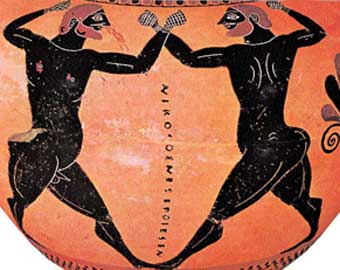 Σκηνή από πυγμαχικό αγώνα. Μελανόμορφος αμφορέας, 530 π.Χ., Βρετανικό Μουσείο, Λονδίνο.
Στους αυτοκρατορικούς χρόνους σημειώνεται η μεταβολή των αθλητικών συνηθειών και καταγράφεται η επικράτηση της αγωνιστικής εξάσκησης. Γίνεται λόγος για την έλλειψη σύμμετρης και ελεγχόμενης άσκησης και για τους κινδύνους που αυτή η κατάσταση επιφέρει στη φύση των αθλητών. Διαπιστώνεται η αδυναμία διάγνωσης της σωματικής και ψυχικής συγκρότησης του γυμναζόμενου και συνεπώς η ανικανότητα επιλογής και προσαρμογής των γυμνασίων. Ως απάντηση σε αυτήν την πραγματικότητα επιζητείται από διανοούμενους της εποχής ο επαναπροσδιορισμός της γυμναστικής σε σχέση με την ιατρική και την υγιεινή και προτείνεται η εφαρμογή της υγιεινής τέχνης. Προβάλλεται η θέση ότι μόνο η «κατά φύσιν ευεξία», που διακρίνεται από την αθλητική ευεξία, προφυλάσσει την υγεία. Τονίζεται μάλιστα ότι η περί το σώμα τέχνη, η γυμναστική, πρέπει να αποτελεί μέρος της υγιεινής. Προβάλλεται, επίσης, η ανάγκη συμμετοχής στην άσκηση ενός επιστήμονα γυμναστή, που θα είναι ικανός να αξιολογήσει την καταλληλότητα των γυμνασίων και των σωμάτων καθώς και να ελέγχει τη χρησιμότητα ή την επικινδυνότητα των ασκήσεων, να κατέχει δηλαδή υγιεινές και ιατρικές γνώσεις. Βασικός στόχος αυτής της εργασίας είναι να προβάλει μαρτυρίες σχετικές με τη συγκρότηση της υγιεινής πρότασης των αυτοκρατορικών χρόνων και με τη συμβολή της επιστήμης των γυμνασίων στη διαφύλαξη και στην παροχή της υγείας.
Σκηνή από πυγμαχικό αγώνα. Μελανόμορφος αμφορέας, 530 π.Χ., Βρετανικό Μουσείο, Λονδίνο.
Στους αυτοκρατορικούς χρόνους σημειώνεται η μεταβολή των αθλητικών συνηθειών και καταγράφεται η επικράτηση της αγωνιστικής εξάσκησης. Γίνεται λόγος για την έλλειψη σύμμετρης και ελεγχόμενης άσκησης και για τους κινδύνους που αυτή η κατάσταση επιφέρει στη φύση των αθλητών. Διαπιστώνεται η αδυναμία διάγνωσης της σωματικής και ψυχικής συγκρότησης του γυμναζόμενου και συνεπώς η ανικανότητα επιλογής και προσαρμογής των γυμνασίων. Ως απάντηση σε αυτήν την πραγματικότητα επιζητείται από διανοούμενους της εποχής ο επαναπροσδιορισμός της γυμναστικής σε σχέση με την ιατρική και την υγιεινή και προτείνεται η εφαρμογή της υγιεινής τέχνης. Προβάλλεται η θέση ότι μόνο η «κατά φύσιν ευεξία», που διακρίνεται από την αθλητική ευεξία, προφυλάσσει την υγεία. Τονίζεται μάλιστα ότι η περί το σώμα τέχνη, η γυμναστική, πρέπει να αποτελεί μέρος της υγιεινής. Προβάλλεται, επίσης, η ανάγκη συμμετοχής στην άσκηση ενός επιστήμονα γυμναστή, που θα είναι ικανός να αξιολογήσει την καταλληλότητα των γυμνασίων και των σωμάτων καθώς και να ελέγχει τη χρησιμότητα ή την επικινδυνότητα των ασκήσεων, να κατέχει δηλαδή υγιεινές και ιατρικές γνώσεις. Βασικός στόχος αυτής της εργασίας είναι να προβάλει μαρτυρίες σχετικές με τη συγκρότηση της υγιεινής πρότασης των αυτοκρατορικών χρόνων και με τη συμβολή της επιστήμης των γυμνασίων στη διαφύλαξη και στην παροχή της υγείας.
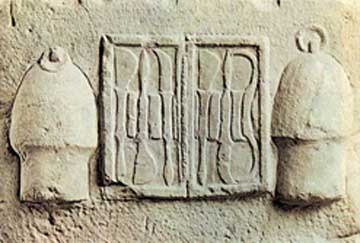 Τμήμα αναγλύφου όπου παριστάνεται θήκη χειρουργικών εργαλείων, Εθνικό Αρχαιολογικό Μουσείο, Αθήνα.
Ο ιατρός Αρεταίος από την Καππαδοκία (2ος αι. μ.Χ.) θεωρείται από τους σπουδαιότερους Έλληνες ιατρούς της Ρωμαϊκής εποχής. Στα δύο από τα οκτώ βιβλία του που σώζονται α) Περί αιτιών και σημείων οξέων και χρονίων παθών, και β) Περί θεραπείας οξέων και χρονίων παθών,μεταξύ άλλων θεμάτων όπως είναι η νευρίτιδα, η φυματίωση, η επιληψία, και κυρίως η εκτεταμένη αναφορά στα συμπτώματα του διαβήτη, ο Αρεταίος αναφέρεται και στον «ειλεό».
Ο Αρεταίος θεωρεί τον «ειλεό» ως μία φλεγμονή του εντέρου, που συνήθως συνοδεύεται από δυνατό πόνο. Δύο κατ’ αυτόν είναι οι αιτίες που προκαλούν ειλεό: η πρώτη αφορά στην ποσότητα και στην ποιότητα της προσλαμβανόμενης τροφής, και η δεύτερη σε τραυματισμό του εντέρου. Στα κείμενά του ο Αρεταίος σημειώνει ότι ο «ειλεός» είναι μία ασθένεια που θα μπορούσε να επηρεάσει τόσο το λεπτό όσο και το παχύ έντερο. Ωστόσο, αναφέρεται σε ποικίλους τύπους «ειλεού» ανάλογα με τη σοβαρότητα της κάθε περίπτωσης και περιγράφει λεπτομερώς τα συμπτώματα και την κλινική τους εικόνα. Επίσης αναφέρεται στην πιθανότητα παρουσίας ενδοκοιλιακού αποστήματος ως επιπλοκή του «ειλεού».
Ως προς τη θεραπεία ο Αρεταίος προτείνει ότι πρώτα θα πρέπει να αντιμετωπισθεί ο πόνος με τη χρήση αναισθητικών. Πολλοί τρόποι θεραπείας προτείνονται ακόμα, όπως πρόκληση εμετού, ατμόλουτρα, καταπλάσματα, βεντούζες, αφεψήματα και δίαιτα. Όλες αυτές οι πρακτικές αποσκοπούν στο να εκδιωχθεί ο παγιδευμένος αέρας μέσα από τα έντερα.
Τμήμα αναγλύφου όπου παριστάνεται θήκη χειρουργικών εργαλείων, Εθνικό Αρχαιολογικό Μουσείο, Αθήνα.
Ο ιατρός Αρεταίος από την Καππαδοκία (2ος αι. μ.Χ.) θεωρείται από τους σπουδαιότερους Έλληνες ιατρούς της Ρωμαϊκής εποχής. Στα δύο από τα οκτώ βιβλία του που σώζονται α) Περί αιτιών και σημείων οξέων και χρονίων παθών, και β) Περί θεραπείας οξέων και χρονίων παθών,μεταξύ άλλων θεμάτων όπως είναι η νευρίτιδα, η φυματίωση, η επιληψία, και κυρίως η εκτεταμένη αναφορά στα συμπτώματα του διαβήτη, ο Αρεταίος αναφέρεται και στον «ειλεό».
Ο Αρεταίος θεωρεί τον «ειλεό» ως μία φλεγμονή του εντέρου, που συνήθως συνοδεύεται από δυνατό πόνο. Δύο κατ’ αυτόν είναι οι αιτίες που προκαλούν ειλεό: η πρώτη αφορά στην ποσότητα και στην ποιότητα της προσλαμβανόμενης τροφής, και η δεύτερη σε τραυματισμό του εντέρου. Στα κείμενά του ο Αρεταίος σημειώνει ότι ο «ειλεός» είναι μία ασθένεια που θα μπορούσε να επηρεάσει τόσο το λεπτό όσο και το παχύ έντερο. Ωστόσο, αναφέρεται σε ποικίλους τύπους «ειλεού» ανάλογα με τη σοβαρότητα της κάθε περίπτωσης και περιγράφει λεπτομερώς τα συμπτώματα και την κλινική τους εικόνα. Επίσης αναφέρεται στην πιθανότητα παρουσίας ενδοκοιλιακού αποστήματος ως επιπλοκή του «ειλεού».
Ως προς τη θεραπεία ο Αρεταίος προτείνει ότι πρώτα θα πρέπει να αντιμετωπισθεί ο πόνος με τη χρήση αναισθητικών. Πολλοί τρόποι θεραπείας προτείνονται ακόμα, όπως πρόκληση εμετού, ατμόλουτρα, καταπλάσματα, βεντούζες, αφεψήματα και δίαιτα. Όλες αυτές οι πρακτικές αποσκοπούν στο να εκδιωχθεί ο παγιδευμένος αέρας μέσα από τα έντερα.
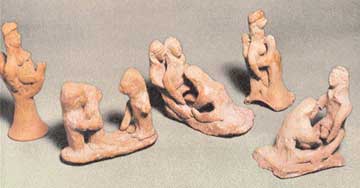 Συμπλέγματα πήλινων ειδωλίων που απεικονίζουν διάφορα στάδια του τοκετού.
Σκοπός και σημασία της παρούσας μελέτης είναι να καταδείξει εν συντομία τον πλούτο των μεθόδων και των εργαλείων που είχαν επινοήσει οι αρχαίοι Έλληνες ιατροί που ασχολήθηκαν με την άσκηση της Μαιευτικής και Γυναικολογίας κατά τη Μυκηναϊκή εποχή, την Αρχαϊκή, την Αρχαία, την Ελληνιστική μέχρι τον 3ο αιώνα μ.Χ. Στο άρθρο καταγράφονται επιγραμματικά οι κυριότερες γνώσεις Μαιευτικής σχετικά με την εγκυμοσύνη, τον τοκετό, τη λοχεία, τις επιπλοκές που δύνανται να εμφανισθούν και τις επεμβάσεις που προτείνουν οι αρχαίοι Έλληνες ιατροί για την αντιμετώπισή τους. Παράλληλα, επιχειρείται η παρουσίαση και των γνώσεων Γυναικολογίας κατά τις παραπάνω περιόδους σχετικά με θέματα ανατομίας και φυσιολογίας του γυναικείου γεννητικού συστήματος, με γυναικολογικές παθήσεις και με τη θεραπεία τους. Μέσα από την παραπάνω μελέτη γίνεται εμφανής η τεράστια συμβολή των αρχαίων Ελλήνων ιατρών που με τις πρωτοπόρες επινοήσεις τους έθεσαν τις βάσεις για την ανάπτυξη, της σημαντικής για τη γυναίκα, ειδικότητας της Μαιευτικής-Γυναικολογίας στον υπόλοιπο κόσμο.
Συμπλέγματα πήλινων ειδωλίων που απεικονίζουν διάφορα στάδια του τοκετού.
Σκοπός και σημασία της παρούσας μελέτης είναι να καταδείξει εν συντομία τον πλούτο των μεθόδων και των εργαλείων που είχαν επινοήσει οι αρχαίοι Έλληνες ιατροί που ασχολήθηκαν με την άσκηση της Μαιευτικής και Γυναικολογίας κατά τη Μυκηναϊκή εποχή, την Αρχαϊκή, την Αρχαία, την Ελληνιστική μέχρι τον 3ο αιώνα μ.Χ. Στο άρθρο καταγράφονται επιγραμματικά οι κυριότερες γνώσεις Μαιευτικής σχετικά με την εγκυμοσύνη, τον τοκετό, τη λοχεία, τις επιπλοκές που δύνανται να εμφανισθούν και τις επεμβάσεις που προτείνουν οι αρχαίοι Έλληνες ιατροί για την αντιμετώπισή τους. Παράλληλα, επιχειρείται η παρουσίαση και των γνώσεων Γυναικολογίας κατά τις παραπάνω περιόδους σχετικά με θέματα ανατομίας και φυσιολογίας του γυναικείου γεννητικού συστήματος, με γυναικολογικές παθήσεις και με τη θεραπεία τους. Μέσα από την παραπάνω μελέτη γίνεται εμφανής η τεράστια συμβολή των αρχαίων Ελλήνων ιατρών που με τις πρωτοπόρες επινοήσεις τους έθεσαν τις βάσεις για την ανάπτυξη, της σημαντικής για τη γυναίκα, ειδικότητας της Μαιευτικής-Γυναικολογίας στον υπόλοιπο κόσμο.
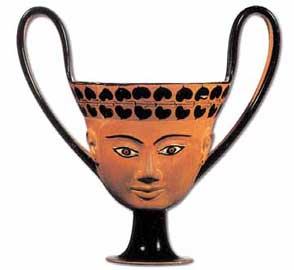 Πλαστικός ανθρωπόμορφος κάνθαρος, 540-530 π.Χ., Staatliche Antikensammlungen, Μόναχο.
Οι αρχαίοι Έλληνες (καθώς και, σε μεγάλο βαθμό, οι Ρωμαίοι) αντιμετώπιζαν τον οφθαλμό και τη λειτουργία του εμπειρικά, γεγονός που επηρέασε και τα πρώτα βήματα της επιστημονικής οφθαλμολογίας. Αν και γνωστός ανατομικά, ο οφθαλμός μελετήθηκε από τους Έλληνες φυσιολόγους (με προεξάρχοντα τον Αριστοτέλη) κυρίως εξωτερικά, τελεολογικά, προσέγγιση που επηρέασε τους μεταγενέστερους περιπατητικούς, αλλά και την κοινή γνώμη της εποχής. Ο Ευκλείδης, επίσης της περιπατητικής σχολής, περιέγραψε με γραμμικό τρόπο την κίνηση του φωτός και έθεσε τις βάσεις της γεωμετρικής Οπτικής (τις οποίες αξιοποίησε πολύ αργότερα ο Πτολεμαίος). Άλλοι, συστηματοποίησαν τις φιλοσοφικές – μεταφυσικές προσεγγίσεις των προσωκρατικών, των ατομικών, και του Πλάτωνα, ενώ η ανάπτυξη των κατόπτρων και η εξερεύνηση των δυνατοτήτων τους αποτέλεσε πεδίο έντονης δράσης για μεταγενέστερους φιλοσόφους, όπως ο Αρχιμήδης. Όπως είναι φυσικό, οι αναζητήσεις των φιλοσόφων, ιατρών και φυσιολόγων μόνον έμμεσα επηρέασαν την καθημερινότητα του ελληνορωμαϊκού κόσμου. Παθήσεις και ασθένειες των οφθαλμών αντιμετωπίζονταν συμπτωματικά, βάσει παραδοσιακών πρακτικών και κοινώς διαδεδομένων αντιλήψεων. Στα κείμενα, από τους ήρωες του Αριστοφάνη μέχρι τον ίδιο τον Κικέρωνα, ακούμε για τις κοινότερες παθήσεις και την – μάταιη συνήθως – απόπειρα θεραπείας τους. Οι ιατροί της ιπποκρατικής παράδοσης, ο Γαληνός, ο Ρωμαίος Κέλσος, και οι άλλοι ομότεχνοί τους, βάσιζαν τη θεωρία τους περί οφθαλμολογίας στον Αριστοτέλη και τις θεραπευτικές πρακτικές τους στην παράδοση. Την ίδια στιγμή, η τέχνη, διαποτισμένη από την ώσμωση με την επιστήμη – τόσο την «υψηλή», όσο και την παραδοσιακή, λαϊκή – αποδίδει με ευγλωττία τον τρόπο με τον οποίο ο ελληνορωμαϊκός κόσμος αντιμετώπιζε το βλέμμα.
Πλαστικός ανθρωπόμορφος κάνθαρος, 540-530 π.Χ., Staatliche Antikensammlungen, Μόναχο.
Οι αρχαίοι Έλληνες (καθώς και, σε μεγάλο βαθμό, οι Ρωμαίοι) αντιμετώπιζαν τον οφθαλμό και τη λειτουργία του εμπειρικά, γεγονός που επηρέασε και τα πρώτα βήματα της επιστημονικής οφθαλμολογίας. Αν και γνωστός ανατομικά, ο οφθαλμός μελετήθηκε από τους Έλληνες φυσιολόγους (με προεξάρχοντα τον Αριστοτέλη) κυρίως εξωτερικά, τελεολογικά, προσέγγιση που επηρέασε τους μεταγενέστερους περιπατητικούς, αλλά και την κοινή γνώμη της εποχής. Ο Ευκλείδης, επίσης της περιπατητικής σχολής, περιέγραψε με γραμμικό τρόπο την κίνηση του φωτός και έθεσε τις βάσεις της γεωμετρικής Οπτικής (τις οποίες αξιοποίησε πολύ αργότερα ο Πτολεμαίος). Άλλοι, συστηματοποίησαν τις φιλοσοφικές – μεταφυσικές προσεγγίσεις των προσωκρατικών, των ατομικών, και του Πλάτωνα, ενώ η ανάπτυξη των κατόπτρων και η εξερεύνηση των δυνατοτήτων τους αποτέλεσε πεδίο έντονης δράσης για μεταγενέστερους φιλοσόφους, όπως ο Αρχιμήδης. Όπως είναι φυσικό, οι αναζητήσεις των φιλοσόφων, ιατρών και φυσιολόγων μόνον έμμεσα επηρέασαν την καθημερινότητα του ελληνορωμαϊκού κόσμου. Παθήσεις και ασθένειες των οφθαλμών αντιμετωπίζονταν συμπτωματικά, βάσει παραδοσιακών πρακτικών και κοινώς διαδεδομένων αντιλήψεων. Στα κείμενα, από τους ήρωες του Αριστοφάνη μέχρι τον ίδιο τον Κικέρωνα, ακούμε για τις κοινότερες παθήσεις και την – μάταιη συνήθως – απόπειρα θεραπείας τους. Οι ιατροί της ιπποκρατικής παράδοσης, ο Γαληνός, ο Ρωμαίος Κέλσος, και οι άλλοι ομότεχνοί τους, βάσιζαν τη θεωρία τους περί οφθαλμολογίας στον Αριστοτέλη και τις θεραπευτικές πρακτικές τους στην παράδοση. Την ίδια στιγμή, η τέχνη, διαποτισμένη από την ώσμωση με την επιστήμη – τόσο την «υψηλή», όσο και την παραδοσιακή, λαϊκή – αποδίδει με ευγλωττία τον τρόπο με τον οποίο ο ελληνορωμαϊκός κόσμος αντιμετώπιζε το βλέμμα.
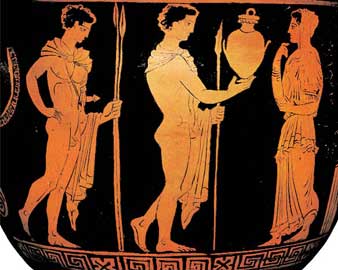 Ο Ορέστης προσφέρει στην Ηλέκτρα την κάλπη που υποτίθεται ότι περιέχει τα οστά του αδελφού της.
Στο πρώτο μέρος του άρθρου σχολιάζεται το πλούσιο λεκτικό και σημασιολογικό φάσμα που προσφέρει η «νόσος» -και κατ’επέκταση η «ίαση»- στην αρχαία ελληνική τραγωδία και κωμωδία, και εξετάζεται συγκριτικά ο δραματικός, θεαματικός και κυρίως μεταφορικός χαρακτήρας που αποκτούν οι σωματικές, ψυχικές και διανοητικές ασθένειες που πλήττουν κατ’εξοχήν τα τραγικά πρόσωπα (η μόλυνση του Φιλοκτήτη στον Φιλοκτήτη, η ψυχική νόσος του Ηρακλή, του Ορέστη, της Ιούς στις τραγωδίες Ηρακλής Μαινόμενος, Ορέστης,Προμηθεύς Δεσμώτης, η υπέρμετρη ψυχική παραφορά της Μήδειας, της Φαίδρας, της Ιοκάστης στις τραγωδίες Μήδεια, Ιππόλυτος, Οιδίπους Τύραννος και Φοίνισσαι κ.ά.), αλλά –σε μικρότερο βαθμό– και τα κωμικά πρόσωπα (η δικομανία του Φιλοκλέωνα στους Σφήκες, η «μανία του Τρυγαίου να ανέβει στην ουράνια κατοικία του Δία στηνΕιρήνη, ο τραυματισμός του φιλοπόλεμου Λαμάχου στους Αχαρνείςκ.ά.). Μέσα από ποσοτικές και ποιοτικές συνεκτιμήσεις, η πιο θεμελιακή ειδολογική διαφορά της «νόσου» ανάμεσα στην τραγική και την κωμική αναπαράστασή της φαίνεται να είναι το γεγονός ότι τα παντοδαπώς και συνήθως «νοσούντα» τραγικά πρόσωπα –αν δεν καταλήγουν σε καταστροφικές και αυτο-καταστροφικές λύσεις– σπανίως επιβιώνουν και, πολύ μάλλον, σπανίως θεραπεύονται, σε αντίθεση με τα κωμικά, λιγότερο ευάλωτα σε σοβαρές ασθένειες, πρόσωπα, που όχι μόνο επιβιώνουν –και μερικές φορές θεραπεύονται– αλλά και καταφέρνουν να μεταστρέψουν τη «νόσο» τους σε ζωτική δύναμη παρέμβασης και δράσης για την επίτευξη ενός ιδεατού στόχου.
Στο δεύτερο μέρος του άρθρου η μελέτη επικεντρώνεται σε δύο αντιπροσωπευτικές περιπτώσεις «τυφλότητας» και στην εξέλιξη που η καθεμιά «ιατρική περίπτωση» έχει στην περιοχή της τραγωδίας και της κωμωδίας, αντίστοιχα: συγκεκριμένα, μελετώνται παράλληλα η εκουσίως προκληθείσα «τυφλότητα» του μυθικού Οιδίποδα στονΟιδίποδα επί Κολωνώ –την τελευταία τραγωδία του Σοφοκλή, η οποία διδάχτηκε πιθανώς το 401, μετά θάνατον του ποιητή, από τον ομώνυμο εγγονό του– και η ακουσίως επιβληθείσα «τυφλότητα» του θεού Πλούτου στον Πλούτο –την τελευταία σωζόμενη κωμωδία του Αριστοφάνη, η οποία διδάχτηκε πιθανώς το 388 π.Χ. και ενδεχομένως διασκευάζει ριζικά μια πρώτη ομώνυμη θεατρική δημιουργία του Αριστοφάνη, που παίχτηκε το 408. Μέσα από τη συνεξέταση των δύο αυτών –χρονικά και ιστορικά κοντινών– θεατρικών παραδειγμάτων, θα αναζητηθούν οι συγκλίσεις και αποκλίσεις τους ως προς το δραματικό χειρισμό και το σημασιοδοτικό εμπλουτισμό της «τυφλότητας» ως αναπηρίας προσωπικής και συλλογικής, σωματικής και ηθικής, κυριολεκτικής και μεταφορικής, έτσι όπως αυτή φαίνεται να διατρέχει ως κοινό, πλην μεταλλασσόμενο ειδολογικά, «μοτίβο» τα δύο δράματα. Με πρίσμα την «τυφλότητα» των δύο συγκεκριμένων δραματικών προσώπων και τους διαφορετικούς τρόπους αντιμετώπισής της –«αποθέωση» του τυφλού Οιδίποδα χάρη στην καθοριστική παρέμβαση του ηγέτη Θησέα και θαυματική «ίαση» του Πλούτου χάρη στην καθοριστική παρέμβαση του μικρο-καλλιεργητή Χρεμύλου και του δούλου του– οι δύο Αθηναίοι ποιητές, στο πέρας της ζωής τους εξίσου, φαίνονται να ανατομούν –με το διαφορετικό δραματικό νυστέρι του ο καθένας– την ίδια την «πόλη» και τις δυσλειτουργίες της, για να προτείνουν, περισσότερο ή λιγότερο, ριζικές και ουτοπικές «θεραπείες» της.
Ο Ορέστης προσφέρει στην Ηλέκτρα την κάλπη που υποτίθεται ότι περιέχει τα οστά του αδελφού της.
Στο πρώτο μέρος του άρθρου σχολιάζεται το πλούσιο λεκτικό και σημασιολογικό φάσμα που προσφέρει η «νόσος» -και κατ’επέκταση η «ίαση»- στην αρχαία ελληνική τραγωδία και κωμωδία, και εξετάζεται συγκριτικά ο δραματικός, θεαματικός και κυρίως μεταφορικός χαρακτήρας που αποκτούν οι σωματικές, ψυχικές και διανοητικές ασθένειες που πλήττουν κατ’εξοχήν τα τραγικά πρόσωπα (η μόλυνση του Φιλοκτήτη στον Φιλοκτήτη, η ψυχική νόσος του Ηρακλή, του Ορέστη, της Ιούς στις τραγωδίες Ηρακλής Μαινόμενος, Ορέστης,Προμηθεύς Δεσμώτης, η υπέρμετρη ψυχική παραφορά της Μήδειας, της Φαίδρας, της Ιοκάστης στις τραγωδίες Μήδεια, Ιππόλυτος, Οιδίπους Τύραννος και Φοίνισσαι κ.ά.), αλλά –σε μικρότερο βαθμό– και τα κωμικά πρόσωπα (η δικομανία του Φιλοκλέωνα στους Σφήκες, η «μανία του Τρυγαίου να ανέβει στην ουράνια κατοικία του Δία στηνΕιρήνη, ο τραυματισμός του φιλοπόλεμου Λαμάχου στους Αχαρνείςκ.ά.). Μέσα από ποσοτικές και ποιοτικές συνεκτιμήσεις, η πιο θεμελιακή ειδολογική διαφορά της «νόσου» ανάμεσα στην τραγική και την κωμική αναπαράστασή της φαίνεται να είναι το γεγονός ότι τα παντοδαπώς και συνήθως «νοσούντα» τραγικά πρόσωπα –αν δεν καταλήγουν σε καταστροφικές και αυτο-καταστροφικές λύσεις– σπανίως επιβιώνουν και, πολύ μάλλον, σπανίως θεραπεύονται, σε αντίθεση με τα κωμικά, λιγότερο ευάλωτα σε σοβαρές ασθένειες, πρόσωπα, που όχι μόνο επιβιώνουν –και μερικές φορές θεραπεύονται– αλλά και καταφέρνουν να μεταστρέψουν τη «νόσο» τους σε ζωτική δύναμη παρέμβασης και δράσης για την επίτευξη ενός ιδεατού στόχου.
Στο δεύτερο μέρος του άρθρου η μελέτη επικεντρώνεται σε δύο αντιπροσωπευτικές περιπτώσεις «τυφλότητας» και στην εξέλιξη που η καθεμιά «ιατρική περίπτωση» έχει στην περιοχή της τραγωδίας και της κωμωδίας, αντίστοιχα: συγκεκριμένα, μελετώνται παράλληλα η εκουσίως προκληθείσα «τυφλότητα» του μυθικού Οιδίποδα στονΟιδίποδα επί Κολωνώ –την τελευταία τραγωδία του Σοφοκλή, η οποία διδάχτηκε πιθανώς το 401, μετά θάνατον του ποιητή, από τον ομώνυμο εγγονό του– και η ακουσίως επιβληθείσα «τυφλότητα» του θεού Πλούτου στον Πλούτο –την τελευταία σωζόμενη κωμωδία του Αριστοφάνη, η οποία διδάχτηκε πιθανώς το 388 π.Χ. και ενδεχομένως διασκευάζει ριζικά μια πρώτη ομώνυμη θεατρική δημιουργία του Αριστοφάνη, που παίχτηκε το 408. Μέσα από τη συνεξέταση των δύο αυτών –χρονικά και ιστορικά κοντινών– θεατρικών παραδειγμάτων, θα αναζητηθούν οι συγκλίσεις και αποκλίσεις τους ως προς το δραματικό χειρισμό και το σημασιοδοτικό εμπλουτισμό της «τυφλότητας» ως αναπηρίας προσωπικής και συλλογικής, σωματικής και ηθικής, κυριολεκτικής και μεταφορικής, έτσι όπως αυτή φαίνεται να διατρέχει ως κοινό, πλην μεταλλασσόμενο ειδολογικά, «μοτίβο» τα δύο δράματα. Με πρίσμα την «τυφλότητα» των δύο συγκεκριμένων δραματικών προσώπων και τους διαφορετικούς τρόπους αντιμετώπισής της –«αποθέωση» του τυφλού Οιδίποδα χάρη στην καθοριστική παρέμβαση του ηγέτη Θησέα και θαυματική «ίαση» του Πλούτου χάρη στην καθοριστική παρέμβαση του μικρο-καλλιεργητή Χρεμύλου και του δούλου του– οι δύο Αθηναίοι ποιητές, στο πέρας της ζωής τους εξίσου, φαίνονται να ανατομούν –με το διαφορετικό δραματικό νυστέρι του ο καθένας– την ίδια την «πόλη» και τις δυσλειτουργίες της, για να προτείνουν, περισσότερο ή λιγότερο, ριζικές και ουτοπικές «θεραπείες» της.
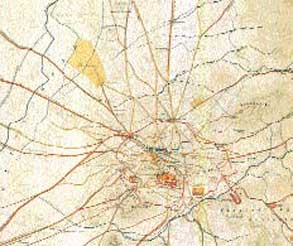 Ιστορικός Τοπογραφικός και Αρχαιολογικός Χάρτης Kaupert του 1874. Στη δυτική πλευρά, ο αρχαίος Ελαιώνας των Αθηνών.
Στο πλαίσιο της οργάνωσης των Ολυμπιακών Αγώνων του 2004 υλοποιήθηκε ευρύ φάσμα έργων, τα οποία αποβλέπουν τόσο στον εκσυγχρονισμό των συγκοινωνιακών υποδομών της Αττικής, όσο και στην ενοποίηση αρχαιολογικών και ιστορικών χώρων στο κέντρο της πρωτεύουσας. Στον τομέα των πολεοδομικών παρεμβάσεων και αναπλάσεων συγκαταλέγεται, μεταξύ άλλων, και η αποκατάσταση μέρους ενός ακόμη διακεκριμένου μνημείου της πόλης: του ιστορικού Ελαιώνα των Αθηνών.
Tο εν λόγω έργο σχεδιάστηκε και υλοποιήθηκε με στόχο να αποτελέσει μια σύγχρονη ελληνική συνεισφορά στον τομέα της αρχιτεκτονικής τοπίου, διασώζοντας και αναδεικνύοντας την παραμερισμένη αρχαία μας κληρονομιά αστικού πρασίνου. Τα δύο έργα, (α) «Ανάπλαση Οδού Πέτρου Ράλλη» και (β) «Ανάπλαση Πάρκου της Ελιάς», τα οποία αποτελούν μέρος του προγράμματος Ολυμπιακών Έργων Αναβάθμισης της Αθήνας-Αττικής του 2004, περιλαμβάνουν την ανάδειξη και την επαναφύτευση περιοχών του αρχαίου Ελαιώνα Αθηνών, εντός του οποίου σώζονται μερικά από τα αιωνόβια, ιερά ελαιόδενδρα, τα οποία –σύμφωνα με την παράδοση– φυτεύτηκαν κατά τον χρυσό αιώνα 480-450 π.Χ., επί Περικλή. Των προβλεπόμενων παρεμβάσεων είχαν προηγηθεί σχετικές απαλλοτριώσεις και κατεδαφίσεις παλαιών βιομηχανικών εγκαταστάσεων.
Και τα δύο εν λόγω έργα μελετήθηκαν εκ μέρους του συγγραφέα σε συνεργασία με τον Οργανισμό Ρυθμιστικού Σχεδίου και Προστασίας Περιβάλλοντος της Αθήνας (Ο.Ρ.Σ.Α.), την Δημόσια Επιχείρηση Πολεοδομίας και Στέγασης (Δ.Ε.ΠΟ.Σ.) Α.Ε., καθώς και τον Τεχνικό Σύμβουλο Διαχείρισης Μελετών-Έργων Ολυμπιακών Αναπλάσεων της Διεύθυνσης Ειδικών Έργων Αναβάθμισης Περιοχών του Υ.ΠΕ.ΧΩ.Δ.Ε. (Κοινοπραξία «Ανάπλασις 2004»). Κύριος των έργων είναι το Υπουργείο Περιβάλλοντος, Χωροταξίας και Δημοσίων Έργων, ενώ αρμόδια Υπηρεσία παρακολούθησης της υλοποίησης αυτών τέλεσε η παραπάνω Διεύθυνση Ειδικών Έργων Αναβάθμισης Περιοχών (Δ.Ε.Ε.Α.Π.) του υπουργείου αυτού.
Ιστορικός Τοπογραφικός και Αρχαιολογικός Χάρτης Kaupert του 1874. Στη δυτική πλευρά, ο αρχαίος Ελαιώνας των Αθηνών.
Στο πλαίσιο της οργάνωσης των Ολυμπιακών Αγώνων του 2004 υλοποιήθηκε ευρύ φάσμα έργων, τα οποία αποβλέπουν τόσο στον εκσυγχρονισμό των συγκοινωνιακών υποδομών της Αττικής, όσο και στην ενοποίηση αρχαιολογικών και ιστορικών χώρων στο κέντρο της πρωτεύουσας. Στον τομέα των πολεοδομικών παρεμβάσεων και αναπλάσεων συγκαταλέγεται, μεταξύ άλλων, και η αποκατάσταση μέρους ενός ακόμη διακεκριμένου μνημείου της πόλης: του ιστορικού Ελαιώνα των Αθηνών.
Tο εν λόγω έργο σχεδιάστηκε και υλοποιήθηκε με στόχο να αποτελέσει μια σύγχρονη ελληνική συνεισφορά στον τομέα της αρχιτεκτονικής τοπίου, διασώζοντας και αναδεικνύοντας την παραμερισμένη αρχαία μας κληρονομιά αστικού πρασίνου. Τα δύο έργα, (α) «Ανάπλαση Οδού Πέτρου Ράλλη» και (β) «Ανάπλαση Πάρκου της Ελιάς», τα οποία αποτελούν μέρος του προγράμματος Ολυμπιακών Έργων Αναβάθμισης της Αθήνας-Αττικής του 2004, περιλαμβάνουν την ανάδειξη και την επαναφύτευση περιοχών του αρχαίου Ελαιώνα Αθηνών, εντός του οποίου σώζονται μερικά από τα αιωνόβια, ιερά ελαιόδενδρα, τα οποία –σύμφωνα με την παράδοση– φυτεύτηκαν κατά τον χρυσό αιώνα 480-450 π.Χ., επί Περικλή. Των προβλεπόμενων παρεμβάσεων είχαν προηγηθεί σχετικές απαλλοτριώσεις και κατεδαφίσεις παλαιών βιομηχανικών εγκαταστάσεων.
Και τα δύο εν λόγω έργα μελετήθηκαν εκ μέρους του συγγραφέα σε συνεργασία με τον Οργανισμό Ρυθμιστικού Σχεδίου και Προστασίας Περιβάλλοντος της Αθήνας (Ο.Ρ.Σ.Α.), την Δημόσια Επιχείρηση Πολεοδομίας και Στέγασης (Δ.Ε.ΠΟ.Σ.) Α.Ε., καθώς και τον Τεχνικό Σύμβουλο Διαχείρισης Μελετών-Έργων Ολυμπιακών Αναπλάσεων της Διεύθυνσης Ειδικών Έργων Αναβάθμισης Περιοχών του Υ.ΠΕ.ΧΩ.Δ.Ε. (Κοινοπραξία «Ανάπλασις 2004»). Κύριος των έργων είναι το Υπουργείο Περιβάλλοντος, Χωροταξίας και Δημοσίων Έργων, ενώ αρμόδια Υπηρεσία παρακολούθησης της υλοποίησης αυτών τέλεσε η παραπάνω Διεύθυνση Ειδικών Έργων Αναβάθμισης Περιοχών (Δ.Ε.Ε.Α.Π.) του υπουργείου αυτού.
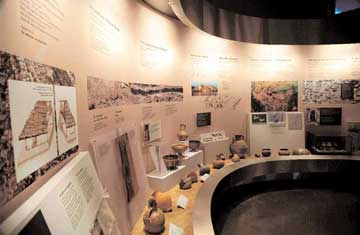 Άποψη της εκθεσιακής ενότητας "Προς τη γένεση των πόλεων στη Μακεδονία".
Το πρώτο μέρος της συνολικής επανέκθεσης του Αρχαιολογικού Μουσείου Θεσσαλονίκης εγκαινιάστηκε, μαζί με το σημαντικότερο μέρος της ανακατασκευής του, λίγες μέρες πριν από την έναρξη των Ολυμπιακών Αγώνων του 2004. Ο τίτλος της επανέκθεσης είναι «Ο χρυσός των Μακεδόνων» και η επανεκθετική μέθοδος ακολουθεί τις θεματικές ενότητες: η διάδοση, η χρήση, η εξόρυξη του χρυσού, ο χρυσός και η αρχαιολογία του θανάτου, ο πάπυρος του Δερβενίου. Τα άλλα τέσσερα εκθεσιακά τμήματα, η προετοιμασία των οποίων είχε αρχίσει ήδη από τα τέλη του 2001, εγκαινιάστηκαν στις αρχές Σεπτεμβρίου του 2006: η προϊστορία στη Μακεδονία, Προς τη γένεση των πόλεων, η Μακεδονία, η Θεσσαλονίκη. Για τα τέσσερα αυτά τμήματα ακολουθήθηκε η ίδια μεθοδολογία, με έμφαση στο τμήμα για την προϊστορία, στις καθημερινές πρακτικές. Οι βασικοί θεματικοί κύκλοι είναι ο χώρος/περιβάλλον, ο χρόνος, η οικονομία, η κοινωνία, η πνευματική/θρησκευτική/καλλιτεχνική ζωή, η τεχνολογία. Είναι κύκλοι που μπορεί να ταξινομήθηκαν βέβαια ήδη από τη δεκαετία του ’60 από τον θετικιστή/μοντέρνο και έναν από τους βασικούς εισηγητές της Νέας Αρχαιολογίας D. Clark, είναι ωστόσο διαχρονικοί και τίποτα δεν θα απέκλειε τη μεταμοντέρνα τους χρήση, κάτι που επιδιώκεται στην έκθεση, αφού προκαλεί πολυδιάστατη και κριτική τοποθέτηση του επισκέπτη, προσφέροντας και ερμηνευτικές διαστάσεις. Η διαφοροποίηση σε σχέση με το παρελθόν είναι σαφής: η σημερινή τάση είναι επικοινωνιακή με την ευρύτερη φιλοσοφική και κοινωνιολογική έννοια του όρου. Εννοείται ότι την έκθεση πλαισιώνει μεγάλη ποικιλία πολυμεσικών και άλλων ηλεκτρονικών εφαρμογών, ενταγμένων και συνδεδεμένων με τις θεματικές ενότητες.
Άποψη της εκθεσιακής ενότητας "Προς τη γένεση των πόλεων στη Μακεδονία".
Το πρώτο μέρος της συνολικής επανέκθεσης του Αρχαιολογικού Μουσείου Θεσσαλονίκης εγκαινιάστηκε, μαζί με το σημαντικότερο μέρος της ανακατασκευής του, λίγες μέρες πριν από την έναρξη των Ολυμπιακών Αγώνων του 2004. Ο τίτλος της επανέκθεσης είναι «Ο χρυσός των Μακεδόνων» και η επανεκθετική μέθοδος ακολουθεί τις θεματικές ενότητες: η διάδοση, η χρήση, η εξόρυξη του χρυσού, ο χρυσός και η αρχαιολογία του θανάτου, ο πάπυρος του Δερβενίου. Τα άλλα τέσσερα εκθεσιακά τμήματα, η προετοιμασία των οποίων είχε αρχίσει ήδη από τα τέλη του 2001, εγκαινιάστηκαν στις αρχές Σεπτεμβρίου του 2006: η προϊστορία στη Μακεδονία, Προς τη γένεση των πόλεων, η Μακεδονία, η Θεσσαλονίκη. Για τα τέσσερα αυτά τμήματα ακολουθήθηκε η ίδια μεθοδολογία, με έμφαση στο τμήμα για την προϊστορία, στις καθημερινές πρακτικές. Οι βασικοί θεματικοί κύκλοι είναι ο χώρος/περιβάλλον, ο χρόνος, η οικονομία, η κοινωνία, η πνευματική/θρησκευτική/καλλιτεχνική ζωή, η τεχνολογία. Είναι κύκλοι που μπορεί να ταξινομήθηκαν βέβαια ήδη από τη δεκαετία του ’60 από τον θετικιστή/μοντέρνο και έναν από τους βασικούς εισηγητές της Νέας Αρχαιολογίας D. Clark, είναι ωστόσο διαχρονικοί και τίποτα δεν θα απέκλειε τη μεταμοντέρνα τους χρήση, κάτι που επιδιώκεται στην έκθεση, αφού προκαλεί πολυδιάστατη και κριτική τοποθέτηση του επισκέπτη, προσφέροντας και ερμηνευτικές διαστάσεις. Η διαφοροποίηση σε σχέση με το παρελθόν είναι σαφής: η σημερινή τάση είναι επικοινωνιακή με την ευρύτερη φιλοσοφική και κοινωνιολογική έννοια του όρου. Εννοείται ότι την έκθεση πλαισιώνει μεγάλη ποικιλία πολυμεσικών και άλλων ηλεκτρονικών εφαρμογών, ενταγμένων και συνδεδεμένων με τις θεματικές ενότητες.
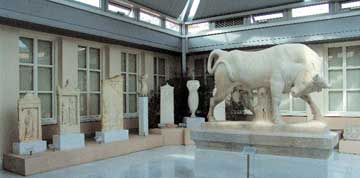 Ο ταύρος από τον ταφικό περίβολο του Διονυσίου Κολυττέως, 345-340 π.Χ.
Την άνοιξη του 1861 εντοπίστηκαν για πρώτη φορά αρχαία στον άγνωστο ως τότε χώρο του αρχαίου νεκροταφείου. Το 1938, το Γερμανικό Αρχαιολογικό Ινστιτούτο παρέδωσε στο ελληνικό Δημόσιο το κτίριο του Μουσείου του Κεραμεικού. Η ένταξη της συνολικής ανάδειξης του Κεραμεικού στο πρόγραμμα Ενοποίησης Αρχαιολογικών Χώρων της Αθήνας έδωσε την ευκαιρία στη Γ´ Εφορεία Προϊστορικών και Κλασικών Αρχαιοτήτων να πραγματοποιήσει την επισκευή και ανακαίνιση των χώρων του παλαιού κτιρίου του Μουσείου και να σχεδιάσει τη νέα μόνιμη έκθεσή του. Η έκθεση, που παρουσιάζεται στο τεύχος αυτό, εγκαινιάστηκε στις 9 Αυγούστου του 2004 και αναπτύσσεται σε πέντε εκθεσιακούς χώρους, αφιερωμένους στη γλυπτική και την κεραμική.
Ο ταύρος από τον ταφικό περίβολο του Διονυσίου Κολυττέως, 345-340 π.Χ.
Την άνοιξη του 1861 εντοπίστηκαν για πρώτη φορά αρχαία στον άγνωστο ως τότε χώρο του αρχαίου νεκροταφείου. Το 1938, το Γερμανικό Αρχαιολογικό Ινστιτούτο παρέδωσε στο ελληνικό Δημόσιο το κτίριο του Μουσείου του Κεραμεικού. Η ένταξη της συνολικής ανάδειξης του Κεραμεικού στο πρόγραμμα Ενοποίησης Αρχαιολογικών Χώρων της Αθήνας έδωσε την ευκαιρία στη Γ´ Εφορεία Προϊστορικών και Κλασικών Αρχαιοτήτων να πραγματοποιήσει την επισκευή και ανακαίνιση των χώρων του παλαιού κτιρίου του Μουσείου και να σχεδιάσει τη νέα μόνιμη έκθεσή του. Η έκθεση, που παρουσιάζεται στο τεύχος αυτό, εγκαινιάστηκε στις 9 Αυγούστου του 2004 και αναπτύσσεται σε πέντε εκθεσιακούς χώρους, αφιερωμένους στη γλυπτική και την κεραμική.
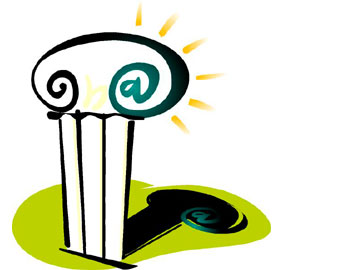 Το λογότυπο της στήλης
Στο δεύτερο μέρος της επιλογής και παρουσίασης δικτυακών τόπων από τη στήλη της Πληροφορικής, οι οποίοι σχετίζονται με την αρχαιογνωσία, περιλαμβάνονται περιγραφές α) του κεντρικού καταλόγου των βιβλιοθηκών του Γερμανικού Αρχαιολογικού Ινστιτούτου ZenOn, που περιέχει τους καταλόγους βιβλιοθηκών των εννέα παραρτημάτων του β) του δικτυακού τόπου της αρχαίας Μεσσήνης και γ) νέων εξελίξεων στο Google Earth, που αφορούν τη χρήση του σε συστήματα γεωγραφικής πληροφορίας για την αρχαιολογική έρευνα.
Το λογότυπο της στήλης
Στο δεύτερο μέρος της επιλογής και παρουσίασης δικτυακών τόπων από τη στήλη της Πληροφορικής, οι οποίοι σχετίζονται με την αρχαιογνωσία, περιλαμβάνονται περιγραφές α) του κεντρικού καταλόγου των βιβλιοθηκών του Γερμανικού Αρχαιολογικού Ινστιτούτου ZenOn, που περιέχει τους καταλόγους βιβλιοθηκών των εννέα παραρτημάτων του β) του δικτυακού τόπου της αρχαίας Μεσσήνης και γ) νέων εξελίξεων στο Google Earth, που αφορούν τη χρήση του σε συστήματα γεωγραφικής πληροφορίας για την αρχαιολογική έρευνα.
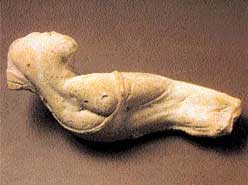 Ένα θαυμάσιο δείγμα πηλοπλαστικής υψηλής ελληνικής τέχνης από τη Σελεύκεια στον Τίγρη.
Παρουσίαση του πρώτου στην Ελλάδα Διεθνούς Συνεδρίου με θέμα τον ελληνιστικό πολιτισμό στην Ασία. Στο πλαίσιο του συνεδρίου κορυφαίοι, διεθνούς φήμης ξένοι αρχαιολόγοι παρουσίασαν στο ευρύ κοινό τα σημαντικά ευρήματα των ξένων ανασκαφών στην Ανατολή, από τη Συρία ως το Αφγανιστάν και το Ουζμπεκιστάν, αποδεικνύοντας τη διάδοση του ελληνικού πολιτισμού στην Ανατολή, την οικουμενικότητα της ελληνικής γλώσσας που προέκυψε και την επιρροή στους πολιτισμούς και τις τέχνες της περιοχής.
Ένα θαυμάσιο δείγμα πηλοπλαστικής υψηλής ελληνικής τέχνης από τη Σελεύκεια στον Τίγρη.
Παρουσίαση του πρώτου στην Ελλάδα Διεθνούς Συνεδρίου με θέμα τον ελληνιστικό πολιτισμό στην Ασία. Στο πλαίσιο του συνεδρίου κορυφαίοι, διεθνούς φήμης ξένοι αρχαιολόγοι παρουσίασαν στο ευρύ κοινό τα σημαντικά ευρήματα των ξένων ανασκαφών στην Ανατολή, από τη Συρία ως το Αφγανιστάν και το Ουζμπεκιστάν, αποδεικνύοντας τη διάδοση του ελληνικού πολιτισμού στην Ανατολή, την οικουμενικότητα της ελληνικής γλώσσας που προέκυψε και την επιρροή στους πολιτισμούς και τις τέχνες της περιοχής.
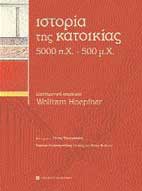 Το εξώφυλλο του βιβλίου
Παρουσίαση της ελληνικής έκδοσης του βιβλίου Ιστορία της κατοικίας, 5000 π.Χ.-500 μ.Χ., το οποίο έρχεται να συμπληρώσει ένα κενό στις γνώσεις και τους προβληματισμούς του κάθε ενδιαφερόμενου αναγνώστη και όχι απαραίτητα ειδικού.
Το εξώφυλλο του βιβλίου
Παρουσίαση της ελληνικής έκδοσης του βιβλίου Ιστορία της κατοικίας, 5000 π.Χ.-500 μ.Χ., το οποίο έρχεται να συμπληρώσει ένα κενό στις γνώσεις και τους προβληματισμούς του κάθε ενδιαφερόμενου αναγνώστη και όχι απαραίτητα ειδικού.
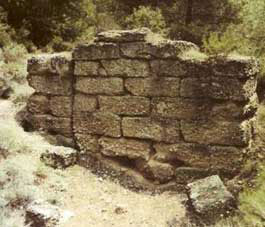 Ο τύμβος του Σοφοκλή στη Βαρυμπόμπη.
Ειδήσεις: Ο Μηχανισμός των Αντικυθήρων, Ο θησαυρός της Κέρου, Ομηρικές σκηνές, Χάνονται μνημεία, Ρωμαϊκή Αγορά Θεσσαλονίκης, Ο τύμβος του Σοφοκλή, SOS για τις Δημοτικές Βιβλιοθήκες, Επιγραφικό Εργαστήριο κ.ά.
Εκθέσεις: Η ελληνική χλωρίδα στην αρχαιότητα, Πηλός και χρώμα, Μύθοι και Αρχέτυπα στη Μεσόγειο κ.ά.
Συνέδρια: 4ο Διεθνές Συμπόσιο Θρακικών Σπουδών, Ζ´ Συνάντηση Βυζαντινολόγων, Ελληνικός πολιτισμός χωρίς σύνορα, Περιβαλλοντική Αρχαιολογία κ.ά.
Διαλέξεις: Κλαζομενές, Ηφαίστειο Θήρας, Αιγυπτιακές αρχαιότητες, Μαργιανή και Βακτριανή κ.ά.
Βιβλία: Ανδρέας Αποστολίδης, Αρχαιοκαπηλία και εμπόριο αρχαιοτήτων- Ευαγγελία Τσαγκαράκη, Σφραγίσματα με παραστάσεις ανθρώπινων μορφών - Αμαλία Μεγαπάνου, Πρόσωπα και άλλα κύρια ονόματα - Σαράντος Ι. Καργάκος, Ιστορία της Αρχαίας Σπάρτης κ.ά.
Επιστολές: Τρ. Δ. Παπαζώης, Μυθοπλασίες και αμφιλεγόμενες μαρτυρίες επισκιάζουν την αλήθεια για την τύχη των λειψάνων του Μ. Αλεξάνδρου - Μαρία Σταυροπούλου, Μια νύξη για τα φυσικά φάρμακα κ.ά.
Ο τύμβος του Σοφοκλή στη Βαρυμπόμπη.
Ειδήσεις: Ο Μηχανισμός των Αντικυθήρων, Ο θησαυρός της Κέρου, Ομηρικές σκηνές, Χάνονται μνημεία, Ρωμαϊκή Αγορά Θεσσαλονίκης, Ο τύμβος του Σοφοκλή, SOS για τις Δημοτικές Βιβλιοθήκες, Επιγραφικό Εργαστήριο κ.ά.
Εκθέσεις: Η ελληνική χλωρίδα στην αρχαιότητα, Πηλός και χρώμα, Μύθοι και Αρχέτυπα στη Μεσόγειο κ.ά.
Συνέδρια: 4ο Διεθνές Συμπόσιο Θρακικών Σπουδών, Ζ´ Συνάντηση Βυζαντινολόγων, Ελληνικός πολιτισμός χωρίς σύνορα, Περιβαλλοντική Αρχαιολογία κ.ά.
Διαλέξεις: Κλαζομενές, Ηφαίστειο Θήρας, Αιγυπτιακές αρχαιότητες, Μαργιανή και Βακτριανή κ.ά.
Βιβλία: Ανδρέας Αποστολίδης, Αρχαιοκαπηλία και εμπόριο αρχαιοτήτων- Ευαγγελία Τσαγκαράκη, Σφραγίσματα με παραστάσεις ανθρώπινων μορφών - Αμαλία Μεγαπάνου, Πρόσωπα και άλλα κύρια ονόματα - Σαράντος Ι. Καργάκος, Ιστορία της Αρχαίας Σπάρτης κ.ά.
Επιστολές: Τρ. Δ. Παπαζώης, Μυθοπλασίες και αμφιλεγόμενες μαρτυρίες επισκιάζουν την αλήθεια για την τύχη των λειψάνων του Μ. Αλεξάνδρου - Μαρία Σταυροπούλου, Μια νύξη για τα φυσικά φάρμακα κ.ά.
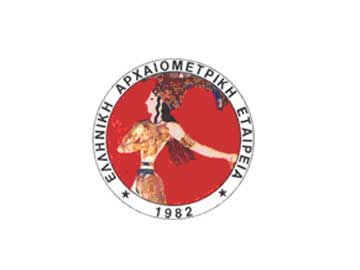 Το λογότυπο της Ελληνικής Αρχαιομετρικής Εταιρείας
Στα Αρχαιομετρικά Νέα μπορείτε να διαβάσετε:
- Συνέδριο Αρχαιομετρίας στη Χαϊδελβέργη
- Νέος επιστήμων Αρχαιομεταλλουργίας
- Τα Σεμινάρια των Εργαστηρίων Fitch και Wiener
- Προκηρύξεις για χρηματοδότηση ερευνητικών έργων
Το λογότυπο της Ελληνικής Αρχαιομετρικής Εταιρείας
Στα Αρχαιομετρικά Νέα μπορείτε να διαβάσετε:
- Συνέδριο Αρχαιομετρίας στη Χαϊδελβέργη
- Νέος επιστήμων Αρχαιομεταλλουργίας
- Τα Σεμινάρια των Εργαστηρίων Fitch και Wiener
- Προκηρύξεις για χρηματοδότηση ερευνητικών έργων
The history of medicine, seen as a “great tradition” expressing prevailing knowledge, tends to silence the voice of “small traditions” and diminish common medical practices by regarding them as primitive. From these studies of anonymous healing traditions, sprung the branch of medical anthropology in the 1970s. A. Kleinman, a psychiatrist and anthropologist, defined three interconnected spheres of medical systems: a) Popular medicine with its remedies, b) the traditional medicine of indigenous peoples, practised by shamans or gifted healers, c) bio medicine produced in the West. The anthropological approach accepts that all societies provide medicine linked to practical observation and with symbolic interpretations. The attention of critical medical anthropology is centred on the creation, over the centuries, of a dominant medicine, which, by monopolising knowledge, marginalises all other alternative practices. “Definitive Knowledge” is a central concept, referring to the knowledge of the specialist, the power of the medical perspective, in “Clinical Archaeology” (Foucault) and the introduction into everyday life of medically based knowledge. The study of medical history does not only focus on technological progress and scientific discoveries, on clinics and patients. It mainly looks at medicine in a socio-political context where links can be located between the past and the present. It is therefore possible to analyse the wielding of power within institutions created by the organisation and implementation of medicine. The articles featured in Archaeologia is determined by such logic.
The care for health is as old as mankind. In early, remote times, cure, healing and restoration of health haven always been achieved through the invocation of divine power and were pursued through ritual practices of magic that were imitating the revival of the powers of earth, the life-giving power par excellence in the ruralpastoral societies. In the empirical level the cure of the patient was also supported either by natural medicines or by operations. However, medicine, that is diagnosis and healing, became a science in Greece by Hippocrates, a fifth-century physician from the island of Kos, who was the first to introduce the scientific observation and its analysis and the thus grounded and documented diagnosis and therapy. At the same time, even in the classical age, the religious/divine healing was widely spread and prevailing, its major center being the sanctuary of Asclepius in Epidaurus as well as its approximately two hundred annexed institutions all over Mediterranean, in which dreams and autosuggestion were considered crucial for health restoration. Through the religious practices and the recording and study of various diseases or illnesses a valuable experience was gained, which contributed to the prevalence of scientific medicine. Towards the end of the ancient world all the facets of the traditional scientific medicine had already been formed, ranging from medical specialties, medicines and surgical instruments to the social status of physicians.
In all the collected writings of the Hippocratic Corpus can be virtually found references on the issue of ethics and deontology at both philosophical and practical level. However, three of them, The Oath, The Physician and Decorum, give to physicians specific instructions about the teaching of medicine, respect for life, protection of patients and preservation of medical integrity. Euthanasia (mercy killing) and abortion are categorically prohibited, whereas the observance of medical confidentiality is demanded. Rules are set regarding the appropriate appearance and behavior of physicians, the cultivation of character and the development of high ethics. The qualities and attributes of the Hippocratic physician include professional efficiency, continuous study and research and even practice in foreign lands, as well as deep concern for the creation of quality conditions in curing patients. Emphasis is given to the philosophical education of the physician, the importance of which is phrased in the maxim “the physicianphilosopher is equal to god”. The enduring, diachronic value of the Hippocratic code can be better appreciated through its impact on the contemporary medical practice.
The authors of the Hippocratic Corpus did not avoid discussing diseases that are nowadays considered to be infectious. Yet, the notion of disease transmission from the unhealthy to the healthy laid beyond their perception. Galen refutes the possibility of transmission, as opposed to Diodorus, who underlines the contagious character of the 396 B.C. pestilence, and Titus Livius, a supporter of the notion of contagion, who provides us with an interesting testimony of the 212 B.C. plague. However, it is very interesting that a historian, Thucydides, is the first to mention the transmission of a disease from one person or country to another. In a way, his narration reflects his contemporary popular views on the matter. In the Latin, non-medical literature it is not difficult to be located references to the idea of contagion. In veterinary works in particular the idea of contagion, as a way of disease transmission, is quite apparent. Aretaeus must be the first physician to ever adopt a positive stance on contagion. All the above observations lead to the conclusion that historians, philosophers and zoologists do not refute the possibility of disease transmission through contagion, whereas physicians reject the idea, as it jeopardized their “rationalistic” theories about the cause of diseases.
The knowledge of the therapeutic potentials of medicinal plants as well as animal and mineral derivatives can be traced in the remote past of ancient Greek civilization. This primarily empirical knowledge prevails in the folk or traditional medicine until the time of Hippocrates, when it obtains theoretical grounds and thus reshaped it is incorporated in “scientific medicine”. In the works of Dioscorides and Galen the knowledge of ancient drugs and therapeutic substances is systematized and thereafter widely spread. According to the scientific views prevailing in their time, medicines act curatively due to the variety of their “powers” that restores the “equilibrium” of the humors and qualities of the body. The therapy with medicines was combined with diaita, the regulation of the way of living, which, at least in the Hippocratic medicine, constituted the major means of both disease prevention and healing. These therapeutic views and approaches have greatly influenced Western medicine, even that of modern times.
The treatise “On Hygiene” supplies a wealth of information about the major change in the field of athletics, which took place in the Roman imperial period, and the prevalence of athletic exercise. It notes the lack of proportionate and controlled exercise and its dangerous effects on athletes. It also pinpoints the impotence in diagnosing the physical and psychological condition of the athlete and consequently the inability in selecting for and adapting to him the proper exercises. The intellectuals of the age express the demand for redefining physical exercise, that should be connected with medicine and hygiene, and propose the application of the “art of hygiene” in gymnastics. Thus, it is strongly suggested that only the natural well-being that can be achieved through gymnastic exercises shields and reinforces health. Therefore, the participation of a professional instructor of gymnastics in exercises is indispensable: he must have sufficient knowledge of medicine and hygiene, so that he can be capable to evaluate the conventionality of bodies and exercises and to decide whether specific exercises can harm or benefit the particular individual.
Aretaeus from Cappadocia (2nd cent. A.D.) is considered one of the most prominent Greek physicians of the Roman period. In two of his eight extant books entitled On the causes and symptoms of acute diseases and On the cure of acute diseases, he refers to various diseases, such as neuritis, tuberculosis epilepsy, as well as to ileus. Aretaeus considers ileus as an intestinal inflammation, which is usually accompanied by colic pain. There are two causes, according to him, responsible for the development of ileus: the first has to do with the amount and quality of the intake of food and the second with an injury of the bowels. Aretaeus comments that ileus is a disease that can affect both the large and the small intestines. Furthermore, he refers to various types of ileus, depending on the severity of each case, and describes in detail the relevant symptoms and their clinical manifestation. He also admits that the intraabdominal abscess is a complication of ileus. As far as cure is concerned, Aretaeus suggests that pain should be treated first by anesthetics and then through various practices, such as vomiting, steam-baths, poultices, cupping, decoctions and diet, that aim at the removal of the trapped air from the intestines.
The objective of this article is to present in brief the wealth of methods and instruments that were invented by the ancient Greek physicians who practiced obstetrics from the Mycaenean age to the third century ad. Therefore we have concisely recorded the basic knowledge of Obstetrics regarding pregnancy, childbirth, puerperium and the relevant complications that might occur as well as the medical interventions proposed by the ancient Greek physicians for their treatment. Concurrently, we present the knowledge of Gynaecology in the aforementioned span of time and particularly that of the anatomy and physiology of the female genital system, the relevant gynaecological diseases and their cure. Thus, emerges and becomes obvious the enormous contribution of the ancient Greek physicians whose pioneering inventions laid the foundations for the development of Obstetrics- Gynaecology in the rest of the world, a field of medicine extremely important to women.
In the Graeco-Roman world vision was studied empirically, on the basis of natural observation and philosophical – mostly Peripatetic – consideration; according to the latter, the human eye (even though its structure was becoming increasingly known to anatomists and physiologists) performed a purely teleological function. In Euclidean optics, the “eye”, according to which the laws of reflection and refraction were observed, is an abstract and theoretically perfect tool, not an optical instrument in itself. Accordingly, the laws of vision composed by Euclid and his successors had a minor impact on ophthalmology. Eye ailments such as various inflammations and longand short-sightedness received symptomatic treatments rooted in old traditions and practical knowledge. Hippocratic physiologists, such as Galen and Celsus, based their doctrines on Aristotle and his various writings, including the eclectic Problemata. At the same time, art, infused with science and popular wisdom, stands as an eloquent expression of the way the Graeco- Roman world understood the Gaze.
The article deals with the predominant representations of disease and its cause and treatment in the ancient tragic and comic drama in relation, on the one hand, to the magic-religious approach of Asclepius’ priesthood; and on the other, to the rational-scientific perception of Hippocrates’ followers, which was remarkably developed and disseminated during the fifth century B.C. It also traces the differently recorded representation of disease and treatment in the ancient tragedy and comedy and follows the escalation of medical syncretism and therapeutic optimism evident in dramatic literature: being literary introduced by Aeschylus’ Prometheus Bound and Sophocles’ Antigone, they are established by Euripides’ Alcestis and Sophocles’ Philoctetes, to be finally differentiated and prevalent in the plays of Aristophanes Wasps and Wealth, respectively. In the latter play, the last extant ancient comedy, the ambivalence of the classical thought has been remarkably portrayed.
The first part of the complete re-exhibition of the Archeological Museum of Thessaloniki was inaugurated a few days before the opening of the Olympic Games of 2004 along with the more important section of its renovated building. The method followed for the presentation of this re-exhibition, entitled “The Gold of Macedons” was that of the thematic entities: Mining, Use and Dissemination of Gold, Gold and the Archaeology of Death, the Derveni Papyrus. Four more exhibition entities, The Prehistory of Macedonia, Towards the Creation of Cities, Macedonia, and Thessaloniki, the preparation of which had already started since the end of 2001, were inaugurated in the early September of 2006. The above methodology was again followed, whereas for the exhibition of the prehistoric section emphasis was given to the everyday, customary practices of the period. The basic thematic nuclei around which the latter exhibition revolves are: space/environment, time, economy, society, spiritual/religious/artistic life and technology. Although these notional units have been already classified since the 1960’s by the positivist and modernist D. Clark, one of the pioneers of New Archaeology, they nevertheless remain diachronic; therefore, since no one could deny their post-modern use, we have included them in the planning of the exhibition, because, by offering a variety of interpretations, the exhibition can evoke the visitor’s judgment on its subject and issues. The differentiation from the past is clear: the present objective is communication in the broader philosophical and social sense of the term. Needless to say that the exhibition is framed by a broad variety of multimedia and other electronic applications incorporated in and related to its thematic entities.
Within the organization of the Olympic Games of 2004, Athens has designed a large spectrum of projects concerning the modernization of its urban structure as well as the unification of its archaeological sites and historic locations. Apart from the renovation of its traditional waterfront and the construction of an entire subway system, motorway rings and a new international airport, the Greek capital has reconstructed parts of another historic monument: its ancient Olive Grove. The main objective of this project was to create a contemporary Greek contribution in the field of the international landscape architecture, by rescuing and restoring the neglected ancient green heritage of the glorious city. The two projects, the “Restructuring of Petrou Ralli Street” and the “Designing of the Olive Grove”, part of the Olympic Program for the Upgrading of Athens-Attica of 2004, deal with the expropriation, restructuring, replanting and design of the entire area where once thrived the ancient olive grove. It is worth noting that some of the old sacred olive trees, which might have been planted during the “golden age” of Pericles (480- 450 B.C.), are still preserved in the grounds. Both projects have been planned by the author of this article in cooperation with the Athens Masterplan Organization (ORSA) and realized by the Public Corporation of Urban Planning and Housing SA (DEPOS AE), which are the most important institutions of the Greek urban development. In the framework of the entire Olympic program these are the only projects that have been thoroughly planned by a landscape architect, therefore they include urban planning, master plan design and realization concept.
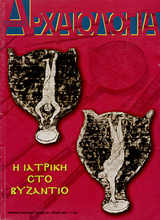
 Οι άγιοι Πέντε θεραπεύουν μια γυναίκα που ήταν άφωνη και ακίνητη. 12ος αι., Μονή Αγ. Αικατερίνης Σινά.
Στη βυζαντινή εποχή, χαρακτηριστικό της επίσημης ιατρικής είναι η δημιουργία συμπιλημάτων-εγκυκλοπαιδειών, οι οποίες κατέγραφαν την υπάρχουσα ιατρική γνώση και την ίδρυση εγκαταστάσεων ιατρικής περίθαλψης. Παράλληλα, τα θαύματα αφθονούσαν: θεραπευτές άγιοι απαθανατίζονται στη βυζαντινή εικονογραφία και πραγματοποιούνται προσκυνήματα στους θεραπευτικούς ιερούς χώρους τους, οι Κοσμάς και Δαμιανός (οι άγιοι Ανάργυροι) έγιναν γνωστοί ως οι άγιοι των ιατρών και τοπικές θεραπευτικές λατρείες που οργανώνονταν γύρω από τα πρόσωπα λιγότερο γνωστών θεραπευτών ήταν σε άνθηση. Οι θεραπείες των παθήσεων αναζητούνταν επίσης σε προ-χριστιανικές θεραπευτικές παραδόσεις, όπως στην εγκοίμηση του Ασκληπιού, ακόμη και στη μαγεία.
Οι άγιοι Πέντε θεραπεύουν μια γυναίκα που ήταν άφωνη και ακίνητη. 12ος αι., Μονή Αγ. Αικατερίνης Σινά.
Στη βυζαντινή εποχή, χαρακτηριστικό της επίσημης ιατρικής είναι η δημιουργία συμπιλημάτων-εγκυκλοπαιδειών, οι οποίες κατέγραφαν την υπάρχουσα ιατρική γνώση και την ίδρυση εγκαταστάσεων ιατρικής περίθαλψης. Παράλληλα, τα θαύματα αφθονούσαν: θεραπευτές άγιοι απαθανατίζονται στη βυζαντινή εικονογραφία και πραγματοποιούνται προσκυνήματα στους θεραπευτικούς ιερούς χώρους τους, οι Κοσμάς και Δαμιανός (οι άγιοι Ανάργυροι) έγιναν γνωστοί ως οι άγιοι των ιατρών και τοπικές θεραπευτικές λατρείες που οργανώνονταν γύρω από τα πρόσωπα λιγότερο γνωστών θεραπευτών ήταν σε άνθηση. Οι θεραπείες των παθήσεων αναζητούνταν επίσης σε προ-χριστιανικές θεραπευτικές παραδόσεις, όπως στην εγκοίμηση του Ασκληπιού, ακόμη και στη μαγεία.
 Οι άγιοι Ανάργυροι δέχονται από τον Θεό τη χάρη να θεραπεύουν. 11ος αι., Μονή Διονυσίου, Άγιον Όρος.
Σε όλες τις πόλεις του βυζαντινού κράτους υπήρχαν νοσοκομεία που φρόντιζαν για την ανακούφιση και τη θεραπεία των ασθενών. Στα νοσοκομεία του Bυζαντίου, άνδρες, γυναίκες και παιδιά, χριστιανοί υπήκοοι της αυτοκρατορίας ή ξένοι, μπορούσαν να νοσηλευτούν δωρεάν ή έναντι κάποιας αμοιβής, ανάλογα με τη σοβαρότητα της ασθένειας, τη διάρκεια της παραμονής τους, την παροχή των υπηρεσιών και τον κανονισμό του ιδρύματος. Tα πιο αξιόλογα βυζαντινά νοσοκομεία βρίσκονταν στα μεγάλα οικονομικά, πολιτικά και εκκλησιαστικά κέντρα της αυτοκρατορίας. Nοσοκομεία όμως υπήρχαν και σε μοναστήρια, που βρίσκονταν σε απομακρυσμένα σημεία της υπαίθρου. Σε αυτά τα υποτυπώδη, με βάση πάντα τα δικά μας, σημερινά κριτήρια, νοσοκομεία, ασκήθηκε η επίσημη ιατρική και αντιμετωπίστηκαν οι διάφορες ασθένειες. Oι τρόφιμοι των βυζαντινών νοσοκομείων, μετά την ίασή τους, επέστρεφαν στις οικογένειές τους και στις εργασίες τους.
Οι άγιοι Ανάργυροι δέχονται από τον Θεό τη χάρη να θεραπεύουν. 11ος αι., Μονή Διονυσίου, Άγιον Όρος.
Σε όλες τις πόλεις του βυζαντινού κράτους υπήρχαν νοσοκομεία που φρόντιζαν για την ανακούφιση και τη θεραπεία των ασθενών. Στα νοσοκομεία του Bυζαντίου, άνδρες, γυναίκες και παιδιά, χριστιανοί υπήκοοι της αυτοκρατορίας ή ξένοι, μπορούσαν να νοσηλευτούν δωρεάν ή έναντι κάποιας αμοιβής, ανάλογα με τη σοβαρότητα της ασθένειας, τη διάρκεια της παραμονής τους, την παροχή των υπηρεσιών και τον κανονισμό του ιδρύματος. Tα πιο αξιόλογα βυζαντινά νοσοκομεία βρίσκονταν στα μεγάλα οικονομικά, πολιτικά και εκκλησιαστικά κέντρα της αυτοκρατορίας. Nοσοκομεία όμως υπήρχαν και σε μοναστήρια, που βρίσκονταν σε απομακρυσμένα σημεία της υπαίθρου. Σε αυτά τα υποτυπώδη, με βάση πάντα τα δικά μας, σημερινά κριτήρια, νοσοκομεία, ασκήθηκε η επίσημη ιατρική και αντιμετωπίστηκαν οι διάφορες ασθένειες. Oι τρόφιμοι των βυζαντινών νοσοκομείων, μετά την ίασή τους, επέστρεφαν στις οικογένειές τους και στις εργασίες τους.
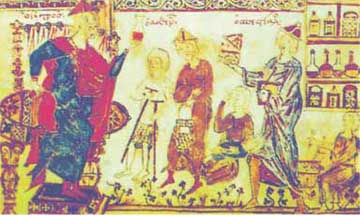 Ο αρχίατρος, ο "σπετσιάλος" και αθενείς που πάσχουν από ποικίλα νοσήματα. Χειρόγραφο 15ου αι.
Η διδασκαλία των Πατέρων της Εκκλησίας κατά τους πρώιμους αιώνες της αυτοκρατορίας προσέδωσαν νέο, χριστιανικό νόημα στην ελληνιστική και ρωμαϊκή παράδοση της φιλανθρωπίας. Χώροι, που λειτουργούσαν υπό την επίβλεψη των μονών και της Εκκλησίας, τα φιλανθρωπικά ιδρύματα ανταποκρίνονταν στις ανάγκες του πάσχοντος πληθυσμού, των απόρων και των ανιάτων.
Από αποσπασματικές μαρτυρίες που χρονολογούνται στα τέλη του 4ου αιώνα συμπεραίνεται ότι τουλάχιστον στην Κωσταντινούπολη μονάδες νοσηλείας λειτουργούσαν με εξειδικευμένο ιατρικό προσωπικό. Η συνεργασία του Πατριαρχείου Κωνσταντινουπόλεως με την αυτοκρατορική αυλή εντοπίζεται ειδικότερα στα μεγάλα νοσηλευτικά ιδρύματα του 6ου και του 7ου αιώνα, τα οποία παρείχαν εξειδικευμένες υπηρεσίες.
Παρά τις ενστάσεις των αγιολογικών κειμένων σχετικά με την αποτελεσματικότητα της ιατρικής και την διαρκή αριστοκρατική καχυποψία ως προς τους χώρους μαζικής νοσηλείας και θεραπείας, η ίδρυση του Ξενώνα του Παντοκράτορος τον 12ο αιώνα πιστοποιεί τα υψηλά κριτήρια για τον σχεδιασμό και τη λειτουργικότητα των θεραπευτικών μονάδων, και την κοινωνική αναβάθμιση του ιατρικού επαγγέλματος.
Ο αρχίατρος, ο "σπετσιάλος" και αθενείς που πάσχουν από ποικίλα νοσήματα. Χειρόγραφο 15ου αι.
Η διδασκαλία των Πατέρων της Εκκλησίας κατά τους πρώιμους αιώνες της αυτοκρατορίας προσέδωσαν νέο, χριστιανικό νόημα στην ελληνιστική και ρωμαϊκή παράδοση της φιλανθρωπίας. Χώροι, που λειτουργούσαν υπό την επίβλεψη των μονών και της Εκκλησίας, τα φιλανθρωπικά ιδρύματα ανταποκρίνονταν στις ανάγκες του πάσχοντος πληθυσμού, των απόρων και των ανιάτων.
Από αποσπασματικές μαρτυρίες που χρονολογούνται στα τέλη του 4ου αιώνα συμπεραίνεται ότι τουλάχιστον στην Κωσταντινούπολη μονάδες νοσηλείας λειτουργούσαν με εξειδικευμένο ιατρικό προσωπικό. Η συνεργασία του Πατριαρχείου Κωνσταντινουπόλεως με την αυτοκρατορική αυλή εντοπίζεται ειδικότερα στα μεγάλα νοσηλευτικά ιδρύματα του 6ου και του 7ου αιώνα, τα οποία παρείχαν εξειδικευμένες υπηρεσίες.
Παρά τις ενστάσεις των αγιολογικών κειμένων σχετικά με την αποτελεσματικότητα της ιατρικής και την διαρκή αριστοκρατική καχυποψία ως προς τους χώρους μαζικής νοσηλείας και θεραπείας, η ίδρυση του Ξενώνα του Παντοκράτορος τον 12ο αιώνα πιστοποιεί τα υψηλά κριτήρια για τον σχεδιασμό και τη λειτουργικότητα των θεραπευτικών μονάδων, και την κοινωνική αναβάθμιση του ιατρικού επαγγέλματος.
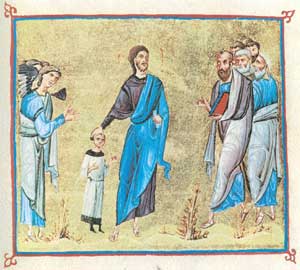 Ο Ιησούς ευλογεί ένα παιδί. Εικονογραφημένο χειρόγραφο, 11ος αι., Μονή Διονυσίου, Άγιον Όρος.
Οι αντιλήψεις για το παιδί και τη μέριμνά του στη Βυζαντινή κοινωνία είναι εκείνες που υπαγορεύουν τη στάση της ιατρικής στην αντιμετώπιση της υγείας του. Με εξαίρεση τα θέματα Αναπτυξιακής Παιδιατρικής, όπως η περιγεννητική φροντίδα των νεογνών, ο μητρικός θηλασμός, η υγιεινοδιαιτητική αγωγή, που αποτελούν αυτόνομη ενότητα στο σύνολο της Βυζαντινής Ιατρικής Γραμματείας, το νοσολογικό φάσμα της παιδικής ηλικίας είναι διασκορπισμένο στα αντίστοιχα κεφάλαια που αφορούν το γενικό πληθυσμό. Οι ιστορικές, φιλολογικές και αγιολογικές πηγές στηρίζουν με τις μαρτυρίες τους την υπόθεση της έλλειψης της ειδικότητας της Παιδιατρικής, αποκαλύπτοντας ταυτόχρονα το ρόλο της Εκκλησίας και της Πολιτείας και τη συμβολή τους στην επιβίωση, τη διατήρηση και την επανάκτηση της υγείας των παιδιών, με τα ευαγή ιδρύματα, τις θαυματουργικές θεραπείες και την προστατευτική νομοθεσία αντίστοιχα.
Παρουσιάζεται μία σύντομη καταγραφή της θέσης των ανηλίκων στη Βυζαντινή οικογένεια και τον περίγυρό της, που αντλώντας από ιατρικά, ιστορικά, θεολογικά και νομικά κείμενα περιλαμβάνει την ιατρική της βρεφικής περιόδου, την παθολογία του παιδικού οργανισμού, τα υγιεινά παραγγέλματα από τη γέννηση μέχρι την εφηβεία, τη δράση των ιαματικών αγίων καθώς και τους παράγοντες που επηρεάζουν την κοινωνική υγεία των παιδιών, όπως η βία, η καταπίεση, η σχολική και η σεξουαλική κακοποίηση. Οι αρχές των γονέων στην ανατροφή και διαμόρφωση των απογόνων τους καθορίζουν σε μεγάλο βαθμό την πορεία και την ιδεολογία κάθε χώρας και η μακραίωνη Βυζαντινή Αυτοκρατορία το επιβεβαιώνει.
Ο Ιησούς ευλογεί ένα παιδί. Εικονογραφημένο χειρόγραφο, 11ος αι., Μονή Διονυσίου, Άγιον Όρος.
Οι αντιλήψεις για το παιδί και τη μέριμνά του στη Βυζαντινή κοινωνία είναι εκείνες που υπαγορεύουν τη στάση της ιατρικής στην αντιμετώπιση της υγείας του. Με εξαίρεση τα θέματα Αναπτυξιακής Παιδιατρικής, όπως η περιγεννητική φροντίδα των νεογνών, ο μητρικός θηλασμός, η υγιεινοδιαιτητική αγωγή, που αποτελούν αυτόνομη ενότητα στο σύνολο της Βυζαντινής Ιατρικής Γραμματείας, το νοσολογικό φάσμα της παιδικής ηλικίας είναι διασκορπισμένο στα αντίστοιχα κεφάλαια που αφορούν το γενικό πληθυσμό. Οι ιστορικές, φιλολογικές και αγιολογικές πηγές στηρίζουν με τις μαρτυρίες τους την υπόθεση της έλλειψης της ειδικότητας της Παιδιατρικής, αποκαλύπτοντας ταυτόχρονα το ρόλο της Εκκλησίας και της Πολιτείας και τη συμβολή τους στην επιβίωση, τη διατήρηση και την επανάκτηση της υγείας των παιδιών, με τα ευαγή ιδρύματα, τις θαυματουργικές θεραπείες και την προστατευτική νομοθεσία αντίστοιχα.
Παρουσιάζεται μία σύντομη καταγραφή της θέσης των ανηλίκων στη Βυζαντινή οικογένεια και τον περίγυρό της, που αντλώντας από ιατρικά, ιστορικά, θεολογικά και νομικά κείμενα περιλαμβάνει την ιατρική της βρεφικής περιόδου, την παθολογία του παιδικού οργανισμού, τα υγιεινά παραγγέλματα από τη γέννηση μέχρι την εφηβεία, τη δράση των ιαματικών αγίων καθώς και τους παράγοντες που επηρεάζουν την κοινωνική υγεία των παιδιών, όπως η βία, η καταπίεση, η σχολική και η σεξουαλική κακοποίηση. Οι αρχές των γονέων στην ανατροφή και διαμόρφωση των απογόνων τους καθορίζουν σε μεγάλο βαθμό την πορεία και την ιδεολογία κάθε χώρας και η μακραίωνη Βυζαντινή Αυτοκρατορία το επιβεβαιώνει.
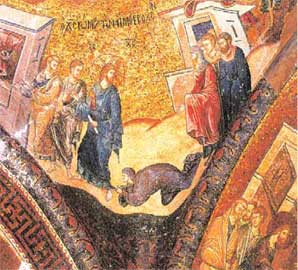 Ο Χριστός θεραπεύει την αιμορροούσα γυναίκα. Ψηφιδωτό, 14ος αι., Κωνσταντινούπολη.
Εκτός από τη χρονογραφία, την ιστορία και τα ιατρικά συγγράμματα, τα αγιολογικά κείμενα, και ιδιαίτερα το τμήμα εκείνο των Βίων το οποίο αναφέρεται στα θαύματα που έκαναν οι άγιοι είτε εν ζωή είτε μετά θάνατον, έχουν αποδειχτεί σημαντική πηγή πληροφόρησης σχετικά με τις ασθένειες του γυναικείου βυζαντινού πληθυσμού, τα μέσα θεραπείας τους και τον τρόπο αντιμετώπισής τους από τους συγχρόνους τους. Μεγάλο ποσοστό των θαυμάτων αφορούσε στη θεραπεία γυναικών από ανίατες ή επίπονες ασθένειες, που μπορούσαν να τις περιθωριοποιήσουν κοινωνικά ή και να αποβούν μοιραίες για τη ζωή τους. Οι ασθένειες ήταν είτε ασθένειες του γενικού πληθυσμού (καρκίνος, δερματικές παθήσεις, παθήσεις των ματιών, παράλυση των άνω ή κάτω άκρων, κεφαλαλγία) είτε αποκλειστικά γυναικολογικές παθήσεις, όπως οι αιμορραγίες των γεννητικών οργάνων, ενώ με το μανδύα της δαιμονικής κατάληψης περιγράφεται από τους Βυζαντινούς ένας μεγάλος αριθμός ψυχικών ή εγκεφαλικών παθήσεων, όπως επιληψία, τετραπληγία, κρίση μανίας.
Οι ασθενείς Βυζαντινές, και ιδιαίτερα όσες δεν ανήκαν σε εύρωστες οικονομικά οικογένειες, κατέφευγαν σπάνια σε γενικούς γιατρούς, δεν επωφελούνταν αρκετά από τις δυνατότητες της βυζαντινής ιατρικής επιστήμης, και, κατά κάποιον τρόπο, βρίσκονταν στο περιθώριο της κοινωνίας. Τα θαύματα των αγίων, εκτός από το να αποδείξουν τις θεϊκές ιδιότητες αυτών που τα τελούσαν, απέβλεπαν στην κατά το δυνατό αποδοχή της ανήμπορης ή ανάπηρης στην κοινωνία ιδίως μετά την αποθεραπεία της.
Ο Χριστός θεραπεύει την αιμορροούσα γυναίκα. Ψηφιδωτό, 14ος αι., Κωνσταντινούπολη.
Εκτός από τη χρονογραφία, την ιστορία και τα ιατρικά συγγράμματα, τα αγιολογικά κείμενα, και ιδιαίτερα το τμήμα εκείνο των Βίων το οποίο αναφέρεται στα θαύματα που έκαναν οι άγιοι είτε εν ζωή είτε μετά θάνατον, έχουν αποδειχτεί σημαντική πηγή πληροφόρησης σχετικά με τις ασθένειες του γυναικείου βυζαντινού πληθυσμού, τα μέσα θεραπείας τους και τον τρόπο αντιμετώπισής τους από τους συγχρόνους τους. Μεγάλο ποσοστό των θαυμάτων αφορούσε στη θεραπεία γυναικών από ανίατες ή επίπονες ασθένειες, που μπορούσαν να τις περιθωριοποιήσουν κοινωνικά ή και να αποβούν μοιραίες για τη ζωή τους. Οι ασθένειες ήταν είτε ασθένειες του γενικού πληθυσμού (καρκίνος, δερματικές παθήσεις, παθήσεις των ματιών, παράλυση των άνω ή κάτω άκρων, κεφαλαλγία) είτε αποκλειστικά γυναικολογικές παθήσεις, όπως οι αιμορραγίες των γεννητικών οργάνων, ενώ με το μανδύα της δαιμονικής κατάληψης περιγράφεται από τους Βυζαντινούς ένας μεγάλος αριθμός ψυχικών ή εγκεφαλικών παθήσεων, όπως επιληψία, τετραπληγία, κρίση μανίας.
Οι ασθενείς Βυζαντινές, και ιδιαίτερα όσες δεν ανήκαν σε εύρωστες οικονομικά οικογένειες, κατέφευγαν σπάνια σε γενικούς γιατρούς, δεν επωφελούνταν αρκετά από τις δυνατότητες της βυζαντινής ιατρικής επιστήμης, και, κατά κάποιον τρόπο, βρίσκονταν στο περιθώριο της κοινωνίας. Τα θαύματα των αγίων, εκτός από το να αποδείξουν τις θεϊκές ιδιότητες αυτών που τα τελούσαν, απέβλεπαν στην κατά το δυνατό αποδοχή της ανήμπορης ή ανάπηρης στην κοινωνία ιδίως μετά την αποθεραπεία της.
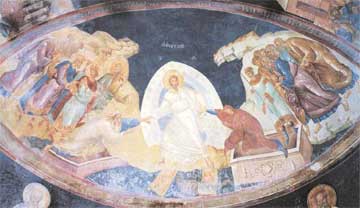 Ο Χριστός ανασηκώνει την πεπτωκυία γυναίκα Εύα-Παναγιά. Τοιχογραφία, 14ος αι., Κωνσταντινούπολη.
Η παρούσα δημοσίευση αφορά επεξεργασία παλαιότερης μονογραφίας με θέμα «Η βυζαντινή γυναίκα μέσα από τα αγιολογικά κείμενα και το ποινικό δίκαιο της Ορθοδόξου Ανατολικής Εκκλησίας»
Στην μονογραφία εκείνη, μέσα από την κριτική και ανάλυση των κειμένων, που αφορούσαν τους βίους των αγίων γυναικών Γοργίας (374),Δομνίνας (388),Πελάγιας (662), Ελισάβετ (465), Αθανασίας Αιγίνης (784) και Ειρήνης Χρυσοβαλάντου(872),προσπάθησα να ανιχνεύσω το κοινωνικό φύλο στο Βυζάντιο, όπως αυτό περιγράφεται στα κείμενα αυτά και να δω πως αυτό οριοθετείται κατά την συμβολική ερμηνεία του μύθου της Πτώσης και του μύθου της Ανάστασης, οι οποίοι διέπουν το αξιακό σύστημα της βυζαντινής κοινωνίας, συγχρονικά με τα ιστορικά γεγονότα που διέπουν κάθε διήγηση και την θεσμοθέτηση των κοινωνικών ρόλων στο Ποινικό Δίκαιο της Ορθοδόξου Ανατολικής Εκκλησίας .
Η κριτική ανάλυση και επεξεργασία των κειμένων απέδειξε την ερμηνεία του μύθου ανάλογα με την εποχή, σε συνάρτηση με την βιωματική εμπειρία των ανωνύμων (ή και επωνύμων) συγγραφέων των κειμένων, τα γεγονότα της εποχής με τις ανάγκες που προέκυπταν και σε αμφίδρομη σχέση με το ιδεολογικό-θεολογικό πλαίσιο (π.χ. Δόγματα, Αιρέσεις ).
Αν και στις περισσότερες διηγήσεις συστατικό στοιχείο του κοινωνικού φύλου προβάλει η ενοχή της γυναίκας στο κοινωνικό και φυσικό γίγνεσθαι, λόγω του «φύσει» τρεπτού του φύλου της, καθιερωμένου από τον μύθο της Πτώσης, στην αμέσως μετά (και κατά) την Εικονομαχία περίοδο συστατικό στοιχείο του κοινωνικού φύλου προβάλει η ενοχή του άνδρα λόγω της «φύσει» ορμής του και η απενοχοποίηση της γυναίκας ,η οποία στην ουτοπική «μοναχική» της διάσταση ταυτίζεται με το Θεομητορικό-Αγγελικό πρότυπο.
Στην παρούσα μελέτη θα προσπαθήσω, αναλύοντας τον βίο της αγίας Ειρήνης Χρυσοβαλάντου να δείξω πως γίνεται αυτή η μετάθεση μετά το τέλος της Β΄ Εικονομαχικής Περιόδου (813-843) .
Μέσα από την αγιολογική αυτή διήγηση η γυναίκα αντί για ένοχη περιγράφεται ως θεραπεύτρια του κοινωνικού κακού και ως θεραπεύτρια των ψυχών που ευθύνονται γι’ αυτό. Η σωματική ασθένεια και η θεραπεία της, όχι μόνο δεν απασχολεί τον συγγραφέα του κειμένου, αλλά εννοιολογείται διαφορετικά.
Ο Χριστός ανασηκώνει την πεπτωκυία γυναίκα Εύα-Παναγιά. Τοιχογραφία, 14ος αι., Κωνσταντινούπολη.
Η παρούσα δημοσίευση αφορά επεξεργασία παλαιότερης μονογραφίας με θέμα «Η βυζαντινή γυναίκα μέσα από τα αγιολογικά κείμενα και το ποινικό δίκαιο της Ορθοδόξου Ανατολικής Εκκλησίας»
Στην μονογραφία εκείνη, μέσα από την κριτική και ανάλυση των κειμένων, που αφορούσαν τους βίους των αγίων γυναικών Γοργίας (374),Δομνίνας (388),Πελάγιας (662), Ελισάβετ (465), Αθανασίας Αιγίνης (784) και Ειρήνης Χρυσοβαλάντου(872),προσπάθησα να ανιχνεύσω το κοινωνικό φύλο στο Βυζάντιο, όπως αυτό περιγράφεται στα κείμενα αυτά και να δω πως αυτό οριοθετείται κατά την συμβολική ερμηνεία του μύθου της Πτώσης και του μύθου της Ανάστασης, οι οποίοι διέπουν το αξιακό σύστημα της βυζαντινής κοινωνίας, συγχρονικά με τα ιστορικά γεγονότα που διέπουν κάθε διήγηση και την θεσμοθέτηση των κοινωνικών ρόλων στο Ποινικό Δίκαιο της Ορθοδόξου Ανατολικής Εκκλησίας .
Η κριτική ανάλυση και επεξεργασία των κειμένων απέδειξε την ερμηνεία του μύθου ανάλογα με την εποχή, σε συνάρτηση με την βιωματική εμπειρία των ανωνύμων (ή και επωνύμων) συγγραφέων των κειμένων, τα γεγονότα της εποχής με τις ανάγκες που προέκυπταν και σε αμφίδρομη σχέση με το ιδεολογικό-θεολογικό πλαίσιο (π.χ. Δόγματα, Αιρέσεις ).
Αν και στις περισσότερες διηγήσεις συστατικό στοιχείο του κοινωνικού φύλου προβάλει η ενοχή της γυναίκας στο κοινωνικό και φυσικό γίγνεσθαι, λόγω του «φύσει» τρεπτού του φύλου της, καθιερωμένου από τον μύθο της Πτώσης, στην αμέσως μετά (και κατά) την Εικονομαχία περίοδο συστατικό στοιχείο του κοινωνικού φύλου προβάλει η ενοχή του άνδρα λόγω της «φύσει» ορμής του και η απενοχοποίηση της γυναίκας ,η οποία στην ουτοπική «μοναχική» της διάσταση ταυτίζεται με το Θεομητορικό-Αγγελικό πρότυπο.
Στην παρούσα μελέτη θα προσπαθήσω, αναλύοντας τον βίο της αγίας Ειρήνης Χρυσοβαλάντου να δείξω πως γίνεται αυτή η μετάθεση μετά το τέλος της Β΄ Εικονομαχικής Περιόδου (813-843) .
Μέσα από την αγιολογική αυτή διήγηση η γυναίκα αντί για ένοχη περιγράφεται ως θεραπεύτρια του κοινωνικού κακού και ως θεραπεύτρια των ψυχών που ευθύνονται γι’ αυτό. Η σωματική ασθένεια και η θεραπεία της, όχι μόνο δεν απασχολεί τον συγγραφέα του κειμένου, αλλά εννοιολογείται διαφορετικά.
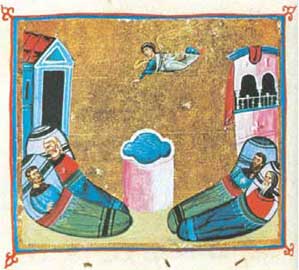 Η κολυμβήθρα της Βηθεσδά. Εικονογραφημένο χειρόγραφο, 11ος αι., Μονή Διονυσίου, Άγιον Όρος.
Πρακτική θεσμοθετημένη στην αρχαιότητα, η εγκοίμηση επιδιώκει την ίαση της ασθένειας μέσω του ονείρου που προκαλείται με ύπνο σε ιερό τόπο αφού έχει πρώτα τηρηθεί συγκεκριμένο εξαγνιστικό τελετουργικό. Ο χριστιανισμός υιοθέτησε αυτούσια την αρχαία αυτήν πρακτική προσαρμόζοντάς την, όμως, στις δικές του επιδιώξεις και ακολουθώντας ένα τελετουργικό που έμοιαζε εντυπωσιακά με εκείνο των «ειδωλολατρικών» ιερών της εγκοίμησης. Η χριστιανική εγκοίμηση αντιπροσωπεύει μια μορφή λαϊκής (κοσμικής) θρησκευτικότητας, με αρχές και στόχους πολύ διαφορετικούς από εκείνους του ασκητισμού. Σε πείσμα της υποτιθέμενης μετατόπισης της χριστιανικής θρησκευτικότητας, από την σωματοκεντρική πολιτισμική παράδοση της αρχαιότητας, προς μια πνευματικότητα ασκητική που εχθρεύεται το σώμα, η εγκοίμηση ενδιαφέρεται πρωτίστως για το σώμα και όχι για το πνεύμα. Φροντίζει για την επίγεια ζωή όσων προσφεύγουν σε αυτήν και όχι για την μεταθανάτια. Ενώ, λοιπόν, οι ασκητές μοιάζουν να ντρέπονται που έχουν σώματα —φθάνοντας να θεωρούν την ασθένεια ως ένα είδος θείας δωρεάς που τους απαλλάσσει από το επίπονο καθήκον της εκούσιας απονέκρωσης των σωμάτων τους— οι ασθενείς της εγκοίμησης φαίνονται να έχουν τα σώματά τους σε μεγάλη εκτίμηση και να ντρέπονται για την σωματική ασθένεια και την παραμόρφωση που αυτή επιφέρει. Το παρόν άρθρο επικεντρώνεται στα Θαύματα του Αγίου Αρτεμίου, ένα εντυπωσιακό κείμενο που καταγράφει 45 ιάσεις που συνέβησαν σε ένα κέντρο εγκοιμήσεως της Κωνσταντινούπολης του 7ου αιώνα. Η εξειδίκευση του Αγίου στην θεραπεία βουβωνικής κήλης και άλλων διαταραχών των ανδρικών γεννητικών οργάνων καθιστά το κείμενο μια σπάνια και ανεξερεύνητη εν πολλοίς πηγή πληροφοριών για θέματα όπως η αντίληψη του σώματος, η ανδρική έμφυλη ταυτότητα, ο ευνουχισμός. Για την σχεδόν κατ’ αποκλειστικότητα ανδρική και κοσμική πελατεία του Αγίου, η ασθένεια, η παραμόρφωση και ο ακρωτηριασμός των γεννητικών οργάνων είναι μια εμφανής πηγή αμηχανίας, ντροπής και φόβου. Πρόκειται κυρίως για έναν φόβο απώλειας της ανδρικής ταυτότητας, τον οποίο άλλωστε το κείμενο αξιοποιεί με δεξιοτεχνία. Η αποστροφή προς το χειρουργείο και η εχθρότητα προς τους ιατρούς σκιαγραφούνται με εντυπωσιακό τρόπο στις αφηγήσεις των θαυμάτων — ορισμένες φορές μέσα από ολοζώντανες περιγραφές των ονείρων των ασθενών. Τα συναισθήματά τους αυτά συνδέονται, σχεδόν πάντοτε, με τον πρωταρχικό αυτόν φόβο τους να χάσουν τον ανδρισμό τους, δηλαδή να ευνουχιστούν, πράγμα που ήταν συχνά το αποτέλεσμα της χειρουργικής αντιμετώπισης της κήλης την εποχή εκείνη. Η προσφυγή στο κέντρο εγκοίμησης του Αρτεμίου προσφέρει στους ασθενείς ένα ασφαλές καταφύγιο μακρυά από την κοινωνική κατακραυγή και τον στιγματισμό που επιφέρει η ασθένεια. Γίνονται μέλη μιας κλειστής και προστατευμένης κοινότητας ομοιοπαθών όπου μπορούν να συζητήσουν ανοιχτά τα προβλήματα και τους φόβους τους, ή ακόμη και να συγκρίνουν το μέγεθος των παθήσεών τους. Παράλληλα, εξοικειώνουν τους εαυτούς τους με τις αφηγήσεις των θαυματουργών ιάσεων του κέντρου, και προετοιμάζονται έτσι σταδιακά για την πολυαναμενόμενη θεραπεία, ξαναβρίσκοντας την ελπίδα της κοινωνικής επανένταξης.
Η κολυμβήθρα της Βηθεσδά. Εικονογραφημένο χειρόγραφο, 11ος αι., Μονή Διονυσίου, Άγιον Όρος.
Πρακτική θεσμοθετημένη στην αρχαιότητα, η εγκοίμηση επιδιώκει την ίαση της ασθένειας μέσω του ονείρου που προκαλείται με ύπνο σε ιερό τόπο αφού έχει πρώτα τηρηθεί συγκεκριμένο εξαγνιστικό τελετουργικό. Ο χριστιανισμός υιοθέτησε αυτούσια την αρχαία αυτήν πρακτική προσαρμόζοντάς την, όμως, στις δικές του επιδιώξεις και ακολουθώντας ένα τελετουργικό που έμοιαζε εντυπωσιακά με εκείνο των «ειδωλολατρικών» ιερών της εγκοίμησης. Η χριστιανική εγκοίμηση αντιπροσωπεύει μια μορφή λαϊκής (κοσμικής) θρησκευτικότητας, με αρχές και στόχους πολύ διαφορετικούς από εκείνους του ασκητισμού. Σε πείσμα της υποτιθέμενης μετατόπισης της χριστιανικής θρησκευτικότητας, από την σωματοκεντρική πολιτισμική παράδοση της αρχαιότητας, προς μια πνευματικότητα ασκητική που εχθρεύεται το σώμα, η εγκοίμηση ενδιαφέρεται πρωτίστως για το σώμα και όχι για το πνεύμα. Φροντίζει για την επίγεια ζωή όσων προσφεύγουν σε αυτήν και όχι για την μεταθανάτια. Ενώ, λοιπόν, οι ασκητές μοιάζουν να ντρέπονται που έχουν σώματα —φθάνοντας να θεωρούν την ασθένεια ως ένα είδος θείας δωρεάς που τους απαλλάσσει από το επίπονο καθήκον της εκούσιας απονέκρωσης των σωμάτων τους— οι ασθενείς της εγκοίμησης φαίνονται να έχουν τα σώματά τους σε μεγάλη εκτίμηση και να ντρέπονται για την σωματική ασθένεια και την παραμόρφωση που αυτή επιφέρει. Το παρόν άρθρο επικεντρώνεται στα Θαύματα του Αγίου Αρτεμίου, ένα εντυπωσιακό κείμενο που καταγράφει 45 ιάσεις που συνέβησαν σε ένα κέντρο εγκοιμήσεως της Κωνσταντινούπολης του 7ου αιώνα. Η εξειδίκευση του Αγίου στην θεραπεία βουβωνικής κήλης και άλλων διαταραχών των ανδρικών γεννητικών οργάνων καθιστά το κείμενο μια σπάνια και ανεξερεύνητη εν πολλοίς πηγή πληροφοριών για θέματα όπως η αντίληψη του σώματος, η ανδρική έμφυλη ταυτότητα, ο ευνουχισμός. Για την σχεδόν κατ’ αποκλειστικότητα ανδρική και κοσμική πελατεία του Αγίου, η ασθένεια, η παραμόρφωση και ο ακρωτηριασμός των γεννητικών οργάνων είναι μια εμφανής πηγή αμηχανίας, ντροπής και φόβου. Πρόκειται κυρίως για έναν φόβο απώλειας της ανδρικής ταυτότητας, τον οποίο άλλωστε το κείμενο αξιοποιεί με δεξιοτεχνία. Η αποστροφή προς το χειρουργείο και η εχθρότητα προς τους ιατρούς σκιαγραφούνται με εντυπωσιακό τρόπο στις αφηγήσεις των θαυμάτων — ορισμένες φορές μέσα από ολοζώντανες περιγραφές των ονείρων των ασθενών. Τα συναισθήματά τους αυτά συνδέονται, σχεδόν πάντοτε, με τον πρωταρχικό αυτόν φόβο τους να χάσουν τον ανδρισμό τους, δηλαδή να ευνουχιστούν, πράγμα που ήταν συχνά το αποτέλεσμα της χειρουργικής αντιμετώπισης της κήλης την εποχή εκείνη. Η προσφυγή στο κέντρο εγκοίμησης του Αρτεμίου προσφέρει στους ασθενείς ένα ασφαλές καταφύγιο μακρυά από την κοινωνική κατακραυγή και τον στιγματισμό που επιφέρει η ασθένεια. Γίνονται μέλη μιας κλειστής και προστατευμένης κοινότητας ομοιοπαθών όπου μπορούν να συζητήσουν ανοιχτά τα προβλήματα και τους φόβους τους, ή ακόμη και να συγκρίνουν το μέγεθος των παθήσεών τους. Παράλληλα, εξοικειώνουν τους εαυτούς τους με τις αφηγήσεις των θαυματουργών ιάσεων του κέντρου, και προετοιμάζονται έτσι σταδιακά για την πολυαναμενόμενη θεραπεία, ξαναβρίσκοντας την ελπίδα της κοινωνικής επανένταξης.
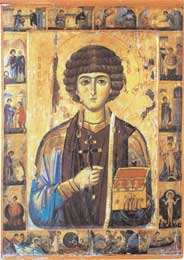 Ο άγιος Παντελεήμων, ιαματικός άγιος, με σκηνές από τον βίο του. Τέμπερα σε ξύλο, 13ος αι., Μονή Αγίας Αικατερίνης Σινά.
Σε Βίους αγίων, βυζαντινά κείμενα του 7ου αιώνα, δηλαδή μιας εποχής μεταβατικής, διερευνάται η αμφισβήτηση της ιατρικής επιστήμης από την χριστιανική κοινότητα. Στα κείμενα αυτά κατατίθενται οι αντιλήψεις για τα κυρίαρχα θεραπευτικά μοντέλα και τις προτεινόμενες λύσεις φιλανθρωπίας τόσο στην βυζαντινή επαρχία (Συρία, Αίγυπτο, μικρασιατική Γαλατία) όσο και στις μεγάλες πόλεις της αυτοκρατορίας, Αλεξάνδρεια, Θεσσαλονίκη και Κωνσταντινούπολη. Σε πολλά από τα αναφερόμενα θαύματα προβάλλεται η αναποτελεσματικότητα της θύραθεν ιατρικής επιστήμης, η οποία είναι πάντα παρούσα και ανθηρή με υπερβολικό πλουτισμό και αξιώματα δίπλα στους άνακτες, υπηρετούμενη μάλιστα από διαφόρους κερδοσκόπους χλιαρής πίστης, ελληνίζοντες και Εβραίους. Η αναφερόμενη επανειλημμένως αναποτελεσματικότητα του Ιπποκράτη, Γαληνού και Δημοκρίτου και των σύγχρονων ιστροσοφιστών, σε σύγκριση πάντα με την αποτελεσματική δράση των αγίων, αν και αποτελεί στοιχείο της ρητορικής και γενικώς της πολεμικής κατά των εθνικών, τεκμηριώνεται πλειστάκις από τα εξιστορούμενα συμβάντα. Πρόκειται για μια προσπάθεια όχι μόνον να ελεγχθεί η ιατρική επιστήμη και λαϊκή θεραπευτική από τον χριστιανισμό, αλλά και να αποκαθαρθεί από ό,τι θα μπορούσε να θεωρηθεί ότι αντιστρατεύεται τα συμφέροντά του, ως διδασκαλία (μαγεία, δεισιδαιμονία) και ως τρόπος και οργάνωση του βίου (προσκυνήματα, ιαματικά κέντρα, νοσοκομεία, ξενώνες με στελέχωσή τους από μοναχούς, εξεύρεση και διαχείριση πόρων. Η μάχη κατά των μάγων, γοήτων, ιατροφιλοσόφων, των μη χριστιανών θεραπευτών συντηρείται, ώς ένα βαθμό, από την καινούργια αντίληψη για την πολιτειακή έκφραση της χριστιανικής φιλανθρωπίας. Δεν αμφισβητείται κατά συνέπεια ο ιατρός, αλλά η ένταξή του σε κοινωνικές ομάδες που υπηρετούν ή εφαρμόζουν μη αποδεκτές ή ανταγωνιστικές θρησκευτικές και θεραπευτικές τεχνικές. Η εκκλησία προεξάρχει στην διεκδίκηση της διαχείρησης της ιατρικής και θεραπευτικής και οδηγεί σε δαιμονοποίηση ή και εξετρελισμό τους μη χριστιανούς ιατρούς με χαρακτηριστικότερο το παράδειγμα του Γεσίου. Ο εξευτελισμός των γιατρών της ύστερης αρχαιότητας που (σχεδόν) δεν χρειάζονται, αντιστοιχείται με σημερινές καταστάσεις, όταν η θεραπευτική ανάγκη, η απελπισία, η οικονομική και κοινωνική θέση, η παιδεία και η θρησκευτική πίστη αλλά κυρίως τα αντικρουόμενα συμφέροντα ιατρών και ασθενών οδηγούν σε απομάκρυνση της ιατρικής από τον άρρωστο, στην μωρία και ανοησία αντίστοιχη του Γεσίου.
Ο άγιος Παντελεήμων, ιαματικός άγιος, με σκηνές από τον βίο του. Τέμπερα σε ξύλο, 13ος αι., Μονή Αγίας Αικατερίνης Σινά.
Σε Βίους αγίων, βυζαντινά κείμενα του 7ου αιώνα, δηλαδή μιας εποχής μεταβατικής, διερευνάται η αμφισβήτηση της ιατρικής επιστήμης από την χριστιανική κοινότητα. Στα κείμενα αυτά κατατίθενται οι αντιλήψεις για τα κυρίαρχα θεραπευτικά μοντέλα και τις προτεινόμενες λύσεις φιλανθρωπίας τόσο στην βυζαντινή επαρχία (Συρία, Αίγυπτο, μικρασιατική Γαλατία) όσο και στις μεγάλες πόλεις της αυτοκρατορίας, Αλεξάνδρεια, Θεσσαλονίκη και Κωνσταντινούπολη. Σε πολλά από τα αναφερόμενα θαύματα προβάλλεται η αναποτελεσματικότητα της θύραθεν ιατρικής επιστήμης, η οποία είναι πάντα παρούσα και ανθηρή με υπερβολικό πλουτισμό και αξιώματα δίπλα στους άνακτες, υπηρετούμενη μάλιστα από διαφόρους κερδοσκόπους χλιαρής πίστης, ελληνίζοντες και Εβραίους. Η αναφερόμενη επανειλημμένως αναποτελεσματικότητα του Ιπποκράτη, Γαληνού και Δημοκρίτου και των σύγχρονων ιστροσοφιστών, σε σύγκριση πάντα με την αποτελεσματική δράση των αγίων, αν και αποτελεί στοιχείο της ρητορικής και γενικώς της πολεμικής κατά των εθνικών, τεκμηριώνεται πλειστάκις από τα εξιστορούμενα συμβάντα. Πρόκειται για μια προσπάθεια όχι μόνον να ελεγχθεί η ιατρική επιστήμη και λαϊκή θεραπευτική από τον χριστιανισμό, αλλά και να αποκαθαρθεί από ό,τι θα μπορούσε να θεωρηθεί ότι αντιστρατεύεται τα συμφέροντά του, ως διδασκαλία (μαγεία, δεισιδαιμονία) και ως τρόπος και οργάνωση του βίου (προσκυνήματα, ιαματικά κέντρα, νοσοκομεία, ξενώνες με στελέχωσή τους από μοναχούς, εξεύρεση και διαχείριση πόρων. Η μάχη κατά των μάγων, γοήτων, ιατροφιλοσόφων, των μη χριστιανών θεραπευτών συντηρείται, ώς ένα βαθμό, από την καινούργια αντίληψη για την πολιτειακή έκφραση της χριστιανικής φιλανθρωπίας. Δεν αμφισβητείται κατά συνέπεια ο ιατρός, αλλά η ένταξή του σε κοινωνικές ομάδες που υπηρετούν ή εφαρμόζουν μη αποδεκτές ή ανταγωνιστικές θρησκευτικές και θεραπευτικές τεχνικές. Η εκκλησία προεξάρχει στην διεκδίκηση της διαχείρησης της ιατρικής και θεραπευτικής και οδηγεί σε δαιμονοποίηση ή και εξετρελισμό τους μη χριστιανούς ιατρούς με χαρακτηριστικότερο το παράδειγμα του Γεσίου. Ο εξευτελισμός των γιατρών της ύστερης αρχαιότητας που (σχεδόν) δεν χρειάζονται, αντιστοιχείται με σημερινές καταστάσεις, όταν η θεραπευτική ανάγκη, η απελπισία, η οικονομική και κοινωνική θέση, η παιδεία και η θρησκευτική πίστη αλλά κυρίως τα αντικρουόμενα συμφέροντα ιατρών και ασθενών οδηγούν σε απομάκρυνση της ιατρικής από τον άρρωστο, στην μωρία και ανοησία αντίστοιχη του Γεσίου.
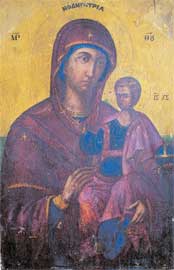 Η Β΄ όψη της εικόνας της Παναγίας Οδηγήτριας.
Κατά το θέρος του 1998, μου ανατέθηκε η συντήρηση της δεσποτικής εικόνας της Παναγίας Οδηγήτριας (140 x 80 εκ.), στον Ιερό Ναό Αγίου Νικολάου Άρτας. Η εικόνα έφερε παράσταση της Παναγίας με τον Χριστό, ζωγραφισμένη με την τεχνική της ελαιογραφίας επάνω σε ξύλο καρυδιάς, και χρονολογούνταν στο α΄ μισό του 20ού αιώνα.
Κατά τη διαδικασία της συντήρησης αποκαλύφθηκε παλαιότερο στρώμα ζωγραφικής του ίδιου θέματος, που εκτιμούμε ότι ανήκει στο τέλος του 17ου αιώνα. Ωστόσο, μεγαλύτερο ενδιαφέρον ακόμη παρουσίαζε μια άλλη παράσταση της Παναγίας Οδηγήτριας που αποκαλύφθηκε στην πίσω όψη της εικόνας και εκτιμούμε ότι τοποθετείται στον 14ο αιώνα. Πρόκειται λοιπόν για αμφιπρόσωπη εικόνα με το θέμα της Παναγίας και του Χριστού να κοσμεί και τις δύο πλευρές.
α. Μπροστινή όψη: Διενεργήθηκε ακτινογράφηση στην περιοχή των προσώπων της Παναγίας και του Χριστού και, στη συνέχεια, αφού εξετάστηκε η κατάσταση του παλαιότερου στρώματος ζωγραφικής αποφασίστηκε η αφαίρεση της επιζωγράφισης. Η εικόνα που αποκαλύφθηκε, η οποία σωζόταν στο μεγαλύτερο μέρος της έκτασής της, φέρει την επιγραφή Η ΟΔΗΓΗΤΡΙΑ και ανήκει στον εικονογραφικό τύπο της Θεοτόκου Madre della Consolazione, ενώ με βάση τα τεχνοτροπικά χαρακτηριστικά της μπορεί να χρονολογηθεί στα τέλη του 17ου αιώνα.
β. Πίσω όψη: Τμηματικά αφαιρέθηκε πρώτα το στρώμα της καφετιάς απόχρωσης λαδομπογιάς και το στρώμα του βερνικιού, και αποκαλύφθηκε μια παλαιότερη παράσταση της Παναγίας Οδηγήτριας. Πρόκειται για μία εξαιρετικής δεξιοτεχνίας βυζαντινή εικόνα, δουλεμένη με αυγοτέμπερα επάνω σε λινό ύφασμα και προετοιμασία από γύψο και σπάνιας τεχνικής χρυσοκονδυλιές. Το στρώμα του βερνικιού είχε αποκτήσει μια κοκκινωπή απόχρωση εξαιτίας της οξείδωσης. Η τεχνοτροπική ομοιότητα του έργου με θρησκευτικές εικόνες από τα εργαστήρια της
Θεσσαλονίκης, μας οδηγούν να χρονολογήσουμε την εικόνα στο α΄ μισό του 14ου αιώνα και να τη συνδέσουμε με το καλλιτεχνικό περιβάλλον της πρωτεύουσας της Βόρειας Ελλάδας.
Η Β΄ όψη της εικόνας της Παναγίας Οδηγήτριας.
Κατά το θέρος του 1998, μου ανατέθηκε η συντήρηση της δεσποτικής εικόνας της Παναγίας Οδηγήτριας (140 x 80 εκ.), στον Ιερό Ναό Αγίου Νικολάου Άρτας. Η εικόνα έφερε παράσταση της Παναγίας με τον Χριστό, ζωγραφισμένη με την τεχνική της ελαιογραφίας επάνω σε ξύλο καρυδιάς, και χρονολογούνταν στο α΄ μισό του 20ού αιώνα.
Κατά τη διαδικασία της συντήρησης αποκαλύφθηκε παλαιότερο στρώμα ζωγραφικής του ίδιου θέματος, που εκτιμούμε ότι ανήκει στο τέλος του 17ου αιώνα. Ωστόσο, μεγαλύτερο ενδιαφέρον ακόμη παρουσίαζε μια άλλη παράσταση της Παναγίας Οδηγήτριας που αποκαλύφθηκε στην πίσω όψη της εικόνας και εκτιμούμε ότι τοποθετείται στον 14ο αιώνα. Πρόκειται λοιπόν για αμφιπρόσωπη εικόνα με το θέμα της Παναγίας και του Χριστού να κοσμεί και τις δύο πλευρές.
α. Μπροστινή όψη: Διενεργήθηκε ακτινογράφηση στην περιοχή των προσώπων της Παναγίας και του Χριστού και, στη συνέχεια, αφού εξετάστηκε η κατάσταση του παλαιότερου στρώματος ζωγραφικής αποφασίστηκε η αφαίρεση της επιζωγράφισης. Η εικόνα που αποκαλύφθηκε, η οποία σωζόταν στο μεγαλύτερο μέρος της έκτασής της, φέρει την επιγραφή Η ΟΔΗΓΗΤΡΙΑ και ανήκει στον εικονογραφικό τύπο της Θεοτόκου Madre della Consolazione, ενώ με βάση τα τεχνοτροπικά χαρακτηριστικά της μπορεί να χρονολογηθεί στα τέλη του 17ου αιώνα.
β. Πίσω όψη: Τμηματικά αφαιρέθηκε πρώτα το στρώμα της καφετιάς απόχρωσης λαδομπογιάς και το στρώμα του βερνικιού, και αποκαλύφθηκε μια παλαιότερη παράσταση της Παναγίας Οδηγήτριας. Πρόκειται για μία εξαιρετικής δεξιοτεχνίας βυζαντινή εικόνα, δουλεμένη με αυγοτέμπερα επάνω σε λινό ύφασμα και προετοιμασία από γύψο και σπάνιας τεχνικής χρυσοκονδυλιές. Το στρώμα του βερνικιού είχε αποκτήσει μια κοκκινωπή απόχρωση εξαιτίας της οξείδωσης. Η τεχνοτροπική ομοιότητα του έργου με θρησκευτικές εικόνες από τα εργαστήρια της
Θεσσαλονίκης, μας οδηγούν να χρονολογήσουμε την εικόνα στο α΄ μισό του 14ου αιώνα και να τη συνδέσουμε με το καλλιτεχνικό περιβάλλον της πρωτεύουσας της Βόρειας Ελλάδας.
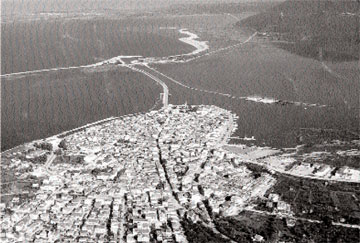 Η πόλη της Λευκάδας και το φρούριο.
Η ιστορία της πόλης της Λευκάδας, πρωτεύουσας του νησιωτικού συμπλέγματος, που απαρτίζει τον ομώνυμο νομό, χάνεται στους μεσαιωνικούς χρόνους, αλλά είναι ακόμα ελάχιστα γνωστή και ακόμα λιγότερο τεκμηριωμένη. Πλημμελώς έχει μελετηθεί επίσης η ιστορική δομή του πολεοδομικού ιστού της και η φυσιογνωμία των σπιτιών της. Για το λόγο αυτό κάθε βλάβη του πυκνοδομημένου ιστορικού κέντρου της αφανίζει στοιχεία της ιστορίας και αποβαίνει μοιραία για την τεκμηρίωση της εξέλιξης του μόνου από τα τρία εξώμπουργκα της μεσαιωνικής πρωτεύουσας του νησιού, που διατηρείται μέχρι σήμερα. Δυστυχώς, η ραγδαία εξελισσόμενη ανοικοδόμηση και η αντικατάσταση των παλαιών με νέα υλικά, καταρρακώνει την ιστορική ταυτότητα της ιδιότυπης αντισεισμικής αρχιτεκτονικής και της πολεοδομικής υπόστασής της και ανατρέπει την ισορροπία μεταξύ αυθεντικού και κίβδηλου αρχιτεκτονικού έργου, εις βάρος του πρώτου.
Η πόλη της Λευκάδας και το φρούριο.
Η ιστορία της πόλης της Λευκάδας, πρωτεύουσας του νησιωτικού συμπλέγματος, που απαρτίζει τον ομώνυμο νομό, χάνεται στους μεσαιωνικούς χρόνους, αλλά είναι ακόμα ελάχιστα γνωστή και ακόμα λιγότερο τεκμηριωμένη. Πλημμελώς έχει μελετηθεί επίσης η ιστορική δομή του πολεοδομικού ιστού της και η φυσιογνωμία των σπιτιών της. Για το λόγο αυτό κάθε βλάβη του πυκνοδομημένου ιστορικού κέντρου της αφανίζει στοιχεία της ιστορίας και αποβαίνει μοιραία για την τεκμηρίωση της εξέλιξης του μόνου από τα τρία εξώμπουργκα της μεσαιωνικής πρωτεύουσας του νησιού, που διατηρείται μέχρι σήμερα. Δυστυχώς, η ραγδαία εξελισσόμενη ανοικοδόμηση και η αντικατάσταση των παλαιών με νέα υλικά, καταρρακώνει την ιστορική ταυτότητα της ιδιότυπης αντισεισμικής αρχιτεκτονικής και της πολεοδομικής υπόστασής της και ανατρέπει την ισορροπία μεταξύ αυθεντικού και κίβδηλου αρχιτεκτονικού έργου, εις βάρος του πρώτου.
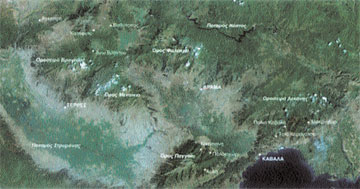 Η περιοχή της Ανατολ. Μακεδονίας, με τις θέσεις εξόρυξης και μεταλλουργικής παραγωγής.
Η προέλευση του χρυσού της Βυζαντινής Αυτοκρατορίας θεωρείται εν γένει δυσεπίλυτο ζήτημα. Μία από τις πιθανές περιοχές που συνετέλεσαν στη δημιουργία ενός αποθέματος χρυσού είναι η Μακεδονία με τα πλούσια κοιτάσματά της. Σε μερικά από τα κέντρα εξόρυξης και μεταποίησης σιδήρου μεταξύ 13ου και 16ου αιώνα, όπως το Άγκιστρο και το Μακρυχώρι, διενεργείτο και παράλληλη εξόρυξη χρυσού. Η μελέτη μεταλλουργικών καταλοίπων από τέσσερις θέσεις υποδεικνύει δύο περιπτώσεις μικρής κλίμακας παραγωγή και δύο μεγάλης κλίμακας ελεγχόμενη δραστηριότητα. Από την έρευνα προκύπτουν σημαντικές πληροφορίες σχετικά με την οργάνωση της παραγωγικής διαδικασίας και τη χρήση χώρων εργασίας για την εκμετάλλευση πρώτων υλών και αξιολογείται η τεχνολογική πολυπλοκότητα του βυζαντινού κόσμου.
Η περιοχή της Ανατολ. Μακεδονίας, με τις θέσεις εξόρυξης και μεταλλουργικής παραγωγής.
Η προέλευση του χρυσού της Βυζαντινής Αυτοκρατορίας θεωρείται εν γένει δυσεπίλυτο ζήτημα. Μία από τις πιθανές περιοχές που συνετέλεσαν στη δημιουργία ενός αποθέματος χρυσού είναι η Μακεδονία με τα πλούσια κοιτάσματά της. Σε μερικά από τα κέντρα εξόρυξης και μεταποίησης σιδήρου μεταξύ 13ου και 16ου αιώνα, όπως το Άγκιστρο και το Μακρυχώρι, διενεργείτο και παράλληλη εξόρυξη χρυσού. Η μελέτη μεταλλουργικών καταλοίπων από τέσσερις θέσεις υποδεικνύει δύο περιπτώσεις μικρής κλίμακας παραγωγή και δύο μεγάλης κλίμακας ελεγχόμενη δραστηριότητα. Από την έρευνα προκύπτουν σημαντικές πληροφορίες σχετικά με την οργάνωση της παραγωγικής διαδικασίας και τη χρήση χώρων εργασίας για την εκμετάλλευση πρώτων υλών και αξιολογείται η τεχνολογική πολυπλοκότητα του βυζαντινού κόσμου.
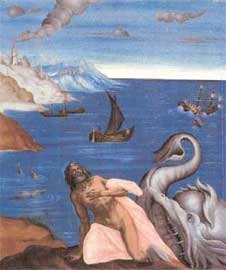 Ο προφήτης Ιωνάς. Θωράκιο, 18ος αι., Μουσείο Ζακύνθου.
Στα Επτάνησα, από το δεύτερο μισό του 17ου και κατά τη διάρκεια του 18ου αιώνα, η λατρευτική εικόνα, έτσι όπως είχε κληροδοτηθεί από τη βυζαντινή τέχνη, μεταμορφώνεται σταδιακά, ενώ οι δημιουργοί της Επτανησιακής Σχολής θα απαρνηθούν τη μεταβυζαντινή παράδοση για να υιοθετήσουν την τεχνική της ελαιογραφίας και ένα ιδίωμα νατουραλιστικό. Σχολιάζοντας την εξέλιξη από την εικόνα στον πίνακα, επικεντρωνόμαστε σε δύο χαρακτηριστικές περιπτώσεις θρησκευτικών έργων: τα θωράκια τέμπλων εκκλησιών της Ζακύνθου –αναπαράγουν μαζικά δυτικές χαλκογραφίες– και τις αναθηματικές εικόνες, έργα δημόσιας και ιδιωτικής λατρείας αντίστοιχα. Πέρα από τον αυστηρό χαρακτήρα του παραδοσιακού τέμπλου, η πλούσια θεματολογία των θωρακίων της Ζακύνθου αναδεικνύει ένα καινούργιο σύστημα αξιών, ενώ οι αναθηματικές εικόνες αναπαριστούν, συχνά με νατουραλιστική ακρίβεια, στοιχεία από το άμεσο περιβάλλον του παραγγελιοδότη.
Μετά την κατάκτηση της Κρήτης από τους Οθωμανούς: οι ορθόδοξοι ελληνόφωνοι πληθυσμοί στα Επτάνησα δεν αντιλαμβάνονται πλέον την πολιτισμική τους ταυτότητα σε αντιπαραβολή με τους Βενετούς και την κουλτούρα τους (όπως έκαναν σε μεγάλο βαθμό οι Κρητικοί) ούτε αυτοπροσδιορίζονται με βασικό κριτήριο το θρησκευτικό τους δόγμα. Θεμελιώδες πρότυπο για ένα διευρυμένο αστικό κοινό, ανεξάρτητο από εθνική προέλευση και δόγμα, αποτελεί πλέον η ίδια η Βενετία και η δημόσια εικόνα της. Αυτό επηρεάζει άμεσα την τέχνη και τα αισθητικά ιδεώδη, με αποτέλεσμα αστικοί κύκλοι των Επτανήσων να στρέφονται σε νατουραλιστικές αισθητικές αξίες προκειμένου να εκφράσουν τη θρησκευτικότητά τους.
Ο προφήτης Ιωνάς. Θωράκιο, 18ος αι., Μουσείο Ζακύνθου.
Στα Επτάνησα, από το δεύτερο μισό του 17ου και κατά τη διάρκεια του 18ου αιώνα, η λατρευτική εικόνα, έτσι όπως είχε κληροδοτηθεί από τη βυζαντινή τέχνη, μεταμορφώνεται σταδιακά, ενώ οι δημιουργοί της Επτανησιακής Σχολής θα απαρνηθούν τη μεταβυζαντινή παράδοση για να υιοθετήσουν την τεχνική της ελαιογραφίας και ένα ιδίωμα νατουραλιστικό. Σχολιάζοντας την εξέλιξη από την εικόνα στον πίνακα, επικεντρωνόμαστε σε δύο χαρακτηριστικές περιπτώσεις θρησκευτικών έργων: τα θωράκια τέμπλων εκκλησιών της Ζακύνθου –αναπαράγουν μαζικά δυτικές χαλκογραφίες– και τις αναθηματικές εικόνες, έργα δημόσιας και ιδιωτικής λατρείας αντίστοιχα. Πέρα από τον αυστηρό χαρακτήρα του παραδοσιακού τέμπλου, η πλούσια θεματολογία των θωρακίων της Ζακύνθου αναδεικνύει ένα καινούργιο σύστημα αξιών, ενώ οι αναθηματικές εικόνες αναπαριστούν, συχνά με νατουραλιστική ακρίβεια, στοιχεία από το άμεσο περιβάλλον του παραγγελιοδότη.
Μετά την κατάκτηση της Κρήτης από τους Οθωμανούς: οι ορθόδοξοι ελληνόφωνοι πληθυσμοί στα Επτάνησα δεν αντιλαμβάνονται πλέον την πολιτισμική τους ταυτότητα σε αντιπαραβολή με τους Βενετούς και την κουλτούρα τους (όπως έκαναν σε μεγάλο βαθμό οι Κρητικοί) ούτε αυτοπροσδιορίζονται με βασικό κριτήριο το θρησκευτικό τους δόγμα. Θεμελιώδες πρότυπο για ένα διευρυμένο αστικό κοινό, ανεξάρτητο από εθνική προέλευση και δόγμα, αποτελεί πλέον η ίδια η Βενετία και η δημόσια εικόνα της. Αυτό επηρεάζει άμεσα την τέχνη και τα αισθητικά ιδεώδη, με αποτέλεσμα αστικοί κύκλοι των Επτανήσων να στρέφονται σε νατουραλιστικές αισθητικές αξίες προκειμένου να εκφράσουν τη θρησκευτικότητά τους.
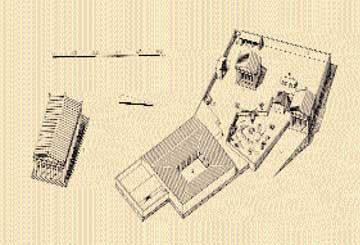 Αναπαράσταση του τεμένους του Ιππολύτου στην Τροιζήνα.
Περίπου 170 χιλιόμετρα μακριά από την Αθήνα, σε μικρή απόσταση από την Επίδαυρο, βρίσκεται ένας αξιόλογος αρχαιολογικός χώρος, που παραμένει άγνωστος στο ευρύ κοινό. Το ιερό του Ιππολύτου στην Τροιζήνα, σε ένα ειδυλλιακό περιβάλλον, συνδέεται άμεσα με τον μύθο του έρωτα της Φαίδρας για τον Ιππόλυτο.
Ο περίβολος και τα κτίσματα του ιερού (εικ.2-3), το οποίο βρισκόταν εκτός των τειχών της αρχαίας Τροιζήνας, κτίστηκαν στα τέλη του 4ου αιώνα π.Χ. ή στις αρχές του 3ου αιώνα π.Χ. γύρω από έναν αρχαιότερο πυρήνα λατρείας, ο οποίος εντοπίζεται στον χώρο του μικρού – γεωμετρικού τεμένους. Η ύπαρξη σχετικών επιγραφών βεβαιώνει την λειτουργία Ασκληπιείου στο τέμενος, αλλά φαίνεται ότι το Ασκληπιείο της Επιδαύρου επισκίασε αυτό της Τροιζήνας. Στην παρακμή του Ασκληπιείου της Τροιζήνας διαδραμάτισε προφανώς σημαντικό ρόλο και ο σεισμός, τον οποίο προκάλεσε η έκρηξη του ηφαιστείου των Μεθάνων, στα μέσα του 3ου αιώνα π.Χ. Τα κτίρια υπέστησαν σοβαρές φθορές και έμειναν σε ερειπιώδη κατάσταση μέχρι τους ρωμαϊκούς χρόνους, οπότε και επισκευάστηκαν. Μετά την επικράτηση του χριστιανισμού το αρχαίο υλικό απομακρύνθηκε από τα μνημεία στα οποία ανήκε αρχικά και χρησιμοποιήθηκε για την οικοδόμηση χριστιανικών ναών, όπως η Επισκοπή. Αξίζει να σημειωθεί ότι η απομάκρυνση και η επανάχρηση του αρχαίου υλικού συνεχιζόταν μέχρι και το πρόσφατο παρελθόν.
Σήμερα ορισμένα από τα αρχαία μνημεία αντιμετωπίζουν κάποια προβλήματα λόγω εγγενών αδυναμιών του υλικού (συγκεκριμένα του πωρολίθου) και στατικά προβλήματα, κυρίως λόγω ωθήσεων των γαιών. Ο αρχαιολογικός χώρος είναι απερίφρακτος, δεν υπάρχουν ενημερωτικές πινακίδες μπροστά από τα μνημεία και απουσιάζουν κατάλληλες διαμορφώσεις για την εξυπηρέτηση των λίγων επισκεπτών.
Αναπαράσταση του τεμένους του Ιππολύτου στην Τροιζήνα.
Περίπου 170 χιλιόμετρα μακριά από την Αθήνα, σε μικρή απόσταση από την Επίδαυρο, βρίσκεται ένας αξιόλογος αρχαιολογικός χώρος, που παραμένει άγνωστος στο ευρύ κοινό. Το ιερό του Ιππολύτου στην Τροιζήνα, σε ένα ειδυλλιακό περιβάλλον, συνδέεται άμεσα με τον μύθο του έρωτα της Φαίδρας για τον Ιππόλυτο.
Ο περίβολος και τα κτίσματα του ιερού (εικ.2-3), το οποίο βρισκόταν εκτός των τειχών της αρχαίας Τροιζήνας, κτίστηκαν στα τέλη του 4ου αιώνα π.Χ. ή στις αρχές του 3ου αιώνα π.Χ. γύρω από έναν αρχαιότερο πυρήνα λατρείας, ο οποίος εντοπίζεται στον χώρο του μικρού – γεωμετρικού τεμένους. Η ύπαρξη σχετικών επιγραφών βεβαιώνει την λειτουργία Ασκληπιείου στο τέμενος, αλλά φαίνεται ότι το Ασκληπιείο της Επιδαύρου επισκίασε αυτό της Τροιζήνας. Στην παρακμή του Ασκληπιείου της Τροιζήνας διαδραμάτισε προφανώς σημαντικό ρόλο και ο σεισμός, τον οποίο προκάλεσε η έκρηξη του ηφαιστείου των Μεθάνων, στα μέσα του 3ου αιώνα π.Χ. Τα κτίρια υπέστησαν σοβαρές φθορές και έμειναν σε ερειπιώδη κατάσταση μέχρι τους ρωμαϊκούς χρόνους, οπότε και επισκευάστηκαν. Μετά την επικράτηση του χριστιανισμού το αρχαίο υλικό απομακρύνθηκε από τα μνημεία στα οποία ανήκε αρχικά και χρησιμοποιήθηκε για την οικοδόμηση χριστιανικών ναών, όπως η Επισκοπή. Αξίζει να σημειωθεί ότι η απομάκρυνση και η επανάχρηση του αρχαίου υλικού συνεχιζόταν μέχρι και το πρόσφατο παρελθόν.
Σήμερα ορισμένα από τα αρχαία μνημεία αντιμετωπίζουν κάποια προβλήματα λόγω εγγενών αδυναμιών του υλικού (συγκεκριμένα του πωρολίθου) και στατικά προβλήματα, κυρίως λόγω ωθήσεων των γαιών. Ο αρχαιολογικός χώρος είναι απερίφρακτος, δεν υπάρχουν ενημερωτικές πινακίδες μπροστά από τα μνημεία και απουσιάζουν κατάλληλες διαμορφώσεις για την εξυπηρέτηση των λίγων επισκεπτών.
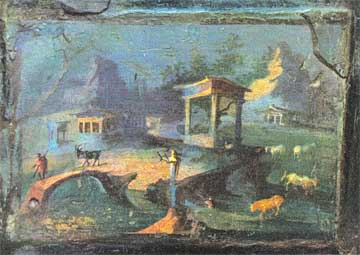 Ειδυλλιακό τοπίο, όπως απεικονίζεται σε τοιχογραφία από την Πομπηία. Εθνικό Μουσείο Νεαπόλεως.
Στο παρόν άρθρο επιχειρείται η ανάδειξη της εξέλιξης της πόλης και της πολεοδομίας στην ελληνιστική εποχή μέσω της συστηματοποίησης των κυριότερων γενεσιουργών παραγόντων των κανόνων πολεοδόμησης. Ειδικότερα εξετάζεται η επίδραση των σημαντικότερων ιστορικών γεγονότων, της κοινωνίας και της οικονομίας, των φιλοσοφικών ρευμάτων, του πολιτικού συστήματος και της τέχνης, κυρίως της αρχιτεκτονικής, στο δομημένο περιβάλλον της ελληνιστικής πόλης. Τέλος επιδιώκεται η ανάδειξη της δυναμικότητας της πόλης και της πολεοδομίας μέσω της αλληλεπίδρασης των ως άνω μεταβλητών παραγόντων.
Ειδυλλιακό τοπίο, όπως απεικονίζεται σε τοιχογραφία από την Πομπηία. Εθνικό Μουσείο Νεαπόλεως.
Στο παρόν άρθρο επιχειρείται η ανάδειξη της εξέλιξης της πόλης και της πολεοδομίας στην ελληνιστική εποχή μέσω της συστηματοποίησης των κυριότερων γενεσιουργών παραγόντων των κανόνων πολεοδόμησης. Ειδικότερα εξετάζεται η επίδραση των σημαντικότερων ιστορικών γεγονότων, της κοινωνίας και της οικονομίας, των φιλοσοφικών ρευμάτων, του πολιτικού συστήματος και της τέχνης, κυρίως της αρχιτεκτονικής, στο δομημένο περιβάλλον της ελληνιστικής πόλης. Τέλος επιδιώκεται η ανάδειξη της δυναμικότητας της πόλης και της πολεοδομίας μέσω της αλληλεπίδρασης των ως άνω μεταβλητών παραγόντων.
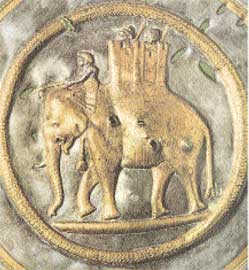 Φάλαρο αλόγου με παράσταση πολεμικού ελέφαντα. Μουσείο Ερμιτάζ, Λένινγκραντ.
Στην αρχαιότητα η χρήση ελεφάντων στη μάχη αποτελούσε κρίσιμο παράγοντα για τη νικηφόρο έκβασή της. Οι πολεμικοί ελέφαντες ήταν ένα απαραίτητο μέσο για κάθε στρατηγό που ήθελε να είναι αποτελεσματικός στην τέχνη του πολέμου και να σημειώνει επιτυχίες.
Η προμήθεια πολεμικών ελεφάντων, ως αναγκαίας προϋπόθεσης κατά το σχεδιασμό και την προετοιμασία της μάχης, καθώς και οι συστηματικά και προσεκτικά διοργανωμένες επιχειρήσεις κυνηγιού, με σκοπό την αιχμαλωσία άγριων ελεφάντων, απορροφούσαν σημαντικά κονδύλια του κρατικού προϋπολογισμού των Πτολεμαίων. Δύο επιγραφές από την πτολεμαϊκή Αίγυπτο, σε συνδυασμό με παπυρικές μαρτυρίες και εξιστορήσεις των συγγραφέων της εποχής, μας παρέχουν πολύτιμες πληροφορίες σχετικά με τις επίσημα οργανωμένες κυνηγετικές αποστολές.
Έως το 1948, επικρατούσε η άποψη ότι η δυναστεία των Πτολεμαίων ενδιαφερόταν να αιχμαλωτίζει αποκλειστικά μεγαλόσωμους αφρικανικούς ελέφαντες, του είδους loxodonta Africana Africana, για τις ανάγκες του αιγυπτιακού στρατού. Ωστόσο, με τη δημοσίευση του άρθρου του William Gowers, αποδείχθηκε ότι επρόκειτο όχι για τους μεγαλόσωμους ελέφαντες της σαβάνας, αλλά για τους πιο μικρόσωμους του αφρικανικού δάσους, που ανήκαν στο είδος loxodonta Africana cyclotis.
Φάλαρο αλόγου με παράσταση πολεμικού ελέφαντα. Μουσείο Ερμιτάζ, Λένινγκραντ.
Στην αρχαιότητα η χρήση ελεφάντων στη μάχη αποτελούσε κρίσιμο παράγοντα για τη νικηφόρο έκβασή της. Οι πολεμικοί ελέφαντες ήταν ένα απαραίτητο μέσο για κάθε στρατηγό που ήθελε να είναι αποτελεσματικός στην τέχνη του πολέμου και να σημειώνει επιτυχίες.
Η προμήθεια πολεμικών ελεφάντων, ως αναγκαίας προϋπόθεσης κατά το σχεδιασμό και την προετοιμασία της μάχης, καθώς και οι συστηματικά και προσεκτικά διοργανωμένες επιχειρήσεις κυνηγιού, με σκοπό την αιχμαλωσία άγριων ελεφάντων, απορροφούσαν σημαντικά κονδύλια του κρατικού προϋπολογισμού των Πτολεμαίων. Δύο επιγραφές από την πτολεμαϊκή Αίγυπτο, σε συνδυασμό με παπυρικές μαρτυρίες και εξιστορήσεις των συγγραφέων της εποχής, μας παρέχουν πολύτιμες πληροφορίες σχετικά με τις επίσημα οργανωμένες κυνηγετικές αποστολές.
Έως το 1948, επικρατούσε η άποψη ότι η δυναστεία των Πτολεμαίων ενδιαφερόταν να αιχμαλωτίζει αποκλειστικά μεγαλόσωμους αφρικανικούς ελέφαντες, του είδους loxodonta Africana Africana, για τις ανάγκες του αιγυπτιακού στρατού. Ωστόσο, με τη δημοσίευση του άρθρου του William Gowers, αποδείχθηκε ότι επρόκειτο όχι για τους μεγαλόσωμους ελέφαντες της σαβάνας, αλλά για τους πιο μικρόσωμους του αφρικανικού δάσους, που ανήκαν στο είδος loxodonta Africana cyclotis.
 Παράδειγμα εφαρμογής της διαδικασίας της "Προσομοίωσης"
Η ψηφιακή κληρονομιά είναι αναπόσπαστο κομμάτι της σύγχρονης ιστορίας μας που θα γίνεται όλο και πιο σημαντικό στο μέλλον. Η διατήρηση της ψηφιακής κληρονομιάς αποτελεί τόσο σημαντικό κλάδο στη συντήρηση όσο και η διατήρηση αρχαιοτήτων ή έργων τέχνης. Το πρόβλημα της διατήρησης της ψηφιακής κληρονομιάς είναι οξύτατο λόγω του όγκου και της ποικιλίας των ψηφιακών αρχείων. Διάφορες μεθοδολογίες για την αντιμετώπιση του προβλήματος έχουν διατυπωθεί με βασικότερη τη μετατροπή (migration). Σε αυτό το άρθρο δίνεται έμφαση στο ρόλο του συντηρητή αρχαιοτήτων και έργων τέχνης στον τομέα αυτό και προτείνεται η άμεση ανάπτυξη εκπαιδευτικής υποδομής.
Παράδειγμα εφαρμογής της διαδικασίας της "Προσομοίωσης"
Η ψηφιακή κληρονομιά είναι αναπόσπαστο κομμάτι της σύγχρονης ιστορίας μας που θα γίνεται όλο και πιο σημαντικό στο μέλλον. Η διατήρηση της ψηφιακής κληρονομιάς αποτελεί τόσο σημαντικό κλάδο στη συντήρηση όσο και η διατήρηση αρχαιοτήτων ή έργων τέχνης. Το πρόβλημα της διατήρησης της ψηφιακής κληρονομιάς είναι οξύτατο λόγω του όγκου και της ποικιλίας των ψηφιακών αρχείων. Διάφορες μεθοδολογίες για την αντιμετώπιση του προβλήματος έχουν διατυπωθεί με βασικότερη τη μετατροπή (migration). Σε αυτό το άρθρο δίνεται έμφαση στο ρόλο του συντηρητή αρχαιοτήτων και έργων τέχνης στον τομέα αυτό και προτείνεται η άμεση ανάπτυξη εκπαιδευτικής υποδομής.
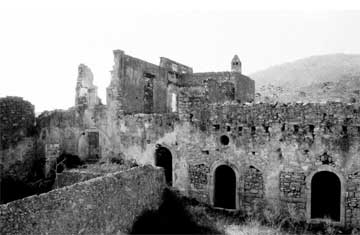 Βίλα Clodio στο Χρωμοναστήρι.
Η οικοδόμηση υπό την καθοδήγηση της παράδοσης παρουσιάζει κατ’ αρχάς ένα περιορισμό στην καλλιτεχνική βούληση και στην ελευθερία της προσωπικής έκφρασης μέσα από την φαντασία, η οποία είναι ήδη εξασθενισμένη από την μειονεκτική θέση που κατέχει η αρχιτεκτονική στο χώρο των τεχνών να εξυπηρετεί πραγματικές λειτουργίες. Μια συνεπής με το νόημα της τέχνης οικοδόμηση θα σήμαινε άρνηση της παράδοσης και περιφρόνησή της. Ωστόσο η έννοια της αλήθειας δεν συγκλίνει με την απόρριψη της παράδοσης αφού αλήθεια σημαίνει μη-λήθη, μη-λησμονιά, θύμηση κι άρα θύμηση της παράδοσης. Επομένως μια αληθινή αρχιτεκτονική που θέτει σε εγρήγορση την μνήμη δεν μπορεί να βρίσκεται σε αντίθετη κατεύθυνση από την αυθεντική τέχνη που επιζητεί την χειραφέτηση από την παράδοση. Στο άρθρο αυτό γίνεται προσπάθεια να επιλυθεί το πρόβλημα μέσα από την γλώσσα με αναφορές στα έργα του M. Heidegger από τα οποία προβάλλει τραγικό, αφού εμφανίζεται μια διαμάχη μεταξύ κατασκευής και καλλιέργειας, σύγχρονης τάσης και πολιτισμού. Παράδοση σημαίνει το δόσιμο, το να παραδίδει κανείς κάτι σε κάποιον κι αυτό είναι αντίθετο με την λήψη ή την παραλαβή με την οποία συγχέεται η έννοια της παράδοσης. Παράδοση είναι αυτό που παραδίδεται χωρίς να έχει ακόμα παρθεί ή χρησιμοποιηθεί. Τούτο σημαίνει στροφή προς μια εγκαταλελειμμένη παράδοση σε αντίθεση με τον εγκλωβισμό μας μέσα στα δύσκαμπτα πλαίσια της σύγχρονης τεχνολογικής κατεύθυνσης που μάς κλείνουν την είσοδό μας σε μια πιο αυθεντική αποκάλυψη μέσω της οποίας θα μπορούσε ο άνθρωπος να βιώσει το κάλεσμα μιας πιο πρωταρχικής αλήθειας.
Βίλα Clodio στο Χρωμοναστήρι.
Η οικοδόμηση υπό την καθοδήγηση της παράδοσης παρουσιάζει κατ’ αρχάς ένα περιορισμό στην καλλιτεχνική βούληση και στην ελευθερία της προσωπικής έκφρασης μέσα από την φαντασία, η οποία είναι ήδη εξασθενισμένη από την μειονεκτική θέση που κατέχει η αρχιτεκτονική στο χώρο των τεχνών να εξυπηρετεί πραγματικές λειτουργίες. Μια συνεπής με το νόημα της τέχνης οικοδόμηση θα σήμαινε άρνηση της παράδοσης και περιφρόνησή της. Ωστόσο η έννοια της αλήθειας δεν συγκλίνει με την απόρριψη της παράδοσης αφού αλήθεια σημαίνει μη-λήθη, μη-λησμονιά, θύμηση κι άρα θύμηση της παράδοσης. Επομένως μια αληθινή αρχιτεκτονική που θέτει σε εγρήγορση την μνήμη δεν μπορεί να βρίσκεται σε αντίθετη κατεύθυνση από την αυθεντική τέχνη που επιζητεί την χειραφέτηση από την παράδοση. Στο άρθρο αυτό γίνεται προσπάθεια να επιλυθεί το πρόβλημα μέσα από την γλώσσα με αναφορές στα έργα του M. Heidegger από τα οποία προβάλλει τραγικό, αφού εμφανίζεται μια διαμάχη μεταξύ κατασκευής και καλλιέργειας, σύγχρονης τάσης και πολιτισμού. Παράδοση σημαίνει το δόσιμο, το να παραδίδει κανείς κάτι σε κάποιον κι αυτό είναι αντίθετο με την λήψη ή την παραλαβή με την οποία συγχέεται η έννοια της παράδοσης. Παράδοση είναι αυτό που παραδίδεται χωρίς να έχει ακόμα παρθεί ή χρησιμοποιηθεί. Τούτο σημαίνει στροφή προς μια εγκαταλελειμμένη παράδοση σε αντίθεση με τον εγκλωβισμό μας μέσα στα δύσκαμπτα πλαίσια της σύγχρονης τεχνολογικής κατεύθυνσης που μάς κλείνουν την είσοδό μας σε μια πιο αυθεντική αποκάλυψη μέσω της οποίας θα μπορούσε ο άνθρωπος να βιώσει το κάλεσμα μιας πιο πρωταρχικής αλήθειας.
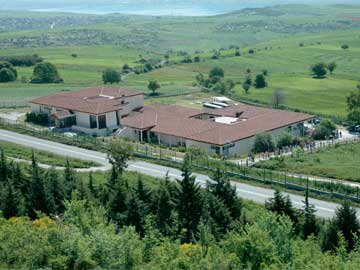 Το Αρχαιολογικό Μουσείο της Αιανής
Η Αιανή, "πόλις Μακεδονίας", σύμφωνα με τον ιδρυτικό μύθο που διέσωσε ο Στέφανος Βυζάντιος, κτίστηκε από τον Αιανό, γιο του βασιλιά Ελύμου. Ήταν πρωτεύουσα του βασιλείου της Ελιμιώτιδας, το οποίο με τα υπόλοιπα ελληνικά βασίλεια (Ορεστίδας, Εορδαίας, Τυμφαίας, Λυγκηστίδας, Πελαγονίας, Δερριόπου) αποτελούσαν την Άνω Μακεδονία των αρχαίων.
Η συστηματική ανασκαφική έρευνα στους αρχαιολογικούς χώρους της Αιανής και γενικότερα η φροντίδα για όλο τον Νομό Κοζάνης άρχισε το 1983 και συνεχίζεται χωρίς διακοπή. Ο αρχαιολογικός πλούτος της Αιανής επέβαλε την ίδρυση ενός μεγάλου και σύγχρονου Αρχαιολογικού Μουσείου. Το Μουσείο θεμελιώθηκε το 1992 και ολοκληρώθηκε τον Ιούλιο του 2002. Φιλοξενεί τις προϊστορικές και τις κλασικές αρχαιότητες της Αιανής και της ευρύτερης περιοχής, καθώς και τα χιλιάδες ευρήματα, που προήλθαν από τις σωστικές ανασκαφές της κατασκευής του εθνικού και επαρχιακού οδικού δικτύου.
O εκθεσιακός χώρος του Μουσείου της Αιανής περιλαμβάνει προθάλαμο με πωλητήριο, βεστιάριο και έξι αίθουσες για την έκθεση ευρημάτων από την αρχαία Αιανή και ελάχιστα από τον περίγυρό της, ενώ η έβδομη μικρή αίθουσα προορίζεται για περιοδικές εκθέσεις ευρημάτων από τον Νομό Κοζάνης. Η έκθεση, οργανωμένη χρονολογικά και θεματικά, παρουσιάζει τρεις παράλληλους άξονες:
- Την ιστορική εξέλιξη της αρχαίας Αιανής, πρωτεύουσας της Ελιμιώτιδας, ενός βασιλείου από τα ισχυρότερα της Άνω Μακεδονίας, και της ευρύτερης περιοχής, από τα προϊστορικά μέχρι και τα ρωμαϊκά χρόνια.
- Τις ενότητες των ευρημάτων που ήρθαν στο φως στους διάφορους τομείς της συστηματικής ανασκαφής (πόλη, νεκροταφεία, χώρα) αλλά και τα σύνολα που προέρχονται από σωστικές ανασκαφές.
- Την καθημερινή ζωή και τους θεσμούς στην αρχαιότητα, όπως προβάλλονται μέσα από τα αρχαιολογικά ευρήματα.
Το Αρχαιολογικό Μουσείο της Αιανής
Η Αιανή, "πόλις Μακεδονίας", σύμφωνα με τον ιδρυτικό μύθο που διέσωσε ο Στέφανος Βυζάντιος, κτίστηκε από τον Αιανό, γιο του βασιλιά Ελύμου. Ήταν πρωτεύουσα του βασιλείου της Ελιμιώτιδας, το οποίο με τα υπόλοιπα ελληνικά βασίλεια (Ορεστίδας, Εορδαίας, Τυμφαίας, Λυγκηστίδας, Πελαγονίας, Δερριόπου) αποτελούσαν την Άνω Μακεδονία των αρχαίων.
Η συστηματική ανασκαφική έρευνα στους αρχαιολογικούς χώρους της Αιανής και γενικότερα η φροντίδα για όλο τον Νομό Κοζάνης άρχισε το 1983 και συνεχίζεται χωρίς διακοπή. Ο αρχαιολογικός πλούτος της Αιανής επέβαλε την ίδρυση ενός μεγάλου και σύγχρονου Αρχαιολογικού Μουσείου. Το Μουσείο θεμελιώθηκε το 1992 και ολοκληρώθηκε τον Ιούλιο του 2002. Φιλοξενεί τις προϊστορικές και τις κλασικές αρχαιότητες της Αιανής και της ευρύτερης περιοχής, καθώς και τα χιλιάδες ευρήματα, που προήλθαν από τις σωστικές ανασκαφές της κατασκευής του εθνικού και επαρχιακού οδικού δικτύου.
O εκθεσιακός χώρος του Μουσείου της Αιανής περιλαμβάνει προθάλαμο με πωλητήριο, βεστιάριο και έξι αίθουσες για την έκθεση ευρημάτων από την αρχαία Αιανή και ελάχιστα από τον περίγυρό της, ενώ η έβδομη μικρή αίθουσα προορίζεται για περιοδικές εκθέσεις ευρημάτων από τον Νομό Κοζάνης. Η έκθεση, οργανωμένη χρονολογικά και θεματικά, παρουσιάζει τρεις παράλληλους άξονες:
- Την ιστορική εξέλιξη της αρχαίας Αιανής, πρωτεύουσας της Ελιμιώτιδας, ενός βασιλείου από τα ισχυρότερα της Άνω Μακεδονίας, και της ευρύτερης περιοχής, από τα προϊστορικά μέχρι και τα ρωμαϊκά χρόνια.
- Τις ενότητες των ευρημάτων που ήρθαν στο φως στους διάφορους τομείς της συστηματικής ανασκαφής (πόλη, νεκροταφεία, χώρα) αλλά και τα σύνολα που προέρχονται από σωστικές ανασκαφές.
- Την καθημερινή ζωή και τους θεσμούς στην αρχαιότητα, όπως προβάλλονται μέσα από τα αρχαιολογικά ευρήματα.
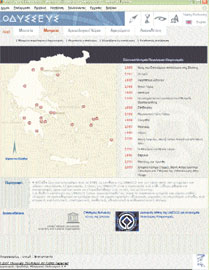 Η σελίδα παρουσίασης των ελληνικών μνημείων παγκόσμιας πολιτιστικής κληρονομιάς.
Στην καινούργια έκδοση του Οδυσσέα, νέα εργαλεία πρόσβασης, όπως ο Πολιτιστικός χάρτης της Ελλάδας, το Χρονολόγιο, το Φωτογραφικό αρχείο, και ένα ειδικό βοήθημα, το Γλωσσάρι, αποτελούν ανεξάρτητες διαδραστικές εφαρμογές.
Παρέχεται επίσης απλή αναζήτηση με ελεύθερο κείμενο και γενική αναλυτική αναζήτηση σε όλες σχεδόν τις κατηγορίες περιεχομένου του ιστότοπου (Μουσεία, Μνημεία, Αρχαιολογικούς χώρους, Εκθέσεις, Εκθέματα, Γλωσσάρι, Όλα, γεωγραφικό διαμέρισμα και «λέξεις κλειδιά»).
Η σελίδα παρουσίασης των ελληνικών μνημείων παγκόσμιας πολιτιστικής κληρονομιάς.
Στην καινούργια έκδοση του Οδυσσέα, νέα εργαλεία πρόσβασης, όπως ο Πολιτιστικός χάρτης της Ελλάδας, το Χρονολόγιο, το Φωτογραφικό αρχείο, και ένα ειδικό βοήθημα, το Γλωσσάρι, αποτελούν ανεξάρτητες διαδραστικές εφαρμογές.
Παρέχεται επίσης απλή αναζήτηση με ελεύθερο κείμενο και γενική αναλυτική αναζήτηση σε όλες σχεδόν τις κατηγορίες περιεχομένου του ιστότοπου (Μουσεία, Μνημεία, Αρχαιολογικούς χώρους, Εκθέσεις, Εκθέματα, Γλωσσάρι, Όλα, γεωγραφικό διαμέρισμα και «λέξεις κλειδιά»).
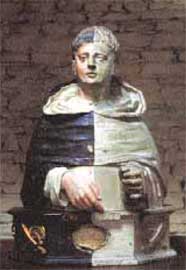 Αφαίρεση λευκού στρώματος του 18ου αι. από το ξύλινο άγαλμα του Αγίου Θωμά του 17ου αι.
Ειδήσεις: Λεοπάρδαλη στη Νεμέα, Νέα ερμηνεία για τα κείμενα του Κουμράν, Ωδείο Νικοπόλεως, Οικία Βενιζέλου, Μουσείο πλινθοκεραμοποιίας, Πολιτιστική Εγνατία, Ελληνικό Κέντρο Βραχογραφίας.
Εκθέσεις: Παλαιές φωτογραφίες αρχαιολογικών χώρων, Τα σπήλαια της Αίτνας.
Συνέδρια: Δ‘ Διεθνές Κυπρολογικό Συνέδριο, Ανασκαφή και Έρευνα VI, Η διδασκαλία της Ιστορίας.
Διαλέξεις: Χειροποίητη κεραμική στην προϊστορική Ελλάδα, Η μαρτυρία των νομισμάτων, Τα σπήλαια της Μάνης.
Βιβλία: Το Μουσείο και οι πρόδρομοί του, Eilean Hooper-Greenhill, Η ανάδυση του πολιτισμού. Οι Κυκλάδες και το Αιγαίο στην 3η χιλιετία π.Χ., Colin Renfrew, Η έξαρση της Δημοκρατίας στην αρχαία Αθήνα, Jacqueline de Romilly.
Αφαίρεση λευκού στρώματος του 18ου αι. από το ξύλινο άγαλμα του Αγίου Θωμά του 17ου αι.
Ειδήσεις: Λεοπάρδαλη στη Νεμέα, Νέα ερμηνεία για τα κείμενα του Κουμράν, Ωδείο Νικοπόλεως, Οικία Βενιζέλου, Μουσείο πλινθοκεραμοποιίας, Πολιτιστική Εγνατία, Ελληνικό Κέντρο Βραχογραφίας.
Εκθέσεις: Παλαιές φωτογραφίες αρχαιολογικών χώρων, Τα σπήλαια της Αίτνας.
Συνέδρια: Δ‘ Διεθνές Κυπρολογικό Συνέδριο, Ανασκαφή και Έρευνα VI, Η διδασκαλία της Ιστορίας.
Διαλέξεις: Χειροποίητη κεραμική στην προϊστορική Ελλάδα, Η μαρτυρία των νομισμάτων, Τα σπήλαια της Μάνης.
Βιβλία: Το Μουσείο και οι πρόδρομοί του, Eilean Hooper-Greenhill, Η ανάδυση του πολιτισμού. Οι Κυκλάδες και το Αιγαίο στην 3η χιλιετία π.Χ., Colin Renfrew, Η έξαρση της Δημοκρατίας στην αρχαία Αθήνα, Jacqueline de Romilly.
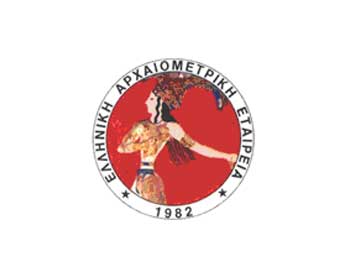 Το λογότυπο της Ελληνικής Αρχαιομετρικής Εταιρείας
Στα Αρχαιομετρικά Νέα αυτού του τεύχους μπορείτε να διαβάσετε:
Η ημερίδα της Ελληνικής Αρχαιομετρικής Εταιρείας στο ΥΠΠΟ, Νέες Μελέτες για την προϊστορική ηφαιστειακή έκρηξη στη Θήρα, Έκδοση μονογραφίας για το Χρυσοκάμινο Αν. Κρήτης, Το Αρχαιολογικό Έργο στη Μακεδονία και Θράκη (Κ‘ ΑΕΜΘ).
Το λογότυπο της Ελληνικής Αρχαιομετρικής Εταιρείας
Στα Αρχαιομετρικά Νέα αυτού του τεύχους μπορείτε να διαβάσετε:
Η ημερίδα της Ελληνικής Αρχαιομετρικής Εταιρείας στο ΥΠΠΟ, Νέες Μελέτες για την προϊστορική ηφαιστειακή έκρηξη στη Θήρα, Έκδοση μονογραφίας για το Χρυσοκάμινο Αν. Κρήτης, Το Αρχαιολογικό Έργο στη Μακεδονία και Θράκη (Κ‘ ΑΕΜΘ).
 Journal of Mediterranean Archaeology, λογότυπο
Η στήλη του JMA παρουσιάζει το άρθρο του S. Nanoglou, "Regional Perspectives on the Neolithic Anthropomorphic Imagery of Northern Greece".
Journal of Mediterranean Archaeology, λογότυπο
Η στήλη του JMA παρουσιάζει το άρθρο του S. Nanoglou, "Regional Perspectives on the Neolithic Anthropomorphic Imagery of Northern Greece".
Official medicine in the Byzantine era creates compendiums- encyclopedias in order to record existing knowledge: Paul Aeginetes, Dioskourides, Myrepsos, Oreivasios. Laboratory methods used for medical purposes, accomplish an important scientific feat through the development of uroscopy which is utilized for diagnostic purposes. (Theophilos, Ioannes Actuarius). The progress of these methods, directly depends on the implementation of these discoveries on a greater part of the population in a clinical setup, namely in monastery-hospices gradually turned into hospitals. Nonetheless, the Byzantines have a hazy perception of the symbolic division between the natural and the supernatural or magic. Miracles did not have specific boundaries. Popular medicine turned to healer saints and their miraculous icons. The Lives of woman healer saints reveal the ambivalence of a culture divided between The Virgin Mary and Eve. Maria/Marinos, who had the divine gift of healing the possessed, had first to dress up himself/herself as a monk and live in a monastery. Daemonic possession which seized women who then displayed an unbridled sexual passion, was cured by the intervention of healer saints. Byzantine hagiography is full of contests between saints and sorcerers. It is worth noting that the evil eye is held responsible for illnesses. In the Byzantine court of the 12th and 13th century, there are many well documented accusations of sorcery causing illness and death. The Church was uncomfortable in condemning “the proof” of magic and sorcery. It is obvious to what degree “popular” beliefs infiltrated all levels of an officially orthodox society.
Every Byzantine town had its own hospital where the sick and invalid citizens could find cure and comfort. Men, women and children could be hospitalized there free of charge or for a small fee, depending on the gravity of malady, duration of stay, treatment required and the regulations of the institution. The best Byzantine hospitals were located in the important economic, political and ecclesiastical centers of the Empire. However, small units of medical care also existed in the monasteries scattered in remote areas of the state. In these rudimentary, compared to the modern, hospitals official medicine was practiced and a variety of diseases was treated. The inmates of the Byzantine hospitals soon after being cured could return to their families and resume their activities.
The doctrine of the Church Fathers during the early centuries of the Empire infused a new, Christian concept into the Hellenistic and Roman tradition of philanthropy. Foundations functioning under the supervision of the Church and monasteries as well as various charities could efficiently meet the needs of those citizens who were sick, incurable or in great need. Judging from fragmentary literary sources of the late fourth century, it is concluded that at least in Constantinople there was a number of nursing units, staffed with specialized personnel. The cooperation of the Patriarchate of Constantinople with the imperial court was particularly realized in the important medical institutions of the sixth and seventh centuries, which could provide specialized treatment and health services. In spite of the reproach of the hagiographical texts as regards the effectiveness of medicine and the perpetual distrust of the aristocracy for establishments of mass hospitalization and cure, the foundation in the twelfth century of the Pantocrator Hospital testifies both the high standards of planning and function of medical institutions and the social upgrading of the medical profession.
The medical practice in treating children’s health in Byzantium is dictated by the perceptions of society for the child and his care. With the exception of Developmental Paediatrics issues, such as the neonatal care of the new-born, breastfeeding and healthy diet that comprise an autonomous unity in the Medical Literature of Byzantium, the variety of childhood morbidity is scattered in the chapters referring to the relevant health disorders of the grown-ups. The historical, literary and hagiological sources not only indicate that specialization in Paediatrics did not exist, but also reveal the vital role that Church and State have played through charitable institutions, miraculous healing and protective legislation for the preservation and cure of children’s health. Based on medical, historical, theological and legal texts, this article presents a concise recording of the position of the under age members of the Byzantine family and its environment and refers to the infantile medicine, the nosology of child, the hygienic commandments for life, the activity of healer saints as well as the factors affecting the social health of children, such as violence, oppression, school and sexual maltreatment.
Besides chronography, history and medical treatises, the hagiographical texts and particularly the part of Vitae referring to the miracles performed by saints, while in life or after death, have become an important source of information, on the diseases of the female population in Byzantium, the therapeutic means available and the way they were treated by their contemporaries. A large percentage of the miracles have to do with the healing of women suffering from incurable or toilsome diseases that could push them to the social margin or lead them to death. These were either illnesses affecting the entire population (cancer, dermatological and ophthalmological disorders, paralysis of the upper or lower limbs, headaches) or exclusively gynaecological maladies such as the bleeding of genitals. Furthermore, the Byzantines have described a great number of psychic or cerebral disorders, such as epilepsy, tetraplegia and mania fit as seizures of demonic powers. The female patients, particularly those who did not belong to wealthy families, could rarely visit a physician or take advantage of the potentialities of the Byzantine medical science, living almost as social outcasts. The miracles of saints, apart from proving the divine properties of their performers, were aiming to affect the society positively in order to welcome the invalid or handicapped women, especially after their full recovery.
This article is a version of an earlier monograph entitled “The Byzantine Woman in the Hagiological Texts and the Penal Law of the Orthodox Church”, in which we tried to trace the social gender of women in Byzantium on the basis of the Vitae of various female saints who lived from the fourth to the ninth century; and also to find out how the social gender is defined according to the interpretation of the myths of Fall and Resurrection, which govern the value system of the Byzantine society along with the historical facts conditioning every narrative and the enactment of social roles in the Penal Law of the Orthodox Church. The critical analysis and processing of Vitae proved the various interpretations of the myths, depending on the period, its historical facts and ideological-theological framework, and the lived experience of the anonymous or eponymous authors. The guilt of woman due to her mutable “by nature” gender in the social and natural being is stressed in most accounts, a guilt already established by the myth of Fall. However, in the years following Iconomachy the guilt of man, due to his impetus “by nature”, is emphasized as the major component of the social gender, and thus the woman, becoming innocent, is identified with the Mother of God or the angelic model. In the present article we will try to elucidate this shift by analyzing the Vita of saint Irene Chrysovalandou, in which the woman is not described as guilty but as healer of the social evil and of the souls responsible for it. The physical disorder and cure are not only beyond the interests of the author of the hagiological text but they are conceived absolutely differently.
A well established institution in antiquity, incubation, involves evoking a curative dream by sleeping on sacred ground, after following specific purification rituals. Christianity embraced it and adapted it to fit its own purposes, employing a ritual deceptively similar to that of pagan sanctuaries. Christian incubation represents a form of secular religiosity, whose aims and principles are removed from those of asceticism. In spite of the supposed shift of Christian spirituality away from the body-centred culture of antiquity towards an ascetic hostility to the body, incubation is predominantly concerned with the body, not the spirit. It caters for its supplicants’ earthly existence, not their lives after death. While ascetics appear ashamed to have bodies―and even tend to regard disease as a divine gift that spares them the effort of mortifying their bodiesn themselves―incubation patients appear to value their bodies and to be ashamed of their deformities or diseases. The article concentrates on The Miracles of St. Artemios, a text which records 45 cures, which took place an incubation centre in seventh-century Constantinople. The saint’s specialisation in curing scrotal hernia and disorders of the male genitals makes this text a rare and unexplored source of information on subjects such as attitudes towards the body, masculinity, castration. For the Saint’s predominantly male secular client le, disease, deformity or mutilation of the genitals is a clear source of embarrassment, shame and fear ―fear of losing their masculine identity, on which the text masterfully plays. Aversion to surgery and hostility to doctors, is brilliantly portrayed in the miracle narratives―sometimes through the description of vivid dreams. Again, it reflects, for the most part, fear of losing their masculinity, through castration―which was often the outcome of hernia surgery at the time. Resort to the incubation centre of Artemios offers to hernia patients a safe ground where they can find refuge from social hostility and stigmatization. They become members of a sheltered group of fellow sufferers, where they can openly discuss their problems and fears, or even compare the magnitude of their ailments. Acquainting themselves with past miracle accounts, they gradually prepare for the long awaited cure, rediscovering hope of rehabilitation.
The debate of the Christian community about medical science is recorded in the saints Vitae of the seventh century, a particularly transitional period. These texts present the perceptions for the prevailing therapeutical models and for the proposed solutions for charities both in the Byzantine provinces and in the major cities of the empire. The incapability of the pagan medical science, exercised by various Hellenizer and Jewish profiteers in the imperial and aristocratic cycles, is stressed in many of the Vitae miracles. The repeatedly mentioned inefficiency of Hippocrates, Galen, Democritus and their contemporary hiatrosophists, compared to the effective activity of saints, is very often documented by the narrated incidents. Thus Christianity not only disputes medical science and therapeutic folk practices, but also sheds whatever considers conflicting with its interests, either as a doctrine or as a way and organization of life. The battle against magicians, charmers, hiatrosophists, pagan healers is preserved to a certain extend by the stately expression of Christian philanthropy. Therefore, it is not the physician who is disputed, but his incorporation in social groups that serve or apply unacceptable or competitive religious or therapeutic techniques. Church is the leader in claiming the management of medicine and healing and demonizes or humiliates whoever physician is not Christian. The humiliation of Late Antiquity physicians who are hardly needed corresponds to the presents situation, when the therapeutic need, despair, financial and social status, education and religious faith and mainly the conflicting interests of physicians and patients lead constantly to their mutual alienation.
In the summer of 1998 I undertook the task of restoring a litanic icon of the Virgin Hodegetria (140x80 cm) from the church of Hagios Nikolaos in Arta. It bore a representation of the Virgin and Child, painted on walnut wood with oil colors, and was dated from the first half of the twentieth century. The restoration process revealed an earlier layer of painting of the same subject that can be dated from the end of the seventeenth century. However, the most interesting find was another representation of the Virgin Hodegetria, which was concealed under the thick brown oil overpaint of the reverse and could be probably attributed to the fourteenth century. Thus, the icon proved to be two-sided with the Mother and Child subject decorating both sides. a. Front side: We X-rayed the faces of the twentieth-century Mother and Child, and, estimating the extension and condition of the earlier layer of painting, we removed the later representation. The icon thus revealed, although bears the inscription Hodegetria, belongs to the iconographic type of the Virgin Madre della Consolazione and on stylistic grounds can be dated at the end of the seventeenth century. b. Back side: The thick brown oil overpaint and the layer of varnish underneath were carefully removed and an earlier representation of the Virgin Hodegetria emerged. It is masterfully painted with egg-tempera on linen and gesso and skillfully gilded with gold; its varnish has obtained a reddish shade due to oxidation. The stylistic similarity of the representation to religious paintings from the workshops of Thessaloniki leads us to date the Virgin Hodegetria icon from the first half of the fourteenth century and to attribute it to the artistic environment of the capital of Northern Greece.
The history of the city of Lefkada, the capital of the insular complex that constitutes the homonymous county, although goes back to the medieval age, is even today barely known and even less documented. The historic structure of its urban web and the physiognomy of its houses have also been studied inadequately. For this reason every damage of its densely built historic center destroys elements of its past and history and turns out to be fatal for the documentation of the evolution of the only preserved suburb, from the originally three, of the medieval capital of the island. The rapidly developing building activity and the replacement of the traditional by modern building materials has unfortunately dishonoured the historic identity of the characteristic anti-seismic architecture and the urban profile of the city and has reversed the balance between authentic and false architectural work at the expense of the former.
The provenance of the gold of the Byzantine Empire is still considered a difficult archaeological issue in its investigation. One of the regions that probably contributed to the creation of the store of state gold is Macedonia and its rich deposits. Mining of gold was held in parallel with mining and manufacturing of iron in some metallurgic centers, such as Aghistro and Makrychori, between the thirteenth and sixteenth century AD. The study of the remnants of metallurgy from four relevant locations suggests that two of them showed a small-scale activity, whereas the other two had a large-scale production. The technological complexity of the Byzantine world is evaluated through the thorough research on the overall organization of the production process, which aimed at the better exploitation of raw materials.
The history of devotional icons in the Ionian islands during the second half of the seventeenth and throughout the eighteenth century is marked by a gradual departure from Byzantine traditions. The painters of the Heptanesian school will finally abandon post-Byzantine styles as a whole in favour of the oil-paint technique and naturalism. In order to examine the evolution from devotional icon to panel painting, this article focuses on iconostasis closure panels (thorakia) from Zakynthos – reproducing en masse western engravings – and ex-votos, two representative categories of religious artwork, pertaining to the public and private worship respectively. By contrast to the austere character of the traditional iconostasis, the closure panels of Zakynthos exhibit a rich iconographic repertoire which reflects a new system of values. At the same time, ex-votos include now features from the commissioner’s environment, quite often rendered in naturalistic precision. Following the Ottoman conquest of Crete, Greek-speaking populations in the Ionian islands ceased to be self-defined in juxtaposition to the Venetians – as was largely the case in Crete – or on the basis of a common religious dogma. A new bourgeois class was emerging, which considered Venice and its public image as a major model, independently of the ethnic origin or the religious beliefs of its members. The consequences of such changes were immediately felt in aesthetics and art; as a result, bourgeois soon turned to naturalism in order to express their religious feelings.
The sanctuary of Hippolytus at Troizena, directly connected with the mythical love of Phaedra for Hippolytus, lies in an idyllic environment about 170 kilometers away from Athens and in a short distance from Epidaurus. In spite of its significance, it remains unknown to the broad public. The enclosure and buildings of the sanctuary were erected outside the walls of ancient Troizena in the late fourth or early third century BC around an earlier nucleus of worship, which is located in the area of the small shrine of the Geometric period. Although the existence and function of an Asclepieion in the sanctuary is ascertained by relevant inscriptions, it seems that the celebrated Asclepieion of Epidaurus outshone it, therefore it remained rather obscure. The earthquake caused by the eruption of the Methana volcano in the mid-third century BC obviously contributed to the decline of the Troizena Asclepieion: its buildings suffered serious damages and remained in ruins until the Roman age, when they were restored. After the prevalence of Christianity the ancient building material was removed from the original structures and was used for the erection of Christian churches such as Episkopi. It should be noted that the removal and reuse of ancient building material has been continued until the recent decades. Some of the ancient monuments face today certain solidity and static problems due to the inherited weakness of the building material (limestone) and the reactive thrusts of the ground. The archaeological site remains undefined by enclosure, it lacks informational plates in front of the buildings and does not provide the necessary facilities for the few, for the time being, visitors.
In this article we focus on the evolution of the city and city planning in the Hellenistic era through the systematization of the major factors that have generate the urban rules. Therefore, we examine the effect of important historic, social and economical events, philosophical currents, political systems and arts, in particular architecture, on the built environment of the Hellenistic city. Thus, we attempt to exhalt the dynamic character of both the city and city planning through the mutual influence of the above variables.
In antiquity the use of elephants in battle was a crucial factor for victory. War elephants were a necessary weapon to every general who wanted to be successful and effective in the art of war. The provision of war elephants, an essential prerequisite of war planning and preparation, demanded significant sums of money from the Ptolemaic state treasury, as well as carefully and thoroughly planned expeditions or “hunts” in order wild elephants to be captured and kept in captivity. Two important inscriptions from the Ptolemaic Egypt, combined with accounts from papyri and descriptions from contemporary authors, provide valuable information on the officially organized hunting expeditions. Until 1948 it was commonly accepted among scholars that the Ptolemaic dynasty was interested in capturing specifically the large African elephant, the loxodonta Africana Africana, for the needs of the Egyptian army. It was then that William Gowers proved that this warfare animal was not the large but the smaller elephant of the African forest who belonged to a different species, the loxodonta Africana cyclotis.
By the term “digital heritage” we mean the entire information that is created or/and saved in digital files through computer software. Digital heritage is an indispensable part of our modern history and will become increasingly important in the future. The preservation of digital heritage is as important as the preservation of antiquities or works of art. The problem of preserving digital heritage data is a difficult one due to the huge volume and diversity of digital files. Although various methodologies have been proposed for its solution, with migration being a common one, these proposals do not always follow careful ethical consideration. Conservators can contribute to the preservation of digital heritage as the conservation profession has long adopted strong ethical principles for museum objects which can be applied to “digital objects” as well. The role of the conservator in digital preservation is emphasized in this article alongside the urgent need for establishment of relevant educational prerequisites.
Building according to tradition sets in principle a limitation to the artistic will and free expression, already enfeebled by the disadvantageous position of architecture to serve real functions in the field of arts. Building in consistency with the meaning of art would lead to the denial and disregard of tradition. However, truth does not reject tradition, since truth means rememberance, therefore preservation of the tradition. Thus, a true architecture energizing the alertness of memory cannot oppose the authentic art that seeks emancipation from tradition. In this article we try to solve this problem by interpreting M. Heidegger’s works in which the controvercy between modern tendencies and cultural heritage is clearly exhibited. Tradition means to give, to deliver something to someone and this is in principle adverse to the notion of receipt, which has been confused with the meaning of tradition. We should turn to tradition and leave behind the inflexible frame of modern technology that detter us from the authentic revelation through which man could experience fundamental truth.
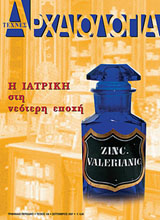
 Αίθουσα αναμονής του γενικού Νοσοκομείου Αθηνών (1906)
Η Ελλάδα, μετά τη θαυμαστή συμβολή του αρχαίου ελληνικού κόσμου και του Βυζαντίου στην ιστορία της δυτικής ιατρικής, βρέθηκε να διαδραματίζει περισσότερο το ρόλο του αποδέκτη παρά του δημιουργού της επιστημονικής καινοτομίας. Τα έργα του Βεσάλιου, του Παράκελσου και του Χάρβεϊ, καθώς και άλλων ηρώων μιας αναδυόμενης θετικιστικής επιστήμης στην περίοδο από τα τέλη του 1500 έως το 1700, έθεσαν τα θεμέλια για τον ευρωπαϊκό "ιατρικό διαφωτισμό" του 18ου αιώνα.
Αίθουσα αναμονής του γενικού Νοσοκομείου Αθηνών (1906)
Η Ελλάδα, μετά τη θαυμαστή συμβολή του αρχαίου ελληνικού κόσμου και του Βυζαντίου στην ιστορία της δυτικής ιατρικής, βρέθηκε να διαδραματίζει περισσότερο το ρόλο του αποδέκτη παρά του δημιουργού της επιστημονικής καινοτομίας. Τα έργα του Βεσάλιου, του Παράκελσου και του Χάρβεϊ, καθώς και άλλων ηρώων μιας αναδυόμενης θετικιστικής επιστήμης στην περίοδο από τα τέλη του 1500 έως το 1700, έθεσαν τα θεμέλια για τον ευρωπαϊκό "ιατρικό διαφωτισμό" του 18ου αιώνα.
 Εμβολιασμός παιδιού στις αρχές του προηγούμενου αιώνα
Σκοπός της μελέτης μας είναι η παρουσίαση της γεωγραφικής και δημογραφικής κατανομής του ιατρικού και παραϊατρικού προσωπικού στην Ελλάδα κατά την περίοδο του Μεσοπολέμου, μέσω στατιστικής επεξεργασίας των αριθμητικών δεδομένων που προκύπτουν μέσα από πηγές της εποχής (κυρίως ιατρικούς καταλόγους).
Κύριο αντικείμενο της μελέτης μας είναι η αποδελτίωση, η στατιστική επεξεργασία, η παρουσίαση και ο σχολιασμός επί των δεδομένων που προκύπτουν, του Ιατρικού Οδηγού της Ελλάδος, που κατήρτησαν οι εκδότες Ασσαέλ και Μάτσας το 1926. Από την παρουσίαση αυτή και την επεξεργασία του υλικού προκύπτουν ποικίλα συμπεράσματα τόσο για τη χωροταξική κατανομή των ιατρικών ειδικοτήτων και γενικά για τη διάρθρωση του συστήματος υγείας της χώρας εκείνη την εποχή στον ελλαδικό χώρο (ανά Περιφέρεια, Νομό και Πόλη), όσο και για την αντίστοιχη δημογραφική εικόνα της χώρας, αφού η διασπορά του ιατρικού δυναμικού στον γεωγραφικό χώρο αντιστοιχεί –ή τουλάχιστον αναμένεται να συμβαίνει αυτό– στις πληθυσμιακές ανάγκες της χώρας. Παράλληλα, από τη στατιστική επεξεργασία του υλικού μας συνάγονται συμπεράσματα για τις ανάγκες περίθαλψης εκείνη την εποχή, μέσω παρατηρήσεων σχετικά με τον αριθμό ορισμένων ειδικοτήτων ή/και ειδικότερα την αυξημένη ή μη συγκέντρωσή τους σε ορισμένες περιοχές ή την έλλειψή τους σε άλλες, σε συνδυασμό με την καταγραφή νοσοκομείων, κλινικών και γενικά ιδρυμάτων νοσηλείας στις ίδιες περιοχές αναφοράς.
Στη μελέτη μας ενσωματώνονται ορισμένα αντιπροσωπευτικά –ως προς τους αριθμούς– διαγράμματα, προκειμένου να αποδοθεί μια ανάγλυφη εικόνα της γεωγραφικής δημογραφικής κατανομής του ιατρικού και παραϊατρικού προσωπικού και των ιδρυμάτων νοσηλείας της εποχής του Μεσοπολέμου.
Εμβολιασμός παιδιού στις αρχές του προηγούμενου αιώνα
Σκοπός της μελέτης μας είναι η παρουσίαση της γεωγραφικής και δημογραφικής κατανομής του ιατρικού και παραϊατρικού προσωπικού στην Ελλάδα κατά την περίοδο του Μεσοπολέμου, μέσω στατιστικής επεξεργασίας των αριθμητικών δεδομένων που προκύπτουν μέσα από πηγές της εποχής (κυρίως ιατρικούς καταλόγους).
Κύριο αντικείμενο της μελέτης μας είναι η αποδελτίωση, η στατιστική επεξεργασία, η παρουσίαση και ο σχολιασμός επί των δεδομένων που προκύπτουν, του Ιατρικού Οδηγού της Ελλάδος, που κατήρτησαν οι εκδότες Ασσαέλ και Μάτσας το 1926. Από την παρουσίαση αυτή και την επεξεργασία του υλικού προκύπτουν ποικίλα συμπεράσματα τόσο για τη χωροταξική κατανομή των ιατρικών ειδικοτήτων και γενικά για τη διάρθρωση του συστήματος υγείας της χώρας εκείνη την εποχή στον ελλαδικό χώρο (ανά Περιφέρεια, Νομό και Πόλη), όσο και για την αντίστοιχη δημογραφική εικόνα της χώρας, αφού η διασπορά του ιατρικού δυναμικού στον γεωγραφικό χώρο αντιστοιχεί –ή τουλάχιστον αναμένεται να συμβαίνει αυτό– στις πληθυσμιακές ανάγκες της χώρας. Παράλληλα, από τη στατιστική επεξεργασία του υλικού μας συνάγονται συμπεράσματα για τις ανάγκες περίθαλψης εκείνη την εποχή, μέσω παρατηρήσεων σχετικά με τον αριθμό ορισμένων ειδικοτήτων ή/και ειδικότερα την αυξημένη ή μη συγκέντρωσή τους σε ορισμένες περιοχές ή την έλλειψή τους σε άλλες, σε συνδυασμό με την καταγραφή νοσοκομείων, κλινικών και γενικά ιδρυμάτων νοσηλείας στις ίδιες περιοχές αναφοράς.
Στη μελέτη μας ενσωματώνονται ορισμένα αντιπροσωπευτικά –ως προς τους αριθμούς– διαγράμματα, προκειμένου να αποδοθεί μια ανάγλυφη εικόνα της γεωγραφικής δημογραφικής κατανομής του ιατρικού και παραϊατρικού προσωπικού και των ιδρυμάτων νοσηλείας της εποχής του Μεσοπολέμου.
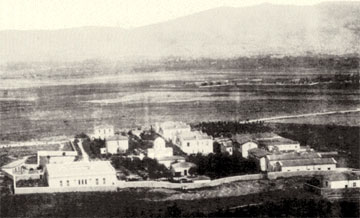 Γενική άποψη του Δρομοκαϊτειου Φρενοκομείου στις αρχές του 20ού αιώνα
Στις αρχές του 19ου αιώνα, η συνήθης αντιμετώπιση όσων θεωρούνταν ότι έπασχαν από ψυχικό νόσημα ήταν η παραμονή τους στο οικογενειακό περιβάλλον, ο εγκλεισμός σε μοναστήρια ή σε νοσοκομεία των κοινοτήτων. Μετά την ίδρυση του ελληνικού κράτους, η συζήτηση γύρω από την αντιμετώπιση των φρενοβλαβών οδήγησε στην ψήφιση του πρώτου σχετικού νόμου, το 1862, για την ίδρυση κρατικού φρενοκομείου, όπου υπήρξε και η πρώτη στατιστική για τους ψυχικά ασθενείς στη χώρα. Παρά το νόμο, δεν υπήρξε καμιά δημόσια πρωτοβουλία, ενώ η ενσωμάτωση των Ιονίων νήσων (1864) πρόσφερε στη δημόσια υγεία δύο φρενοκομεία, της Κέρκυρας και της Κεφαλονιάς, τα οποία είχαν ιδρυθεί τη δεκαετία του 1840.
Το 1880, ο χιώτης έμπορος Ζώρζης Δρομοκαΐτης κληροδότησε ένα σημαντικό ποσό για την ίδρυση φρενοκομείου στην Αθήνα. Η νέα πρόταση που έφερε το Δρομοκαΐτειο, εκείνη του εγκλεισμού και της επιστημονικής νοσηλείας των φρενοβλαβών, έγινε δεκτή με δυσπιστία, λόγω των ισχυρών προϋπαρχόντων αντιλήψεων και λόγω της αρνητικής παράδοσης του θεσμού στη Δυτική Ευρώπη. Το αποτέλεσμα ήταν η εισαγωγή μικρού αριθμού ασθενών, επιλεγμένων με βάση κυρίως κοινωνικά και όχι επιστημονικά κριτήρια. Τα δεδομένα αυτά, σε συνδυασμό με τις εγγενείς αδυναμίες της ψυχιατρικής, οδήγησαν σύντομα στην αποχώρηση ενός μεγάλου αριθμού ασθενών. Παράλληλα, η ενίσχυση του φιλανθρωπικού του χαρακτήρα οδήγησε στη σταδιακή αύξηση του αριθμού των απόρων, συμβάλλοντας στη σταδιακή μετατροπή του σε άσυλο.
Γενική άποψη του Δρομοκαϊτειου Φρενοκομείου στις αρχές του 20ού αιώνα
Στις αρχές του 19ου αιώνα, η συνήθης αντιμετώπιση όσων θεωρούνταν ότι έπασχαν από ψυχικό νόσημα ήταν η παραμονή τους στο οικογενειακό περιβάλλον, ο εγκλεισμός σε μοναστήρια ή σε νοσοκομεία των κοινοτήτων. Μετά την ίδρυση του ελληνικού κράτους, η συζήτηση γύρω από την αντιμετώπιση των φρενοβλαβών οδήγησε στην ψήφιση του πρώτου σχετικού νόμου, το 1862, για την ίδρυση κρατικού φρενοκομείου, όπου υπήρξε και η πρώτη στατιστική για τους ψυχικά ασθενείς στη χώρα. Παρά το νόμο, δεν υπήρξε καμιά δημόσια πρωτοβουλία, ενώ η ενσωμάτωση των Ιονίων νήσων (1864) πρόσφερε στη δημόσια υγεία δύο φρενοκομεία, της Κέρκυρας και της Κεφαλονιάς, τα οποία είχαν ιδρυθεί τη δεκαετία του 1840.
Το 1880, ο χιώτης έμπορος Ζώρζης Δρομοκαΐτης κληροδότησε ένα σημαντικό ποσό για την ίδρυση φρενοκομείου στην Αθήνα. Η νέα πρόταση που έφερε το Δρομοκαΐτειο, εκείνη του εγκλεισμού και της επιστημονικής νοσηλείας των φρενοβλαβών, έγινε δεκτή με δυσπιστία, λόγω των ισχυρών προϋπαρχόντων αντιλήψεων και λόγω της αρνητικής παράδοσης του θεσμού στη Δυτική Ευρώπη. Το αποτέλεσμα ήταν η εισαγωγή μικρού αριθμού ασθενών, επιλεγμένων με βάση κυρίως κοινωνικά και όχι επιστημονικά κριτήρια. Τα δεδομένα αυτά, σε συνδυασμό με τις εγγενείς αδυναμίες της ψυχιατρικής, οδήγησαν σύντομα στην αποχώρηση ενός μεγάλου αριθμού ασθενών. Παράλληλα, η ενίσχυση του φιλανθρωπικού του χαρακτήρα οδήγησε στη σταδιακή αύξηση του αριθμού των απόρων, συμβάλλοντας στη σταδιακή μετατροπή του σε άσυλο.
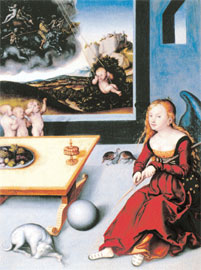 Μελαγχολία, Lucas Cranach ο πρεσβύτερος, 1532, Μουσείο Unterlinden, Colmar (λάδι σε ξύλο, 76,5x56 εκ.)
Η αναζήτηση και/ή οι δοκιμασίες στις οποίες υποβάλλεται ο παραμυθιακός ήρωας προκειμένου να ολοκληρώσει την αφηγηματική του διαδρομή έως το, συνήθως, αίσιο τέλος του μαγικού παραμυθιού, αποτελούν δομικό στοιχείο της πλοκής των μαγικών παραμυθιών. Η ασθένεια ως δοκιμασία ή τιμωρία –συχνά σε συνδυασμό με την αναζήτηση του μαγικού κατά κανόνα φαρμάκου, που θα τη θεραπεύσει–, αποτελεί συχνή αφηγηματική επιλογή, προκειμένου να ολοκληρωθεί η πλοκή έως το αίσιο τέλος.
Οι ασθένειες των παραμυθιών δεν είναι ακριβώς συμπτωματικές, αλλά ανίατες, καταλαμβάνουν ολόκληρη την ύπαρξη του υποκειμένου και το οδηγούν αναπόφευκτα σε «κοινωνικό» αποκλεισμό: είτε πρόκειται για αρρώστιες της ψυχής, όπως η τρέλα και η θλίψη, είτε για σωματικές ανεπάρκειες, όπως η τυφλότητα και η στειρότητα, είτε για ανήκεστους τραυματισμούς, όπως ο ακρωτηριασμός, είτε για τα εκφυλιστικά γηρατειά και το θάνατο, είτε «απλά» για τη λέπρα. Σε άλλες περιπτώσεις πρόκειται για μαγικές δυσμορφίες, όπως το φύτρωμα των κεράτων ή ενός δέντρου στην καρδιά.
Τα φάρμακα και οι θεραπείες, πέρα από την πανάκεια του αθάνατου νερού, ποικίλλουν: ένα μαγικό μήλο ή κάποιο βότανο, η κατάλληλη μαγική ενέργεια ή η πρόκληση του γέλιου κάνουν πολύτιμο γιατρό τον παραμυθιακό ήρωα.
Σε αυτή την εργασία επιχειρείται μια πρώτη αποτύπωση των ασθενειών και των θεραπειών, που απαντώνται στο παραμύθι – ετυμολογικά παρηγορητικό και φάρμακο ψυχής το ίδιο.
Μελαγχολία, Lucas Cranach ο πρεσβύτερος, 1532, Μουσείο Unterlinden, Colmar (λάδι σε ξύλο, 76,5x56 εκ.)
Η αναζήτηση και/ή οι δοκιμασίες στις οποίες υποβάλλεται ο παραμυθιακός ήρωας προκειμένου να ολοκληρώσει την αφηγηματική του διαδρομή έως το, συνήθως, αίσιο τέλος του μαγικού παραμυθιού, αποτελούν δομικό στοιχείο της πλοκής των μαγικών παραμυθιών. Η ασθένεια ως δοκιμασία ή τιμωρία –συχνά σε συνδυασμό με την αναζήτηση του μαγικού κατά κανόνα φαρμάκου, που θα τη θεραπεύσει–, αποτελεί συχνή αφηγηματική επιλογή, προκειμένου να ολοκληρωθεί η πλοκή έως το αίσιο τέλος.
Οι ασθένειες των παραμυθιών δεν είναι ακριβώς συμπτωματικές, αλλά ανίατες, καταλαμβάνουν ολόκληρη την ύπαρξη του υποκειμένου και το οδηγούν αναπόφευκτα σε «κοινωνικό» αποκλεισμό: είτε πρόκειται για αρρώστιες της ψυχής, όπως η τρέλα και η θλίψη, είτε για σωματικές ανεπάρκειες, όπως η τυφλότητα και η στειρότητα, είτε για ανήκεστους τραυματισμούς, όπως ο ακρωτηριασμός, είτε για τα εκφυλιστικά γηρατειά και το θάνατο, είτε «απλά» για τη λέπρα. Σε άλλες περιπτώσεις πρόκειται για μαγικές δυσμορφίες, όπως το φύτρωμα των κεράτων ή ενός δέντρου στην καρδιά.
Τα φάρμακα και οι θεραπείες, πέρα από την πανάκεια του αθάνατου νερού, ποικίλλουν: ένα μαγικό μήλο ή κάποιο βότανο, η κατάλληλη μαγική ενέργεια ή η πρόκληση του γέλιου κάνουν πολύτιμο γιατρό τον παραμυθιακό ήρωα.
Σε αυτή την εργασία επιχειρείται μια πρώτη αποτύπωση των ασθενειών και των θεραπειών, που απαντώνται στο παραμύθι – ετυμολογικά παρηγορητικό και φάρμακο ψυχής το ίδιο.
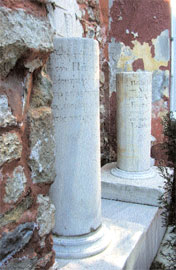 Ταφικές επιγραφές του Δημητρίου Σκυλίτση και του Παύλου Ροδοκανάκη.
Τα επιγράμματα σε δύο επιτύμβιες στήλες και μία επιτύμβια πλάκα των μέσων του 19ου αιώνα, οι οποίες σήμερα βρίσκονται στην αυλή της εκκλησίας της Παναγίας της Καφατιανής στον Γαλατά της Κωνσταντινούπολης και προέρχονται από την παρακείμενη εκκλησία του Αγίου Ιωάννη των Χίων, δίδουν σημαντικές πληροφορίες για τα ιστορικά γεγονότα της εποχής την κατασκευή της συγγένειας και την πιθανή αιτία θανάτου των προσώπων που αναφέρονται.
Από τα επιγράμματα στις επιτύμβιες στήλες των Δημητρίου Σκυλίτση του Πέτρου και Παύλου Ροδοκανάκη του Πέτρου, σε συνδυασμό με άλλες πηγές, αντλούμε σημαντικές πληροφορίες για την κατασκευή της συγγένειας, με βάση το όνομα και το συναίσθημα, το ιστορικό γεγονός της Σφαγής της Χίου και την πιθανή αιτία θανάτου των προσώπων.
Τα επιγράμματα της επιτύμβιας πλάκας της Ιουλίας Ψυχάρη και της Υπατίας Ψυχάρη αναφέρονται στη θυγατέρα και τη σύζυγο αντιστοίχως του Μισέ Γιάννη Ψυχάρη, στενού συνεργάτη του Σουλτάνου Αβδούλ Μετζίτ και Επιτρόπου των Χίων στην Κωνσταντινούπολη. Ειδικότερα με βάση την ημερομηνία θανάτου της Υπατίας Ψυχάρη, σε συσχετισμό με προηγηθείσα επιστολή του Μισέ Γιάννη Ψυχάρη προς τους Δημογέροντες της Χίου, ανατρέχουμε στο ιστορικό γεγονός της επίσκεψης του Αβδούλ Μετζίτ στη Χίο, τον Ιούνιο του 1850 και πληροφορούμαστε την ακριβή αιτία θανάτου της Υπατίας.
Η συμβολική αναφορά της αρρώστιας στους τάφους και στα λατρευτικά σύμβολα (εικόνες) διερευνάται επίσης.
Τα ίδια τα επιγράμματα επιβεβαιώνουν ή διαψεύδουν άλλες ιστορικές πηγές.
Ταφικές επιγραφές του Δημητρίου Σκυλίτση και του Παύλου Ροδοκανάκη.
Τα επιγράμματα σε δύο επιτύμβιες στήλες και μία επιτύμβια πλάκα των μέσων του 19ου αιώνα, οι οποίες σήμερα βρίσκονται στην αυλή της εκκλησίας της Παναγίας της Καφατιανής στον Γαλατά της Κωνσταντινούπολης και προέρχονται από την παρακείμενη εκκλησία του Αγίου Ιωάννη των Χίων, δίδουν σημαντικές πληροφορίες για τα ιστορικά γεγονότα της εποχής την κατασκευή της συγγένειας και την πιθανή αιτία θανάτου των προσώπων που αναφέρονται.
Από τα επιγράμματα στις επιτύμβιες στήλες των Δημητρίου Σκυλίτση του Πέτρου και Παύλου Ροδοκανάκη του Πέτρου, σε συνδυασμό με άλλες πηγές, αντλούμε σημαντικές πληροφορίες για την κατασκευή της συγγένειας, με βάση το όνομα και το συναίσθημα, το ιστορικό γεγονός της Σφαγής της Χίου και την πιθανή αιτία θανάτου των προσώπων.
Τα επιγράμματα της επιτύμβιας πλάκας της Ιουλίας Ψυχάρη και της Υπατίας Ψυχάρη αναφέρονται στη θυγατέρα και τη σύζυγο αντιστοίχως του Μισέ Γιάννη Ψυχάρη, στενού συνεργάτη του Σουλτάνου Αβδούλ Μετζίτ και Επιτρόπου των Χίων στην Κωνσταντινούπολη. Ειδικότερα με βάση την ημερομηνία θανάτου της Υπατίας Ψυχάρη, σε συσχετισμό με προηγηθείσα επιστολή του Μισέ Γιάννη Ψυχάρη προς τους Δημογέροντες της Χίου, ανατρέχουμε στο ιστορικό γεγονός της επίσκεψης του Αβδούλ Μετζίτ στη Χίο, τον Ιούνιο του 1850 και πληροφορούμαστε την ακριβή αιτία θανάτου της Υπατίας.
Η συμβολική αναφορά της αρρώστιας στους τάφους και στα λατρευτικά σύμβολα (εικόνες) διερευνάται επίσης.
Τα ίδια τα επιγράμματα επιβεβαιώνουν ή διαψεύδουν άλλες ιστορικές πηγές.
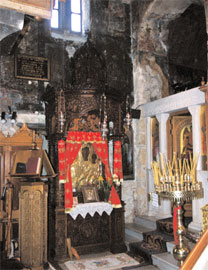 Τάματα στην Παναγία, Γαστούνη Ηλείας (φωτ. Αικ. Καμηλάκη)
Στον λαϊκό παροιμιακό λόγο, στη λαϊκή εθιμολογία, στις αντιλήψεις και δοξασίες των απλών ανθρώπων, ο φόβος και οι σχετικές έννοιες κατέχουν εντυπωσιακή θέση. Η αφοβία και περαιτέρω η γενναιότητα και η τόλμη αποτελεί χαρακτηριστικό γνώρισμα των ολίγων, των ξεχωριστών (ήρωες, υπερφυσικά όντα, άνδρες κυρίως, αλλά και γυναίκες), ενώ ο φόβος και συνακόλουθα ο πανικός είναι χαρακτηριστικό γνώρισμα των περισσοτέρων, κυρίως των αδυνάτων και απροστάτευτων. Είναι ωστόσο κοινά αποδεκτό ότι «ο φόβος φυλάει τα έρημα» σε πρακτικό και θεωρητικό επίπεδο. Απότοκος του φόβου, η δειλία θεωρείται γνώρισμα αδύναμου ψυχικά ανθρώπου. Εκεί όπου ο φόβος δεν διακρίνει δυνατούς και αδυνάτους, γενναίους και δειλούς, είναι στην περίπτωση ασθένειας και μάλιστα μεταδοτικής, τόσο ως ενδεχόμενο αντιμετώπισής της, όταν έχει ήδη ενσκήψει, όσο και για να κρατηθεί μακριά από συγκεκριμένα άτομα ή ομάδες ανθρώπων. Ιδιαίτερα σε περιπτώσεις θανατηφόρων ασθενειών με χαρακτήρα επιδημίας (πανώλης, χολέρα, ευλογιά, οστρακιά και άλλες προσωποποιημένες ως δυσειδείς γυναικείες μορφές), αλλά και σε κρίσιμες για την υγεία διαβατήριες στιγμές του κύκλου της ζωής, όπως η εγκυμοσύνη, η γέννηση, η λοχεία, ο φόβος με ποικίλες μορφές και ένταση είναι το υπόβαθρο πάνω στο οποίο αναπτύσσονται προλήψεις, δεισιδαιμονίες, μαγικές και μαγικοθρησκευτικές δοξασίες και ενέργειες. Για παράδειγμα, από φόβο η έγκυος και η λεχώνα, άτομα ιδιαίτερα ευάλωτα, απέφευγαν την οποιαδήποτε επαφή με νεκρό (παρουσία σε κηδεία), την κατανάλωση ορισμένων τροφών ή την κυκλοφορία εκτός του σπιτιού μετά τη δύση του ήλιου κ.ά.
Τάματα στην Παναγία, Γαστούνη Ηλείας (φωτ. Αικ. Καμηλάκη)
Στον λαϊκό παροιμιακό λόγο, στη λαϊκή εθιμολογία, στις αντιλήψεις και δοξασίες των απλών ανθρώπων, ο φόβος και οι σχετικές έννοιες κατέχουν εντυπωσιακή θέση. Η αφοβία και περαιτέρω η γενναιότητα και η τόλμη αποτελεί χαρακτηριστικό γνώρισμα των ολίγων, των ξεχωριστών (ήρωες, υπερφυσικά όντα, άνδρες κυρίως, αλλά και γυναίκες), ενώ ο φόβος και συνακόλουθα ο πανικός είναι χαρακτηριστικό γνώρισμα των περισσοτέρων, κυρίως των αδυνάτων και απροστάτευτων. Είναι ωστόσο κοινά αποδεκτό ότι «ο φόβος φυλάει τα έρημα» σε πρακτικό και θεωρητικό επίπεδο. Απότοκος του φόβου, η δειλία θεωρείται γνώρισμα αδύναμου ψυχικά ανθρώπου. Εκεί όπου ο φόβος δεν διακρίνει δυνατούς και αδυνάτους, γενναίους και δειλούς, είναι στην περίπτωση ασθένειας και μάλιστα μεταδοτικής, τόσο ως ενδεχόμενο αντιμετώπισής της, όταν έχει ήδη ενσκήψει, όσο και για να κρατηθεί μακριά από συγκεκριμένα άτομα ή ομάδες ανθρώπων. Ιδιαίτερα σε περιπτώσεις θανατηφόρων ασθενειών με χαρακτήρα επιδημίας (πανώλης, χολέρα, ευλογιά, οστρακιά και άλλες προσωποποιημένες ως δυσειδείς γυναικείες μορφές), αλλά και σε κρίσιμες για την υγεία διαβατήριες στιγμές του κύκλου της ζωής, όπως η εγκυμοσύνη, η γέννηση, η λοχεία, ο φόβος με ποικίλες μορφές και ένταση είναι το υπόβαθρο πάνω στο οποίο αναπτύσσονται προλήψεις, δεισιδαιμονίες, μαγικές και μαγικοθρησκευτικές δοξασίες και ενέργειες. Για παράδειγμα, από φόβο η έγκυος και η λεχώνα, άτομα ιδιαίτερα ευάλωτα, απέφευγαν την οποιαδήποτε επαφή με νεκρό (παρουσία σε κηδεία), την κατανάλωση ορισμένων τροφών ή την κυκλοφορία εκτός του σπιτιού μετά τη δύση του ήλιου κ.ά.
 Μητρότητα (φωτ. Γ. Αναστασιάδης, 2004)
Το υλικό του άρθρου αυτού προέρχεται από την αδημοσίευτη μεταπτυχιακή διατριβή μου, έχει δε εμπλουτισθεί από δημοσιευμένες και αδημοσίευτες εργασίες, που αφορούν σε κοινότητες του ελληνόφωνου χώρου (ελλαδικού, μικρασιατικού, ποντιακού, κυπριακού) του 19ου και του πρώτου μισού του 20ού αιώνα, αλλά και από πρόσφατη (2006) συλλογή λαογραφικού υλικού που πραγματοποίησα στο Διαφάνι Ολύμπου Καρπάθου, όπου συγκέντρωσα μαρτυρίες γύρω από τη γέννηση όπως συνέβαινε παλιά. Παρά το γεγονός ότι υπαρξιακά είναι το κατ’ εξοχήν ατομικό γεγονός, η γέννηση αποτελούσε ένα συμβάν συλλογικής σημασίας και ανάλογης αντιμετώπισης στις ελληνικές κοινότητες του παρελθόντος.
Μελετώντας τις ποικίλες δοξασίες και πρακτικές, τις τελετουργικές πράξεις και το λόγο που αφορούν στη γέννηση, μας αποκαλύπτεται το πλούσιο φάσμα των λαϊκών αντιλήψεων για τη σύλληψη και τη γονιμότητα, τη μητέρα και το παιδί, τη γέννηση και το θάνατο, την υγεία και την ασθένεια, το σώμα, το κοινωνικό φύλο και την κοινωνική τάξη, τη συγγένεια και την κοσμολογία μιας κοινότητας. Στη μελέτη που ακολουθεί παρουσιάζουμε αυτές τις αντιλήψεις και πρακτικές μέσα από την εστίαση στα πρόσωπα της μητέρας (εγκύου, τικτούσης, λεχώνας) και του παιδιού (εμβρύου, βρέφους). Συγχρόνως αναλύουμε το ρόλο των προσώπων που συμμετέχουν ενεργά στη διαδικασία της γέννησης, κυρίως γυναικών, με προεξάρχουσα τη μαμμή, πρωταρχικό συντελεστή στη διάβαση του νέου ανθρώπου από την ανυπαρξία στην κοινωνική ύπαρξη, και τη μύηση της μητέρας του στην ανάληψη του νέου της ρόλου.
Μητρότητα (φωτ. Γ. Αναστασιάδης, 2004)
Το υλικό του άρθρου αυτού προέρχεται από την αδημοσίευτη μεταπτυχιακή διατριβή μου, έχει δε εμπλουτισθεί από δημοσιευμένες και αδημοσίευτες εργασίες, που αφορούν σε κοινότητες του ελληνόφωνου χώρου (ελλαδικού, μικρασιατικού, ποντιακού, κυπριακού) του 19ου και του πρώτου μισού του 20ού αιώνα, αλλά και από πρόσφατη (2006) συλλογή λαογραφικού υλικού που πραγματοποίησα στο Διαφάνι Ολύμπου Καρπάθου, όπου συγκέντρωσα μαρτυρίες γύρω από τη γέννηση όπως συνέβαινε παλιά. Παρά το γεγονός ότι υπαρξιακά είναι το κατ’ εξοχήν ατομικό γεγονός, η γέννηση αποτελούσε ένα συμβάν συλλογικής σημασίας και ανάλογης αντιμετώπισης στις ελληνικές κοινότητες του παρελθόντος.
Μελετώντας τις ποικίλες δοξασίες και πρακτικές, τις τελετουργικές πράξεις και το λόγο που αφορούν στη γέννηση, μας αποκαλύπτεται το πλούσιο φάσμα των λαϊκών αντιλήψεων για τη σύλληψη και τη γονιμότητα, τη μητέρα και το παιδί, τη γέννηση και το θάνατο, την υγεία και την ασθένεια, το σώμα, το κοινωνικό φύλο και την κοινωνική τάξη, τη συγγένεια και την κοσμολογία μιας κοινότητας. Στη μελέτη που ακολουθεί παρουσιάζουμε αυτές τις αντιλήψεις και πρακτικές μέσα από την εστίαση στα πρόσωπα της μητέρας (εγκύου, τικτούσης, λεχώνας) και του παιδιού (εμβρύου, βρέφους). Συγχρόνως αναλύουμε το ρόλο των προσώπων που συμμετέχουν ενεργά στη διαδικασία της γέννησης, κυρίως γυναικών, με προεξάρχουσα τη μαμμή, πρωταρχικό συντελεστή στη διάβαση του νέου ανθρώπου από την ανυπαρξία στην κοινωνική ύπαρξη, και τη μύηση της μητέρας του στην ανάληψη του νέου της ρόλου.
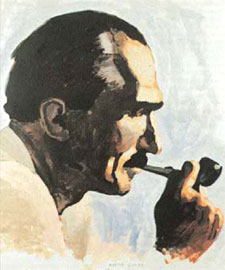 Πορτρέτο του Νίκου Καζαντζάκη (Συλλογή Έλλης Αλεξίου)
Στο άρθρο αυτό γίνεται η προσπάθεια να σκιαγραφηθεί μια τυπολογία των νόσων που εμφανίζονται στο πολύμορφο μυθιστορηματικό έργο του Νίκου Καζαντζάκη. Αρκετοί χαρακτήρες της καζαντζακικής πεζογραφίας συνδέονται με ένα ευρύ φάσμα σωματικών και ψυχικών ασθενειών: η ψυχική και πνευματική νοσηρότητα του ήρωα του έργου Όφις και κρίνο, η κατάθλιψη του Ορέστη στο μυθιστόρημα Σπασμένες ψυχές, η φυματίωση που κατατρύχει τον αγνό κομμουνιστή Σου-κί στο μυθιστόρημα Τόντα-Ράμπα, η μοιραία ασθένεια της μαντάμ Ορτάνς στο Βίος και πολιτεία του Αλέξη Ζορμπά και το αποτρόπαιο έκζεμα που χαράζει το πρόσωπο του Μανολιού στο έργο Ο Χριστός ξανασταυρώνεται αποτελούν ορισμένα μόνο χαρακτηριστικά παραδείγματα. Διερευνάται ο λειτουργικός ρόλος των νόσων (και των τρόπων θεραπείας τους, εφόσον αυτή επιχειρείται και επιτυγχάνεται) στα διάφορα μυθιστορήματα, καθώς και η ένταξή τους στο ευρύτερο πλαίσιο της καζαντζακικής πεζογραφίας.
Πορτρέτο του Νίκου Καζαντζάκη (Συλλογή Έλλης Αλεξίου)
Στο άρθρο αυτό γίνεται η προσπάθεια να σκιαγραφηθεί μια τυπολογία των νόσων που εμφανίζονται στο πολύμορφο μυθιστορηματικό έργο του Νίκου Καζαντζάκη. Αρκετοί χαρακτήρες της καζαντζακικής πεζογραφίας συνδέονται με ένα ευρύ φάσμα σωματικών και ψυχικών ασθενειών: η ψυχική και πνευματική νοσηρότητα του ήρωα του έργου Όφις και κρίνο, η κατάθλιψη του Ορέστη στο μυθιστόρημα Σπασμένες ψυχές, η φυματίωση που κατατρύχει τον αγνό κομμουνιστή Σου-κί στο μυθιστόρημα Τόντα-Ράμπα, η μοιραία ασθένεια της μαντάμ Ορτάνς στο Βίος και πολιτεία του Αλέξη Ζορμπά και το αποτρόπαιο έκζεμα που χαράζει το πρόσωπο του Μανολιού στο έργο Ο Χριστός ξανασταυρώνεται αποτελούν ορισμένα μόνο χαρακτηριστικά παραδείγματα. Διερευνάται ο λειτουργικός ρόλος των νόσων (και των τρόπων θεραπείας τους, εφόσον αυτή επιχειρείται και επιτυγχάνεται) στα διάφορα μυθιστορήματα, καθώς και η ένταξή τους στο ευρύτερο πλαίσιο της καζαντζακικής πεζογραφίας.
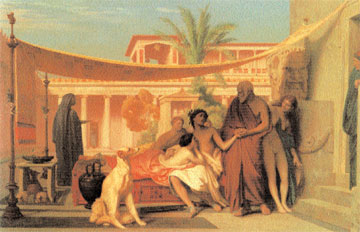 Ο Σωκράτης αναζητά τον Αλκιβιάδη στο σπίτι της Ασπασίας. Πίνακς του Jean-Léon Gérôme, 1861.
Ο Αλκιβιάδης υπήρξε αμφιλεγόμενη προσωπικότητα. Άνθρωπος εξαιρετικά χαρισματικός και ταυτόχρονα υπέρμετρα φιλόδοξος, πρόδωσε την πατρίδα του και την οδήγησε στην ολοκληρωτική της καταστροφή. Ωστόσο, η φιλοδοξία του και μόνο δεν αποτελεί αιτία ικανή να ερμηνεύσει μια τέτοια συμπεριφορά. Στην καρδιά και το μυαλό του Αλκιβιάδη η αγάπη και το μίσος για την πατρίδα του είναι αλληλένδετα. Σε κάθε του ενέργεια τα κατώτερα ένστικτά του αντιμάχονται το ευγενέστερο τμήμα της ψυχής του.
Σ’ αυτήν την εσωτερική του πάλη συνίσταται η τραγικότητά του.
Ο Σωκράτης αναζητά τον Αλκιβιάδη στο σπίτι της Ασπασίας. Πίνακς του Jean-Léon Gérôme, 1861.
Ο Αλκιβιάδης υπήρξε αμφιλεγόμενη προσωπικότητα. Άνθρωπος εξαιρετικά χαρισματικός και ταυτόχρονα υπέρμετρα φιλόδοξος, πρόδωσε την πατρίδα του και την οδήγησε στην ολοκληρωτική της καταστροφή. Ωστόσο, η φιλοδοξία του και μόνο δεν αποτελεί αιτία ικανή να ερμηνεύσει μια τέτοια συμπεριφορά. Στην καρδιά και το μυαλό του Αλκιβιάδη η αγάπη και το μίσος για την πατρίδα του είναι αλληλένδετα. Σε κάθε του ενέργεια τα κατώτερα ένστικτά του αντιμάχονται το ευγενέστερο τμήμα της ψυχής του.
Σ’ αυτήν την εσωτερική του πάλη συνίσταται η τραγικότητά του.
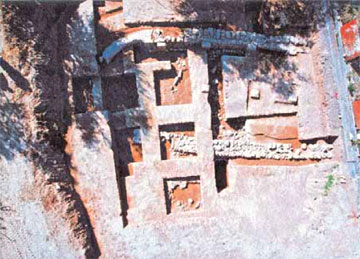 Αεροφωτογραφία της ανασκαφής που αποκάλυψε κτίριο της Γεωμετρικής εποχής, σε οικόπεδο στα Νικολαίικα του Δήμου Διακοπτού.
Στο οικόπεδο ιδιοκτησίας Αθανασίου Κομνηνού και Παρασκευής Καραχάλιου στα Νικολαίΐκα του Δήμου Διακοπτού αποκαλύφθηκε τμήμα μεγάλου κτιρίου της γεωμετρικής εποχής τον Ιούλιο του 2004. Βρίσκεται στην περιοχή της αρχαίας Ελίκης. Διακρίνονται δύο τουλάχιστον οικοδομικές φάσεις, που δεν απέχουν πολύ χρονικά μεταξύ τους και χρονολογούνται στην Ύστερη Γεωμετρική περίοδο, αλλά υπάρχουν ενδείξεις και για παλαιότερη λατρευτική χρήση του χώρου, από την οποία, όμως, δεν βρέθηκαν κτιριακά κατάλοιπα. Τα ευρήματα προέρχονται από το εσωτερικό του ναού. Πρόκειται κυρίως για κεραμική, αλλά και για μεταλλικά ευρήματα, σιδερένια και χάλκινα. Αντιπροσωπεύονται οι τρεις γνωστές στην Αιγιάλεια κατηγορίες κεραμικής των γεωμετρικών χρόνων: γραπτή αχαϊκή κεραμική, γραπτή κεραμική τύπου Θάψου και εμπίεστη κεραμική. Τέλος ιδιαίτερα σημαντική θεωρείται η εύρεση πέντε τουλάχιστον τμημάτων ομοιωμάτων οικίσκων.
Αεροφωτογραφία της ανασκαφής που αποκάλυψε κτίριο της Γεωμετρικής εποχής, σε οικόπεδο στα Νικολαίικα του Δήμου Διακοπτού.
Στο οικόπεδο ιδιοκτησίας Αθανασίου Κομνηνού και Παρασκευής Καραχάλιου στα Νικολαίΐκα του Δήμου Διακοπτού αποκαλύφθηκε τμήμα μεγάλου κτιρίου της γεωμετρικής εποχής τον Ιούλιο του 2004. Βρίσκεται στην περιοχή της αρχαίας Ελίκης. Διακρίνονται δύο τουλάχιστον οικοδομικές φάσεις, που δεν απέχουν πολύ χρονικά μεταξύ τους και χρονολογούνται στην Ύστερη Γεωμετρική περίοδο, αλλά υπάρχουν ενδείξεις και για παλαιότερη λατρευτική χρήση του χώρου, από την οποία, όμως, δεν βρέθηκαν κτιριακά κατάλοιπα. Τα ευρήματα προέρχονται από το εσωτερικό του ναού. Πρόκειται κυρίως για κεραμική, αλλά και για μεταλλικά ευρήματα, σιδερένια και χάλκινα. Αντιπροσωπεύονται οι τρεις γνωστές στην Αιγιάλεια κατηγορίες κεραμικής των γεωμετρικών χρόνων: γραπτή αχαϊκή κεραμική, γραπτή κεραμική τύπου Θάψου και εμπίεστη κεραμική. Τέλος ιδιαίτερα σημαντική θεωρείται η εύρεση πέντε τουλάχιστον τμημάτων ομοιωμάτων οικίσκων.
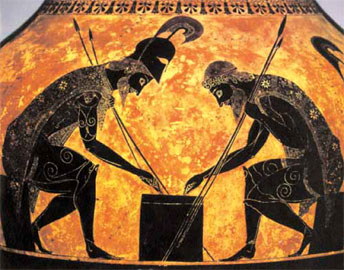 Ο Αχιλλέας και ο Αίας που παίζουν πεσσούς. Αττικός μελανόμορφος αμφορέας του Εξηκία (περ. 530 π.Χ.) Βατικανό, Museo Gregoriano
Η αντιπαραβολή των ομηρικών αφηγήσεων με αγγειογραφικές παραστάσεις εξακολουθεί να αντιμετωπίζεται ως ασφαλές κριτήριο για την χρονολόγηση της «τελικής» σύνθεσης των επών. Εντούτοις, η μέχρι τούδε έρευνα έχει δείξει ότι: α) οι αγγειογραφίες που αποδίδουν ομηρικά επεισόδια αποτελούσαν πάντα ένα μικρό ποσοστό του συνόλου των σωζομένων αγγειογραφιών, β) ποσοστό το οποίο μειώνεται αντί να αυξηθεί όσο προσεγγίζουμε την εποχή κατά την οποία αποδεδειγμένα έχουμε ένα «σταθερό» ομηρικό κείμενο.
Κατά τους συγγραφείς τούτου του άρθρου, η προσδοκία που ενέπνευσε την προαναφερόμενη αντιπαραβολή λειτούργησε παραπλανητικά: τα κίνητρα των αγγειογραφήσεων δεν θα πρέπει να αναζητηθούν στα κατορθώματα των ηρώων του παρελθόντος αλλά κυρίως στο κατόρθωμα αυτών που τα αναπαριστούσαν στο παρόν και που πλήρωναν τον αγγειογράφο: των θεατρικών συγγραφέων, των χορηγών, των ηθοποιών και γενικά εκείνων που είχαν λόγους να θυμούνται και να θυμίζουν στους άλλους μια λαμπρή θεατρική παράσταση, αναγκαίως απομεμακρυσμένη από τα «στερεότυπα» κείμενα του παρελθόντος.
Ο Αχιλλέας και ο Αίας που παίζουν πεσσούς. Αττικός μελανόμορφος αμφορέας του Εξηκία (περ. 530 π.Χ.) Βατικανό, Museo Gregoriano
Η αντιπαραβολή των ομηρικών αφηγήσεων με αγγειογραφικές παραστάσεις εξακολουθεί να αντιμετωπίζεται ως ασφαλές κριτήριο για την χρονολόγηση της «τελικής» σύνθεσης των επών. Εντούτοις, η μέχρι τούδε έρευνα έχει δείξει ότι: α) οι αγγειογραφίες που αποδίδουν ομηρικά επεισόδια αποτελούσαν πάντα ένα μικρό ποσοστό του συνόλου των σωζομένων αγγειογραφιών, β) ποσοστό το οποίο μειώνεται αντί να αυξηθεί όσο προσεγγίζουμε την εποχή κατά την οποία αποδεδειγμένα έχουμε ένα «σταθερό» ομηρικό κείμενο.
Κατά τους συγγραφείς τούτου του άρθρου, η προσδοκία που ενέπνευσε την προαναφερόμενη αντιπαραβολή λειτούργησε παραπλανητικά: τα κίνητρα των αγγειογραφήσεων δεν θα πρέπει να αναζητηθούν στα κατορθώματα των ηρώων του παρελθόντος αλλά κυρίως στο κατόρθωμα αυτών που τα αναπαριστούσαν στο παρόν και που πλήρωναν τον αγγειογράφο: των θεατρικών συγγραφέων, των χορηγών, των ηθοποιών και γενικά εκείνων που είχαν λόγους να θυμούνται και να θυμίζουν στους άλλους μια λαμπρή θεατρική παράσταση, αναγκαίως απομεμακρυσμένη από τα «στερεότυπα» κείμενα του παρελθόντος.
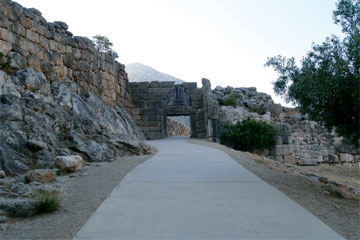 Η νέα διαδρομή προς την Πύλη των Λεόντων, μετά τις εργασίες διαμόρφωσης (2006)
Στην Ακρόπολη των Μυκηνών, συντελείται από το 2000 ένα μεγαλόπνοο πρόγραμμα αποφασιστικής επέμβασης του Υπουργείου Πολιτισμού. Ο στόχος που πρυτανεύει στην επέμβαση αυτή, είναι η στερέωση, η προστασία και η ανάδειξη των μνημείων και παράλληλα η λήψη μέτρων και η κατασκευή έργων διευκόλυνσης και ενημέρωσης των επισκεπτών.
Στις Μυκήνες η συνεχής ανασκαφική δραστηριότητα εκατόν τριάντα περίπου χρόνων είχε ως αποτέλεσμα την αποκάλυψη πολλών και σημαντικών μνημείων, και καθιστούσε ήδη από τον προηγούμενο αιώνα επιτακτική την ανάγκη για εργασίες προστασίας τους.
Η σημαντικότερη επέμβαση που έχει πραγματοποιηθεί στον αρχαιολογικό χώρο των Μυκηνών είναι αναμφισβήτητα η διαμόρφωση δικτύου πορειών και στάσεων, με το οποίο εξασφαλίζεται η προστασία των αρχαίων και η απρόσκοπτη περιδιάβαση των επισκεπτών.
Έως τώρα η κυκλοφορία των επισκεπτών στην Ακρόπολη ήταν άναρχη και γινόταν με λιγοστά σύγχρονα αυθαίρετα μονοπάτια χωρίς σαφή όρια, με αποτέλεσμα οι επισκέπτες να δρασκελίζουν πάνω από τα ερείπια, προκαλώντας ακούσιες φθορές. Με τη χάραξη του νέου δικτύου προσβάσεων οι επισκέπτες ακολουθούν τώρα συγκεκριμένη πορεία χωρίς να κινδυνεύουν και χωρίς να καταπονούνται τα οικοδομικά λείψανα, ενώ παρέχεται για πρώτη φορά η δυνατότητα σε άτομα με κινητικά προβλήματα να ανέβουν στην ακρόπολη και να περιηγηθούν στο χώρο. Επιπλέον έχει επιτευχθεί η οργανική σύνδεση του αρχαιολογικού χώρου με το νέο Μουσείο των Μυκηνών μέσω της Βόρειας Πύλης καθώς και η ενημέρωση των επισκεπτών με την τοποθέτηση δίγλωσσων πληροφοριακών πινακίδων.
Πρωταρχικό μέλημα υπήρξε η στερέωση και συντήρηση των οικοδομικών συγκροτημάτων της ακρόπολης, με εκτεταμένα αρμολογήματα στις τοιχοδομίες της Νοτιοδυτικής και Βόρειας Συνοικίας, της Οικίας των Κιόνων, του Εργαστηρίου των Καλλιτεχνών, της Σιταποθήκη και φυσικά του Ανάκτορο.
Η επιτυχία του έργου φαίνεται και από τον διπλασιασμό του αριθμού των επισκεπτών κατά την τελευταία τριετία.
Η νέα διαδρομή προς την Πύλη των Λεόντων, μετά τις εργασίες διαμόρφωσης (2006)
Στην Ακρόπολη των Μυκηνών, συντελείται από το 2000 ένα μεγαλόπνοο πρόγραμμα αποφασιστικής επέμβασης του Υπουργείου Πολιτισμού. Ο στόχος που πρυτανεύει στην επέμβαση αυτή, είναι η στερέωση, η προστασία και η ανάδειξη των μνημείων και παράλληλα η λήψη μέτρων και η κατασκευή έργων διευκόλυνσης και ενημέρωσης των επισκεπτών.
Στις Μυκήνες η συνεχής ανασκαφική δραστηριότητα εκατόν τριάντα περίπου χρόνων είχε ως αποτέλεσμα την αποκάλυψη πολλών και σημαντικών μνημείων, και καθιστούσε ήδη από τον προηγούμενο αιώνα επιτακτική την ανάγκη για εργασίες προστασίας τους.
Η σημαντικότερη επέμβαση που έχει πραγματοποιηθεί στον αρχαιολογικό χώρο των Μυκηνών είναι αναμφισβήτητα η διαμόρφωση δικτύου πορειών και στάσεων, με το οποίο εξασφαλίζεται η προστασία των αρχαίων και η απρόσκοπτη περιδιάβαση των επισκεπτών.
Έως τώρα η κυκλοφορία των επισκεπτών στην Ακρόπολη ήταν άναρχη και γινόταν με λιγοστά σύγχρονα αυθαίρετα μονοπάτια χωρίς σαφή όρια, με αποτέλεσμα οι επισκέπτες να δρασκελίζουν πάνω από τα ερείπια, προκαλώντας ακούσιες φθορές. Με τη χάραξη του νέου δικτύου προσβάσεων οι επισκέπτες ακολουθούν τώρα συγκεκριμένη πορεία χωρίς να κινδυνεύουν και χωρίς να καταπονούνται τα οικοδομικά λείψανα, ενώ παρέχεται για πρώτη φορά η δυνατότητα σε άτομα με κινητικά προβλήματα να ανέβουν στην ακρόπολη και να περιηγηθούν στο χώρο. Επιπλέον έχει επιτευχθεί η οργανική σύνδεση του αρχαιολογικού χώρου με το νέο Μουσείο των Μυκηνών μέσω της Βόρειας Πύλης καθώς και η ενημέρωση των επισκεπτών με την τοποθέτηση δίγλωσσων πληροφοριακών πινακίδων.
Πρωταρχικό μέλημα υπήρξε η στερέωση και συντήρηση των οικοδομικών συγκροτημάτων της ακρόπολης, με εκτεταμένα αρμολογήματα στις τοιχοδομίες της Νοτιοδυτικής και Βόρειας Συνοικίας, της Οικίας των Κιόνων, του Εργαστηρίου των Καλλιτεχνών, της Σιταποθήκη και φυσικά του Ανάκτορο.
Η επιτυχία του έργου φαίνεται και από τον διπλασιασμό του αριθμού των επισκεπτών κατά την τελευταία τριετία.
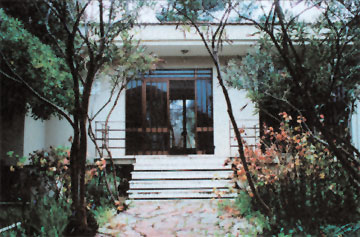 Η είσοδος του Μουσείου Βαθέος Ιθάκης.
Το Αρχαιολογικό Μουσείο Ιθάκης κτίστηκε μεταξύ του 1963 και 1966, αντικαθιστώντας το παλαιό που είχε καταστραφεί στο φοβερό σεισμό του 1963, κατά τον οποίο είχαν καταστραφεί και πολλά ευρήματα. Το νέο Μουσείο ξεκίνησε να λειτουργεί από το 1972, ενώ οι επανεκθετικές εργασίες ολοκληρώθηκαν το 1976. Η μόνιμη έκθεση του Μουσείου οφείλεται στον Π. Καλλιγά, την περίοδο εκείνη Έφορο Αρχαιοτήτων της Η΄ ΕΠΚΑ Κέρκυρας, στην οποία ανήκε αρχαιολογικά η Ιθάκη, ακολουθεί τοπογραφική ανάπτυξη κατά χρονολογική σειρά σε τρεις αίθουσες. Το βάρος, ωστόσο, δίνεται στη σημαντική ανασκαφή της Νότιας Ιθάκης.
Η είσοδος του Μουσείου Βαθέος Ιθάκης.
Το Αρχαιολογικό Μουσείο Ιθάκης κτίστηκε μεταξύ του 1963 και 1966, αντικαθιστώντας το παλαιό που είχε καταστραφεί στο φοβερό σεισμό του 1963, κατά τον οποίο είχαν καταστραφεί και πολλά ευρήματα. Το νέο Μουσείο ξεκίνησε να λειτουργεί από το 1972, ενώ οι επανεκθετικές εργασίες ολοκληρώθηκαν το 1976. Η μόνιμη έκθεση του Μουσείου οφείλεται στον Π. Καλλιγά, την περίοδο εκείνη Έφορο Αρχαιοτήτων της Η΄ ΕΠΚΑ Κέρκυρας, στην οποία ανήκε αρχαιολογικά η Ιθάκη, ακολουθεί τοπογραφική ανάπτυξη κατά χρονολογική σειρά σε τρεις αίθουσες. Το βάρος, ωστόσο, δίνεται στη σημαντική ανασκαφή της Νότιας Ιθάκης.
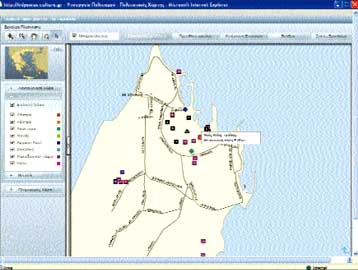 Πολιτιστικός χάρτης, η πόλη της Ρόδου με σημειωμένα τα είδη των μνημείων.
Στην καινούργια έκδοση του Οδυσσέα, νέα εργαλεία πρόσβασης, όπως ο Πολιτιστικός χάρτης της Ελλάδας, το Χρονολόγιο, το Φωτογραφικό αρχείο, και ένα ειδικό βοήθημα, το Γλωσσάρι, αποτελούν ανεξάρτητες διαδραστικές εφαρμογές.
Παρέχεται επίσης απλή αναζήτηση με ελεύθερο κείμενο και γενική αναλυτική αναζήτηση σε όλες σχεδόν τις κατηγορίες περιεχομένου του ιστότοπου (Μουσεία, Μνημεία, Αρχαιολογικούς χώρους, Εκθέσεις, Εκθέματα, Γλωσσάρι, Όλα, γεωγραφικό διαμέρισμα και «λέξεις κλειδιά»).
Πολιτιστικός χάρτης, η πόλη της Ρόδου με σημειωμένα τα είδη των μνημείων.
Στην καινούργια έκδοση του Οδυσσέα, νέα εργαλεία πρόσβασης, όπως ο Πολιτιστικός χάρτης της Ελλάδας, το Χρονολόγιο, το Φωτογραφικό αρχείο, και ένα ειδικό βοήθημα, το Γλωσσάρι, αποτελούν ανεξάρτητες διαδραστικές εφαρμογές.
Παρέχεται επίσης απλή αναζήτηση με ελεύθερο κείμενο και γενική αναλυτική αναζήτηση σε όλες σχεδόν τις κατηγορίες περιεχομένου του ιστότοπου (Μουσεία, Μνημεία, Αρχαιολογικούς χώρους, Εκθέσεις, Εκθέματα, Γλωσσάρι, Όλα, γεωγραφικό διαμέρισμα και «λέξεις κλειδιά»).
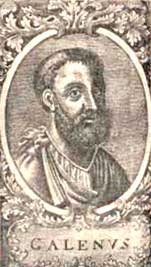 Ο Γαληνός (129-200 μ.Χ.), γιατρός και φιλόσοφος
Παρουσίαση συμποσίου με θέμα τη ζωή, την προσφορά στην ιατρική επιστήμη και το κολοσσιαίο βιβλιογραφικό έργο του Γαληνού, το οποίο διοργάνωσε η Ελληνική Ιατρική Εταιρεία του Ηνωμένου Βασιλείου στο Λονδίνο, στις 17 Μαïου 2007.
Ο Γαληνός (129-200 μ.Χ.), γιατρός και φιλόσοφος
Παρουσίαση συμποσίου με θέμα τη ζωή, την προσφορά στην ιατρική επιστήμη και το κολοσσιαίο βιβλιογραφικό έργο του Γαληνού, το οποίο διοργάνωσε η Ελληνική Ιατρική Εταιρεία του Ηνωμένου Βασιλείου στο Λονδίνο, στις 17 Μαïου 2007.
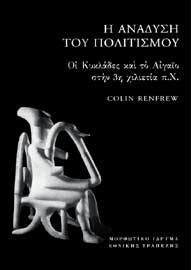 Εξώφυλλο του βιβλίου του Colin Renfrew, Η Ανάδυση του Πολιτισμού
Καρπός πολύχρονης και συστηματικής εργασίας στη δεκαετία του 1960 το βιβλίο του Colin Renfrew με τίτλο “The Emergence of Civilisation, The Cyclades and the Aegean in the Third millennium BC” εκδόθηκε το 1972 από τον ιστορικό εκδοτικό οίκο του Λονδίνου Methuen and Co Ltd. Πυρήνας του βιβλίου υπήρξε η διδακτορική διατριβή του συγγραφέα βασισμένη σε υλικό που συγκέντρωσε ο ίδιος στις Κυκλάδες και σε άλλες περιοχές του Αιγαίου.
Η Ανάδυση του Πολιτισμού ακόμη και σήμερα εξακολουθεί να θέτει ερωτήματα που αναμένουν απαντήσεις. Ακόμη και σήμερα εξακολουθεί να αποτελεί πρόκληση για κριτική σκέψη, αφού "το ενδιαφέρον για τον σημερινό αναγνώστη ή την αναγνώστρια δεν έγκειται τόσο στην επισκόπηση των επί πλέον στοιχείων, που έχουμε στη διάθεσή μας· είναι μάλλον να δει σε ποιο βαθμό εκείνες οι απόψεις, καθώς και το υποκείμενο θεωρητικό πλαίσιο, εξακολουθούν να ισχύουν· να αναρωτηθεί ως προς ποιες πτυχές θα πρέπει να αλλάξουν σήμερα αυτές οι απόψεις και να αξιολογήσει τη συνεχιζόμενη συνοχή αυτού του θεωρητικού πλαισίου" (σ. 11).
Εξώφυλλο του βιβλίου του Colin Renfrew, Η Ανάδυση του Πολιτισμού
Καρπός πολύχρονης και συστηματικής εργασίας στη δεκαετία του 1960 το βιβλίο του Colin Renfrew με τίτλο “The Emergence of Civilisation, The Cyclades and the Aegean in the Third millennium BC” εκδόθηκε το 1972 από τον ιστορικό εκδοτικό οίκο του Λονδίνου Methuen and Co Ltd. Πυρήνας του βιβλίου υπήρξε η διδακτορική διατριβή του συγγραφέα βασισμένη σε υλικό που συγκέντρωσε ο ίδιος στις Κυκλάδες και σε άλλες περιοχές του Αιγαίου.
Η Ανάδυση του Πολιτισμού ακόμη και σήμερα εξακολουθεί να θέτει ερωτήματα που αναμένουν απαντήσεις. Ακόμη και σήμερα εξακολουθεί να αποτελεί πρόκληση για κριτική σκέψη, αφού "το ενδιαφέρον για τον σημερινό αναγνώστη ή την αναγνώστρια δεν έγκειται τόσο στην επισκόπηση των επί πλέον στοιχείων, που έχουμε στη διάθεσή μας· είναι μάλλον να δει σε ποιο βαθμό εκείνες οι απόψεις, καθώς και το υποκείμενο θεωρητικό πλαίσιο, εξακολουθούν να ισχύουν· να αναρωτηθεί ως προς ποιες πτυχές θα πρέπει να αλλάξουν σήμερα αυτές οι απόψεις και να αξιολογήσει τη συνεχιζόμενη συνοχή αυτού του θεωρητικού πλαισίου" (σ. 11).
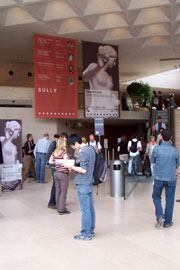 Άποψη του Λούβρου με την αφίσα της έκθεσης για τον Πραξιτέλη (φωτ. Δ. Δαμάσκος).
Στο Λούβρο διοργανώθηκε και παρουσιάστηκε στο κοινό την άνοιξη του 2007 μια μεγάλη έκθεση με θέμα τον φημισμένο Αθηναίο γλύπτη του 4ου αι. π.Χ., τον Πραξιτέλη. Η έκθεση αυτή, που αποτέλεσε μία από τις σημαντικότερες διοργανώσεις του αρχαιοελληνικού τμήματος του Λούβρου, προκάλεσε πλήθος δημοσιεύσεων στον ελληνικό και τον γαλλικό Tύπο, προσελκύοντας παράλληλα μεγάλο αριθμό επισκεπτών. Ο ογκώδης κατάλογος της έκθεσης αποτελεί πλέον έργο αναφοράς τόσο για το επιστημονικό κοινό όσο και για όσους ενδιαφέρονται για την αρχαία ελληνική γλυπτική.
Άποψη του Λούβρου με την αφίσα της έκθεσης για τον Πραξιτέλη (φωτ. Δ. Δαμάσκος).
Στο Λούβρο διοργανώθηκε και παρουσιάστηκε στο κοινό την άνοιξη του 2007 μια μεγάλη έκθεση με θέμα τον φημισμένο Αθηναίο γλύπτη του 4ου αι. π.Χ., τον Πραξιτέλη. Η έκθεση αυτή, που αποτέλεσε μία από τις σημαντικότερες διοργανώσεις του αρχαιοελληνικού τμήματος του Λούβρου, προκάλεσε πλήθος δημοσιεύσεων στον ελληνικό και τον γαλλικό Tύπο, προσελκύοντας παράλληλα μεγάλο αριθμό επισκεπτών. Ο ογκώδης κατάλογος της έκθεσης αποτελεί πλέον έργο αναφοράς τόσο για το επιστημονικό κοινό όσο και για όσους ενδιαφέρονται για την αρχαία ελληνική γλυπτική.
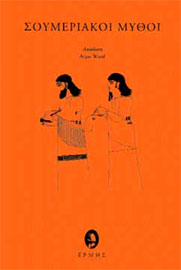 Το εξώφυλλο του βιβλίου Σουμεριακοί Μύθοι
Παρουσίαση του βιβλίου Σουμεριακοί Μύθοι σε απόδοση της Α. Ward, εκδ. Ερμής, Αθήνα 2006.
Το εξώφυλλο του βιβλίου Σουμεριακοί Μύθοι
Παρουσίαση του βιβλίου Σουμεριακοί Μύθοι σε απόδοση της Α. Ward, εκδ. Ερμής, Αθήνα 2006.
 Peter John Ucko (1938-2007)
Στις 14 Ιουνίου 2007 άφησε την τελευταία του πνοή στο Λονδίνο ο αρχαιολόγος Peter Ucko, ομότιμος Καθηγητής και ως το 2006 Διευθυντής του Ινστιτούτου Αρχαιολογίας στο Πανεπιστήμιο του Λονδίνου.
Peter John Ucko (1938-2007)
Στις 14 Ιουνίου 2007 άφησε την τελευταία του πνοή στο Λονδίνο ο αρχαιολόγος Peter Ucko, ομότιμος Καθηγητής και ως το 2006 Διευθυντής του Ινστιτούτου Αρχαιολογίας στο Πανεπιστήμιο του Λονδίνου.
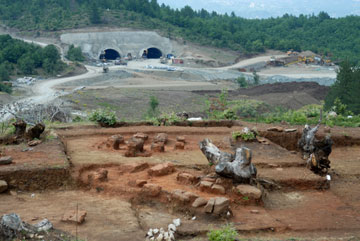 Άποψη της σωστικής ανασκαφής στα Πριόνια Δήμου Γόργιανης Νομού Γρεβενών.
Κατά το 2006, η Λ΄ΕΠΚΑ διενέργησε αρχαιολογικές έρευνες στο ανατολικό νεκροταφείο Αιανής Κοζάνης, στην περιοχή του φράγματος Ιλαρίωνος του νομού Γρεβενών και σε πέντε ακόμη θέσεις στο νομό Κοζάνης.
Στο ανατολικό νεκροταφείο της Αιανής, αποκαλύφθηκαν 94 λακκοειδείς τάφοι διατεταγμένοι σε σειρές, από τους οποίους δυο μόνον ήταν ασύλητοι. Με εξαίρεση τρεις καύσεις, οι λάκκοι περιείχαν κυρίως ενταφιασμούς. Στα πόδια των νεκρών είχαν τοποθετηθεί τα κτερίσματα: σιδερένιες αιχμές δόρατος, σιδερένιες και χάλκινες στλεγγίδες, πήλινα αγγεία, τοπικού εργαστηρίου ή αττικά, συχνά με εγχάρακτα γράμματα, που χρονολογούνται από τα μέσα περίπου του 4ου ως τις αρχές του 3ου αι. π.Χ.. Οι τάφοι χρησιμοποιούνταν πιθανότατα από τις ίδιες οικογένειες για διαδοχικές ταφές και για μεγάλο χρονικό διάστημα. Η ανασκαφή θα συνεχιστεί ενώ η μελέτη των ευρημάτων του νεκροταφείου θα προσφέρει μια ολοκληρωμένη εικόνα του τοπικού εργαστηρίου κεραμικής, από τον 4o ως τον 2o-1o αι. π.Χ.
Στο νομό Γρεβενών, οι ανασκαφές και η συστηματική έρευνα επιφανείας σε αρχαιολογικές θέσεις που θα πλημμυρίσουν εξαιτίας της κατασκευής του Φράγματος Ιλαρίωνα στο μέσο ρου του Αλιάκμονα χρηματοδοτήθηκαν από την ΔΕΗ Α.Ε., με σκοπό να αποφασιστεί τι θα σωθεί μέσω της ανασκαφής και τι θα θυσιαστεί στη λιμνοακτή και στο βυθό. Με την εκτεταμένη έρευνα επιφανείας, εντός της περιοχής κατάκλυσης, εντοπίστηκαν επτά νέες αρχαιολογικές θέσεις. Ανασκαφές διεξήχθησαν στις θέσεις: Λογκάς Ελάτης (οικισμός Ελληνιστικής Εποχής και κατοίκηση στην Εποχή Χαλκού και Σιδήρου), Γέφυρα Παναγιάς (οικιστικά κατάλοιπα ελληνιστικών χρόνων και χειροποίητη μακεδονική αμαυρόχρωμη Ύστερης Εποχής Χαλκού), Κεραμαριό Παλιουριάς (τμήματα μεγάλου νεκροταφείου που εκτείνεται σε δύο λόφους, με ταφές αρχαϊκής και κλασικής εποχής στον ανατολικό λόφο, και κλασικής και υστεροκλασικής εποχής στο δυτικό λόφο, η μελέτη των οποίων συμβάλλει στην αναθεώρηση των απόψεων περί πολιτισμικής και κοινωνικής απομόνωσης της Άνω Μακεδονίας στις αντίστοιχες εποχές).
Στο νομό Κοζάνης πραγματοποιήθηκαν ανασκαφές στον Πολύμυλο, στην περιοχή όπου κατασκευάζεται τμήμα της σύγχρονης Εγνατίας Οδού, και όπου είχαν παλιότερα αποκαλυφθεί τμήμα αρχαίας πόλης (ταυτίζεται με την Εύια της Μακεδονίας) ελληνιστικών και πρώιμων ρωμαϊκών χρόνων, τρεις χώροι νεκροταφείων Εποχής Χαλκού, ελληνιστικών και βυζαντινών χρόνων, καθώς και ταφικοί τύμβοι και οικιστικά κατάλοιπα Νεολιθικής Εποχής, Εποχής Χαλκού και Σιδήρου. Η νέα μελέτη κατασκευής του οδικού κόμβου επέβαλε την επί τόπου συντήρηση και κατάχωση ορισμένων από τους κλιβάνους που ανήκαν σε εργαστήρια μαζί με τα οικιστικά κατάλοιπα που τους περιέβαλαν, ενώ ο μνημειακότερος κλίβανος μεταφέρθηκε στην Αιανή. Κατά τις νέες ανασκαφές ήρθαν στο φως τμήματα αναλημματικών περιβόλων και δύο ύστερες ταφές, και σε άλλο σημείο οικιστικά κατάλοιπα Πρώιμης Εποχής Χαλκού και ελληνιστικών χρόνων, όπως τμήμα αγωγού ενός ευρύτερου δικτύου υδροδότησης από πηγές λόφων του Βερμίου όρους, καθώς και χώροι καθημερινής διαβίωσης και συναφών δραστηριοτήτων, όπως μαρτυρούν τα ευρήματα. Νέα ανασκαφή πραγματοποιήθηκε και στον Κλείτο, στα νότια της Πτολεμαΐδας, με σκοπό τη διάσωση και ανάδειξη των αρχαιοτήτων που βρίσκονται στη ζώνη ενός λιγνιτωρυχείου της ΔΕΗ. Ανασκάφηκε έκταση 1600 τ.μ. και αποκαλύφθηκε μικρό μέρος του οικισμού της Πρώιμης Εποχής Χαλκού, ενώ διαπιστώθηκε ότι ο χώρος κατοικήθηκε από την Τελική Νεολιθική ως την Ύστερη Εποχή Χαλκού, καθώς και στα ελληνιστικά-ρωμαϊκά χρόνια. Μικρή σωστική ανασκαφή διενεργήθηκε επίσης στον Περδίκκα, στη θέση Στράνα, σε χώρο νεολιθικού οικισμού. Τέλος, η ανακατασκευή του οδικού άξονα Σιάτιστας-Κρυσταλλοπηγής, επέβαλε τη διενέργεια ανασκαφής σε δύο από τις 15 που εντοπίστηκαν συνολικά. Στη θέση Σταυρός Μικροκάστρου διαπιστώθηκε κατοίκηση στην Ύστερη Εποχή Χαλκού. Στη θέση Κρυοπήγαδο Αλιάκμονα εντοπίστηκαν σε δύο υψώματα αρχαιολογικά στρώματα της Τελικής Νεολιθικής, της Πρώιμης Εποχής Χαλκού, καθώς και της Ύστερης Εποχής Χαλκού. Επίσης, στον ίδιο χώρο βρέθηκαν τρεις ασύλητες λακκοειδείς ταφές ρωμαϊκών χρόνων, καθώς και πασσαλόπηκτο οίκημα, ενώ από όλο το χώρο, έκτασης 770 τ.μ., περισυλλέχθηκαν κεραμική και αγγεία, αγκυρόσχημα ειδώλια, λίθινα και οστέινα εργαλεία, υφαντικά βάρη και σφονδύλια.
Άποψη της σωστικής ανασκαφής στα Πριόνια Δήμου Γόργιανης Νομού Γρεβενών.
Κατά το 2006, η Λ΄ΕΠΚΑ διενέργησε αρχαιολογικές έρευνες στο ανατολικό νεκροταφείο Αιανής Κοζάνης, στην περιοχή του φράγματος Ιλαρίωνος του νομού Γρεβενών και σε πέντε ακόμη θέσεις στο νομό Κοζάνης.
Στο ανατολικό νεκροταφείο της Αιανής, αποκαλύφθηκαν 94 λακκοειδείς τάφοι διατεταγμένοι σε σειρές, από τους οποίους δυο μόνον ήταν ασύλητοι. Με εξαίρεση τρεις καύσεις, οι λάκκοι περιείχαν κυρίως ενταφιασμούς. Στα πόδια των νεκρών είχαν τοποθετηθεί τα κτερίσματα: σιδερένιες αιχμές δόρατος, σιδερένιες και χάλκινες στλεγγίδες, πήλινα αγγεία, τοπικού εργαστηρίου ή αττικά, συχνά με εγχάρακτα γράμματα, που χρονολογούνται από τα μέσα περίπου του 4ου ως τις αρχές του 3ου αι. π.Χ.. Οι τάφοι χρησιμοποιούνταν πιθανότατα από τις ίδιες οικογένειες για διαδοχικές ταφές και για μεγάλο χρονικό διάστημα. Η ανασκαφή θα συνεχιστεί ενώ η μελέτη των ευρημάτων του νεκροταφείου θα προσφέρει μια ολοκληρωμένη εικόνα του τοπικού εργαστηρίου κεραμικής, από τον 4o ως τον 2o-1o αι. π.Χ.
Στο νομό Γρεβενών, οι ανασκαφές και η συστηματική έρευνα επιφανείας σε αρχαιολογικές θέσεις που θα πλημμυρίσουν εξαιτίας της κατασκευής του Φράγματος Ιλαρίωνα στο μέσο ρου του Αλιάκμονα χρηματοδοτήθηκαν από την ΔΕΗ Α.Ε., με σκοπό να αποφασιστεί τι θα σωθεί μέσω της ανασκαφής και τι θα θυσιαστεί στη λιμνοακτή και στο βυθό. Με την εκτεταμένη έρευνα επιφανείας, εντός της περιοχής κατάκλυσης, εντοπίστηκαν επτά νέες αρχαιολογικές θέσεις. Ανασκαφές διεξήχθησαν στις θέσεις: Λογκάς Ελάτης (οικισμός Ελληνιστικής Εποχής και κατοίκηση στην Εποχή Χαλκού και Σιδήρου), Γέφυρα Παναγιάς (οικιστικά κατάλοιπα ελληνιστικών χρόνων και χειροποίητη μακεδονική αμαυρόχρωμη Ύστερης Εποχής Χαλκού), Κεραμαριό Παλιουριάς (τμήματα μεγάλου νεκροταφείου που εκτείνεται σε δύο λόφους, με ταφές αρχαϊκής και κλασικής εποχής στον ανατολικό λόφο, και κλασικής και υστεροκλασικής εποχής στο δυτικό λόφο, η μελέτη των οποίων συμβάλλει στην αναθεώρηση των απόψεων περί πολιτισμικής και κοινωνικής απομόνωσης της Άνω Μακεδονίας στις αντίστοιχες εποχές).
Στο νομό Κοζάνης πραγματοποιήθηκαν ανασκαφές στον Πολύμυλο, στην περιοχή όπου κατασκευάζεται τμήμα της σύγχρονης Εγνατίας Οδού, και όπου είχαν παλιότερα αποκαλυφθεί τμήμα αρχαίας πόλης (ταυτίζεται με την Εύια της Μακεδονίας) ελληνιστικών και πρώιμων ρωμαϊκών χρόνων, τρεις χώροι νεκροταφείων Εποχής Χαλκού, ελληνιστικών και βυζαντινών χρόνων, καθώς και ταφικοί τύμβοι και οικιστικά κατάλοιπα Νεολιθικής Εποχής, Εποχής Χαλκού και Σιδήρου. Η νέα μελέτη κατασκευής του οδικού κόμβου επέβαλε την επί τόπου συντήρηση και κατάχωση ορισμένων από τους κλιβάνους που ανήκαν σε εργαστήρια μαζί με τα οικιστικά κατάλοιπα που τους περιέβαλαν, ενώ ο μνημειακότερος κλίβανος μεταφέρθηκε στην Αιανή. Κατά τις νέες ανασκαφές ήρθαν στο φως τμήματα αναλημματικών περιβόλων και δύο ύστερες ταφές, και σε άλλο σημείο οικιστικά κατάλοιπα Πρώιμης Εποχής Χαλκού και ελληνιστικών χρόνων, όπως τμήμα αγωγού ενός ευρύτερου δικτύου υδροδότησης από πηγές λόφων του Βερμίου όρους, καθώς και χώροι καθημερινής διαβίωσης και συναφών δραστηριοτήτων, όπως μαρτυρούν τα ευρήματα. Νέα ανασκαφή πραγματοποιήθηκε και στον Κλείτο, στα νότια της Πτολεμαΐδας, με σκοπό τη διάσωση και ανάδειξη των αρχαιοτήτων που βρίσκονται στη ζώνη ενός λιγνιτωρυχείου της ΔΕΗ. Ανασκάφηκε έκταση 1600 τ.μ. και αποκαλύφθηκε μικρό μέρος του οικισμού της Πρώιμης Εποχής Χαλκού, ενώ διαπιστώθηκε ότι ο χώρος κατοικήθηκε από την Τελική Νεολιθική ως την Ύστερη Εποχή Χαλκού, καθώς και στα ελληνιστικά-ρωμαϊκά χρόνια. Μικρή σωστική ανασκαφή διενεργήθηκε επίσης στον Περδίκκα, στη θέση Στράνα, σε χώρο νεολιθικού οικισμού. Τέλος, η ανακατασκευή του οδικού άξονα Σιάτιστας-Κρυσταλλοπηγής, επέβαλε τη διενέργεια ανασκαφής σε δύο από τις 15 που εντοπίστηκαν συνολικά. Στη θέση Σταυρός Μικροκάστρου διαπιστώθηκε κατοίκηση στην Ύστερη Εποχή Χαλκού. Στη θέση Κρυοπήγαδο Αλιάκμονα εντοπίστηκαν σε δύο υψώματα αρχαιολογικά στρώματα της Τελικής Νεολιθικής, της Πρώιμης Εποχής Χαλκού, καθώς και της Ύστερης Εποχής Χαλκού. Επίσης, στον ίδιο χώρο βρέθηκαν τρεις ασύλητες λακκοειδείς ταφές ρωμαϊκών χρόνων, καθώς και πασσαλόπηκτο οίκημα, ενώ από όλο το χώρο, έκτασης 770 τ.μ., περισυλλέχθηκαν κεραμική και αγγεία, αγκυρόσχημα ειδώλια, λίθινα και οστέινα εργαλεία, υφαντικά βάρη και σφονδύλια.
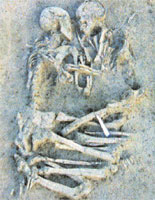 Σκελετοί εραστών βρέθηκαν θαμμένοι αγκαλιά κοντά στην πόλη Μάντοβα της Ιταλίας.
Ειδήσεις: 150 χρόνια Γαλλική Αρχαιολογική Σχολή, Aρχαίο νεκροταφείο βρεφών Αστυπάλαιας, Aγροτικό ιερό στον Ορχομενό, Iερό Ηρακλή στη Μαγνησία κ.ά.
Εκθέσεις: "Ελαίας Εγκώμιον" στο Συνεδριακό Κέντρο ΣΠΑΠ στην Αρχαία Ολυμπία, Διαδραστική έκθεση για την Αρχαία Αγορά στο ΙΜΕ, Xρονικό των ανασκαφών των ξένων αρχαιολογικών σχολών κ.ά.
Συνέδρια: Μουσεία και Εκπαίδευση, Τα 150 χρόνια της Γαλλικής Αρχαιολογικής Σχολής κ.ά.
Διαλέξεις: Μεταλλουργία της Πρώιμης Εποχής του Χαλκού, Δελφοί.
Βιβλία: Antonio Corso, The Art of Praxiteles II. The Mature Years, 2007 - J.-Cl. Goyon κ.ά.., La construction pharaonique, 2004 - Μ. Νικολάου, Ορυκτά, πετρώματα και πολιτισμός, 2005, κ.α.
Επιστολές: Π.-Κ. Τρίμης, φοιτητής αρχαιολογίας, Οι μυκηναϊκοί θολωτοί τάφοι του αγρού Πετρόχειλου στα Κύθηρα.
Σκελετοί εραστών βρέθηκαν θαμμένοι αγκαλιά κοντά στην πόλη Μάντοβα της Ιταλίας.
Ειδήσεις: 150 χρόνια Γαλλική Αρχαιολογική Σχολή, Aρχαίο νεκροταφείο βρεφών Αστυπάλαιας, Aγροτικό ιερό στον Ορχομενό, Iερό Ηρακλή στη Μαγνησία κ.ά.
Εκθέσεις: "Ελαίας Εγκώμιον" στο Συνεδριακό Κέντρο ΣΠΑΠ στην Αρχαία Ολυμπία, Διαδραστική έκθεση για την Αρχαία Αγορά στο ΙΜΕ, Xρονικό των ανασκαφών των ξένων αρχαιολογικών σχολών κ.ά.
Συνέδρια: Μουσεία και Εκπαίδευση, Τα 150 χρόνια της Γαλλικής Αρχαιολογικής Σχολής κ.ά.
Διαλέξεις: Μεταλλουργία της Πρώιμης Εποχής του Χαλκού, Δελφοί.
Βιβλία: Antonio Corso, The Art of Praxiteles II. The Mature Years, 2007 - J.-Cl. Goyon κ.ά.., La construction pharaonique, 2004 - Μ. Νικολάου, Ορυκτά, πετρώματα και πολιτισμός, 2005, κ.α.
Επιστολές: Π.-Κ. Τρίμης, φοιτητής αρχαιολογίας, Οι μυκηναϊκοί θολωτοί τάφοι του αγρού Πετρόχειλου στα Κύθηρα.
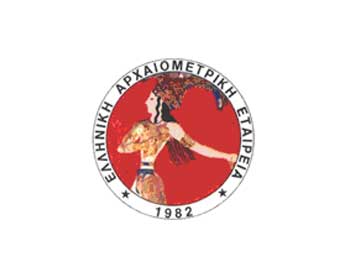 Το λογότυπο της Ελληνικής Αρχαιομετρικής Εταιρείας
Στα Αρχαιομετρικά Νέα μπορείτε να διαβάσετε:
- Το Ανασκαφικό Σεμινάριο στο Δισπηλιό Καστοριάς
- Προκήρυξη για χρηματοδότηση δημοσίευσης
- Δημοσιεύσεις για ελληνικά θέματα διαθέσιμες στο διαδίκτυο
- Θέματα Αρχαιολογίας και Παλαιοπαθολογίας στο διαδίκτυο
- Νέα ανασκαφικά ευρήματα
Το λογότυπο της Ελληνικής Αρχαιομετρικής Εταιρείας
Στα Αρχαιομετρικά Νέα μπορείτε να διαβάσετε:
- Το Ανασκαφικό Σεμινάριο στο Δισπηλιό Καστοριάς
- Προκήρυξη για χρηματοδότηση δημοσίευσης
- Δημοσιεύσεις για ελληνικά θέματα διαθέσιμες στο διαδίκτυο
- Θέματα Αρχαιολογίας και Παλαιοπαθολογίας στο διαδίκτυο
- Νέα ανασκαφικά ευρήματα
Those responsible for establishing policies concerning medicine in the newly formed Greek state, used terms such as tramp or quack to protect official modern Greek medicine from the many popular practitioners and charismatic healers now identified with dangerous, criminal activities. Nevertheless, the terminology of official 18th century medicine which had already entered Greece since the mid 1700s, sounds as uncanny today as the language of quacks. The classifying of illnesses according to Brown’s theory, led to the use of purges, formulas to bring on vomiting and bloodletting. The Medical School of Athens was founded in the New Greek State in 1837, and dreamed of reviving the splendour of antiquity. The problems, however, that had to be tackled immediately were the epidemics. Kapodistrias had introduced a modern quarantine system to control epidemics of typhoid fever, cholera and dysentery. Nevertheless after the influx of refugees from Asia Minor, widespread malnutrition, the high levels of infant mortality, tuberculosis, malaria and other infectious diseases led to the founding of the School of Public Health in 1930. This brought about the first systematic efforts to deal with threatening epidemics through government funding. Popular medicine, on the other hand, which is in the service of humanity and not of science, contributes to creating an ideology concerning health and illness and thus shows how many non-medical practices have relieved the sufferings of the human condition.
The purpose of this article is to present the geographic and demographic distribution of medical and paramedical personnel in Greece during the mid-War years. Our information comes from the Medical Guide of Greece [Ιατρικός Oδηγός της Ελλάδος] of 1926 by Assael and Matsas, and from other, mainly medical, sources. The research carried out led us to various conclusions regarding the spatial distribution of the various medical specialities, the overall structure of the healthcare system in that period (region, county, city), and the demographic picture of Greece, since the dispersion of medical personnel corresponded to the needs of the country’s population. Furthermore, statistic elaboration of the available material has revealed the existence of certain specialities and their concentration or shortage in certain areas as well as the distribution of hospitals and medical institutions in general in the same areas. Finally, certain representative diagrams have been incorporated in our study so that the statistic and demographic data derived from our sources could be made clear.
In the early nineteenth century , individuals suffering from phychic disorders were usually confined either in their family environment, in monasteries or in communal hospitals. Soon after the foundation of the modern Greek state, the debate on the treatment of the insane led in 1862 to the resolution of the first relevant law on the institution of a state mental hospital, a law which however remained inactive until 1864. It was then that the annexation of the Ionian Islands endowed the Greek state with two lunatic asylums, those of Corfu and Kephallonia, that had been founded in 1840. In 1880 the Chian merchant Zorzis Dromokaitis bequeathed a considerable amount of money for the foundation of a mental hospital in Athens. However, the new perspective the Dromokaiteion Hospital offered, that of the confinement and scientific treatment of the lunatics, was met with suspicion, due to the already existing prejudices and the negative tradition such an institution had in Western Europe. As a result, only a limited number of patients was admitted, who were chosen on the basis of social rather than scientific criteria. Nevertheless, the reinforcement of the charitable character of Dromokaiteion in the following years led to the gradual increase of destitute patients and to the progressive transformation of the hospital to an asylum.
The pursuits and/or the trials to which the hero in distress is submitted in order to complete his narrative course that usually leads to the happy ending of the magical fairy-tale constitute an integral component of the plot. Disease as trial or punishment, quite often combined with the search for the magical, as a rule, cure is a common narrative vehicle that always leads to the happy completion of the plot. Diseases in fairy-tales are incurable,they dominate the hero's entire existence and inevitably lead to his being “socially” debarred. They range from psychic disorders, such as madness and depression, physical handicaps, such as blindness and infertility, irreparable injuries, such as amputation, to degenerative old-age symptoms and death, while in other instances they appear as magic malformations, such as the sprouting of horns or of a tree right from the heart. The remedies and treatment, besides the panacea of the water of immortality, vary. An effective physician with the use of a magic apple or herb, a proper magic ritual or a fit of laughter might work miracles on the hero in distress.
The epigrams inscribed on two funeral stelae and a funeral slab of the mid-nineteenth century in the precinct of the Church of Panaghia Kafatiani in Constantinople, originally lay in the adjacent Church of Hagios Ioannis of the Chians,and provide important information on the history of the period, the relationship, and probable cause of death of the individuals to whom they refer. Thus, from the epigrams inscribed on the funerary stelae of Demetrios Skylitsis and Petros and Pavlos Rodokanakis, we draw valuable information on the kind of relationship, the historical fact of the Massacre of Chios Island, and the probable cause of death of the deceased. The epigrams on the funerary slab of Ioulia and Hypatia Psychari refer to the daughter and wife, respectively, of Misse (Monsieur) Yannis Psycharis, a confidant of the Sultan Abdul Mejid and representative of Chians in Constantinople. The date of death of Hypatia Psychari in particular, in combination with an earlier letter of her husband to the Elders of Chios, supply elucidating information on the historical visit of Abdul Mejid to Chios in June of 1850 and the accurate cause of Hypatia’s death. Needless to say that these epigrams verify or contradict various other historical sources.
Fear and related notions hold an impressive position in folk proverbs and customs and in the conceptions and beliefs of common people. The lack of fear and, even further, bravery is a characteristic quality of the few and distinguished individuals (heroes, supernatural beings, mainly male but also female), while fear and consequently panic concern mainly the weak and the vulnerable. Cowardice, being the outcome of fear, is a typical feature of the psychically impotent person. Fear however, does not distinguish the strong and brave from the weak and cowardly, when they are confronted with a disease, particularly of a contagious one. In fatal diseases and epidemics (plague, cholera, smallpox, scarlet fever etc, personified as unsightly female figures) in particular as well as in turning points of life that are critical for health, such as pregnancy, childbirth or puerperium, fear, in various forms and intensities, becomes the fertile soil from which prejudices, superstitions, magic and magic-religious beliefs and rites spring and grow. For example, pregnant women and puerperae or particularly vulnerable persons used to avoid out of fear any contact with the deceased (attending funerals), consuming certain foods or staying out after sunset.
The basis for this article is my unpublished Master’s thesis and ethnographic material. This latter, published or otherwise,comes from various parts of the Greek speaking world, namely Greece itself, Pontus, Cyprus and the Greek diaspora in general and dates from the 19th and first half of the 20th century. Although in existential terms, birth is an individual event par excellence, it was dealt with as a happening of collective importance in Greek communities of the past. If one studies the beliefs, practices, rituals and discourse regarding birth, the varied spectrum of popular concepts concerning various issues becomes apparent. These include fertility and conception, mother and child, birth and death, sickness and health, the body, gender and class, kinship and the cosmology of a community. This study presents these concepts and practices via the mother, pregnant, giving birth and as a new mother, and via the child, as embryo and new-born child. We also analyse the role of the characters who actively participate in the process of birth. These are chiefly female, namely, the midwife, who is the primary factor involved in the passage of young human from non-existence to social being, and in the passage of the mother towards the assumption of her role.
In this article we attempt to draw an outline of the typology of diseases that appear in the polymorphous world of Nikos Kazantzakis’ novels. Quite a few of the personae in Kazantzakis’ prose suffer from a broad spectrum of physical and psychic diseases. A few, typical examples are the psychic and spiritual morbidity of the hero in Serpent and Lily, Orestes’ depression in Broken Souls, the tuberculosis obsessing the pure communist Shuki in Toda-Raba, madam Ortence’s fatal malady in Zorba the Greek as well as the hideous eczema that scars Manolios’ face in Christ Recrucified . We also look into the functional role of the diseases in novels, their cure, whenever it is attempted and succeeds, and their incorporation in Kazantzakis’ prose oeuvre.
Alcibiades was a controversial personality. An exceptionally charismatic and at the same time excessively ambitious individual, he betrayed his country and led it to its utter destruction. However, ambition as a motive does not in itself suffice to interpret such a behavior. In Alcibiades’ heart and mind his love and hatred for Athens are interrelated. In all his actions his inferior instincts fight against the noblest part of his soul. The tragic character of his existence results from this inner struggle.
On a private building site in the district of ancient Eliki, in what is at present the Municipality of Diakopto, part of a large Geometric temple came to light. It contains two building phases of the Late Geometric years as well as traces of worship from an even earlier period, from which, however, no remnants of buildings have survived. Along with a number of metallic finds, iron and bronze,in the temple a considerable amount of Geometric ceramics were uncovered, representative of the three groups of pottery common to Aegialia ;the painted Achean, painted Thapsos type and embossed earthenware. Finally, at least five clay models of houses were discovered, which are considered particularly important.
Comparison of Homeric narrations to their depiction on vases mainly continues on the lines that the various stages of the epic are directly reflected on the vase representations of the period. According to this reasoning, a scrutiny of the epic repertoire on pottery would bring to us the definitive version of the Homeric poems. However, the research carried on so far has denied this expectation and has, on the contrary, proved that: a. the vase paintings picturing Homeric episodes represent only a small percentage of the extant scenes decorating pottery, and b.that this percentage diminishes rather than increases, the closer we approach the era in which the epic text took its final shape. Therefore, we believe that the aforementioned comparison has been based on false asumptions, since the vase painter's motive in representing Homeric scenes was not to commemorate the glorious deeds of the heroes of the past, but mainly to illustrate the accomplishments of those who performed them in the present and financed him. Namely the play writers, sponsors, actors and all those who had good reason to remember themselves and remind others of an excellent theatrical performance, quite different from the “stereotyped” texts of the past. Consequently, it is useless to try to find in these vase paintings truthful representations of the epos and quite erroneous to use them as a criterion when dating the Homeric poems, because the staged versions of the Trojan episodes were continuously changing and constantly departing from the text of the epic poetry.
Since 2000 a project of decisive intervention has been carried out on the acropolis of Mycenae, the prevailing objective of which is the consolidation, preservation and promotion of its monuments and at the same time the effective management of the archaeological site where both monuments and visitors are concerned. Given that a great number of important antiquities have been uncovered during the one-hundred-and-thirty years of continuous excavation, the imperative need for their protection and preservation had already emerged in the past century. Indisputably, the most important work carried out in the archaeological site of Mycenae has been the new marking out and formation of a defined network of routes and stops.Through this new marking out of the site,both protection of the monuments and of the visitors has been achieved, and thus the archaeological ruins are not anymore plagued by the visitors’ over stepping, the latter avoid any physical harm while touring the site, and individuals with kinetic disabilities have access to the acropolis and its grounds. Furthermore, the archaeological site has been connected with the new Museum of Mycenae through the Northern Entrance, appropriate works have provided satisfactory accommodation for visitors, while the posted bilingual tablets supply them with sufficient information on the site.A great priority and major concern throughout the realization of this project was the consolidation and restoration of the acropolis’ building complexes and extensive repointing of the masonry of the Southwest and North Quarters, House of Columns, Artisans Quarter, Granary and, naturally,of the acropolis. The doubling of the number of visitors in the last three years confirms the success of the overall project.
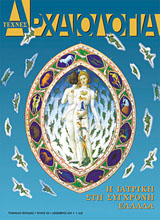
 Παιδιά που γεννήθηκαν πρόωρα στο Μαιευτήριο Έλενα Βενιζέλου (1947-1951) και επιβίωσαν.
Στον απόηχο δύο παγκοσμίων πολέμων, η τεχνολογική και οικονομική απόσταση μεταξύ της Ευρώπης της Μεσογείου και των γειτόνων της στο Βορρά ήταν εξίσου πραγματική και συμβολική. Οι υλικές συνθήκες όσον αφορά την απλή επιβίωση και μόνο ήταν δυσοίωνες· ωστόσο, εικόνες αρχαίας δόξας συναντούσαν οράματα εκσυγχρονισμού. Σύμφωνα με τα επίπεδα νοσηρότητας και θνησιμότητας, η Ελλάδα προσέγγιζε την κατηγορία του «τρίτου κόσμου», ενώ το ευρύ κοινό αναζητούσε θαυματουργές θεραπείες από το εξωτερικό, με τη λογική ότι «το ξένο είναι καλύτερο». Τα σχετικά υψηλά ποσοστά οικονομικής ανάπτυξης στις δεκαετίες του 1960 και του 1970 συνοδεύονταν από μια κοινωνική πολιτική της υγείας που ευνοούσε τον ιδιωτικό ιατρικό τομέα. Οι δαπάνες για τη δημόσια υγεία παρέμεναν εξαιρετικά χαμηλές και τα ταμεία ασφάλισης (με εξαίρεση το Ίδρυμα Κοινωνικών Ασφαλίσεων) ήταν συμβεβλημένα με τον ιδιωτικό τομέα. Έως το 1973, είχε εφαρμοστεί μικρό μόνο τμήμα ενός μεταρρυθμιστικού προγράμματος για την ιατρική περίθαλψη, οι δαπάνες για τη δημόσια υγεία ελαττώθηκαν περαιτέρω και οι προτάσεις για μια εθνική υπηρεσία υγείας εγκαταλείφθηκαν. Το Εθνικό Σύστημα Υγείας (ΕΣΥ) υλοποιήθηκε εντέλει στη δεκαετία του 1980 — συμπίπτοντας με τις ολοένα και περισσότερες διεθνείς πολιτικό-οικονομικές κριτικές, τόσο του ιατρικού συστήματος της οικονομίας της αγοράς, όσο και του κράτους ιατρικής πρόνοιας.
Παιδιά που γεννήθηκαν πρόωρα στο Μαιευτήριο Έλενα Βενιζέλου (1947-1951) και επιβίωσαν.
Στον απόηχο δύο παγκοσμίων πολέμων, η τεχνολογική και οικονομική απόσταση μεταξύ της Ευρώπης της Μεσογείου και των γειτόνων της στο Βορρά ήταν εξίσου πραγματική και συμβολική. Οι υλικές συνθήκες όσον αφορά την απλή επιβίωση και μόνο ήταν δυσοίωνες· ωστόσο, εικόνες αρχαίας δόξας συναντούσαν οράματα εκσυγχρονισμού. Σύμφωνα με τα επίπεδα νοσηρότητας και θνησιμότητας, η Ελλάδα προσέγγιζε την κατηγορία του «τρίτου κόσμου», ενώ το ευρύ κοινό αναζητούσε θαυματουργές θεραπείες από το εξωτερικό, με τη λογική ότι «το ξένο είναι καλύτερο». Τα σχετικά υψηλά ποσοστά οικονομικής ανάπτυξης στις δεκαετίες του 1960 και του 1970 συνοδεύονταν από μια κοινωνική πολιτική της υγείας που ευνοούσε τον ιδιωτικό ιατρικό τομέα. Οι δαπάνες για τη δημόσια υγεία παρέμεναν εξαιρετικά χαμηλές και τα ταμεία ασφάλισης (με εξαίρεση το Ίδρυμα Κοινωνικών Ασφαλίσεων) ήταν συμβεβλημένα με τον ιδιωτικό τομέα. Έως το 1973, είχε εφαρμοστεί μικρό μόνο τμήμα ενός μεταρρυθμιστικού προγράμματος για την ιατρική περίθαλψη, οι δαπάνες για τη δημόσια υγεία ελαττώθηκαν περαιτέρω και οι προτάσεις για μια εθνική υπηρεσία υγείας εγκαταλείφθηκαν. Το Εθνικό Σύστημα Υγείας (ΕΣΥ) υλοποιήθηκε εντέλει στη δεκαετία του 1980 — συμπίπτοντας με τις ολοένα και περισσότερες διεθνείς πολιτικό-οικονομικές κριτικές, τόσο του ιατρικού συστήματος της οικονομίας της αγοράς, όσο και του κράτους ιατρικής πρόνοιας.
 Στη δραματουργία οι ψυχικά ασθενείς συγγενεύουν με παραμυθένια όντα. Μακέτα σκηνικού, Το Όνειρο, Μ. Παλλάντιου, Εθν. Λυρική 1967
Στη Δύση, η θεώρηση της αρρώστιας την τοποθετούσε πάντα ανάμεσα στη ζωή και στο θάνατο: ένα σκαλί χαμηλότερα από την πρώτη και ένα σκαλί πάνω από τον δεύτερο. Ένα οντολογικό μεταίχμιο ή απλούστερα ένα ψυχολογικό κατώφλι, η αρρώστια γνώρισε ποικίλες αναπαραστάσεις στον λαϊκό πολιτισμό των ευρωπαϊκών λαών, από την αρχαία ελληνική μυθολογία μέχρι τις εναπομένουσες δοξασίες των αγροτικών κυρίως πληθυσμών, αλλά και στη λογοτεχνία, τη ζωγραφική και τον κινηματογράφο.
Στο νεοελληνικό θέατρο ειδικότερα, οι αναπαραστάσεις της, μολονότι δεν έχουν μελετηθεί μέχρι τώρα, παρουσιάζουν μια πλούσια μορφολογία και ένα ενδιαφέρον σημασιολογικό βάθος. Γι‘αυτό αξίζει να μελετηθούν πιο συστηματικά σε όλες τις κοινωνικές, επιστημονικές και φιλοσοφικές συναρτήσεις τους. Η σύντομη αυτή μελέτη θα περιοριστεί σε μια πρώτη προσέγγιση του θέματος στον 20ό αιώνα, επισημαίνοντας ορισμένες μόνο πτυχές σε κάποια ενδεικτικά έργα.
Στη δραματουργία οι ψυχικά ασθενείς συγγενεύουν με παραμυθένια όντα. Μακέτα σκηνικού, Το Όνειρο, Μ. Παλλάντιου, Εθν. Λυρική 1967
Στη Δύση, η θεώρηση της αρρώστιας την τοποθετούσε πάντα ανάμεσα στη ζωή και στο θάνατο: ένα σκαλί χαμηλότερα από την πρώτη και ένα σκαλί πάνω από τον δεύτερο. Ένα οντολογικό μεταίχμιο ή απλούστερα ένα ψυχολογικό κατώφλι, η αρρώστια γνώρισε ποικίλες αναπαραστάσεις στον λαϊκό πολιτισμό των ευρωπαϊκών λαών, από την αρχαία ελληνική μυθολογία μέχρι τις εναπομένουσες δοξασίες των αγροτικών κυρίως πληθυσμών, αλλά και στη λογοτεχνία, τη ζωγραφική και τον κινηματογράφο.
Στο νεοελληνικό θέατρο ειδικότερα, οι αναπαραστάσεις της, μολονότι δεν έχουν μελετηθεί μέχρι τώρα, παρουσιάζουν μια πλούσια μορφολογία και ένα ενδιαφέρον σημασιολογικό βάθος. Γι‘αυτό αξίζει να μελετηθούν πιο συστηματικά σε όλες τις κοινωνικές, επιστημονικές και φιλοσοφικές συναρτήσεις τους. Η σύντομη αυτή μελέτη θα περιοριστεί σε μια πρώτη προσέγγιση του θέματος στον 20ό αιώνα, επισημαίνοντας ορισμένες μόνο πτυχές σε κάποια ενδεικτικά έργα.
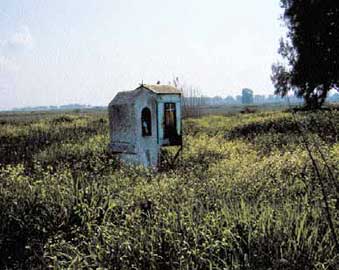 Μοσχονέρι. Το "διπλό" εικονοστάσι των "δίδυμων" θεραπευτών αγίων Αναργύρων που αναφέρεται στη μαρτυρία (Μάρτιος 2007).
Το άρθρο περιέχει προφορική μαρτυρία όπως προέκυψε από τη συνομιλία της γράφουσας με μια γυναίκα, παραδοσιακή γιάτρισσα, που έλαβε χώρα κατά τη διάρκεια επιτόπιας λαογραφικής έρευνας στην Ηλεία, κατά τον Αύγουστο του 1989. Δημοσιεύεται ως αντιπροσωπευτική μιας «εκ των έσω» (emic) κατάθεσης της λαϊκής αντίληψης για την υγεία, την ασθένεια, τις μεταφυσικές δυνάμεις, την πίστη στις θαυματουργές ιδιότητες ιερών τόπων και τη σημασία τους για την ίαση σωματικών και πνευματικών ασθενειών. Επίσης, γιατί αναδεικνύει όψεις της όσμωσης ή/και της σύγκρουσης μεταξύ εγγραμματοσύνης και προφορικότητας, παράδοσης και νεωτερικότητας, παραδοσιακής και επιστημονικής ιατρικής, χριστιανικής διδαχής και λαϊκής πίστης και λατρείας.
Μοσχονέρι. Το "διπλό" εικονοστάσι των "δίδυμων" θεραπευτών αγίων Αναργύρων που αναφέρεται στη μαρτυρία (Μάρτιος 2007).
Το άρθρο περιέχει προφορική μαρτυρία όπως προέκυψε από τη συνομιλία της γράφουσας με μια γυναίκα, παραδοσιακή γιάτρισσα, που έλαβε χώρα κατά τη διάρκεια επιτόπιας λαογραφικής έρευνας στην Ηλεία, κατά τον Αύγουστο του 1989. Δημοσιεύεται ως αντιπροσωπευτική μιας «εκ των έσω» (emic) κατάθεσης της λαϊκής αντίληψης για την υγεία, την ασθένεια, τις μεταφυσικές δυνάμεις, την πίστη στις θαυματουργές ιδιότητες ιερών τόπων και τη σημασία τους για την ίαση σωματικών και πνευματικών ασθενειών. Επίσης, γιατί αναδεικνύει όψεις της όσμωσης ή/και της σύγκρουσης μεταξύ εγγραμματοσύνης και προφορικότητας, παράδοσης και νεωτερικότητας, παραδοσιακής και επιστημονικής ιατρικής, χριστιανικής διδαχής και λαϊκής πίστης και λατρείας.
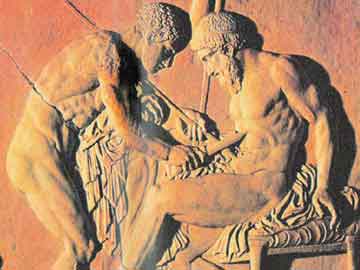 Ο Αχιλλέας θεραπεύει τον Τήλεφο (Αρχαιολογικό Μουσείο Νεαπόλεως).
Η εμφάνιση της ομοιοπαθητικής ιατρικής στην Ελλάδα συντελείται στα μέσα της δεκαετίας 1960-1970, και συνδέεται, μέχρι και σήμερα, με το έργο του Γεώργιου Βυθούλκα. Εξασκείται αποκλειστικά από γιατρούς, οι οποίοι, αν και δεν ξεπερνούν τους 250, έχουν καταφέρει να εξετάσουν το 20% του ελληνικού πληθυσμού. Αν και η ανταπόκριση στο σώμα των ασθενών φαίνεται αρκούντως σημαντική, και σαφώς η μεγαλύτερη όσον αφορά στις εναλλακτικές ιατρικές, η αποδοχή της από την ακαδημαϊκή ιατρική παραμένει πτωχή. Το μεγαλύτερο, όμως, έλλειμμα στην Ελλάδα, παραμένει η έλλειψη θεσμικής κατοχύρωσης των ομοιοπαθητικών ιατρών, γεγονός που περιορίζει και την περαιτέρω εξάπλωσή της, και την καλύτερη συνεργασία με τον ακαδημαϊκό χώρο, αλλά και την επέκταση των ερευνητικών προσπαθειών, οι οποίες κινούνται σε πολύ ρηχό επίπεδο. Παρ’ όλα αυτά, η ελληνική ομοιοπαθητική ιατρική θεωρείται, ως προς τους ποιοτικούς όρους, από τους πρωτοπόρους του παγκόσμιου ομοιοπαθητικού κινήματος.
Ο Αχιλλέας θεραπεύει τον Τήλεφο (Αρχαιολογικό Μουσείο Νεαπόλεως).
Η εμφάνιση της ομοιοπαθητικής ιατρικής στην Ελλάδα συντελείται στα μέσα της δεκαετίας 1960-1970, και συνδέεται, μέχρι και σήμερα, με το έργο του Γεώργιου Βυθούλκα. Εξασκείται αποκλειστικά από γιατρούς, οι οποίοι, αν και δεν ξεπερνούν τους 250, έχουν καταφέρει να εξετάσουν το 20% του ελληνικού πληθυσμού. Αν και η ανταπόκριση στο σώμα των ασθενών φαίνεται αρκούντως σημαντική, και σαφώς η μεγαλύτερη όσον αφορά στις εναλλακτικές ιατρικές, η αποδοχή της από την ακαδημαϊκή ιατρική παραμένει πτωχή. Το μεγαλύτερο, όμως, έλλειμμα στην Ελλάδα, παραμένει η έλλειψη θεσμικής κατοχύρωσης των ομοιοπαθητικών ιατρών, γεγονός που περιορίζει και την περαιτέρω εξάπλωσή της, και την καλύτερη συνεργασία με τον ακαδημαϊκό χώρο, αλλά και την επέκταση των ερευνητικών προσπαθειών, οι οποίες κινούνται σε πολύ ρηχό επίπεδο. Παρ’ όλα αυτά, η ελληνική ομοιοπαθητική ιατρική θεωρείται, ως προς τους ποιοτικούς όρους, από τους πρωτοπόρους του παγκόσμιου ομοιοπαθητικού κινήματος.
 Αρχαίες βελόνες όπως απεικονίζονται στο Βιβλίο ιατρικής Νέι Κινγκ.
Ο βελονισμός είναι από τις αρχαιότερες θεραπευτικές τεχνικές που χρησιμοποιήθηκαν στον πλανήτη. Κοιτίδα της αρχαίας αυτής θεραπευτικής τέχνης θεωρείται η Κίνα. Από αρχαιολογικά ευρήματα προκύπτει ότι στην ιστορική περίοδο 2698 και 2599 π.Χ. άκμασε στην περιοχή του κίτρινου ποταμού ένας σπουδαίος πολιτισμός που παρήγαγε μεγάλες ανακαλύψεις σε γράμματα, επιστήμες και τέχνες. Την ίδια περίοδο γράφτηκε ένα μεγάλο ιατρικό έργο (ονομάστηκε Βιβλίο Ιατρικής), στο οποίο περιγράφονται αναλυτικά, για πρώτη φορά σε ιατρικό σύγγραμμα, οι βασικές θεωρίες στις οποίες στηρίζεται η θεραπευτική του βελονισμού. Από νεότερες επανεκδόσεις του μαθαίνουμε ότι η κινεζική ιατρική στηρίζεται την εποχή εκείνη στη φαρμακολογία (αναφέρονται 2.000 συνταγές σκευασμάτων από βότανα), στη χειρουργική και στο βελονισμό. Στο σύγγραμμα περιγράφονται αναλυτικά οι βασικές θεωρίες στις οποίες στηρίζεται η παραδοσιακή κινεζική ιατρική, οι μεσημβρινοί, τα σημεία βελονισμού, οι τύποι των βελονών και η χρήση τους, οι κανόνες θεραπευτικής καθώς και διαγνωστικές μέθοδοι της εποχής, όπως η ψηλάφηση των σφυγμών, η επισκόπηση της γλώσσας και η λήψη ιστορικού από τον ασθενή. Στις σελίδες του Βιβλίου Ιατρικής παρατίθενται ανεκτίμητης ιστορικής αξίας πληροφορίες για τα ισχύοντα την εποχή εκείνη στοιχεία ανατομίας και φυσιολογίας των οργάνων, με σχήματα και αναλυτικές περιγραφές της καρδιακής, πνευμονικής και ηπατικής λειτουργίας. Γνωρίζοντας περιόδους ακμής (δυναστεία των Μινγκ, 1368-1644 μ.Χ.) και παρακμής (δυναστεία Dao Guang, 1822-1950 μ.Χ.) το θεραπευτικό σύστημα του βελονισμού παρέμεινε αναλλοίωτο μέχρι τις μέρες μας. Την τελευταία εικοσαετία έχουν γραφτεί σε δυτικά περιοδικά πάνω από 5.000 ιατρικές μελέτες που αφορούν στο βελονισμό, ενώ έχουν εκδοθεί εκατοντάδες βιβλία που εξετάζουν τη «μυστηριώδη» φύση του. Στην Ελλάδα, η πρώτη επιστημονική εταιρεία βελονισμού ιδρύθηκε στην Αθήνα το 1973 με πρωτοβουλία του παιδιάτρου Γιάγκου Καράβη. Το επιστημονικό, εκπαιδευτικό και επιμορφωτικό της έργο συνεχίζεται μέχρι σήμερα.
Αρχαίες βελόνες όπως απεικονίζονται στο Βιβλίο ιατρικής Νέι Κινγκ.
Ο βελονισμός είναι από τις αρχαιότερες θεραπευτικές τεχνικές που χρησιμοποιήθηκαν στον πλανήτη. Κοιτίδα της αρχαίας αυτής θεραπευτικής τέχνης θεωρείται η Κίνα. Από αρχαιολογικά ευρήματα προκύπτει ότι στην ιστορική περίοδο 2698 και 2599 π.Χ. άκμασε στην περιοχή του κίτρινου ποταμού ένας σπουδαίος πολιτισμός που παρήγαγε μεγάλες ανακαλύψεις σε γράμματα, επιστήμες και τέχνες. Την ίδια περίοδο γράφτηκε ένα μεγάλο ιατρικό έργο (ονομάστηκε Βιβλίο Ιατρικής), στο οποίο περιγράφονται αναλυτικά, για πρώτη φορά σε ιατρικό σύγγραμμα, οι βασικές θεωρίες στις οποίες στηρίζεται η θεραπευτική του βελονισμού. Από νεότερες επανεκδόσεις του μαθαίνουμε ότι η κινεζική ιατρική στηρίζεται την εποχή εκείνη στη φαρμακολογία (αναφέρονται 2.000 συνταγές σκευασμάτων από βότανα), στη χειρουργική και στο βελονισμό. Στο σύγγραμμα περιγράφονται αναλυτικά οι βασικές θεωρίες στις οποίες στηρίζεται η παραδοσιακή κινεζική ιατρική, οι μεσημβρινοί, τα σημεία βελονισμού, οι τύποι των βελονών και η χρήση τους, οι κανόνες θεραπευτικής καθώς και διαγνωστικές μέθοδοι της εποχής, όπως η ψηλάφηση των σφυγμών, η επισκόπηση της γλώσσας και η λήψη ιστορικού από τον ασθενή. Στις σελίδες του Βιβλίου Ιατρικής παρατίθενται ανεκτίμητης ιστορικής αξίας πληροφορίες για τα ισχύοντα την εποχή εκείνη στοιχεία ανατομίας και φυσιολογίας των οργάνων, με σχήματα και αναλυτικές περιγραφές της καρδιακής, πνευμονικής και ηπατικής λειτουργίας. Γνωρίζοντας περιόδους ακμής (δυναστεία των Μινγκ, 1368-1644 μ.Χ.) και παρακμής (δυναστεία Dao Guang, 1822-1950 μ.Χ.) το θεραπευτικό σύστημα του βελονισμού παρέμεινε αναλλοίωτο μέχρι τις μέρες μας. Την τελευταία εικοσαετία έχουν γραφτεί σε δυτικά περιοδικά πάνω από 5.000 ιατρικές μελέτες που αφορούν στο βελονισμό, ενώ έχουν εκδοθεί εκατοντάδες βιβλία που εξετάζουν τη «μυστηριώδη» φύση του. Στην Ελλάδα, η πρώτη επιστημονική εταιρεία βελονισμού ιδρύθηκε στην Αθήνα το 1973 με πρωτοβουλία του παιδιάτρου Γιάγκου Καράβη. Το επιστημονικό, εκπαιδευτικό και επιμορφωτικό της έργο συνεχίζεται μέχρι σήμερα.
 Το εσωτερικό της Μονής του Αγίου Μερκουρίου (φωτ. Μαρία Ανδρουλάκη, 16.8.2005).
Το άρθρο αυτό πραγματεύεται μια λαϊκή πρακτική ίασης που συνδέεται με τη λατρεία του Αγίου Μερκουρίου στο χωριό Ίστριος της Νότιας Ρόδου. Κατά τη λαϊκή πίστη και λατρεία ο Άγιος Μερκούριος έχει συνδεθεί με την πεποίθηση ότι θεραπεύει τον πόνο στα αυτιά. Ως τόπος, το μοναστηράκι του Αγίου Μερκουρίου στο νεκροταφείο του χωριού προσελκύει και από τα γύρω χωριά προσκυνητές, οι οποίοι μέσα από παραδοσιακά πρότυπα θρησκευτικής συμπεριφοράς επιδιώκουν την ίαση των ιδίων ή μελών της οικογένειάς τους. Ιδιαίτερη έμφαση δίδεται στο χορό, που ασκείται από τον πάσχοντα μπροστά στην εικόνα του Αγίου και στις συμβολικές ενέργειες στις οποίες προβαίνει ο προσκυνητής, μέσω των οποίων επιδιώκει τη θεραπεία του και την ενσωμάτωσή του σε μια νέα κατάσταση σωματική και ψυχική.
Το εσωτερικό της Μονής του Αγίου Μερκουρίου (φωτ. Μαρία Ανδρουλάκη, 16.8.2005).
Το άρθρο αυτό πραγματεύεται μια λαϊκή πρακτική ίασης που συνδέεται με τη λατρεία του Αγίου Μερκουρίου στο χωριό Ίστριος της Νότιας Ρόδου. Κατά τη λαϊκή πίστη και λατρεία ο Άγιος Μερκούριος έχει συνδεθεί με την πεποίθηση ότι θεραπεύει τον πόνο στα αυτιά. Ως τόπος, το μοναστηράκι του Αγίου Μερκουρίου στο νεκροταφείο του χωριού προσελκύει και από τα γύρω χωριά προσκυνητές, οι οποίοι μέσα από παραδοσιακά πρότυπα θρησκευτικής συμπεριφοράς επιδιώκουν την ίαση των ιδίων ή μελών της οικογένειάς τους. Ιδιαίτερη έμφαση δίδεται στο χορό, που ασκείται από τον πάσχοντα μπροστά στην εικόνα του Αγίου και στις συμβολικές ενέργειες στις οποίες προβαίνει ο προσκυνητής, μέσω των οποίων επιδιώκει τη θεραπεία του και την ενσωμάτωσή του σε μια νέα κατάσταση σωματική και ψυχική.
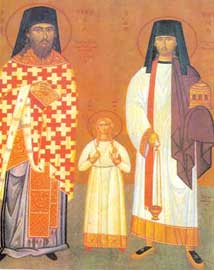 Άγιος Ραφαήλ, Άγιος Νικόλαος, Αγία Ειρήνη.
Στο άρθρο αυτό θα προσεγγίσουμε την αναζήτηση θεραπείας από τη μια πλευρά ως ένα ενιαίο πεδίο από διαφορετικές και συχνά ετερόκλιτες θεραπευτικές προτάσεις και από την άλλη ως ένα σύνολο από διαδρομές, στάσεις, αναθεωρήσεις και επιστροφές. Μέσα σ’ αυτό το πεδίο, η ιατρική γίνεται μια θεραπεία μεταξύ άλλων, χωρίς ωστόσο να χάνει την ηγεμονική θέση της. Αντίστοιχα, η Ορθόδοξη Εκκλησία εκφέρει έναν ισχυρό θεραπευτικό λόγο, ειδικά στην περίπτωση της ψυχικής διαταραχής, μια και φαίνεται να είναι ο κύριος διαχειριστής της αναπαράστασης του εσωτερικού κόσμου, δίνοντας έμφαση στη θρησκευτική πρόσληψη της ψυχής. Οι γυναίκες ασθενείς που διαγνώστηκαν ως καταθλιπτικές στο Κέντρο Ψυχικής Υγείας κατορθώνουν να αντιμετωπίσουν την ασυμφωνία των επιλογών τους μέσα από υβριδικές εξηγήσεις, στις οποίες αφομοίωσαν στοιχεία από διαφορετικές θεραπείες που κατά καιρούς δοκίμασαν. Τα θεραπευτικά δρομολόγια ωστόσο ερμηνεύονται από τους θεραπευτές ως ανυπακοή στη διαγνωστική και θεραπευτική εξουσία τους και τιμωρούνται ως παραλήρημα με αύξηση των ψυχοφαρμάκων από το γιατρό και ως αμαρτία από τον παπά με την επιβολή συχνής εξομολόγησης. Απέναντί τους οι ασθενείς κερδίζουν ή διαπραγματεύονται την ελευθερία των επιλογών τους και έναν προσωπικό λόγο για το πρόβλημά τους –και άρα μια πιο ενδυναμωμένη θέση απέναντι στην ανδρική θεραπευτική εξουσία–, μέσα από την άσκηση της υπόγειας δύναμης του ψέματος.
Άγιος Ραφαήλ, Άγιος Νικόλαος, Αγία Ειρήνη.
Στο άρθρο αυτό θα προσεγγίσουμε την αναζήτηση θεραπείας από τη μια πλευρά ως ένα ενιαίο πεδίο από διαφορετικές και συχνά ετερόκλιτες θεραπευτικές προτάσεις και από την άλλη ως ένα σύνολο από διαδρομές, στάσεις, αναθεωρήσεις και επιστροφές. Μέσα σ’ αυτό το πεδίο, η ιατρική γίνεται μια θεραπεία μεταξύ άλλων, χωρίς ωστόσο να χάνει την ηγεμονική θέση της. Αντίστοιχα, η Ορθόδοξη Εκκλησία εκφέρει έναν ισχυρό θεραπευτικό λόγο, ειδικά στην περίπτωση της ψυχικής διαταραχής, μια και φαίνεται να είναι ο κύριος διαχειριστής της αναπαράστασης του εσωτερικού κόσμου, δίνοντας έμφαση στη θρησκευτική πρόσληψη της ψυχής. Οι γυναίκες ασθενείς που διαγνώστηκαν ως καταθλιπτικές στο Κέντρο Ψυχικής Υγείας κατορθώνουν να αντιμετωπίσουν την ασυμφωνία των επιλογών τους μέσα από υβριδικές εξηγήσεις, στις οποίες αφομοίωσαν στοιχεία από διαφορετικές θεραπείες που κατά καιρούς δοκίμασαν. Τα θεραπευτικά δρομολόγια ωστόσο ερμηνεύονται από τους θεραπευτές ως ανυπακοή στη διαγνωστική και θεραπευτική εξουσία τους και τιμωρούνται ως παραλήρημα με αύξηση των ψυχοφαρμάκων από το γιατρό και ως αμαρτία από τον παπά με την επιβολή συχνής εξομολόγησης. Απέναντί τους οι ασθενείς κερδίζουν ή διαπραγματεύονται την ελευθερία των επιλογών τους και έναν προσωπικό λόγο για το πρόβλημά τους –και άρα μια πιο ενδυναμωμένη θέση απέναντι στην ανδρική θεραπευτική εξουσία–, μέσα από την άσκηση της υπόγειας δύναμης του ψέματος.
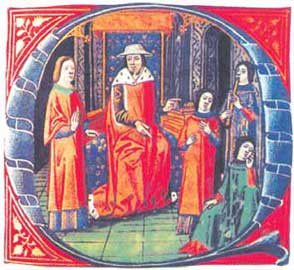 Ο αρχαίος γιατρός Γαληνός απεικονίζεται με μεσαιωνική ενδυμασία να δέχεται δύο ασθενείς (Κώδικας Δρέσδης).
Σκοπός αυτού του άρθρου είναι να εξετάσουμε με ποιους τρόπους και ποιους λόγους η διαχρονική προσέγγιση και η χρήση ιστορικών αναφορών μπορεί να συμβάλει στην κριτική ανασκόπηση και την ερμηνευτική προσέγγιση της διαδικασίας και των αποτελεσμάτων του μεταρρυθμιστικού εγχειρήματος στο χώρο των ψυχιατρικών υπηρεσιών. Προσεγγίζουμε την ιστορία ως καταλύτη στην κατανόηση και την αλλαγή του παρόντος στη διαδικασία της ψυχιατρικής μεταρρύθμισης. Η υπόθεσή μας δεν στηρίζεται σε μια ισοπεδωτική κριτική για το όλο μεταρρυθμιστικό εγχείρημα, ούτε σ’ έναν ατέρμονο σχετικισμό, αλλά στη θέση ότι με μια νηφάλια απόσταση από ιδεολογικές παραμορφώσεις της πραγματικότητας, αναγνωρίζουμε διαφορετικές μορφές και επίπεδα ανάλυσης, προκειμένου να νοηματοδοτηθούν με επάρκεια. Γίνεται διαχρονική προσέγγιση από την αρχαιότητα, την εποχή του Βυζαντίου και ως τη σύγχρονη μεταρρύθμιση των ψυχιατρικών υπηρεσιών. Η κριτική ανάγνωση αυτών των πηγών μάς οδηγεί στο συμπέρασμα ότι η νέα ψυχιατρική μεταρρυθμιστική κουλτούρα, αν θέλει να συγκροτήσει μια άλλη επιστημολογική αντίληψη και πρακτική, οφείλει να παρατηρήσει με συστηματικό αναστοχασμό το παρελθόν μας και την αντιφατική ταυτότητά μας. Επιβάλλεται να συγκροτήσει μια νέα ιστορική αφήγηση στην εποχή του μετα-μοντερνισμού, ένα άλλο δίκτυο σημασιών. Η τοπική εμπειρία, η ανθρωπολογική παρατήρηση της καθημερινής ψυχιατρικής πράξης μπορεί να ερμηνεύσει όχι το πόσο αλλά το πώς και γιατί, εγγράφοντας το πάσχον υποκείμενο σε μια νέα συμβολική γεωγραφία αξιών και πολιτισμικών κωδίκων μιας νέας αντίληψης για την ψυχική νόσο και την ψυχική υγεία.
Ο αρχαίος γιατρός Γαληνός απεικονίζεται με μεσαιωνική ενδυμασία να δέχεται δύο ασθενείς (Κώδικας Δρέσδης).
Σκοπός αυτού του άρθρου είναι να εξετάσουμε με ποιους τρόπους και ποιους λόγους η διαχρονική προσέγγιση και η χρήση ιστορικών αναφορών μπορεί να συμβάλει στην κριτική ανασκόπηση και την ερμηνευτική προσέγγιση της διαδικασίας και των αποτελεσμάτων του μεταρρυθμιστικού εγχειρήματος στο χώρο των ψυχιατρικών υπηρεσιών. Προσεγγίζουμε την ιστορία ως καταλύτη στην κατανόηση και την αλλαγή του παρόντος στη διαδικασία της ψυχιατρικής μεταρρύθμισης. Η υπόθεσή μας δεν στηρίζεται σε μια ισοπεδωτική κριτική για το όλο μεταρρυθμιστικό εγχείρημα, ούτε σ’ έναν ατέρμονο σχετικισμό, αλλά στη θέση ότι με μια νηφάλια απόσταση από ιδεολογικές παραμορφώσεις της πραγματικότητας, αναγνωρίζουμε διαφορετικές μορφές και επίπεδα ανάλυσης, προκειμένου να νοηματοδοτηθούν με επάρκεια. Γίνεται διαχρονική προσέγγιση από την αρχαιότητα, την εποχή του Βυζαντίου και ως τη σύγχρονη μεταρρύθμιση των ψυχιατρικών υπηρεσιών. Η κριτική ανάγνωση αυτών των πηγών μάς οδηγεί στο συμπέρασμα ότι η νέα ψυχιατρική μεταρρυθμιστική κουλτούρα, αν θέλει να συγκροτήσει μια άλλη επιστημολογική αντίληψη και πρακτική, οφείλει να παρατηρήσει με συστηματικό αναστοχασμό το παρελθόν μας και την αντιφατική ταυτότητά μας. Επιβάλλεται να συγκροτήσει μια νέα ιστορική αφήγηση στην εποχή του μετα-μοντερνισμού, ένα άλλο δίκτυο σημασιών. Η τοπική εμπειρία, η ανθρωπολογική παρατήρηση της καθημερινής ψυχιατρικής πράξης μπορεί να ερμηνεύσει όχι το πόσο αλλά το πώς και γιατί, εγγράφοντας το πάσχον υποκείμενο σε μια νέα συμβολική γεωγραφία αξιών και πολιτισμικών κωδίκων μιας νέας αντίληψης για την ψυχική νόσο και την ψυχική υγεία.
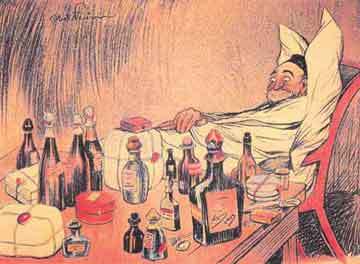 Έγχρωμη λιθογραφία του Abel Faivre, από το γαλλικό περιοδικό L'assiette au Beurre (1902), που σατιρίζει την πολυφαρμακία.
Το άρθρο αυτό βασίζεται σε εθνογραφική έρευνα που διεξήγαγε η συγγραφέας στην Κρήτη το καλοκαίρι του 2002 και του 2003, στους θαλάμους των καρκινοπαθών στο Περιφερειακό Πανεπιστημιακό Γενικό Νοσοκομείο του Ηρακλείου. Οι περιγραφές των ασθενών όσον αφορά τις υποκειμενικές εμπειρίες τους, τόσο στις νοσοκομειακές πτέρυγες καρκινοπαθών, σε «κλινικές του πόνου» και κατ’ οίκον, αποκαλύπτουν την απώλεια ελέγχου της ζωής τους και την υποταγή της τύχης τους στην εξουσία της βιο-ιατρικής. Η διαδικασία αυτή αναλύεται σε σχέση με τις ανθρωπολογικές όψεις του πόνου στο πλαίσιο της σύγχρονης επιστήμης και τεχνολογίας, που χαρακτηρίζονται από την ηγεμονία της εξουσιαστικής ιατρικής γνώσης και της βιο-πολιτικής. Η πολιτική διάσταση της νόσου γίνεται φανερή μέσα από τις αριστοτελικές έννοιες της ζωής και του βίου: η ζωή, με τη βιολογική διάσταση του όρου, δηλαδή η πρωτόγονη, «ζωώδης», ενστικτώδης μέριμνα για τη διατήρηση του ατόμου, αλλά και του είδους, βρίσκεται σε συνεχή αναμέτρηση με το βίο, δηλαδή με την «ποιοτική ζωή», την οποία συνθέτουν τα ιδεολογικά μορφώματα πολιτισμικών βάσεων που συγκροτούν και στηρίζουν τις ιστορικές κοινωνικές συλλογικότητες. Η συγκεκριμένη αναμέτρηση εκδηλώνεται ολοφάνερα στην πορεία της νόσου. Το προσδόκιμο της ζωής έρχεται να αποτελέσει πλέον το στοίχημα των πολιτικών στρατηγικών της βιο-εξουσίας. Η πολιτικοποίηση της ζωής στην υπηρεσία του βίου είναι έκδηλη στις σύγχρονες μονάδες καρκινοπαθών – η «ζώνη του μη-διακριτού», ως χώρος της καθυποταγμένης εξατομίκευσης του υποκειμένου (καθώς ο σύγχρονος μαχητής του καρκίνου διεξάγει έναν πόλεμο ενάντια στο ίδιο του το σώμα) και ενός αντικειμενικά υπαρκτού ολοκληρωτισμού (καθώς η δυτική βιο-ιατρική τεχνολογία θεωρείται ως η μόνη αποτελεσματική θεραπευτική αγωγή της νόσου, από την οποία ο ασθενής εξαρτάται άμεσα).
Έγχρωμη λιθογραφία του Abel Faivre, από το γαλλικό περιοδικό L'assiette au Beurre (1902), που σατιρίζει την πολυφαρμακία.
Το άρθρο αυτό βασίζεται σε εθνογραφική έρευνα που διεξήγαγε η συγγραφέας στην Κρήτη το καλοκαίρι του 2002 και του 2003, στους θαλάμους των καρκινοπαθών στο Περιφερειακό Πανεπιστημιακό Γενικό Νοσοκομείο του Ηρακλείου. Οι περιγραφές των ασθενών όσον αφορά τις υποκειμενικές εμπειρίες τους, τόσο στις νοσοκομειακές πτέρυγες καρκινοπαθών, σε «κλινικές του πόνου» και κατ’ οίκον, αποκαλύπτουν την απώλεια ελέγχου της ζωής τους και την υποταγή της τύχης τους στην εξουσία της βιο-ιατρικής. Η διαδικασία αυτή αναλύεται σε σχέση με τις ανθρωπολογικές όψεις του πόνου στο πλαίσιο της σύγχρονης επιστήμης και τεχνολογίας, που χαρακτηρίζονται από την ηγεμονία της εξουσιαστικής ιατρικής γνώσης και της βιο-πολιτικής. Η πολιτική διάσταση της νόσου γίνεται φανερή μέσα από τις αριστοτελικές έννοιες της ζωής και του βίου: η ζωή, με τη βιολογική διάσταση του όρου, δηλαδή η πρωτόγονη, «ζωώδης», ενστικτώδης μέριμνα για τη διατήρηση του ατόμου, αλλά και του είδους, βρίσκεται σε συνεχή αναμέτρηση με το βίο, δηλαδή με την «ποιοτική ζωή», την οποία συνθέτουν τα ιδεολογικά μορφώματα πολιτισμικών βάσεων που συγκροτούν και στηρίζουν τις ιστορικές κοινωνικές συλλογικότητες. Η συγκεκριμένη αναμέτρηση εκδηλώνεται ολοφάνερα στην πορεία της νόσου. Το προσδόκιμο της ζωής έρχεται να αποτελέσει πλέον το στοίχημα των πολιτικών στρατηγικών της βιο-εξουσίας. Η πολιτικοποίηση της ζωής στην υπηρεσία του βίου είναι έκδηλη στις σύγχρονες μονάδες καρκινοπαθών – η «ζώνη του μη-διακριτού», ως χώρος της καθυποταγμένης εξατομίκευσης του υποκειμένου (καθώς ο σύγχρονος μαχητής του καρκίνου διεξάγει έναν πόλεμο ενάντια στο ίδιο του το σώμα) και ενός αντικειμενικά υπαρκτού ολοκληρωτισμού (καθώς η δυτική βιο-ιατρική τεχνολογία θεωρείται ως η μόνη αποτελεσματική θεραπευτική αγωγή της νόσου, από την οποία ο ασθενής εξαρτάται άμεσα).
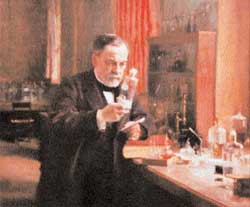 Ο Λουί Παστέρ στο εργαστήριό του.
Η μελέτη της αρχαίας ελληνικής γραμματείας μάς αποκαλύπτει πολύ ενδιαφέροντα στοιχεία για τη ζωή και την οργάνωση των αρχαίων κοινωνιών. Έτσι, πληροφορούμεθα από τον Ηρόδοτο ότι στην αρχαιότητα υπήρχαν αυστηροί κανονισμοί στην Περσία για την προστασία του περιβάλλοντος, της υγείας και της ποιότητας ζωής των πολιτών της απέραντης αυτοκρατορίας. Πιο συγκεκριμένα, στο βιβλίο Α.138, οι Πέρσες βασιλείς, όταν έφευγαν για κάποια εκστρατεία, το νερό, που θα χρησιμοποιούσαν, το έβραζαν πρώτα και μετά το μετάγγιζαν σε ασημένια κανάτια, που τα φόρτωναν σε ημιόνους. Αυτή η αποστείρωση του νερού θυμίζει εκείνη που εφάρμοσε αιώνες αργότερα ο μεγάλος χημικός Λουί Παστέρ. Μια διαδικασία που προς τιμήν του ονόμασαν παστερίωση. Ο Ηρόδοτος αναφέρει και μια άλλη πολύ ενδιαφέρουσα περίπτωση, που αφορούσε στην προστασία του περιβάλλοντος. Ένας πολύ αυστηρός νόμος απαγόρευε στους Πέρσες πολίτες, αλλά και τους ξένους επισκέπτες, να μολύνουν τα ποτάμια με τον τρόπο που αναφέρεται στα κείμενά του. Τέλος, εντύπωση προκαλεί η μεγάλη ευαισθησία του Ηροδότου στα παραπάνω θέματα σε τέτοιο βαθμό που τον οδηγεί στην καταγραφή τους.
Οι Έλληνες πάλι εφάρμοζαν έναν πολύ ενδιαφέροντα τρόπο για την αποστείρωση του πόσιμου νερού. Στην εποχή μας θα τον χαρακτηρίζαμε ως μια χημική μέθοδο, αφού η μεγάλη αραίωση του κρασιού με νερό (1 μέρος κρασί με 9 μέρη νερού) δημιουργεί, κατά τον καθηγητή Γερουλάνο, πολυφαινόλες, που καταστρέφουν πολλά επιβλαβή μικρόβια.
Ο Λουί Παστέρ στο εργαστήριό του.
Η μελέτη της αρχαίας ελληνικής γραμματείας μάς αποκαλύπτει πολύ ενδιαφέροντα στοιχεία για τη ζωή και την οργάνωση των αρχαίων κοινωνιών. Έτσι, πληροφορούμεθα από τον Ηρόδοτο ότι στην αρχαιότητα υπήρχαν αυστηροί κανονισμοί στην Περσία για την προστασία του περιβάλλοντος, της υγείας και της ποιότητας ζωής των πολιτών της απέραντης αυτοκρατορίας. Πιο συγκεκριμένα, στο βιβλίο Α.138, οι Πέρσες βασιλείς, όταν έφευγαν για κάποια εκστρατεία, το νερό, που θα χρησιμοποιούσαν, το έβραζαν πρώτα και μετά το μετάγγιζαν σε ασημένια κανάτια, που τα φόρτωναν σε ημιόνους. Αυτή η αποστείρωση του νερού θυμίζει εκείνη που εφάρμοσε αιώνες αργότερα ο μεγάλος χημικός Λουί Παστέρ. Μια διαδικασία που προς τιμήν του ονόμασαν παστερίωση. Ο Ηρόδοτος αναφέρει και μια άλλη πολύ ενδιαφέρουσα περίπτωση, που αφορούσε στην προστασία του περιβάλλοντος. Ένας πολύ αυστηρός νόμος απαγόρευε στους Πέρσες πολίτες, αλλά και τους ξένους επισκέπτες, να μολύνουν τα ποτάμια με τον τρόπο που αναφέρεται στα κείμενά του. Τέλος, εντύπωση προκαλεί η μεγάλη ευαισθησία του Ηροδότου στα παραπάνω θέματα σε τέτοιο βαθμό που τον οδηγεί στην καταγραφή τους.
Οι Έλληνες πάλι εφάρμοζαν έναν πολύ ενδιαφέροντα τρόπο για την αποστείρωση του πόσιμου νερού. Στην εποχή μας θα τον χαρακτηρίζαμε ως μια χημική μέθοδο, αφού η μεγάλη αραίωση του κρασιού με νερό (1 μέρος κρασί με 9 μέρη νερού) δημιουργεί, κατά τον καθηγητή Γερουλάνο, πολυφαινόλες, που καταστρέφουν πολλά επιβλαβή μικρόβια.
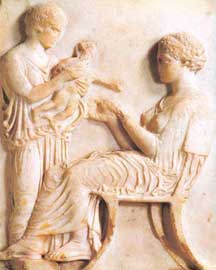 Ταφικό ανάγλυφο με μητέρα και παιδί, 420-410 π.Χ., αττικό μάρμαρο.
Το συγκεκριμένο άρθρο εξετάζει διαχρονικά το φαινόμενο του «θετού» ή «επί πληρωμή» θηλασμού ξεκινώντας από την αρχαία Ελλάδα και τη Ρώμη, συνεχίζοντας με το Βυζάντιο και τη μεσαιωνική Ευρώπη και καταλήγει με την εξέταση των συνθηκών που έκαναν το θετό θηλασμό να πάρει μεγάλες διαστάσεις στη Γαλλία του 18ου αιώνα.
Καταβλήθηκε προσπάθεια να επισημανθούν όλες οι παράμετροι του φαινομένου: ψυχολογικές, κοινωνικές και οικονομικές, μέσα στο πλαίσιο και τους περιορισμούς ενός άρθρου.
Ταφικό ανάγλυφο με μητέρα και παιδί, 420-410 π.Χ., αττικό μάρμαρο.
Το συγκεκριμένο άρθρο εξετάζει διαχρονικά το φαινόμενο του «θετού» ή «επί πληρωμή» θηλασμού ξεκινώντας από την αρχαία Ελλάδα και τη Ρώμη, συνεχίζοντας με το Βυζάντιο και τη μεσαιωνική Ευρώπη και καταλήγει με την εξέταση των συνθηκών που έκαναν το θετό θηλασμό να πάρει μεγάλες διαστάσεις στη Γαλλία του 18ου αιώνα.
Καταβλήθηκε προσπάθεια να επισημανθούν όλες οι παράμετροι του φαινομένου: ψυχολογικές, κοινωνικές και οικονομικές, μέσα στο πλαίσιο και τους περιορισμούς ενός άρθρου.
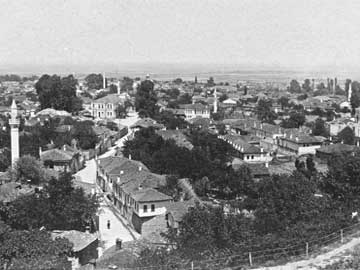 Η οθωμανική αρχιτεκτονική της Βέροιας, καλά κρυμμένη μέσα στην πόλη, αποτελεί τμήμα ενός παραμελημένου τμήματος της ιστορίας της αρχιτεκτονικής. Τζαμιά με μισοκατεστραμμένους μιναρέδες, οθωμανικά διοικητικά κτήρια και κτήρια εκπαίδευσης, λουτρά και γεφύρια, ξεπροβάλλουν ανάμεσα από κτίσματα βυζαντινής, παραδοσιακής και νεότερης αρχιτεκτονικής, αποτελώντας μάρτυρες μιας περιόδου δύσκολης αλλά και αρχιτεκτονικά δημιουργικής.
Η Βέροια υπέμεινε την τουρκική κατοχή από το 1430 έως το 1912 και ήταν μια από τις πόλεις με το μεγαλύτερο ποσοστό Τούρκων κατοίκων. Όλα αυτά τα χρόνια, οι Έλληνες κατοικούσαν στους χριστιανικούς μαχαλάδες με κέντρο τις εκκλησίες, ενώ οι μουσουλμάνοι στους τουρκικούς μαχαλάδες με κέντρο τα τζαμιά τους. Αφού οι κατακτητές μετέτρεψαν σε τεμένη τις μεγαλύτερες και ομορφότερες εκκλησίες της Βέροιας, έχτισαν και άλλα, εξαρχής. Πολλά από αυτά παρουσιάζουν ιδιαίτερο αρχιτεκτονικό και ιστορικό ενδιαφέρον.
Το Ορτά Τζαμί, το Μπογιαλί Τζαμί, το Τζαμί του Σούμπαση, το Τζαμί της Μπαρμπούτας, το Μπαΐρ Τζαμί και άλλα, είναι μερικά μόνο από τα δείγματα οθωμανικής αρχιτεκτονικής που άφησαν πίσω τους οι Τούρκοι.
Εκτός όμως από τα τζαμιά, στη Βέροια σώζονται και άλλα κτίσματα των Οθωμανών. Τα Δίδυμα Λουτρά του Σινάν του Αλατά αποτελούν χαρακτηριστικό δείγμα του είδους τους και έχουν να επιδείξουν πολλές αρχιτεκτονικές ιδιαιτερότητες. Επίσης, σήμερα σώζονται αποκατεστημένα τόσο το Οθωμανικό Διοικητήριο που στεγάζει το Δικαστικό Μέγαρο όσο και το Μουσουλμανικό Σχολείο που λειτουργεί βέβαια ως ελληνικό. Οι Οθωμανοί βέβαια άφησαν πίσω τους και άλλα κτήρια, ιδιωτικά κυρίως, τα οποία όμως είναι μικρότερης ιστορικής και αρχιτεκτονικής αξίας.
Τα περισσότερα από τα παραπάνω μνημεία παραμένουν σήμερα εγκαταλελειμμένα και σε κακή κατάσταση. Για το λόγο αυτό, είναι απαραίτητο να γίνει συνείδηση όλων μας η ανάγκη για την άμεση αποκατάσταση και προβολή τους.
Η οθωμανική αρχιτεκτονική της Βέροιας, καλά κρυμμένη μέσα στην πόλη, αποτελεί τμήμα ενός παραμελημένου τμήματος της ιστορίας της αρχιτεκτονικής. Τζαμιά με μισοκατεστραμμένους μιναρέδες, οθωμανικά διοικητικά κτήρια και κτήρια εκπαίδευσης, λουτρά και γεφύρια, ξεπροβάλλουν ανάμεσα από κτίσματα βυζαντινής, παραδοσιακής και νεότερης αρχιτεκτονικής, αποτελώντας μάρτυρες μιας περιόδου δύσκολης αλλά και αρχιτεκτονικά δημιουργικής.
Η Βέροια υπέμεινε την τουρκική κατοχή από το 1430 έως το 1912 και ήταν μια από τις πόλεις με το μεγαλύτερο ποσοστό Τούρκων κατοίκων. Όλα αυτά τα χρόνια, οι Έλληνες κατοικούσαν στους χριστιανικούς μαχαλάδες με κέντρο τις εκκλησίες, ενώ οι μουσουλμάνοι στους τουρκικούς μαχαλάδες με κέντρο τα τζαμιά τους. Αφού οι κατακτητές μετέτρεψαν σε τεμένη τις μεγαλύτερες και ομορφότερες εκκλησίες της Βέροιας, έχτισαν και άλλα, εξαρχής. Πολλά από αυτά παρουσιάζουν ιδιαίτερο αρχιτεκτονικό και ιστορικό ενδιαφέρον.
Το Ορτά Τζαμί, το Μπογιαλί Τζαμί, το Τζαμί του Σούμπαση, το Τζαμί της Μπαρμπούτας, το Μπαΐρ Τζαμί και άλλα, είναι μερικά μόνο από τα δείγματα οθωμανικής αρχιτεκτονικής που άφησαν πίσω τους οι Τούρκοι.
Εκτός όμως από τα τζαμιά, στη Βέροια σώζονται και άλλα κτίσματα των Οθωμανών. Τα Δίδυμα Λουτρά του Σινάν του Αλατά αποτελούν χαρακτηριστικό δείγμα του είδους τους και έχουν να επιδείξουν πολλές αρχιτεκτονικές ιδιαιτερότητες. Επίσης, σήμερα σώζονται αποκατεστημένα τόσο το Οθωμανικό Διοικητήριο που στεγάζει το Δικαστικό Μέγαρο όσο και το Μουσουλμανικό Σχολείο που λειτουργεί βέβαια ως ελληνικό. Οι Οθωμανοί βέβαια άφησαν πίσω τους και άλλα κτήρια, ιδιωτικά κυρίως, τα οποία όμως είναι μικρότερης ιστορικής και αρχιτεκτονικής αξίας.
Τα περισσότερα από τα παραπάνω μνημεία παραμένουν σήμερα εγκαταλελειμμένα και σε κακή κατάσταση. Για το λόγο αυτό, είναι απαραίτητο να γίνει συνείδηση όλων μας η ανάγκη για την άμεση αποκατάσταση και προβολή τους.
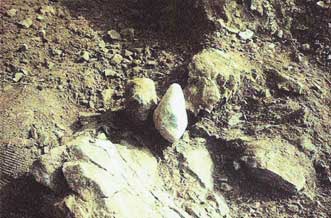 Rudna Glava, πελέκεις με οριζόντια εγκοπή.
Στο παρόν άρθρο θα επιχειρηθεί αξιοποίηση αρχαιολογικών δεδομένων προκειμένου να διερευνηθεί η κοινωνική και οικονομική πολυπλοκότητα που κρύβεται πίσω από τα ποικίλα επίπεδα της οργάνωσης της παραγωγής μετάλλων στη Βαλκανική χερσόνησο, δηλαδή από την εξόρυξη μέχρι την παραγωγή προϊόντων και την τελική διασπορά τους.
Δύο γνωστά και ιδιαίτερα σημαντικά ορυχεία της χαλκολιθικής εποχής θα χρησιμοποιηθούν ως αφετηρία σε αυτή την προσπάθεια: το Aibunar και η Rudna Glava, ενώ δεδομένα από την ευρύτερη περιοχή της Βουλγαρίας (οικισμούς και νεκροταφεία) θα ολοκληρώσουν την προτεινόμενη ερμηνεία.
Rudna Glava, πελέκεις με οριζόντια εγκοπή.
Στο παρόν άρθρο θα επιχειρηθεί αξιοποίηση αρχαιολογικών δεδομένων προκειμένου να διερευνηθεί η κοινωνική και οικονομική πολυπλοκότητα που κρύβεται πίσω από τα ποικίλα επίπεδα της οργάνωσης της παραγωγής μετάλλων στη Βαλκανική χερσόνησο, δηλαδή από την εξόρυξη μέχρι την παραγωγή προϊόντων και την τελική διασπορά τους.
Δύο γνωστά και ιδιαίτερα σημαντικά ορυχεία της χαλκολιθικής εποχής θα χρησιμοποιηθούν ως αφετηρία σε αυτή την προσπάθεια: το Aibunar και η Rudna Glava, ενώ δεδομένα από την ευρύτερη περιοχή της Βουλγαρίας (οικισμούς και νεκροταφεία) θα ολοκληρώσουν την προτεινόμενη ερμηνεία.
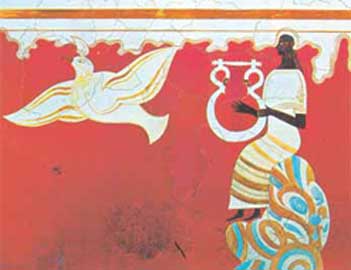 Τοιχογραφία από την αίθουσα του θρόνου του ανακτόρου της Πύλου (αναπαράσταση: Piet de Jong).
Τα μέγαρα των τριών σημαντικότερων μυκηναϊκών θέσεων στην Πελοπόννησο ακολουθούν το ίδιο πρότυπο αρχιτεκτονικής και διακόσμησης. Αποτελούνται από τρεις χώρους που επικοινωνούσαν εσωτερικά. Τα δάπεδα ήταν χωρισμένα σε τετράγωνα και ζωγραφισμένα με γεωμετρικά και θαλάσσια η αφηρημένα μοτίβα. Σώζονται ίχνη χρώματος. Στον δόμο όπου βρισκόταν και ο βασιλικός θρόνος υπήρχε στο κέντρο κυκλική εστία. Ήταν επίσης διακοσμημένη με φλογόμορφα ή άλλα σχέδια, χρωματισμένα. Όταν η διακόσμηση καταστρεφόταν συχνά την ανανέωναν περνώντας από πάνω το καινούριο στρώμα.
Οι τοίχοι ήταν ζωγραφισμένοι με εντυπωσιακές τοιχογραφίες με σκηνές κυνηγιού η πομπών. Αξιοπρόσεκτο είναι το αλαβάστρινο διάζωμα από την Τίρυνθα που έχει σωθεί. Διακοσμημένα ήταν επίσης οι οροφές αλλά υπολείμματα διακόσμησης από την οροφή δεν έχει σωθεί. Δεύτερο όροφο πρέπει να είχαν και τα τρία μέγαρα έστω και ξύλινο. Το εσωτερικό των μεγάρων αυτών πρέπει να ήταν αρκετά εντυπωσιακό ιδιαίτερα για την προϊστορική εποχή.
Τοιχογραφία από την αίθουσα του θρόνου του ανακτόρου της Πύλου (αναπαράσταση: Piet de Jong).
Τα μέγαρα των τριών σημαντικότερων μυκηναϊκών θέσεων στην Πελοπόννησο ακολουθούν το ίδιο πρότυπο αρχιτεκτονικής και διακόσμησης. Αποτελούνται από τρεις χώρους που επικοινωνούσαν εσωτερικά. Τα δάπεδα ήταν χωρισμένα σε τετράγωνα και ζωγραφισμένα με γεωμετρικά και θαλάσσια η αφηρημένα μοτίβα. Σώζονται ίχνη χρώματος. Στον δόμο όπου βρισκόταν και ο βασιλικός θρόνος υπήρχε στο κέντρο κυκλική εστία. Ήταν επίσης διακοσμημένη με φλογόμορφα ή άλλα σχέδια, χρωματισμένα. Όταν η διακόσμηση καταστρεφόταν συχνά την ανανέωναν περνώντας από πάνω το καινούριο στρώμα.
Οι τοίχοι ήταν ζωγραφισμένοι με εντυπωσιακές τοιχογραφίες με σκηνές κυνηγιού η πομπών. Αξιοπρόσεκτο είναι το αλαβάστρινο διάζωμα από την Τίρυνθα που έχει σωθεί. Διακοσμημένα ήταν επίσης οι οροφές αλλά υπολείμματα διακόσμησης από την οροφή δεν έχει σωθεί. Δεύτερο όροφο πρέπει να είχαν και τα τρία μέγαρα έστω και ξύλινο. Το εσωτερικό των μεγάρων αυτών πρέπει να ήταν αρκετά εντυπωσιακό ιδιαίτερα για την προϊστορική εποχή.
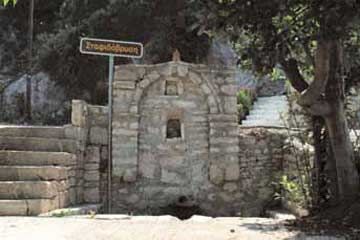 Η Σταφιδόβρυση, μία από τις τέσσερις οθωμανικές κρήνες της Άνω Πόλης Κυπαρισσίας.
Στην Παλιά Πόλη της Κυπαρισσίας (Αρκαδία, κατά τους μεσαιωνικούς χρόνους) σώζονται 4 οθωμανικές κρήνες, οι οποίες ανήκουν στον πιο κοινό και ευκολοσύχναστο τύπο κρήνης «Cesme», που είναι μια μνημειώδης θολωτή κατασκευή περίοπτη ή και εντοιχισμένη, ή μια απλή εντοιχισμένη βρύση με μαρμάρινη πλάκα και γούρνα. Πρόκειται για τη βρύση της οδού Χαμέρη στην Πίσω Ρούγα, τη Σταφιδόβρυση, την τούρκικη βρύση στην οδό Πίσω Ρούγας και την Κρήνη που είναι εντοιχισμένη στο Κάστρο. Η τελευταία φέρει ισλαμική επιγραφή, η οποία ταυτίζεται με την περιγραφή του Εβλιά Τσελεμπί στο «Οδοιπορικό στην Ελλάδα» και μεταφράζεται ως εξής: Φωνή από τον ουρανό είπε το χρονόγραμμα τούτης της κρήνης του Κεβσέρ: Πιες κι ευχήσουν για τη γενναιόδωρη ψυχή του Χουσεΐν. Έτος 1016 [1607-8].
Η Σταφιδόβρυση, μία από τις τέσσερις οθωμανικές κρήνες της Άνω Πόλης Κυπαρισσίας.
Στην Παλιά Πόλη της Κυπαρισσίας (Αρκαδία, κατά τους μεσαιωνικούς χρόνους) σώζονται 4 οθωμανικές κρήνες, οι οποίες ανήκουν στον πιο κοινό και ευκολοσύχναστο τύπο κρήνης «Cesme», που είναι μια μνημειώδης θολωτή κατασκευή περίοπτη ή και εντοιχισμένη, ή μια απλή εντοιχισμένη βρύση με μαρμάρινη πλάκα και γούρνα. Πρόκειται για τη βρύση της οδού Χαμέρη στην Πίσω Ρούγα, τη Σταφιδόβρυση, την τούρκικη βρύση στην οδό Πίσω Ρούγας και την Κρήνη που είναι εντοιχισμένη στο Κάστρο. Η τελευταία φέρει ισλαμική επιγραφή, η οποία ταυτίζεται με την περιγραφή του Εβλιά Τσελεμπί στο «Οδοιπορικό στην Ελλάδα» και μεταφράζεται ως εξής: Φωνή από τον ουρανό είπε το χρονόγραμμα τούτης της κρήνης του Κεβσέρ: Πιες κι ευχήσουν για τη γενναιόδωρη ψυχή του Χουσεΐν. Έτος 1016 [1607-8].
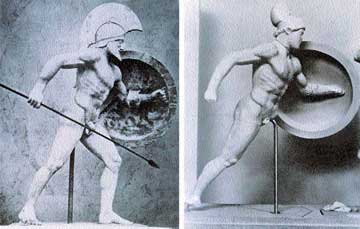 Πολεμιστής συμπληρωμένος από τον B. Thorvaldsen (αριστ.) και μετά την αφαίρεση των συμπληρώσεων από τον D. Ohly (δεξιά).
Η αισθητική αποκατάσταση των έργων τέχνης απασχολούσε ανέκαθεν όλους όσοι καταπιάνονται με τη συντήρηση των έργων αυτών. Είναι όμως ένα θέμα που, παρά την τεράστια σημασία του, δεν έχει ακόμα ερευνηθεί σε βάθος. Σε αυτό έχει συμβάλει κατά ένα μεγάλο ποσοστό η απουσία γραπτών πηγών σε ό,τι αφορά τις επεμβάσεις αποκατάστασης. Το φαινόμενο αυτό παρατηρείται ιδιαίτερα στην Ελλάδα, όπου μέχρι τη δεκαετία του 1970 δεν συνηθιζόταν να τηρούνται αρχεία επεμβάσεων, με αποτέλεσμα να έχουν χαθεί πολύτιμες πληροφορίες. Ωστόσο, οι ελάχιστες αναφορές που υπάρχουν γι’ αυτό το θέμα στην ελληνική και ξένη βιβλιογραφία βοηθούν να σχηματιστεί μια γενική εντύπωση για την ιστορία της αισθητικής αποκατάστασης.
Η αισθητική αποκατάσταση ερμηνεύεται διαφορετικά ανά τους αιώνες. Παρόλο που το ζητούμενο ήταν πάντα η μίμηση της αρχικής φόρμας των γλυπτικών έργων και συνθέσεων, το τελικό αποτέλεσμα χαρακτήριζε συνήθως την εποχή απόπειρας της αποκατάστασης και τις αισθητικές της αντιλήψεις, καθώς επίσης και τα προσωπικά γούστα των συλλεκτών.
Πολεμιστής συμπληρωμένος από τον B. Thorvaldsen (αριστ.) και μετά την αφαίρεση των συμπληρώσεων από τον D. Ohly (δεξιά).
Η αισθητική αποκατάσταση των έργων τέχνης απασχολούσε ανέκαθεν όλους όσοι καταπιάνονται με τη συντήρηση των έργων αυτών. Είναι όμως ένα θέμα που, παρά την τεράστια σημασία του, δεν έχει ακόμα ερευνηθεί σε βάθος. Σε αυτό έχει συμβάλει κατά ένα μεγάλο ποσοστό η απουσία γραπτών πηγών σε ό,τι αφορά τις επεμβάσεις αποκατάστασης. Το φαινόμενο αυτό παρατηρείται ιδιαίτερα στην Ελλάδα, όπου μέχρι τη δεκαετία του 1970 δεν συνηθιζόταν να τηρούνται αρχεία επεμβάσεων, με αποτέλεσμα να έχουν χαθεί πολύτιμες πληροφορίες. Ωστόσο, οι ελάχιστες αναφορές που υπάρχουν γι’ αυτό το θέμα στην ελληνική και ξένη βιβλιογραφία βοηθούν να σχηματιστεί μια γενική εντύπωση για την ιστορία της αισθητικής αποκατάστασης.
Η αισθητική αποκατάσταση ερμηνεύεται διαφορετικά ανά τους αιώνες. Παρόλο που το ζητούμενο ήταν πάντα η μίμηση της αρχικής φόρμας των γλυπτικών έργων και συνθέσεων, το τελικό αποτέλεσμα χαρακτήριζε συνήθως την εποχή απόπειρας της αποκατάστασης και τις αισθητικές της αντιλήψεις, καθώς επίσης και τα προσωπικά γούστα των συλλεκτών.
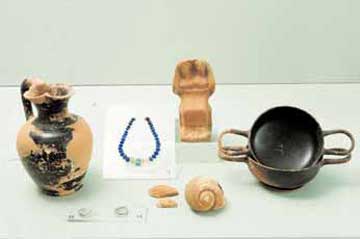 Αίθουσα 3, ταφικό σύνολο από το α' μισό του 4ου αι. π.Χ.
Σύντομη επισκόπηση της ιστορίας της Κάσου και παρουσίαση της αρχαιολογικής συλλογής της, η οποία διαρθρώνεται σε τέσσερις ενότητες: α) την προϊστορική περίοδο του νησιού, β) τις λατρείες-ιερά και τους οικισμούς των ιστορικών χρόνων, γ) τα ευρήματα των νεκροπόλεων, και δ) την ιστορία του ολοκαυτώματοςτου 1824 και την οργάνωση του κασιώτικου σπιτιού. Η έκθεση της αρχαιολογικής συλλογής Κάσου οργανώθηκε από το Αρχαιολογικό Ινστιτούτο Αιγαιακών Σπουδών σε συνεργασία με την ΚΒ´ Εφορεία Προϊστορικών και Κλασικών Αρχαιοτήτων και εγκαινιάστηκε τον Σεπτέμβριο του 2004.
Αίθουσα 3, ταφικό σύνολο από το α' μισό του 4ου αι. π.Χ.
Σύντομη επισκόπηση της ιστορίας της Κάσου και παρουσίαση της αρχαιολογικής συλλογής της, η οποία διαρθρώνεται σε τέσσερις ενότητες: α) την προϊστορική περίοδο του νησιού, β) τις λατρείες-ιερά και τους οικισμούς των ιστορικών χρόνων, γ) τα ευρήματα των νεκροπόλεων, και δ) την ιστορία του ολοκαυτώματοςτου 1824 και την οργάνωση του κασιώτικου σπιτιού. Η έκθεση της αρχαιολογικής συλλογής Κάσου οργανώθηκε από το Αρχαιολογικό Ινστιτούτο Αιγαιακών Σπουδών σε συνεργασία με την ΚΒ´ Εφορεία Προϊστορικών και Κλασικών Αρχαιοτήτων και εγκαινιάστηκε τον Σεπτέμβριο του 2004.
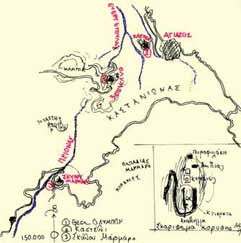 Χάρτης της περιοχής.
H περιοχή του λεσβιακού Oλύμπου χαρακτηρίζεται από την πυκνή βλάστηση και τις βαθιές χαράδρες των ποταμών, αρχαία περάσματα κάτω από την επιβλητική παρουσία της ασβεστολιθικής κορυφής. Eντοπίστηκαν αρχαίες εγκαταστάσεις σε φύσει οχυρές θέσεις που επιτηρούσαν αυτά τα συνοριακά περάσματα. Tελευταία, στην κορυφή του Oλύμπου εντοπίστηκαν θεμέλια κτισμάτων, περίβολος και κεραμική. Πρόκειται πιθανόν για παρατηρητήριο με θέα όλο το νησί. Δεν αποκλείεται όμως και το ιερό κορυφής, όπως αυτό στην κορυφή του άλλου βουνού του Λεπέτυμνου. Aυτό θα το δείξει ίσως η μελλοντική έρευνα.
Χάρτης της περιοχής.
H περιοχή του λεσβιακού Oλύμπου χαρακτηρίζεται από την πυκνή βλάστηση και τις βαθιές χαράδρες των ποταμών, αρχαία περάσματα κάτω από την επιβλητική παρουσία της ασβεστολιθικής κορυφής. Eντοπίστηκαν αρχαίες εγκαταστάσεις σε φύσει οχυρές θέσεις που επιτηρούσαν αυτά τα συνοριακά περάσματα. Tελευταία, στην κορυφή του Oλύμπου εντοπίστηκαν θεμέλια κτισμάτων, περίβολος και κεραμική. Πρόκειται πιθανόν για παρατηρητήριο με θέα όλο το νησί. Δεν αποκλείεται όμως και το ιερό κορυφής, όπως αυτό στην κορυφή του άλλου βουνού του Λεπέτυμνου. Aυτό θα το δείξει ίσως η μελλοντική έρευνα.
 Journal of Mediterranean Archaeology, λογότυπο
Από το τεύχος 20/1 (2007) του Journal of Mediterranean Archaeology παρουσιάζεται το άρθρο των Tristan Carter και Vassilis Kilikoglou "From reactor to royalty? Aegean and Anatolian obsidians from Quartier Mu, Malia (Crete)".
Journal of Mediterranean Archaeology, λογότυπο
Από το τεύχος 20/1 (2007) του Journal of Mediterranean Archaeology παρουσιάζεται το άρθρο των Tristan Carter και Vassilis Kilikoglou "From reactor to royalty? Aegean and Anatolian obsidians from Quartier Mu, Malia (Crete)".
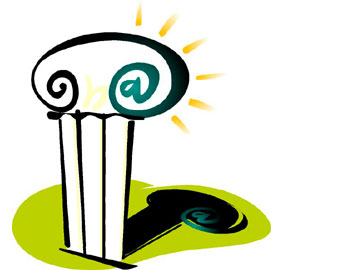 Το λογότυπο της στήλης
Στη στήλη των Δικτυακών Τόπων αυτού του τεύχους παρουσιάζονται οι πύλες επιστημονικών περιοδικών JSTOR και Persée. Η πύλη JSTOR (Journal STORage) του μη κερδοσκοπικού ιδρύματος JSTOR (ΗΠΑ), που ξεκίνησε το 1997 ως ερευνητικό πρόγραμμα του ιδρύματος Andrew W. Mellon περιέχει περίπου 1.120 περιοδικά, κυρίως αγγλικά, καλύπτοντας ένα ευρύ πεδίο τομέων: ιστορία, ιστορία της τέχνης, αρχαιολογία, αρχιτεκτονική, φιλολογία, φιλοσοφία, πολιτικές επιστήμες κ.ά. Στη στήλη παρατίθεται κατάλογος των πιο σημαντικών από αυτά τα περιοδικά. Η πύλη Persée του γαλλικού Υπουργείου Παιδείας δημιουργήθηκε το 2003 με σκοπό την ελεύθερη διάθεση στο διαδίκτυο των ψηφιακών αρχείων γαλλικών επιστημονικών περιοδικών. Περιέχει 39 γαλλικά περιοδικά και καλύπτει τους τομείς αρχαιολογία, ιστορία της τέχνης, δίκαιο, οικονομία, γεωγραφία, λογοτεχνία κ.ά.
Το λογότυπο της στήλης
Στη στήλη των Δικτυακών Τόπων αυτού του τεύχους παρουσιάζονται οι πύλες επιστημονικών περιοδικών JSTOR και Persée. Η πύλη JSTOR (Journal STORage) του μη κερδοσκοπικού ιδρύματος JSTOR (ΗΠΑ), που ξεκίνησε το 1997 ως ερευνητικό πρόγραμμα του ιδρύματος Andrew W. Mellon περιέχει περίπου 1.120 περιοδικά, κυρίως αγγλικά, καλύπτοντας ένα ευρύ πεδίο τομέων: ιστορία, ιστορία της τέχνης, αρχαιολογία, αρχιτεκτονική, φιλολογία, φιλοσοφία, πολιτικές επιστήμες κ.ά. Στη στήλη παρατίθεται κατάλογος των πιο σημαντικών από αυτά τα περιοδικά. Η πύλη Persée του γαλλικού Υπουργείου Παιδείας δημιουργήθηκε το 2003 με σκοπό την ελεύθερη διάθεση στο διαδίκτυο των ψηφιακών αρχείων γαλλικών επιστημονικών περιοδικών. Περιέχει 39 γαλλικά περιοδικά και καλύπτει τους τομείς αρχαιολογία, ιστορία της τέχνης, δίκαιο, οικονομία, γεωγραφία, λογοτεχνία κ.ά.
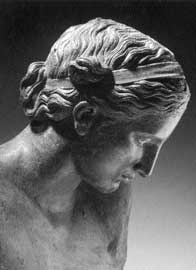 Από τον κατάλογο της αθηναϊκής έκθεσης για τον Πραξιτέλη που έγινε στο Εθνικό Αρχαιολογικό Μουσείο.
Παρουσίαση του καταλόγου της αθηναϊκής έκθεσης για τον Πραξιτέλη.
Ο κατάλογος αποτελείται από μια εισαγωγή, μια σειρά άρθρων γύρω από το βίο του καλλιτέχνη, το έργο του, τα νέα ευρήματα σχετικά με την τέχνη του και από εικονογραφημένο και σχολιασμένο κατάλογο των 75 εκθεμάτων που παρουσιάστηκαν στην έκθεση. Στο τέλος του βιβλίου περιλαμβάνεται κατάλογος συντομογραφιών, βιβλιογραφία και κατάλογος φωτογραφικών παραπομπών.
Πρόκειται για ένα εξαίρετο βιβλίο που αποδεικνύει περίτρανα ότι η Ελλάδα δικαιούται να υπερηφανεύεται ότι διαθέτει μία από τις καλύτερες ομάδες ειδικών στο χώρο της «Meisterfoschung», δηλαδή της μελέτης των αρχαίων καλλιτεχνών.
Από τον κατάλογο της αθηναϊκής έκθεσης για τον Πραξιτέλη που έγινε στο Εθνικό Αρχαιολογικό Μουσείο.
Παρουσίαση του καταλόγου της αθηναϊκής έκθεσης για τον Πραξιτέλη.
Ο κατάλογος αποτελείται από μια εισαγωγή, μια σειρά άρθρων γύρω από το βίο του καλλιτέχνη, το έργο του, τα νέα ευρήματα σχετικά με την τέχνη του και από εικονογραφημένο και σχολιασμένο κατάλογο των 75 εκθεμάτων που παρουσιάστηκαν στην έκθεση. Στο τέλος του βιβλίου περιλαμβάνεται κατάλογος συντομογραφιών, βιβλιογραφία και κατάλογος φωτογραφικών παραπομπών.
Πρόκειται για ένα εξαίρετο βιβλίο που αποδεικνύει περίτρανα ότι η Ελλάδα δικαιούται να υπερηφανεύεται ότι διαθέτει μία από τις καλύτερες ομάδες ειδικών στο χώρο της «Meisterfoschung», δηλαδή της μελέτης των αρχαίων καλλιτεχνών.
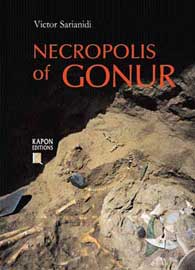 Το εξώφυλλο του βιβλίου
Βιβλιοπαρουσίαση της καλαίσθητης έκδοσης των εκδόσεων Καπόν, με πλούσια εικονογράφηση που περιλαμβάνει 358 έγχρωμες εικόνες.
Στην έκδοση αυτή ο συγγραφέας Βίκτωρ Σαριγιαννίδης, αρχαιολόγος και επίτιμο μέλος της Ρωσικής Ακαδημίας Επιστημών, συνοψίζει τα πορίσματα των ανασκαφών που διεξάγει εδώ και 30 χρόνια στην αφιλόξενη έρημο του Καρακούμ (Τουρκμενιστάν).
Το εξώφυλλο του βιβλίου
Βιβλιοπαρουσίαση της καλαίσθητης έκδοσης των εκδόσεων Καπόν, με πλούσια εικονογράφηση που περιλαμβάνει 358 έγχρωμες εικόνες.
Στην έκδοση αυτή ο συγγραφέας Βίκτωρ Σαριγιαννίδης, αρχαιολόγος και επίτιμο μέλος της Ρωσικής Ακαδημίας Επιστημών, συνοψίζει τα πορίσματα των ανασκαφών που διεξάγει εδώ και 30 χρόνια στην αφιλόξενη έρημο του Καρακούμ (Τουρκμενιστάν).
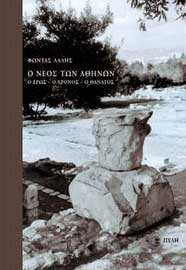 Το εξώφυλλο του βιβλίου
Παρουσίαση του βιβλίου του Φώντα Λάδη, το οποίο αν και πραγματεύεται διαχρονικά θέματα όπως ο Έρωτας, ο Χρόνος και ο Θάνατος, με εκτεταμένες αναφορές στον αρχαίο ελληνικό πολιτισμό, είναι σύγχρονο στην πλοκή και τη δράση του, η οποία ξετυλίγεται στην Αθήνα —στο Εθνικό Αρχαιολογικό Μουσείο, το Στάδιο του Αρδηττού και την Ακρόπολη— αλλά και στο Λούβρο και το Βρετανικό Μουσείο.
Το εξώφυλλο του βιβλίου
Παρουσίαση του βιβλίου του Φώντα Λάδη, το οποίο αν και πραγματεύεται διαχρονικά θέματα όπως ο Έρωτας, ο Χρόνος και ο Θάνατος, με εκτεταμένες αναφορές στον αρχαίο ελληνικό πολιτισμό, είναι σύγχρονο στην πλοκή και τη δράση του, η οποία ξετυλίγεται στην Αθήνα —στο Εθνικό Αρχαιολογικό Μουσείο, το Στάδιο του Αρδηττού και την Ακρόπολη— αλλά και στο Λούβρο και το Βρετανικό Μουσείο.
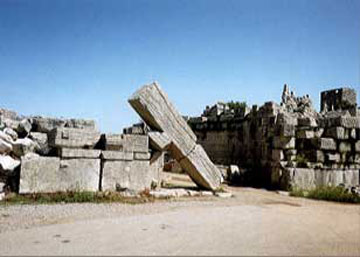 Η Αρκαδική Πύλη στην αρχαία Μεσσήνη
Ειδήσεις: Κίνδυνος για παλαιοντολογικούς θησαυρούς της Χίου, Ανάδειξη του Φρουρίου του Ρίου, Ανασκαφή στο Βαθροβούνι Χαλκίδας, Πανάρχαιο είδος οι ορχιδέες, Ο δικτυακός τόπος της ΥΣΜΑ, Αρχαιογνωστική επίσκεψη στη Νεμέα κ.ά.
Εκθέσεις: Η Αθηναϊκή δημοκρατία και οι επιγραφές της, Αρχαία Καλίνδοια, Έκθεση για την αρχαιοκαπηλία στην Τεργέστη, Καπνομάγαζα κ.ά.
Συνέδρια: Η´ Επιστημονική Συνάντηση για την ελληνιστική κεραμική, Η χρονολόγηση και προέλευση του οψιανού και των γυαλιών της αρχαιότητας, Ημερίδα Συντήρησης 2007-Λίθος, Χώρος και χρόνος στο αρχαίο θέατρο κ.ά.
Διαλέξεις: Ομιλίες στην Εν Αθήναις Αρχαιολογική Εταιρεία, Αιγυπτιακά ειδώλια στου Μακρυγιάννη, Τα αγάλματα του Φιλιππείου κ.ά.
Βιβλία: Π. Βαλαβάνης (επιμ.), Μεγάλες στιγμές της ελληνικής αρχαιολογίας - Μάριος Βερέττας, Τα βρωμόλογα των αρχαίων Ελλήνων - Paul Faure, Η καθημερινή ζωή στις ελληνικές αποικίες - Κωνσταντίνα Τσάιμου, Ορολογία της αρχαίας μεταλλείας κ.ά.
Η Αρκαδική Πύλη στην αρχαία Μεσσήνη
Ειδήσεις: Κίνδυνος για παλαιοντολογικούς θησαυρούς της Χίου, Ανάδειξη του Φρουρίου του Ρίου, Ανασκαφή στο Βαθροβούνι Χαλκίδας, Πανάρχαιο είδος οι ορχιδέες, Ο δικτυακός τόπος της ΥΣΜΑ, Αρχαιογνωστική επίσκεψη στη Νεμέα κ.ά.
Εκθέσεις: Η Αθηναϊκή δημοκρατία και οι επιγραφές της, Αρχαία Καλίνδοια, Έκθεση για την αρχαιοκαπηλία στην Τεργέστη, Καπνομάγαζα κ.ά.
Συνέδρια: Η´ Επιστημονική Συνάντηση για την ελληνιστική κεραμική, Η χρονολόγηση και προέλευση του οψιανού και των γυαλιών της αρχαιότητας, Ημερίδα Συντήρησης 2007-Λίθος, Χώρος και χρόνος στο αρχαίο θέατρο κ.ά.
Διαλέξεις: Ομιλίες στην Εν Αθήναις Αρχαιολογική Εταιρεία, Αιγυπτιακά ειδώλια στου Μακρυγιάννη, Τα αγάλματα του Φιλιππείου κ.ά.
Βιβλία: Π. Βαλαβάνης (επιμ.), Μεγάλες στιγμές της ελληνικής αρχαιολογίας - Μάριος Βερέττας, Τα βρωμόλογα των αρχαίων Ελλήνων - Paul Faure, Η καθημερινή ζωή στις ελληνικές αποικίες - Κωνσταντίνα Τσάιμου, Ορολογία της αρχαίας μεταλλείας κ.ά.
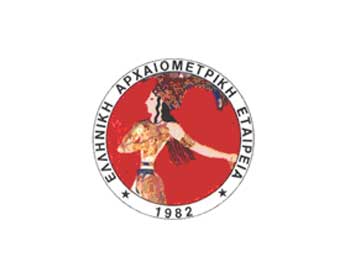 Το λογότυπο της Ελληνικής Αρχαιομετρικής Εταιρείας
Στα Αρχαιομετρικά Νέα αυτού του τεύχους μπορείτε να διαβάσετε:
- Νέο περιοδικό Αρχαιομετρίας
- Επιστημονικά περιοδικά χωρίς συνδρομή
- Αρχαιομεταλλουργικές εργασίες σε ελληνικό περιοδικό
- Νέες εκδόσεις: The Atlantis Hypothesis: Searching for a Lost Land και Metallurgy in the Early Bronze Age Aegean
Το λογότυπο της Ελληνικής Αρχαιομετρικής Εταιρείας
Στα Αρχαιομετρικά Νέα αυτού του τεύχους μπορείτε να διαβάσετε:
- Νέο περιοδικό Αρχαιομετρίας
- Επιστημονικά περιοδικά χωρίς συνδρομή
- Αρχαιομεταλλουργικές εργασίες σε ελληνικό περιοδικό
- Νέες εκδόσεις: The Atlantis Hypothesis: Searching for a Lost Land και Metallurgy in the Early Bronze Age Aegean
